Table of contents

Ultimate Day Hiking Checklist

Some of the links on this page are affiliate links
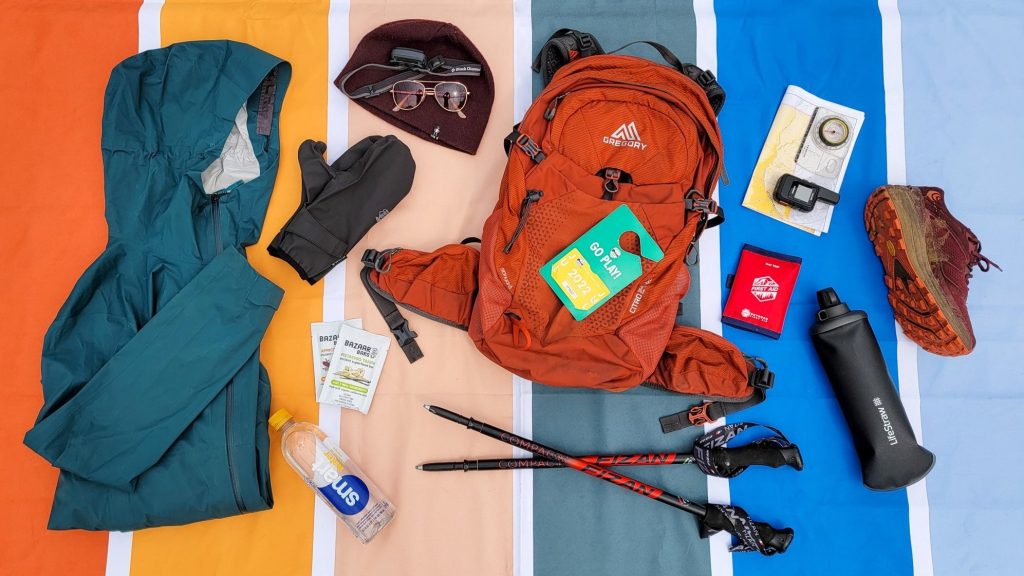
Last updated: March 1, 2024
We love a good checklist to help us prepare for a trip – even if we’re just going out for a day hike. Use this Day Hike Checklist every time you hit the trail to make rounding up your gear quick and easy, and to give you peace of mind that you aren’t forgetting something critical.
Day Hiking Checklist
DOWNLOAD OUR PRINTABLE CHECKLIST
You won’t need all the items on this list for every trip, but it’s worth thinking through each of them as you gather your gear. Grab the basics first, then use the categories at the end to tailor your gear list to your specific needs.
- Apply for any required permits
- Call ranger station for trail conditions & regulations
- Check if trailhead requires a parking pass or cash/card for pay station
- Check current weather
- Charge electronics & check batteries
- Update emergency contacts and turn on SOS / emergency notification features on your phone
- Study topo map/take photos of guidebook pages
- Download GPS phone app & appropriate maps or GPS area
- Download driving directions for offline use (we use maps.me )
- Leave an itinerary with a friend & under your car seat
- Pack your bag
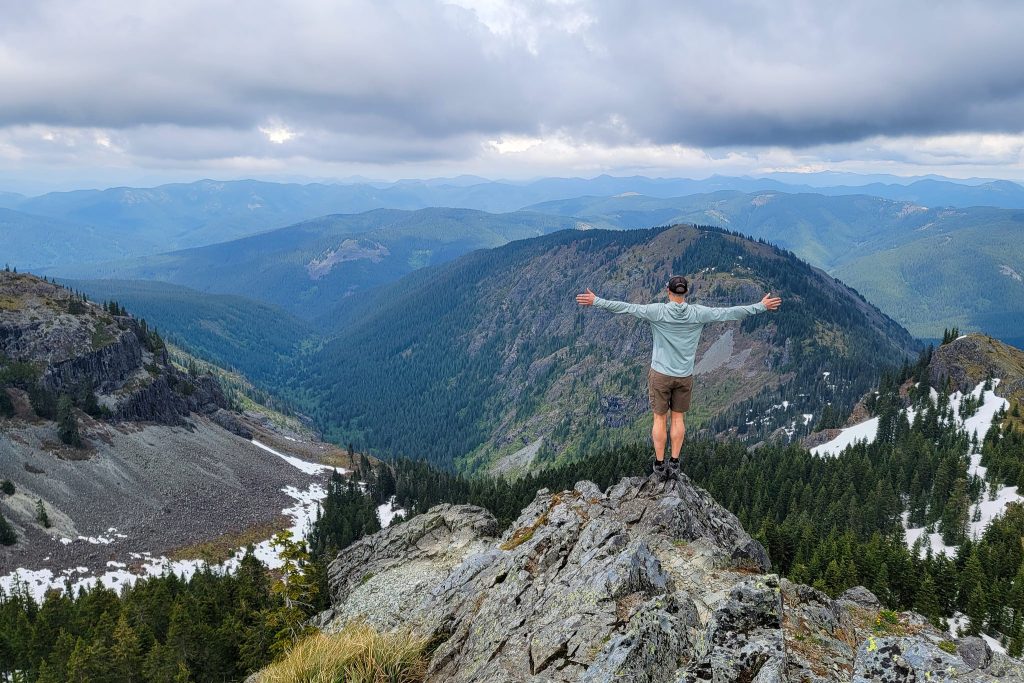
WATERPROOFING
Based on your pack choice, choose one or more of the following to keep your stuff dry:
- Pack liner or trash bag
- Waterproof stuff sack(s)
TOOLS & ACCESSORIES
- Wallet (containing cash, ID, credit card, insurance card)
- Phone in protective case
- First aid kit & prescription Rx
- Sunscreen & lip balm
- Poop kit (toilet paper, hand sanitizer & trowel )
- Light pocket knife or multitool
- Ultralight chair / sit pad or hammock
- Trekking poles
NAVIGATION EQUIPMENT
- Topo map(s)
- Waterproof map bag / Ziploc
- GPS phone app
Choose one of the following to carry your gear:
- Hydration pack
- Extra shoulder or hipbelt pocket
Some worn, some packed. Layer clothing based on season and weather conditions. For fabrics – think lightweight and quick-drying (no cotton).
- Hiking pants ( Men’s / Women’s ), leggings , or shorts ( Men’s / Women’s )
- Quick-dry underwear
- Shirt ( sun shirt , base layer , or short sleeve / tank)
- Jacket(s) ( rain , down , fleece , windbreaker – possibly a combo)
- Shoes / boots
- High-quality socks
- Gaiters (for talus, sand, snow, or fast/long trips)
- Hat(s) ( warm or for sun )
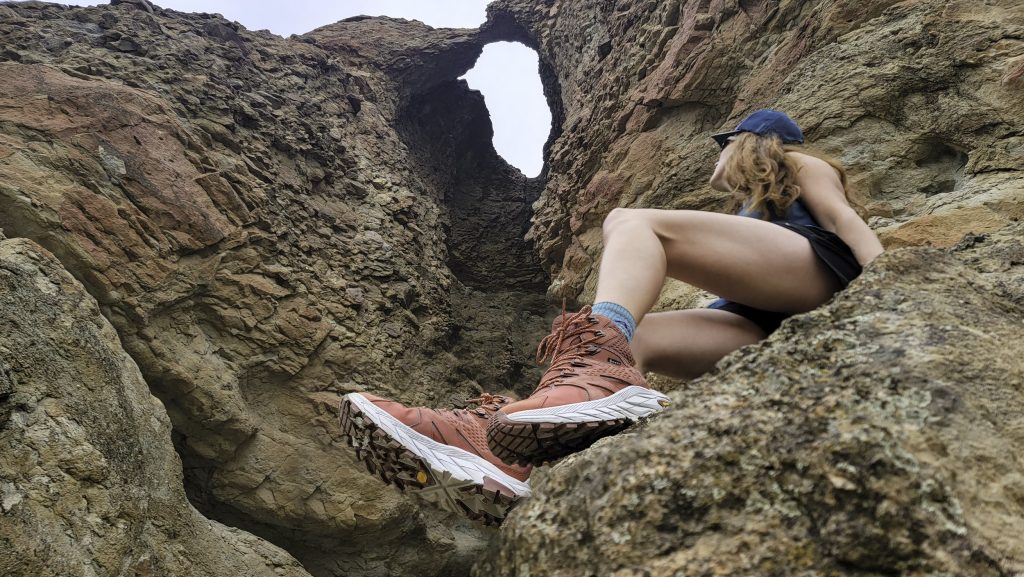
PACK IN CAR
- Parking pass or cash / card
- Itinerary or note under seat
- Clean clothes & comfy shoes to change into
- Gallon of water to refill bottles
- Cooler with post-hike refreshments
- Blanket or camping chairs (for tailgating)
FOOD & WATER
- Full water bottle(s) or hydration bladder
- Food & snacks
- Empty Ziploc (for garbage)
- Drink mixes
- Travel mug & coffee / tea
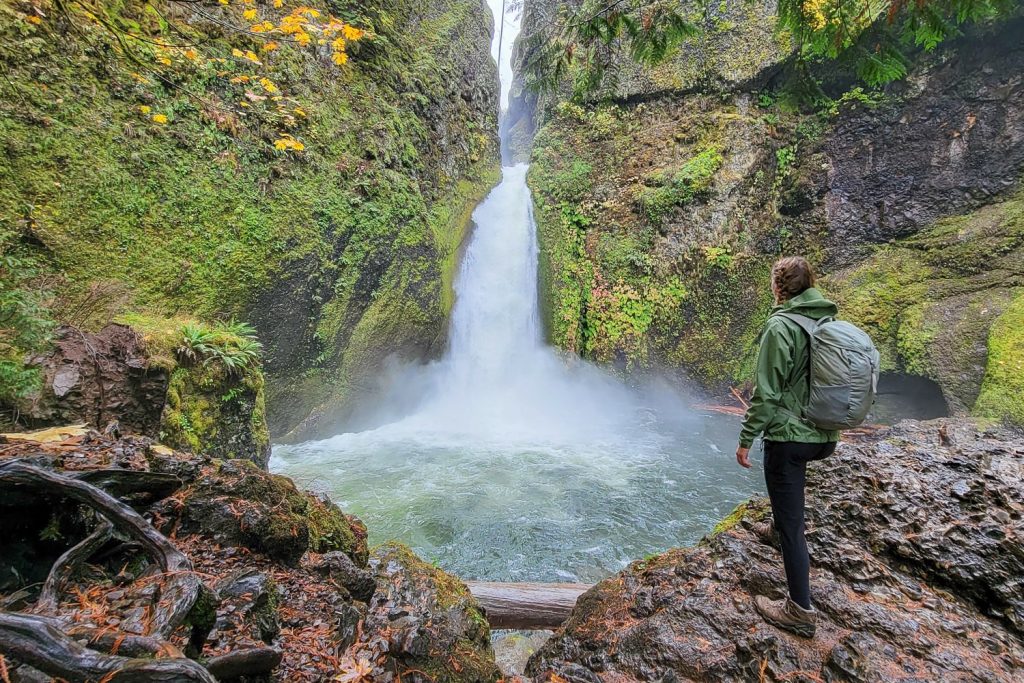
Additional Gear For Specific Trips
Rain & snow.
- Rain jacket
- Rain mittens
- Traction devices or snowshoes
- GPS / phone app (for route finding in snow)
MOSQUITOS & TICKS
- Pre-treat clothing with Permethrin
- Treat skin with Picaridin
LONG HIKES / REMOTE LOCATIONS
- Extra food for emergencies
- Duct / Tenacious Tape (for repairs)
- Small lighter & fire starters
- Water filter or treatment pills
- Collapsible water containers (for carrying lots of water in dry locations)
- Satellite Messenger / PLB
- Emergency blanket / shelter
GRIZZLY BEAR COUNTRY
- Bear canister
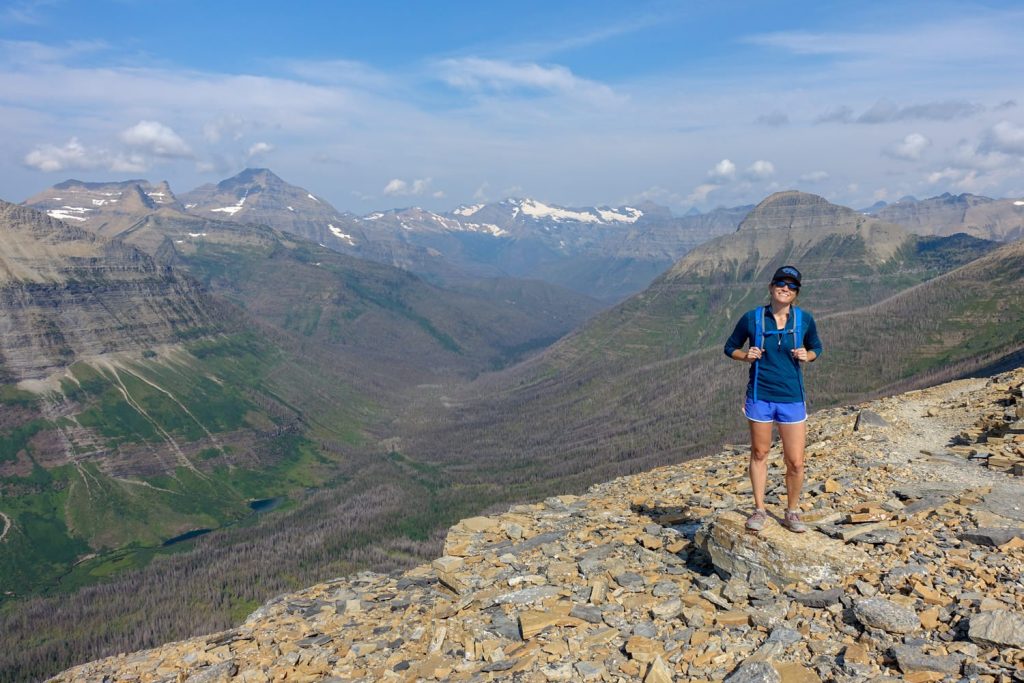
PHOTOGRAPHY
Backup photos, clear storage, and clean lens.
DSLR or Point-and-Shoot
- Holster or camera clip
- Remote shutter
- Microfiber cleaning cloth
- Rain cover / dry bag
- Extra battery
- Extra camera card
- Phone ( Apple or Android )
- Shoulder pouch or hipbelt pocket
- Smartphone tripod mount
- Small carabiner (to keep track of remote)
- Waterproof case or Ziploc
- Power bank (for long trips)
- Short charging cable
For the trail
- Collar / harness
- Food & collapsible bowl
- Extra water (you carry)
- Treats & treat pouch
- Dog boots / Musher’s Secret Wax (to protect the paws)
- Poop bags & gallon Ziploc or OPsak (to pack out waste)
- Dog backpack
- Dog jacket (for dogs with low cold tolerance)
- Foam pad (to insulate you and your dog from the cold/wet ground during breaks)
- Dog first aid kit (or add stuff to human first-aid kit )
- Collar light (check battery pre-trip)
Leave in car
- Quick-dry towel
- Dog car hammock (seat protector)
- Extra dog food in airtight container
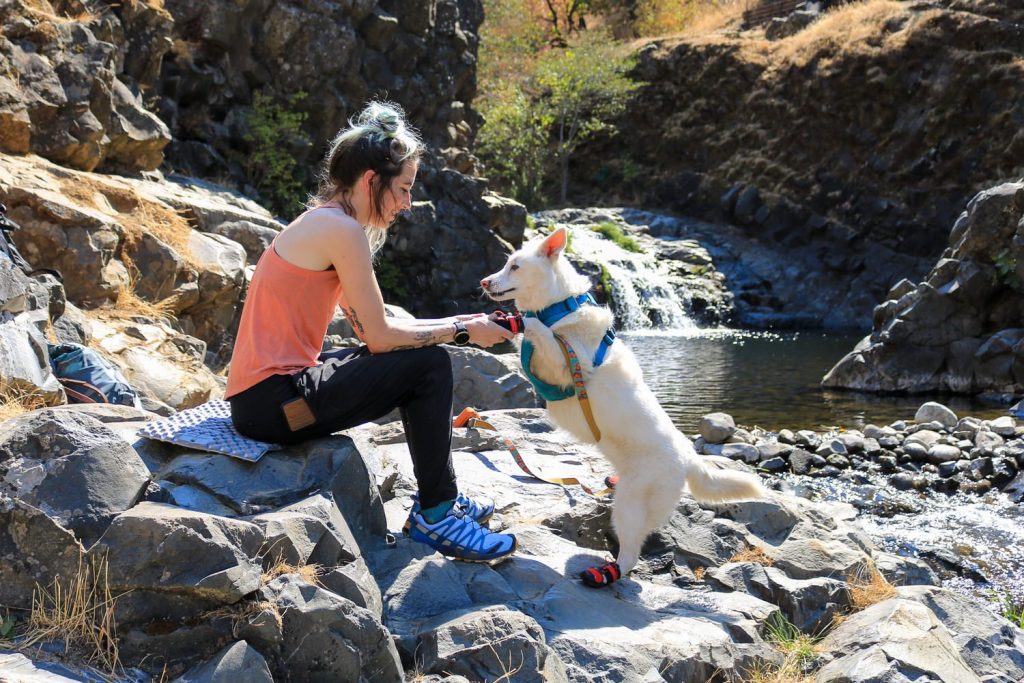
Overnight Trips
Prepping for a multi day adventure? We also have checklists for backpacking , camping , and winter camping .
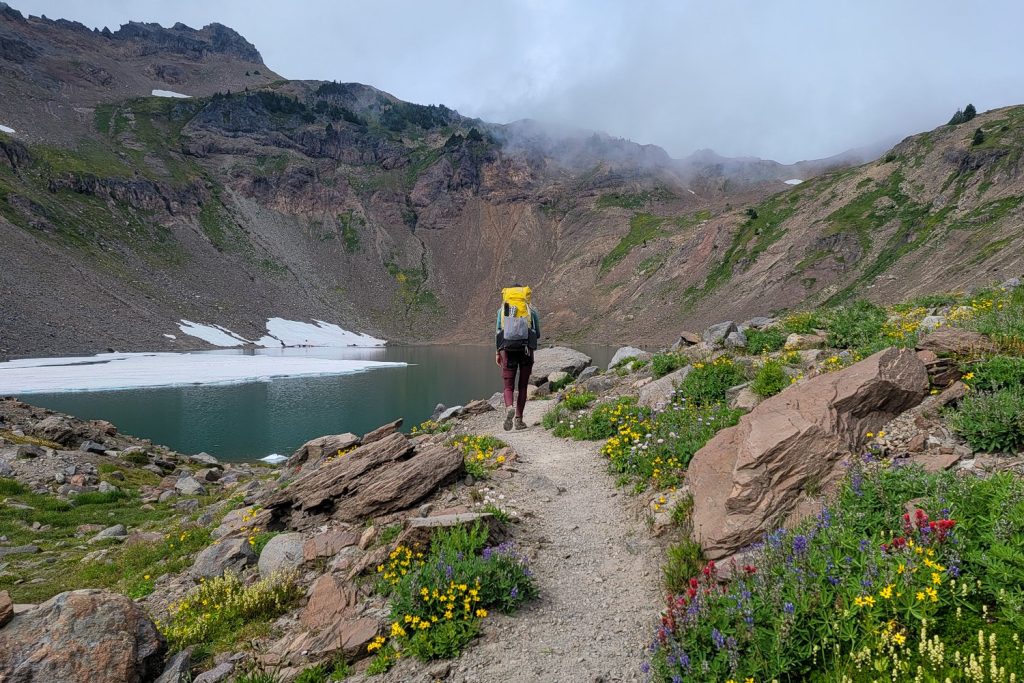
Day Hiking Tips
Finding a balance of pack weight & preparedness.
A lightweight backpack is far more comfortable to carry. This will help you conserve energy so you can hike further and enjoy your time outdoors more. That said, we never advise skipping essentials like a map, food, water, rain jacket , and a basic first-aid kit when venturing into the backcountry. Learn more about ways to reduce your pack weight here .
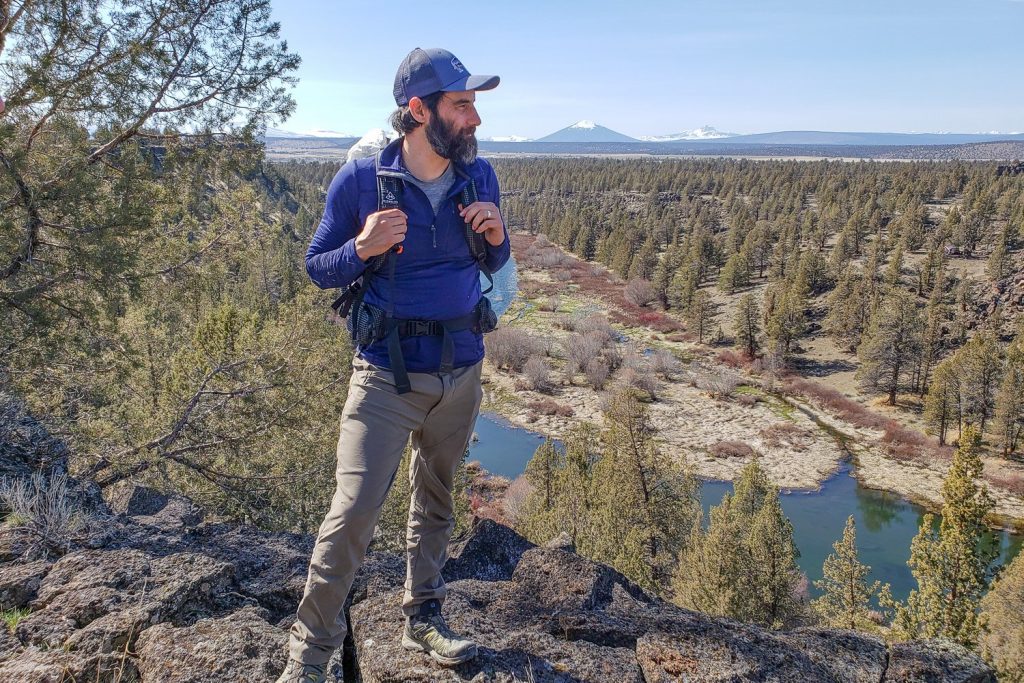
Most people use a daypack or hydration pack (comes with a bladder ) for day trips for their useful capacity, comfortable carry, and convenient pockets to keep gear organized and easily accessible. Daypacks come in a variety of sizes, but we prefer those that have about 20-30 liters of volume. Fanny packs are also a great option for small gear loads or for extra capacity in addition to a daypack.
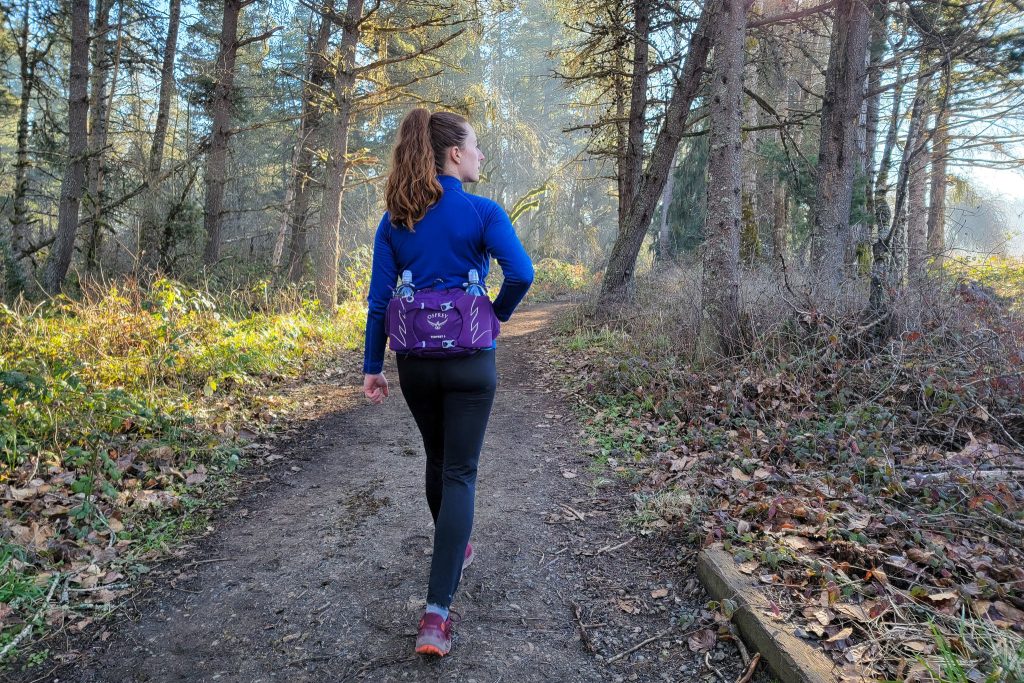
WHAT TO WEAR FOR HIKING
The clothing you wear and pack for a day hike will depend on the conditions you expect to encounter on specific trips, but the basics remain the same. Wear layers made of quick-drying (synthetic or wool) fabrics so you can stay comfortable no matter the weather. Lightweight, breathable footwear and high-quality, non-cotton socks also make a huge difference in reducing fatigue and avoiding blisters . Get specific recommendations on the best down jackets , rain jackets , hiking pants , base layers , and more on our Gear Guide Homepage .
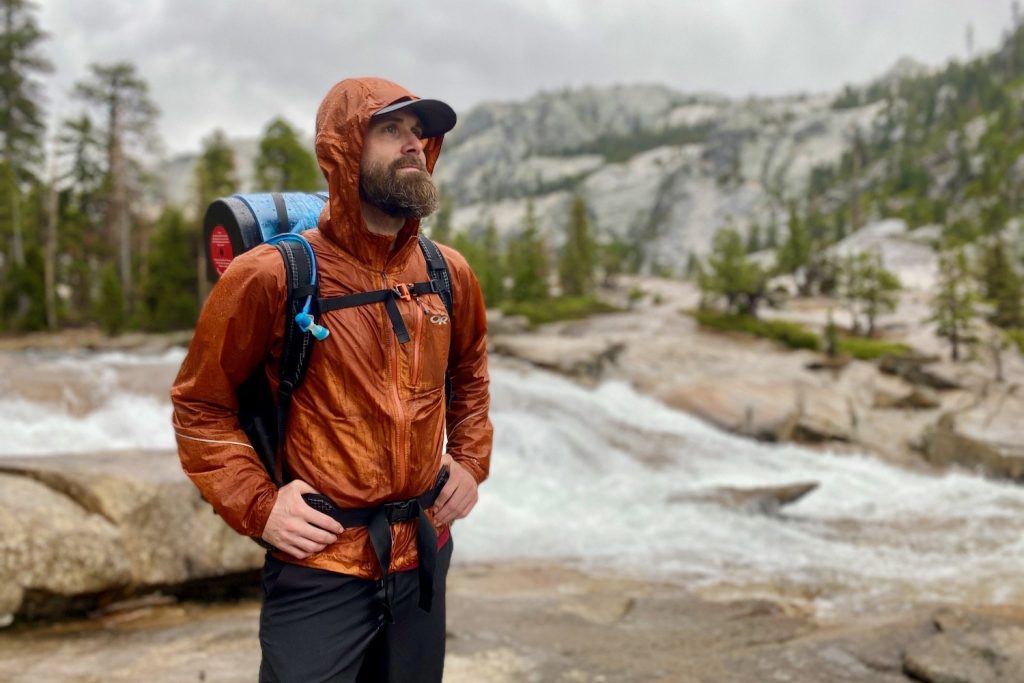
Why trust us?
We understand how tough it is to find trustworthy gear advice, and that’s one of the main reasons we built CleverHiker. We live for outdoor adventure, and we take these guides very seriously.
- Our recommendations are completely independent and based on hands-on experience.
- We test outdoor gear for a living – we’ve logged over 20,000 trail miles and 1,000 nights in the wilderness.
- Our team has thru-hiked some of the most iconic long trails, including the Continental Divide Trail, Pacific Crest Trail, Appalachian Trail, Colorado Trail, Long Trail, Oregon Coast Trail, Arizona Trail, Pinhoti Trail, Superior Hiking Trail, as well as extensive peak bagging, and international treks.
- We field test every product we recommend, which is sadly not the norm.
- We travel to industry trade shows to stay up-to-date on product innovations.
- We continuously update our guides throughout the year and when new products launch.
- We treat recommendations to our readers as if they were for our family and friends.
- We’re lifelong learners and we’re always open to feedback. If you think we’ve missed a worthy product or got something wrong, we’d love to know about it.
Related Content
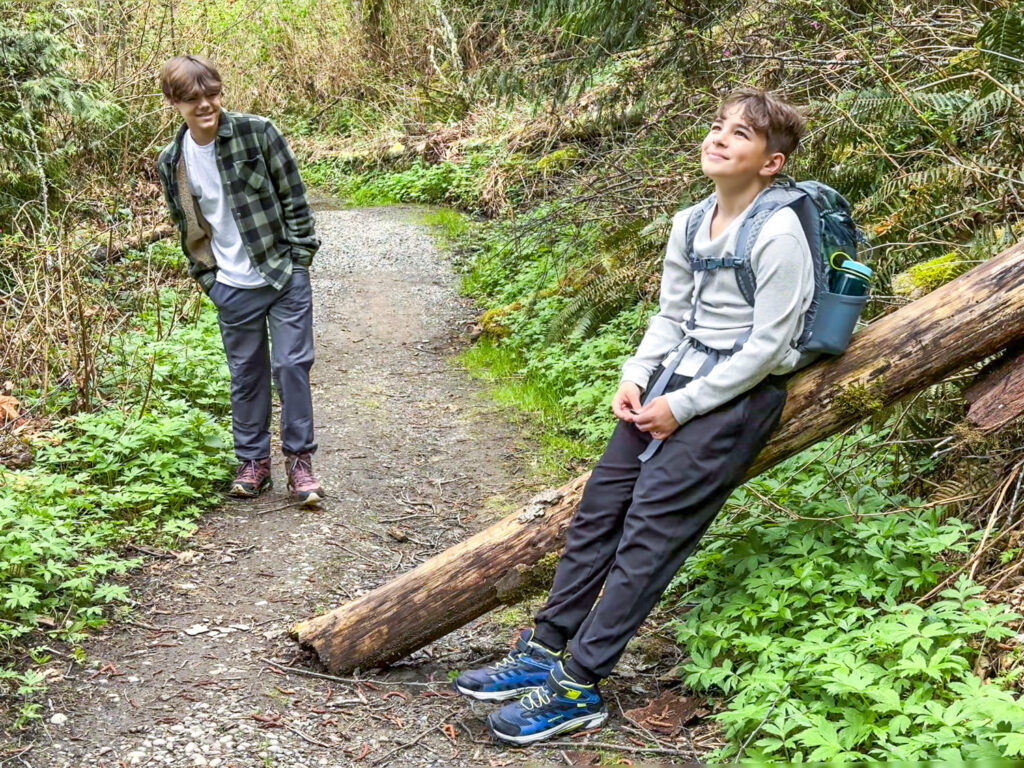
6 Safety Tips For Hiking with Kids
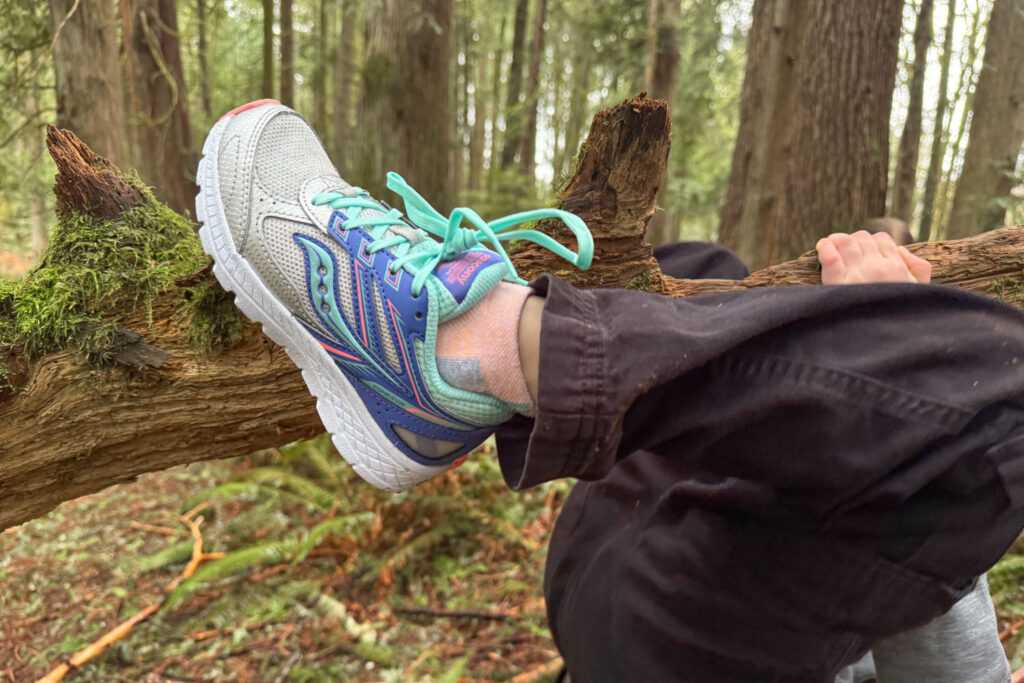
10 Best Hiking Shoes for Kids of 2024
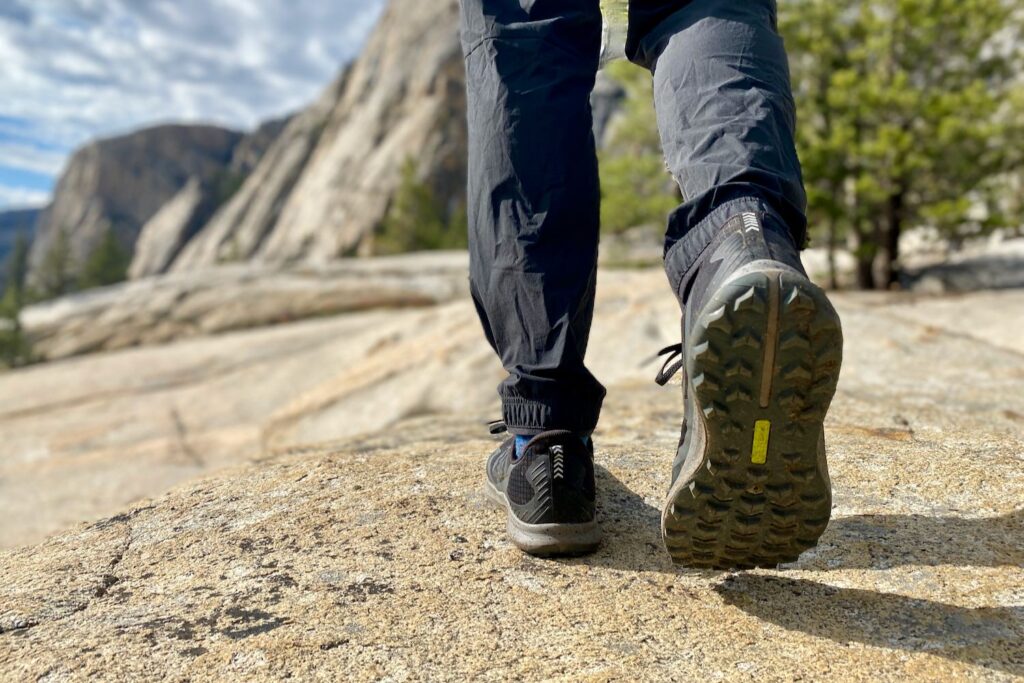
Hiking Boot & Shoe Soles for Grip, Traction & Different Terrains
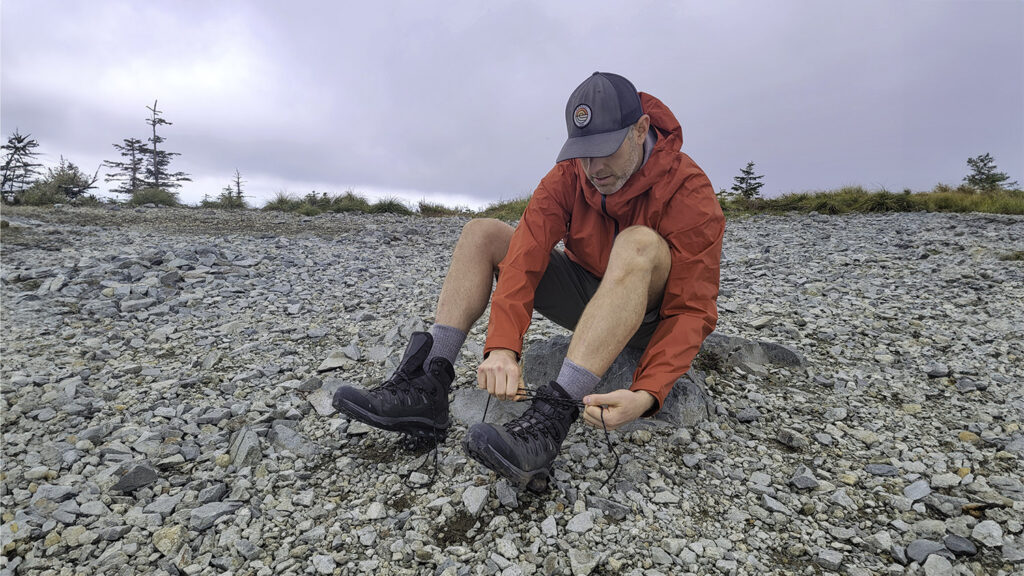
How to Lace Hiking Boots & Shoes
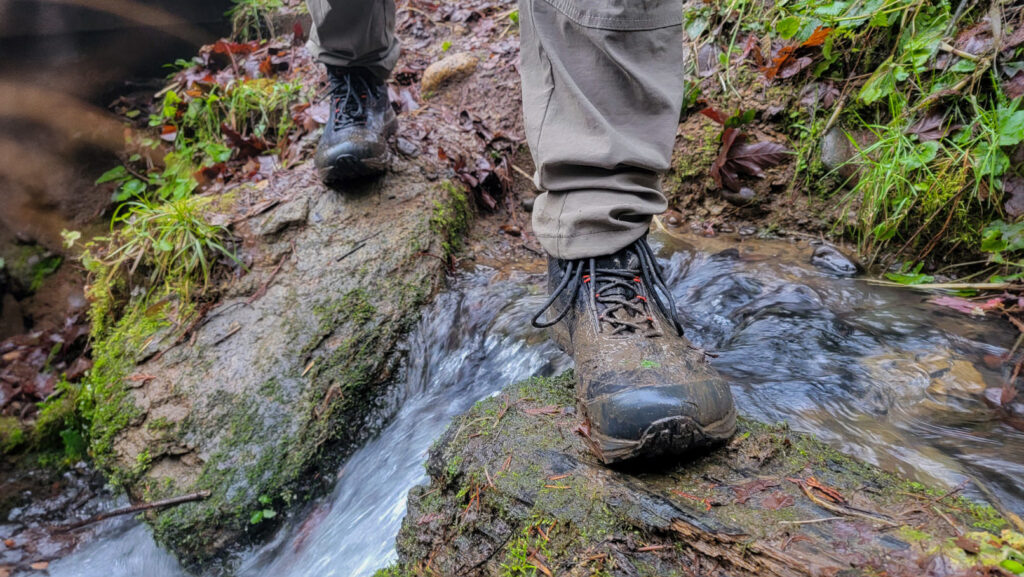
How to Clean Hiking Shoes & Boots
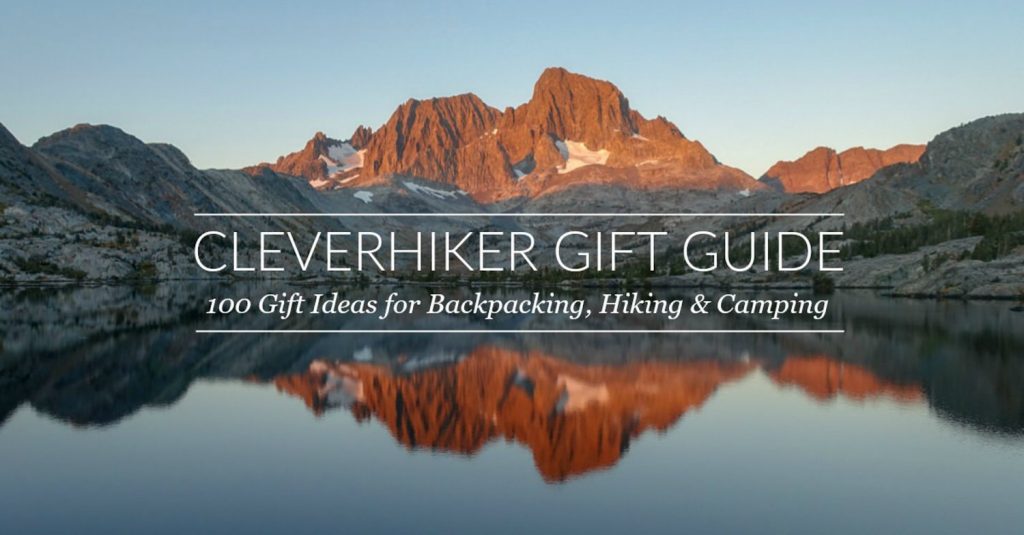
100 Best Gifts For Hikers, Backpackers & Campers 2024
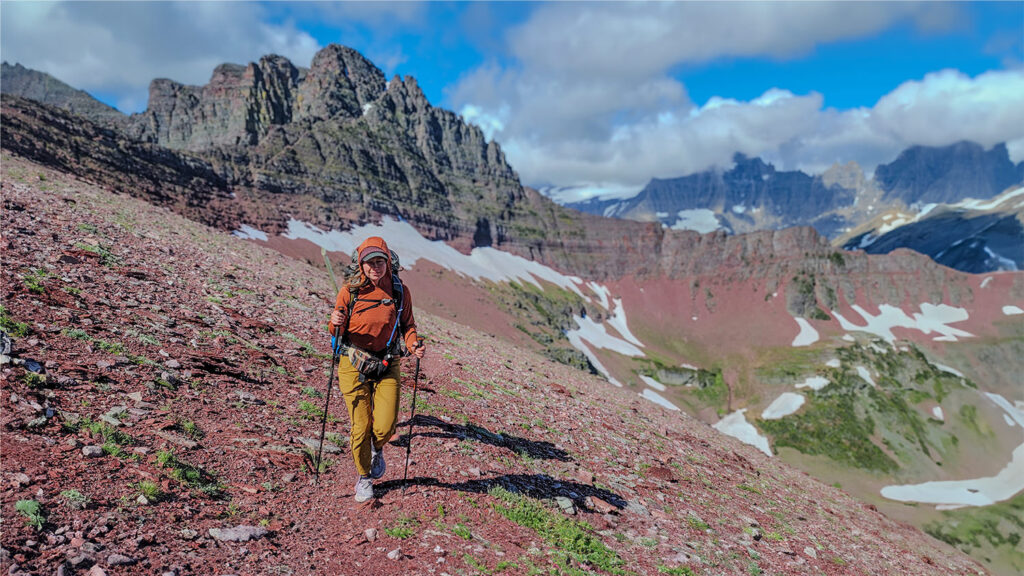
7 Best Trekking Poles of 2024
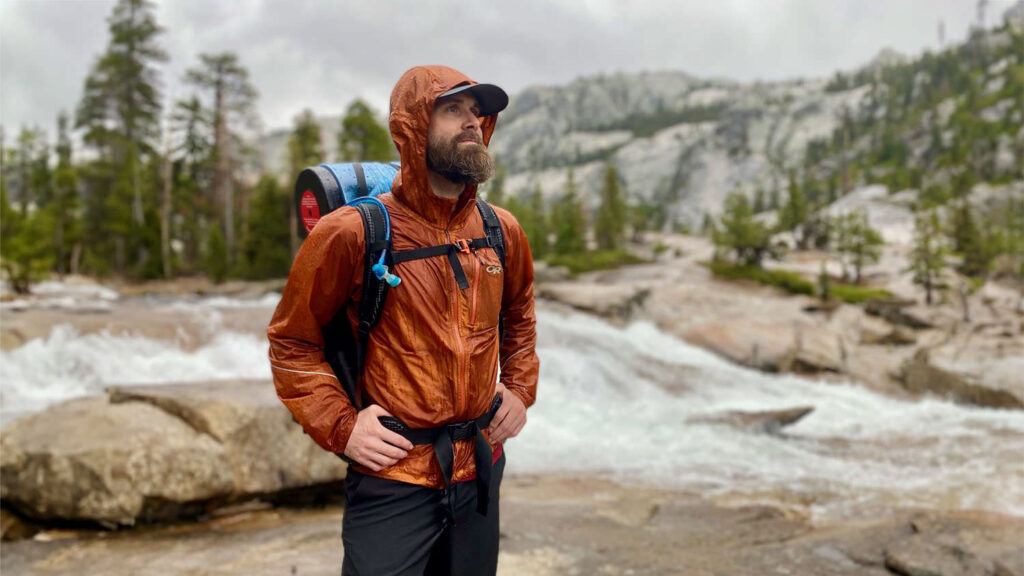
10 Best Rain Jackets of 2024
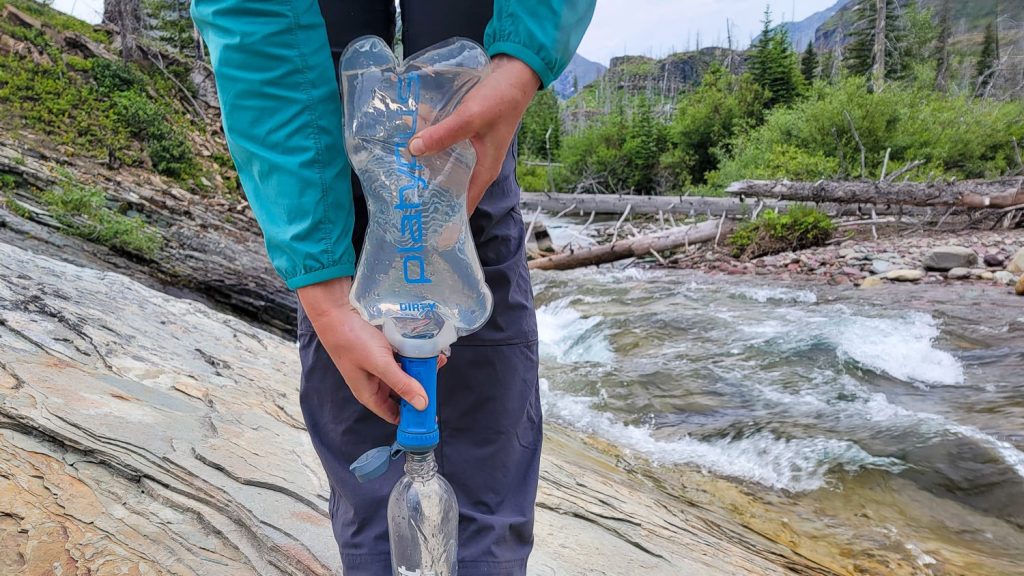
Platypus QuickDraw MicroFilter System Review
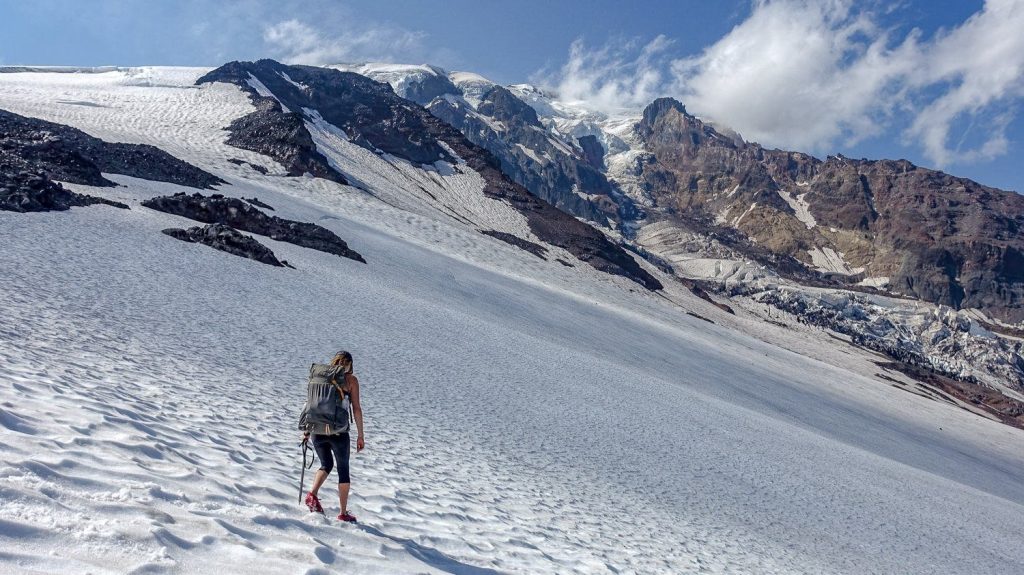
C.A.M.P. Corsa Ice Axe Review
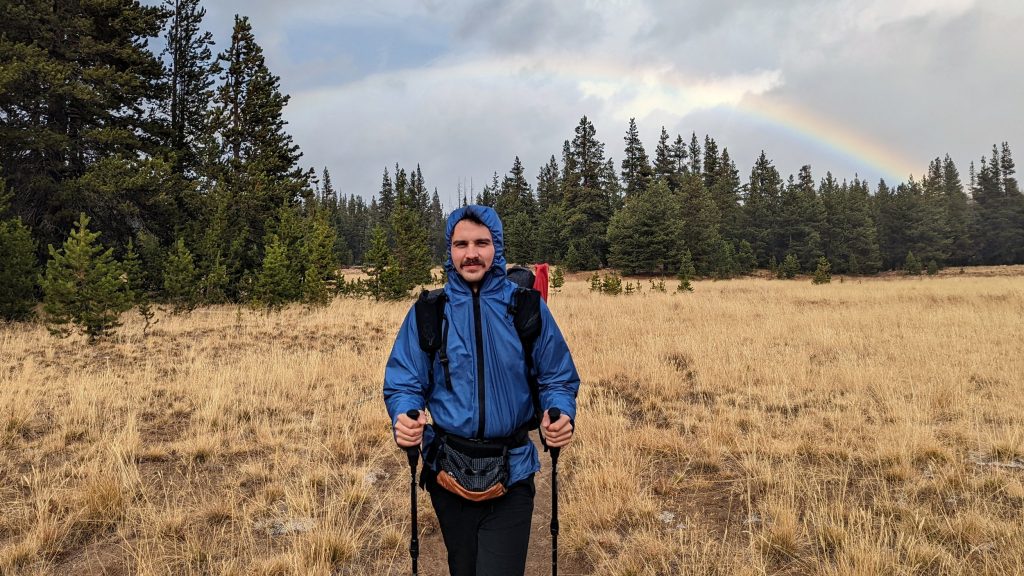
Enlightened Equipment Visp Rain jacket Review
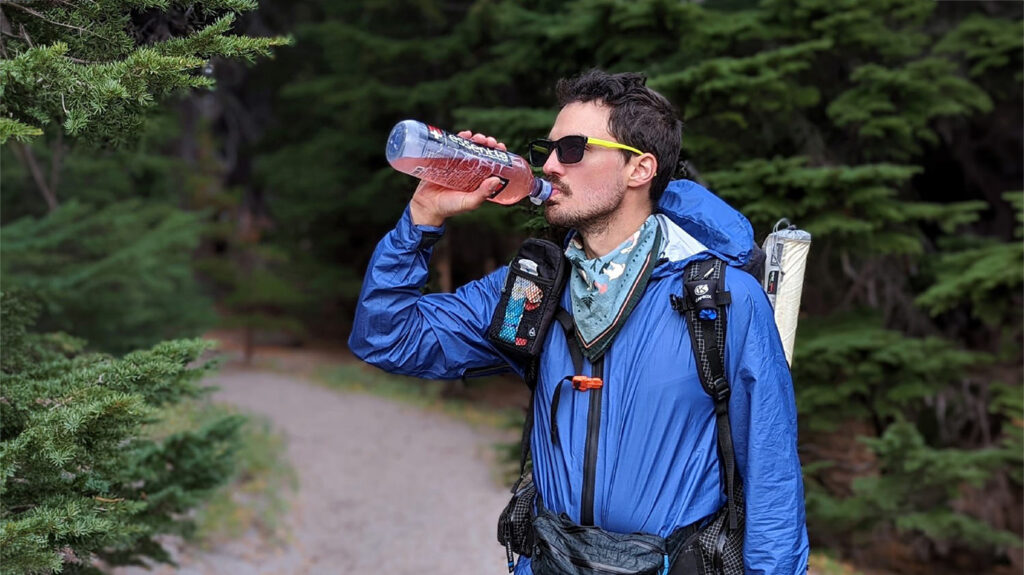
10 Best Hydration Mixes & Electrolyte Powders of 2024
Get the best content from cleverhiker & around the backpacking world.
Social media is great, but our bi-weekly newsletter is a much better way to stay in the know.
Sign up to get our curated emails with the best content from CleverHiker and around the backpacking world. You’ll be turned on to new videos, trip reports, gear reviews, inspiring outdoor stories and much more. So get in the mix!

Day Hiking Essentials Checklist: Pack Right for Your Hike

Okay, I’ll admit it: years ago, I would never have been qualified to tell you what to bring on a hike.
I used to set off on trails completely unprepared for the twists and turns that lay ahead.
I’ve left my rain jacket in my car, and hiked unsuspectingly into chilling alpine storms. Dehydration has made me so thirsty that I’ve gnawed the windburned crust off of a snowbank. I’ve wandered off-trail, become completely lost, and bushwhacked my way into a backcountry meltdown.
Luckily for me, I’ve always come out in one piece, but my failure to prepare could have sent me to the hospital, put other hikers in danger, or worse. Underestimating mother nature is never a good idea.
That’s why I’ve created this essential day hiking checklist for you , fellow hiker. Because years of mistakes have taught me that preparation is everything in the world of hiking. How you plan your trip can be the difference between chaos and bliss.
Want to avoid making the same mistakes that I did?
Stay tuned, I’ve got you covered.
What to Bring on a Day Hike: The Essentials
10 Essentials for Day Hiking
Backpack & storage, worn clothing & carried gear, cold and/or rainy weather gear, food, water & purification, navigation & communication.
- Emergency Gear
Health & Protection
Photography equipment, personal items.
- Final Thoughts: Day Hiking Essentials

Let’s start with the day hiking building blocks.
Listed below are the uber-important survival items that day hikers should consider packing before every trip. This ‘Ten Essentials of Hiking’ list is universally agreed upon in the hiking community and should serve as a baseline for all the necessary supplies you need to bring along on any given day hike.
1. Navigation : map, compass, GPS device, personal locator beacon, altimeter 2. Illumination : headlamp, flashlight, lantern, extra batteries 3. Sun Protection : sunglasses, sunscreen, lip balm, sun-protective clothes 4. First Aid Kit : including medication, bug repellent, and foot care 5. Gear Repair Kit : knife, multitool, repair tape, rope 6. Fire : lighter, matches, fire starter 7. Emergency Shelter : emergency blanket, bivy, tarp 8. Extra Food : extra day’s portion of calories 9. Extra Water : plus water storage, water purification system 10. Extra Clothing : sufficient layers to survive worst-case scenario weather
Beyond these ten essentials, I’ve prepared a more detailed day hiking checklist, broken down into nine different categories. The list is purposely exhaustive and is meant to cover any and all items you might need on a given day hike. Throughout the checklist, I’ll recommend hiking products that I know and love.
The length, weather, and difficulty of your upcoming hike should dictate which items you choose to bring along and which items you leave behind. Use your best judgment and always err on the side of caution.
Study your hike thoroughly, check the forecast, and use the following 52-item checklist to gather all the essential gear you need before your upcoming day hike.

DAYPACK – Use a practical daypack to carry your food, water, gear, and extra clothing while you’re day hiking in the backcountry. No need to get fancy, as a lightweight daypack between 10 and 30 liters should get the job done.
HIP PACK – It’s nice to have quick, easy access to snacks and supplies while hiking, which is why I load up and strap on my hip pack before I hit the trail. Want to hike without a day pack? An intelligently stocked hip pack with slots for water bottles might just be all the storage you need.
PACK COVER/LINER – If your daypack doesn’t come with built-in water protection, then moisture could become an issue. When the rain starts pounding down, you’ll need the contents inside your pack to remain dry at all costs. Bring a waterproof pack cover or pack liner to keep all the gear inside your backpack safe and dry.

When choosing your trail clothes, try to avoid 100% cotton. When the pros say “ Cotton kills ,” it’s because the wetter cotton clothing gets, the more body heat you lose in cold and/or windy conditions.
Opt for synthetic materials instead, or cotton/polyester blends made from breathable and moisture-wicking fabric. These materials will pull sweat and moisture away from your body to the outer layer of the garment, keeping you dry and warm.
SHIRT/TOP – Stock your day hiking wardrobe with breathable athletic tops. I usually don a long-sleeved shirt for my day hikes. It gives me great protection against the sun, blocks wind, and helps keeps me warm when temperatures drop.
PANTS/SHORTS – Your hiking pants/shorts/etc. should be comfortable and unrestrictive. Avoid jeans or bulky slacks and instead wear breathable hiking bottoms that allow for a wide range of movement.
FOOTWEAR – Feet are finicky and everyone’s body is different, so wear hiking footwear that works for you. Hiking boots that enclose your ankles provide the most support, whereas shorter hiking shoes, trail runners ( I wear these ), and minimalist hiking sandals are less restrictive but also less protective.
UNDERWEAR – Ill-suited underwear can make your day hike unpleasant in a hurry, so don’t cut corners when it comes to choosing your skivvies. Pick a lightweight, breathable, and snug pair of hiking underwear that will wick moisture away and prevent chafing.
SOCKS – Hiking socks should be comfortable, breathable, and prevent blisters. For me, those socks are the Darn Tough Hikers , which are made from high-quality Merino wool and offer an unconditional lifetime guarantee.
HAT – A good hat will keep the sun out of your eyes, protect your skin from harsh UV rays, and tame your sweaty hiker hair. I wear a mesh-back trucker hat and will use my Buff underneath to create earflaps if I need extra sun protection.
SUNGLASSES – Bring a pair of polarized sunglasses to protect your eyes from harmful UV rays and prevent damage down the road. Sunglasses don’t have to be expensive either, as you can find affordable pairs online for under $15 .
TREKKING POLES – For hikers with sensitive knees, trekking poles are a godsend. Bringing a lightweight and sturdy set of sticks will give you two more points of contact with the ground and help ease the pressure off of your knees.

Before your day hike, it’s important to understand the potential weather you might face on the trail. Study the forecast, research typical conditions, and pack your bag accordingly. While you may not need to bring every item listed below during a day hike, pack all that’s essential for staying warm and dry during a worst-case scenario.
LIGHT JACKET/THERMAL – If you anticipate a chilly hike, pack a light jacket or thermal base layer to protect against the cold. You can layer this with your hiking top, rain jacket, and down jacket to stay comfortable as temperatures drop.
RAIN JACKET – Have a lightweight rain jacket on hand if there is even the slightest hint of precipitation in the forecast. Getting stuck in the wilderness with no protection from rain can leave you vulnerable and at the mercy of the elements.
WINTER JACKET – A packable, lightweight winter jacket is a must-have for day hikes where wind chill temperatures might dip close to freezing. The layers of insulation in your jacket will help trap body heat and keep you warm when things turn nasty.
RAIN PANTS – If your day hike forecast includes the possibility of substantial rain, bring along a pair of packable rain pants to pair with a rain jacket. A solid set of rain pants can mean the difference between ‘shivering, stumbling, and cursing’ and ‘dry, warm, and happy.’
LONG UNDERWEAR – When day hiking in cold weather, bring a pair of long underwear to provide an extra layer of insulation for your legs. Conserving heat in your legs will regulate your body temperature and allow you to push on as temperatures plummet.
WINTER HAT – During cold-weather day hikes, body heat escapes from your head faster than any other part of your body. Pack a warm winter hat to help stabilize your body temperature, and you will expend less energy trying to stay warm.
GLOVES – Day hiking in cold weather with exposed hands can suck the fun out of your day, along with your body heat. It can also lead to hypothermia or frostbite in extreme cases. Protect your digits with a quality pair of waterproof gloves when chilly and/or wet conditions threaten your well-being.
FACEWEAR – Constant exposure to the elements — wind, dust, rain, snow, and sun — can do a number on your face, so bring along some proper protection for your next day hike. Multifunctional facewear can be used in a myriad of ways and will shield your face from almost anything nature throws its way.
GAITERS – If significant rain is in the forecast, consider packing a lightweight pair of gaiters — especially if your footwear isn’t waterproof. Proper gaiters will block water and debris from entering the opening of your shoe, keeping your feet dry and undisturbed in the process.
CRAMPONS – When hiking on packed snow and ice, crampons should be an essential part of your day hiking gear checklist. An effective set of crampons will penetrate ice and grip frozen trails, preventing slips and falls that could derail your adventure.

Food and water are your hiking fuels, so kick start your day hike with plenty of calories. A strenuous, full-day hike can easily burn 3,000 calories. Some of those calories can be consumed right before you hit the trail, and the rest should be close at hand in your day pack. Here’s a calories burned calculator to see how much food you should pack.
Always bring at least an extra day’s worth of calories, in case of emergency.
SNACKS – Healthy hiking snacks will be the day hiking fuel that keeps you going, so be sure to pack enough calories to sustain yourself for a long day of hiking. Bring calorie-dense, ready-to-eat foods like nuts, jerky, and meal bars that will keep you going all day on the trail.
LUNCH – Snacks alone can get boring, so consider packing a lunch for a mid-day morale boost. If you want a hot meal, pack a lightweight stove and a dehydrated meal. Or pack something as simple as a sandwich to reward yourself for a long day of hiking.
WATER – Staying hydrated is as important as consuming enough calories on your day hike. Bring enough water! Or purify as you go, providing there are reliable water sources along the trail. Consume at least one liter of water per two hours of hiking, and even more on hot, strenuous, high-altitude hikes.
WATER PURIFICATION – If there are multiple, year-round water sources along the trail, a lightweight water purification system is a good option for filtering as you go. Other options include using iodine tablets or zapping your water with UV rays. All these methods allow you to carry less water weight as you hike and will allow you to clean water sources in case of an emergency.
WATER STORAGE – You’ll need to carry liquids while hiking, so choose a water storage system that works for you. Large-volume hydration packs, insulated containers, collapsible pouches , or old water bottles — the choice is yours.

Losing your way in the backcountry can be stressful and even life-threatening, so come prepared. Arm yourself with an accurate map (print and/or digital), a reliable compass, and the skills to stay on track even when the unexpected happens.
MAP – Though many trails are very easy to follow, always bring a detailed print map for less-established day hikes into the backcountry. Should you get lost or disoriented, a good topographical map will show you the contours of the land and guide you back to civilization.
COMPASS – If you don’t know your direction of travel, a map alone might not be enough to get back on the right trail. Always pack a reliable compass — magnetic or digital — and use it in conjunction with your map to keep moving in the right direction.
CELL PHONE – Many hiking purists choose to travel with only a printed map, but the truth is that smartphones can also be excellent tools for navigating the wilderness. Just make sure your smartphone is equipped with GPS technology that doesn’t rely on cell phone tower connections. And keep your battery charged and a backup map close at hand.
POWER BANK – Your cell phone won’t do you much good if its battery dies, so pack a lightweight power bank to charge your cell phone as needed. You likely won’t need a power bank on most day hikes, but it’s a good piece of gear to have in case you get sick, lost, or injured and need to spend the night on the trail.
OFFLINE DIGITAL MAPS – Many smartphone navigation apps allow you to download an offline map of your hike before you hit the trail. Doing so will let you trace your live location along the trail route without the need for cell service. My personal favorite app is Gaia GPS .
Emergency Day Hiking Gear

Nobody ever intends to get into an emergency situation on a day hike, but it’s important to come prepared for a worst-case scenario. Whether you become lost, threatened , injured, or sick on your hike, bringing along the all-important emergency gear will help you right the ship and return to civilization safely.
FIRST AID KIT – Prepare for injuries both big and small and pack a basic first aid kit on your next day hike. You can purchase a lightweight first aid kit or piece together one from your medicine cabinet. Here’s a helpful first aid kit checklist to ensure that you don’t leave anything behind.
WHISTLE – If you become lost or injured on your day hike, a loud, piercing emergency whistle can attract & guide rescuers to you, even if they’re miles away. Some hikers keep their whistles close at hand, but many modern-day packs have whistles built into their buckles. Choose & learn your preferred method for summoning help in a potential emergency.
BEACON – Personal locator beacons can be expensive, but they consistently save the lives of hikers in emergency situations. These beacons have technology that tracks your location anywhere in the world, and some can also download maps, send SOS messages, and load weather forecasts.
LIGHTER/MATCHES – Bring a lighter, matches, or a fire starter in case an emergency leaves you lost, injured, or stranded during your day hike. The ability to start a controlled fire to signal for help or to keep warm in the cold could be life-saving.
MULTITOOL/POCKET KNIFE – Though you hopefully won’t need to use one on your day hike, always pack a multitool or a pocket knife to help deal with the unpredictable. A basic multitool can repair gear, assist in first aid, make kindling, and prepare food in an emergency.
HEADLAMP – If your day hike stretches into the night, you’d better have packed a headlamp to help you find your way. A powerful light source can safely guide you down dark trails or can help you signal to rescuers for help if you’re lost or injured.
EMERGENCY BLANKET – In the dreadful event that you get stranded overnight on your day hike, a lightweight emergency blanket could save your life. An emergency blanket’s reflective qualities will trap your body heat and protect you against hypothermia when temperatures drop and you need to hunker down for the night.
BEAR SPRAY – If your day hike takes you into an area known to have bears, bring some potent bear spray to defend yourself against any aggressive ones. The highly-concentrated pepper spray will temporarily blind and disorient the bear from as far away as 35 feet, giving you time to make a quick getaway.

Take care of your body and the environment on your day hike by packing the items needed to manage your basic health along the way. The items below will help protect you against sun, bugs, bacteria and allergies, all while leaving no trace.
MEDICATION – Bring along an assortment of medication, prescribed or otherwise, that you might need during your day hike. Backpacker Magazine has written two great posts on this topic: one for over-the-counter meds and one for doctor-prescribed meds . If you have any allergies to food or medication, let your hiking partners know beforehand and tell them how to help in case of a serious reaction.
SUNSCREEN – Bring along a heavy-duty sunscreen (30 SPF or higher) to protect against the sun’s powerful UV rays and prevent sunburns that can lead to skin cancer. Sure, hiking hats and UV-rated clothing often do well in protecting against UV rays, but they’re not always enough.
BUG SPRAY – Insects can often overwhelm you in the backcountry, so bring some effective bug repellent if you anticipate pesky insects on your day hike. By keeping mosquitos, ticks, and others at bay, you’re protecting yourself from such harmful diseases as malaria and Lyme disease.
CHAPSTICK/LIP BALM – Cracked, chapped, and sunburnt lips are common among day hikers but are incredibly easy to prevent. Be sure to pack a tube of long-lasting, UV-rated chapstick — especially on dry and sunny hikes — and your lips will thank you later.
HAND SANITIZER – Hand washing in the backcountry is cumbersome and not always environmentally friendly, so bring an alcohol-based hand sanitizer to keep clean while you hike. Always use hand sanitizer before you eat to neutralize any bacteria, parasites, or viruses that you may have encountered along the trail.
TROWEL – If the urge to go #2 presents itself on the trail, make sure you’re prepared to bury your waste properly with an ultralight hiking trowel . Dig a hole at least six inches deep — 200 feet from any water sources, trails, and campsites — and bury your waste entirely, letting it compost naturally into the earth below.
TOILET PAPER – Always, always bring toilet paper on your day hike, even if you don’t think you’ll need it. And always pack out your TP and avoid burying it at all costs. Many brands of toilet paper have harmful chemicals that will be released into the earth when buried.
WASTE BAGS – While digging a cathole and burying your poo properly is classic hiking etiquette, some trails require that you pack all of your waste out. If that’s the case, come prepared with wilderness waste pouches that allow you to pack your messiest waste out safely and odor-free.

Though photography equipment isn’t essential day hiking gear, it will help to capture the stunning beauty you encounter along the trail. Hikers and backpackers tend to opt for lightweight and durable photography gear that can withstand the rigors of the trail.
CAMERA – While smartphones are the simple solution to capturing photos during your day hike, a packable camera can take your backcountry photography to the next level. Mirrorless cameras are popular among hikers and backpackers because they are compact and capture high-quality photographs.
EXTRA LENS(ES) – If you’re bringing your camera along on your day hike, don’t forget to pack any extra lenses you might need to capture the adventure. Wide-angle lenses are great for capturing epic landscapes, whereas zoom lenses are better for long-distance photos of wildlife.
TRIPOD – Bringing a lightweight and compact tripod on your hike will make you a more versatile photographer in the wilderness. Tripods will allow you to snap stunning backcountry portraits and also help stabilize the camera, capturing more clear and vivid photos.
WATERPROOF BAG – Cameras and water don’t play together well. You can use a Ziploc or a simple rolltop dry bag to give your photography gear the extra layer of protection it needs. Consider using a silicon lens cover to prevent lenses from fogging and accumulating water during especially humid conditions.
PEN & PAPER – While a pen and paper are great for taking notes or doodling during your day hike, their usefulness could help save your life in case of an emergency. Whether you’re forced to leave a note to communicate with rescuers or you need help starting a fire, a weatherproof hiking journal and reliable pen will be there for you when things go awry.
WALLET/IDENTIFICATION – In the event of an emergency, it’s important to provide rescuers with your medical profile and basic personal information. With this info, they’ll have a better idea of how to help you. If you have serious allergies, leave an allergy information card in your wallet, as it will alert medics to any medications or food to avoid.
Final Thoughts: What to Bring on a Day Hike

I’ve learned over the years that day hiking is more than just throwing some food and water in a bag and hitting the trail. Hiking is about preparation, diligence, and respect for mother nature. Reckless decisions can lead to life-threatening emergencies when you’re at the mercy of the backcountry.
And that’s why I created this extensive 52-item day hiking essentials list for you. I’ve experienced firsthand how risky failing to prepare can be. Day hikes, both big and small, deserve thoughtful preparation.
So, get ready for your next day hike the right way. Utilize my extensive checklist, get your hands on the proper gear, and hit the trail relaxed and full of confidence.
And, next time you ask yourself, “What should I bring on my day hike?” I think you know exactly where to get started.
More Hiking & Backpacking Resources
- Essential Backpacking Gear: The Items I Can’t Hike Without
- 8.2 lb Ultralight Backpacking Gear List for 2024
- Waterproof Backpacks to Keep Your Gear Dry
- Backpacking Food: Meal Plan Tips & Ideas for Your Next Hike
- Best US Cities for Hikers: Visit (or Live) Here for Primo Hiking
- Get Paid to Hike: 10 Jobs to Make Money on the Trail
- Best Gifts for Hikers: Unique Hiking Gifts for Any Budget
PIN THIS POST!

Are there any day hiking essentials that should have made my list? What essential hiking advice would you give to a beginner? What piece of gear do you bring on every single day hike? Let me know by leaving some feedback in the comments below!
Last Updated on March 19, 2024

Noel Krasomil
Affiliate Disclosure : Some of the links in this post may be affiliate links. If you click an affiliate link and make a purchase, we may receive a small commission at no extra cost to you. Affiliate links help support this website and keep it 100% ad-free.
Leave a Comment Cancel reply
This site uses Akismet to reduce spam. Learn how your comment data is processed .
Cookie policy
Wanderlust Movement | A South Africa Travel Blog
45+ Hiking Essentials: The Ultimate Hiking Packing List for Beginners
March 18, 2021 by Lauren Melnick
Last Updated on March 6, 2024 by Lauren Melnick
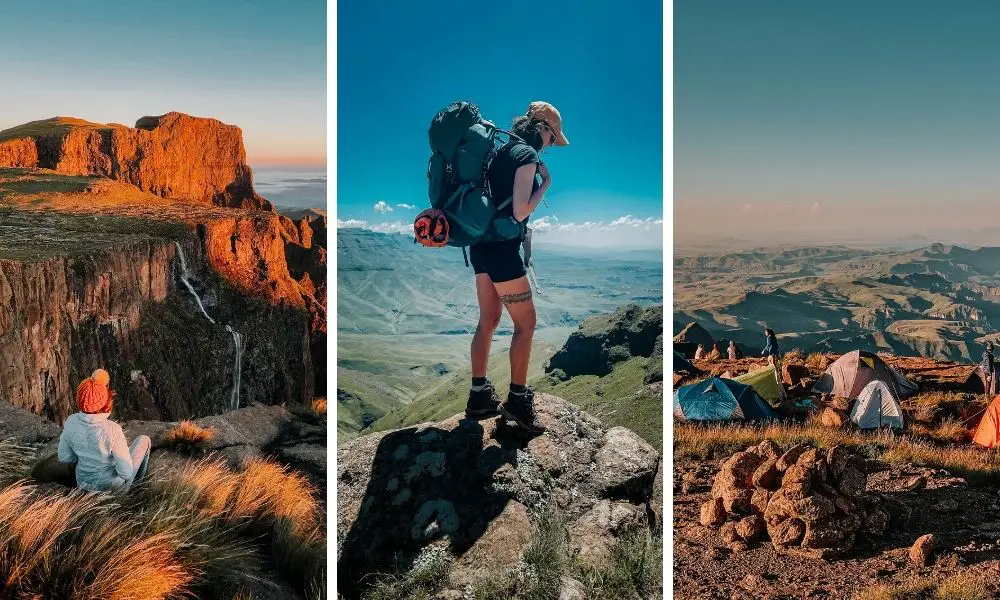
Does packing for an overnight hike make you want to set your hair on fire and send you into a state of panic? Then this is the article for you!
I’m sharing everything you should include in your hiking packing list to make sure you have the most stress-free experience while in the mountains.
However, you don’t need to bring allllll these items for every single hiking trip . You’ll need to tweak it according to your needs. For example, multi-day hikes like the Otter Trail have huts so you don’t need to pack a tent and an insulated mattress.
As someone who has had quite a view hiking fails from not packing the right gear, I’ve learned a thing or two about you need (especially the things that’ll help you get a good night’s sleep).
Trust me, by the time you get to the end of this article, you’ll be an absolute hiking packing master
So, let’s get started – here are all the hiking essentials to pack for a multi-day trek!
Psst…Want more hiking tips and inspiration for your next adventure? Check out these other posts:
- 15+ Best Hikes in South Africa With Mind-Blowing Views
- 12 Best Hiking Trails in Cape Town With Jaw-Dropping Views
- The Best Drakensberg Hikes That’ll Take Your Breath Away
- Hiking The Otter Trail in South Africa: Absolutely Everything You Need to Know
- Hiking Tugela Falls: Africa’s Highest Waterfall
- 10+ Spectacular Multi-Day Hiking Trails In The Western Cape
Table of Contents
Trekking Poles
Hiking shoes, water bladder, first aid kit, mosquito and bug repellent, spf lip balm, sweat wicking shirt, insulated jacket, windbreaker, rain jacket, hiking shorts, hiking pants, wool hiking socks, sleeping bag, sleeping bag liners, insulated mattress, toilet paper and plastic bags, knife and duct tape, jet boil and fuel, water bottle, dishwashing liquid + cloth, portable charger, camera/phone, multi-day hiking packing list, hiking gear for beginners.
Before you go into the mountains, you need the right hiking gear. Here’s what to add to your overnight hiking checklist:
The most important item for any overnight hike is a hiking backpack .
You want to make sure you’re investing in a bag that is made specifically for multi-day hikes. It’s going to give you all the support you need and keep your weight off your back.
I use the Osprey Aura 65l . It’s one of the best hiking backpacks for women as it’s designed for our bodies for a more comfortable fit.
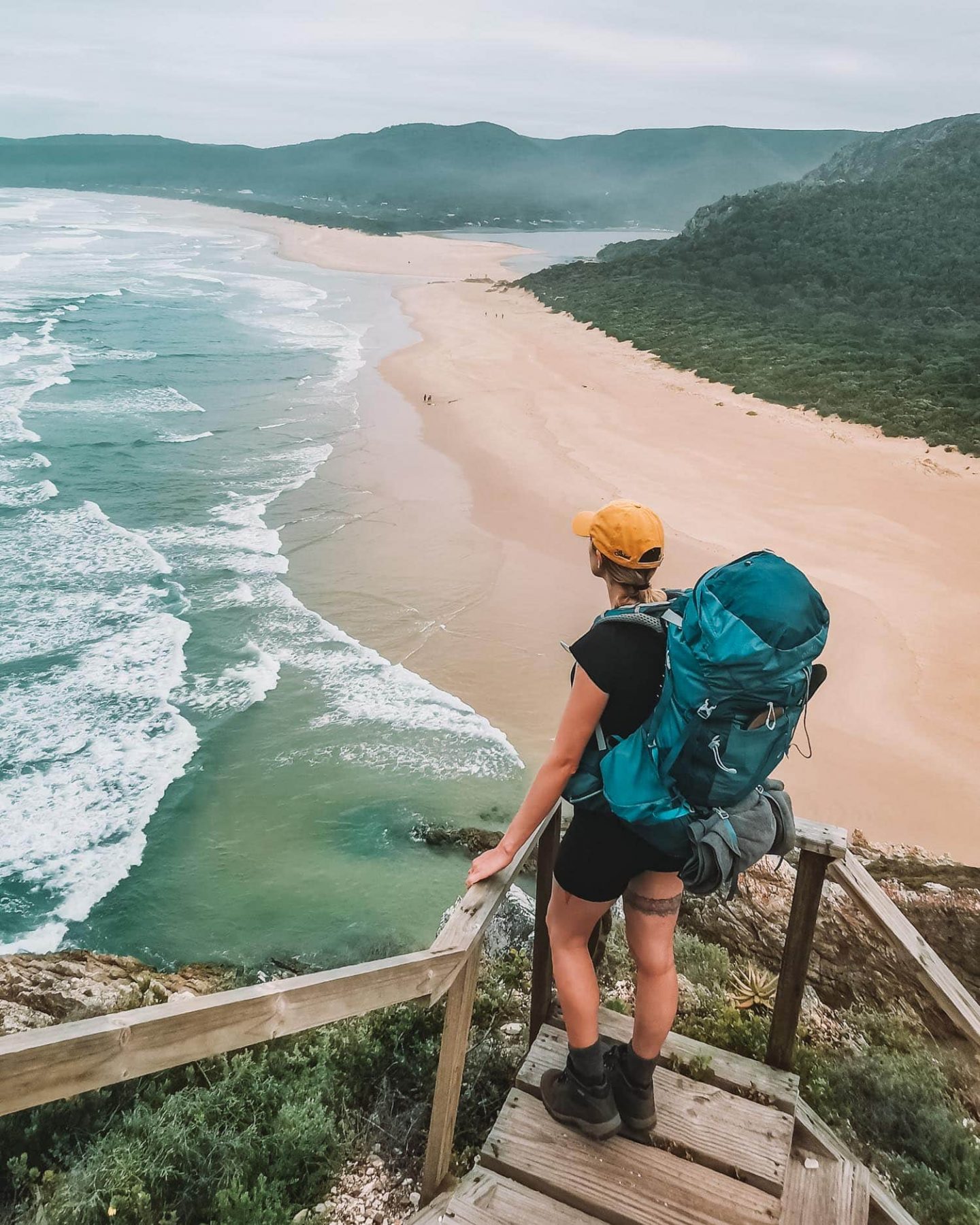
While the weather forecast may say clear skies, sometimes you can’t predict the weather.
A rain cover for your backpack is one of those must-haves for hiking to keep all your gear dry (like your camera and sleeping bag).
If your pack doesn’t come with one, you can buy a rain cover separately. I bought this one from Outdoor Warehouse before I upgraded my pack to an Osprey.
A headlamp needs a spot on any hiking equipment list. It’s also one of my essential items for photography as I often wake up before sunrise to shoot or venture into the wilderness to shoot the Milky Way at 1 am.
When you’re packing for a multi-day hike, a headlamp is going to make it easier to see what’s lurking around your campsite at night.
Plus, you might need to start hiking before sunrise if you’re doing the Otter Trail and need to cross the Bloukrans River at low-tide.

Do you need trekking poles for every single overnight hiking trip? Yes and no.
If your multi-day hike is strenuous (like the Mnweni Circuit in the Drakensberg), trekking poles will go a long way in helping you get up the mountain while it’s not required for an easier hike like Tugela Falls .
However, if you have bad knees, you should invest in poles even if you’re doing easy day hiking trails.
Why do you need a dry bag if your backpack has a rain cover? Extra precautions.
If you’re someone like me who brings expensive camera gear on adventures, you’ll want to add a dry bag to your hiking trip packing list.

Choosing the right hiking shoes for your trip is incredibly important. You want to consider the type of conditions you’re trekking through as well as the style of hiking.
My go-to hiking shoes are the Altitude V Ultra from Hi-Tec . While these hiking boots are quite heavy, they are waterproof (I love jumping in puddles!), have an excellent grip (a must if your route involves scrambling), and super comfortable. For something lighter, I love the K-Way Women’s Scree Shoe .
Water bladders are one of the first things to pack for hiking trips.
It makes it easier to stay hydrated, and you don’t need to keep taking off your pack to pull out your water bottle. I use the 2l water bladder from First Ascent, and it also comes in a 3l if you want more carrying capacity.
Always remember to check the trail has water points and pack purification tablets.
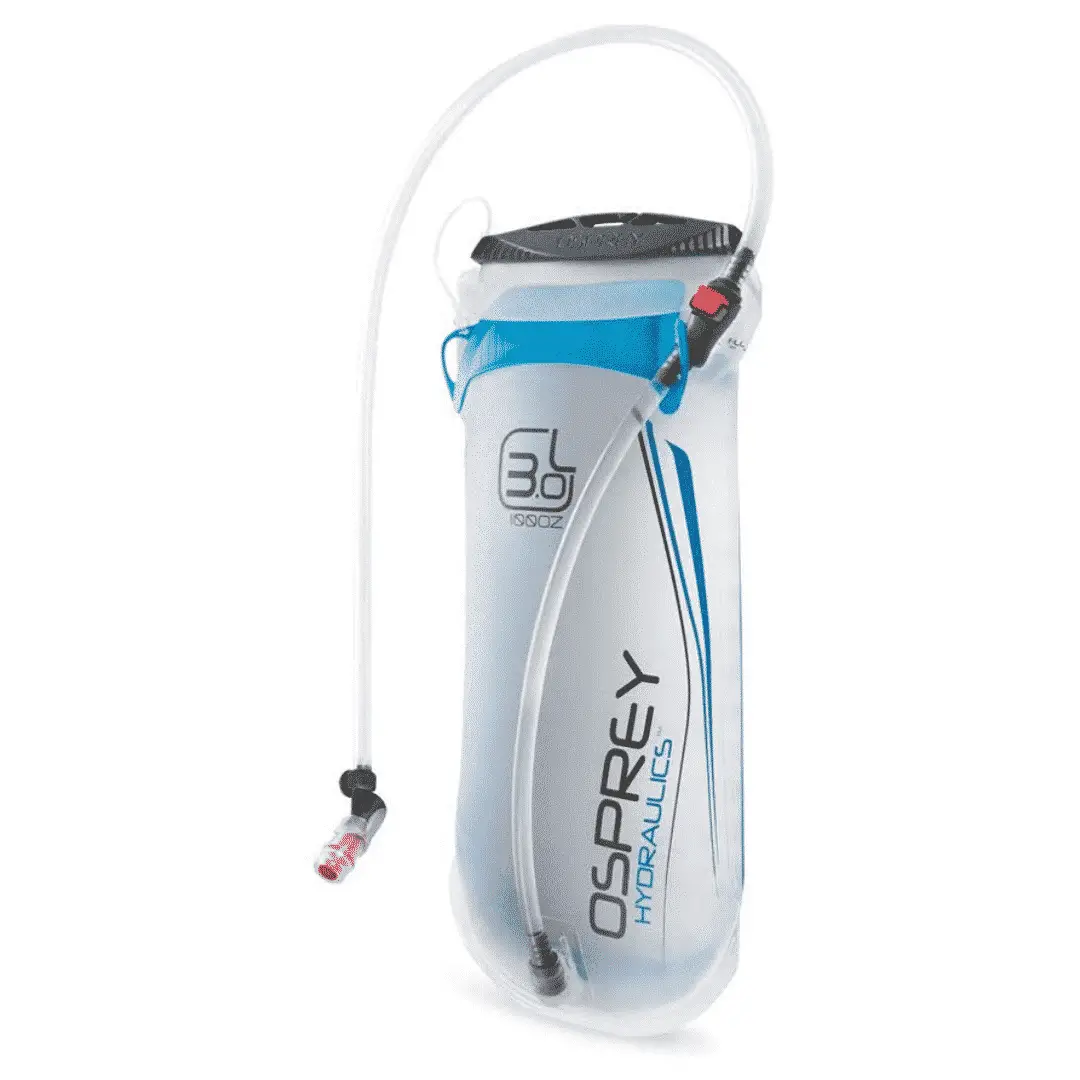
When you’re out in the mountains, you never know what might happen.
You could need a headache tablet, or you might trip and cut yourself on the trail. Add a small first aid kit to your hiking packing list.
Outdoor Warehouse has kits specifically designed with hikers in mind, and it tells you how many people can use it.
If you’re hiking in the summer months, you’ll want protection from the swarms of mosquitos.
If you’re wearing sweet-smelling deodorant, you might attract a few more unwanted friends.
Pack a small bottle of bug and mosquito repellent to get a good nights sleep and avoid bites while on the trail.

I’ll admit, I’m not the best at remembering to pack my SPF lip balm, but it’s a hiking essential. My lips always start to crack and sometimes bleed on a backpacking trip.
When I don’t use my lip balm, I’m in pain for the next couple of days after the hike while the cracks recover.
Don’t leave home without packing sunscreen! It’s one of the top 10 essentials for hikes and will protect you from painful sunburns.
I use the Cetaphil SPF 50+ for oily skin from Dischem . I’d highly recommend it if you’re someone who finds the ‘greasiness” of sunscreen makes you breakout.
P.S. You should wear sunscreen every day to prevent signs of ageing and skin damage.

Toiletries include things like your toothbrush, toothpaste, face wash, make-up etc.
It’s anything that will make you feel clean and comfortable. When packing for a hike, try to use small bottles to lessen the weight in your pack.
What to Wear Hiking
Not packing the right clothes for hiking will leave you freezing or sweating your butt off in the mountains. Here’s what to add to your hiking wardrobe:
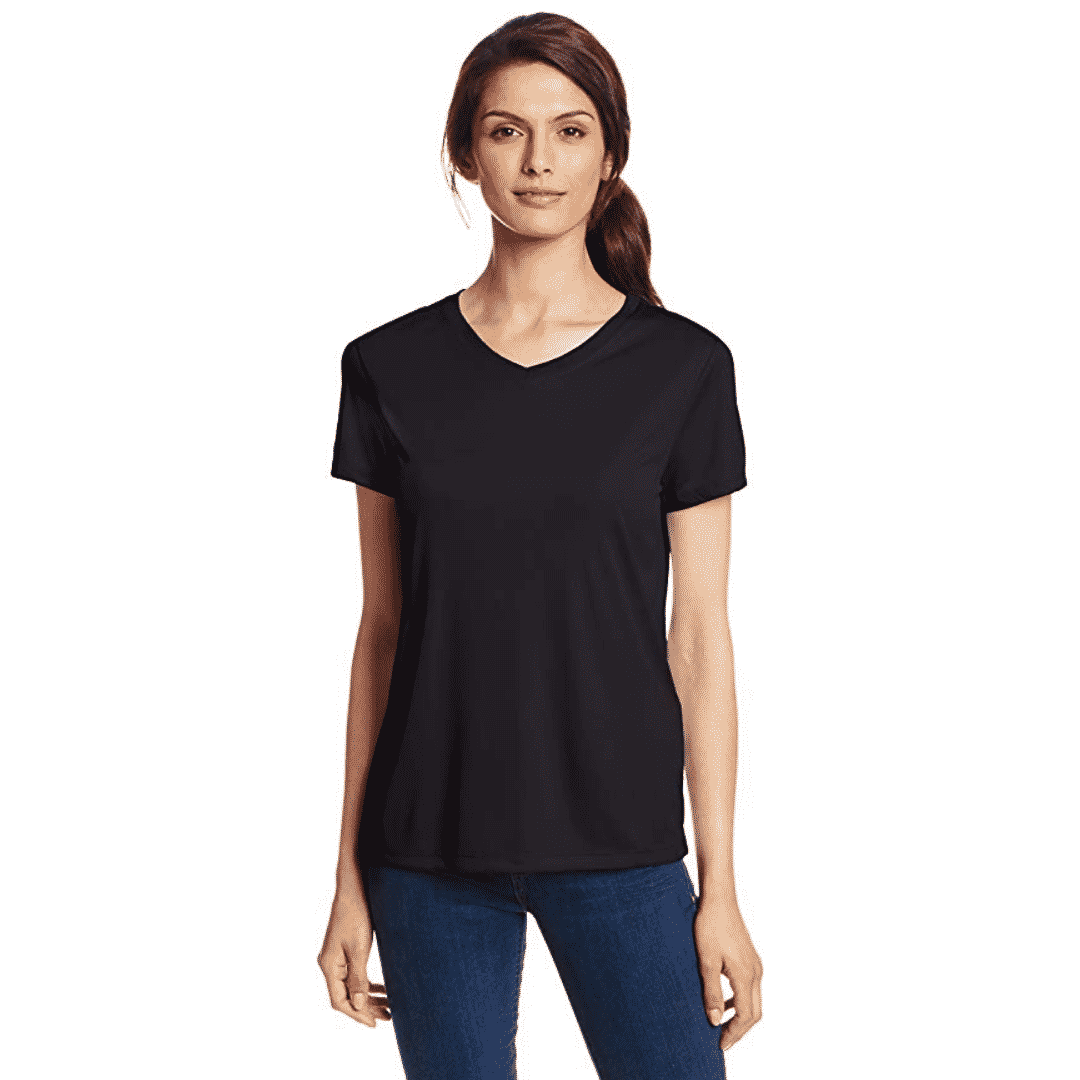
When you start building a hiking wardrobe, invest in a moisture-wicking and quick-drying shirt.
On multi-day hikes, you’re going to sweat A LOT, and you want to wear something that can keep you comfortable.
K-Way has sweat-wicking shirts made from Quik Wic fabric to keep you cool and dry outdoors.
As someone who is a reptile and gets cold as soon as the sun dips under the horizon, I am obsessed with my insulated jackets .
I use the K-Way Women’s Swan ’18 Down Jacket . It’s incredibly light-weight and packs down small.
K-Way also has the Women’s Ember Re: Down Jacket , made from 100% recycled down.
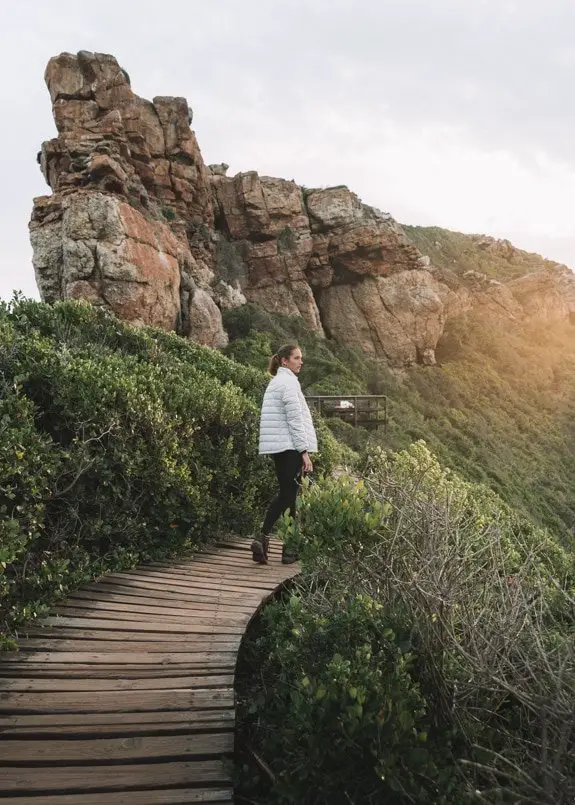
I bought my first windbreaker for my overnight Tugela Falls hike, and it changed my life.
The K-Way Franklin Rain Jacket is light-weight, windproof and waterproof. I used it as an extra layer in the late afternoons and early mornings when the temperatures were cooler and loved it.
When the wind did pick up, it insulated me and kept me comfortable the entire time. I love that you can adjust the sleeves with a velcro strip to stop the wind from sneaking in up your arms!
Another investment I made towards my hiking wardrobe is an insulated mid-layer.
I often reach for my long sleeve mid-layer when I am layering under a heavier jacket or when I want a bit of extra warmth.
My favourite is the K-Way Women’s Hazel Crewneck Fleece . It uses an insulating waffle knit, making it perfect for chilly outdoor conditions.
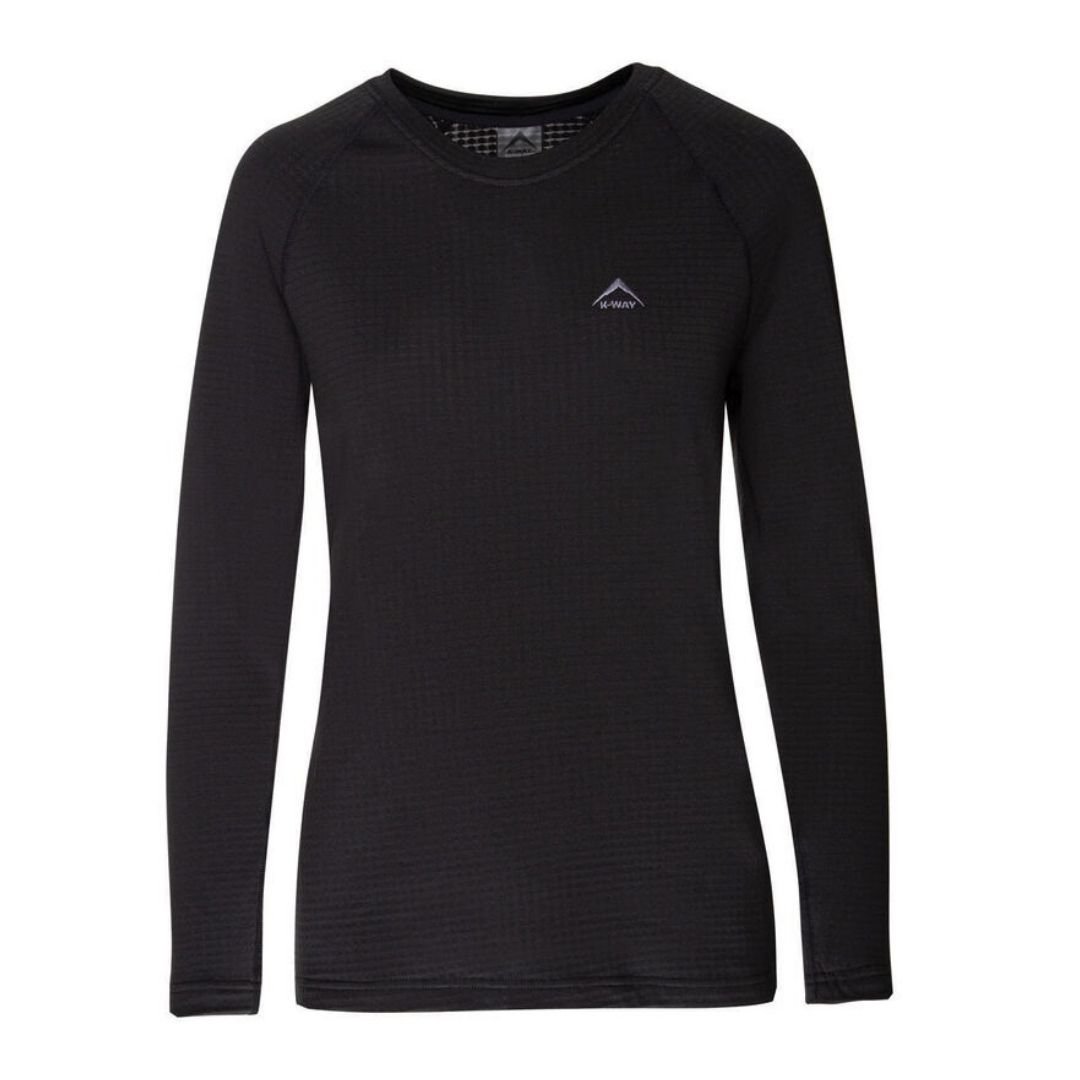
If you have a waterproof windbreaker, you can get away without buying a separate rain jacket.
However, if you’re hiking or trail running in heavy rain, you might want to invest in something like the First Ascent Ladies AR-X Waterproof Running Jacket or the First Ascent Ladies Submerge Rain Jacket .
Both are light-weight, packable, and designed to keep you dry in heavy downpours.
For multi-day hikes in the Drakensberg or anywhere else in South Africa, a pair of hiking shorts will go a long way in keeping you cool in the summer months.
I’ve been using a pair from Boody (it’s made from sustainable bamboo), but I have noticed it’s not the most durable material.
I’m looking at upgrading to First Ascent’s Ladies Corefit Short Tights which has a pocket for your phone!
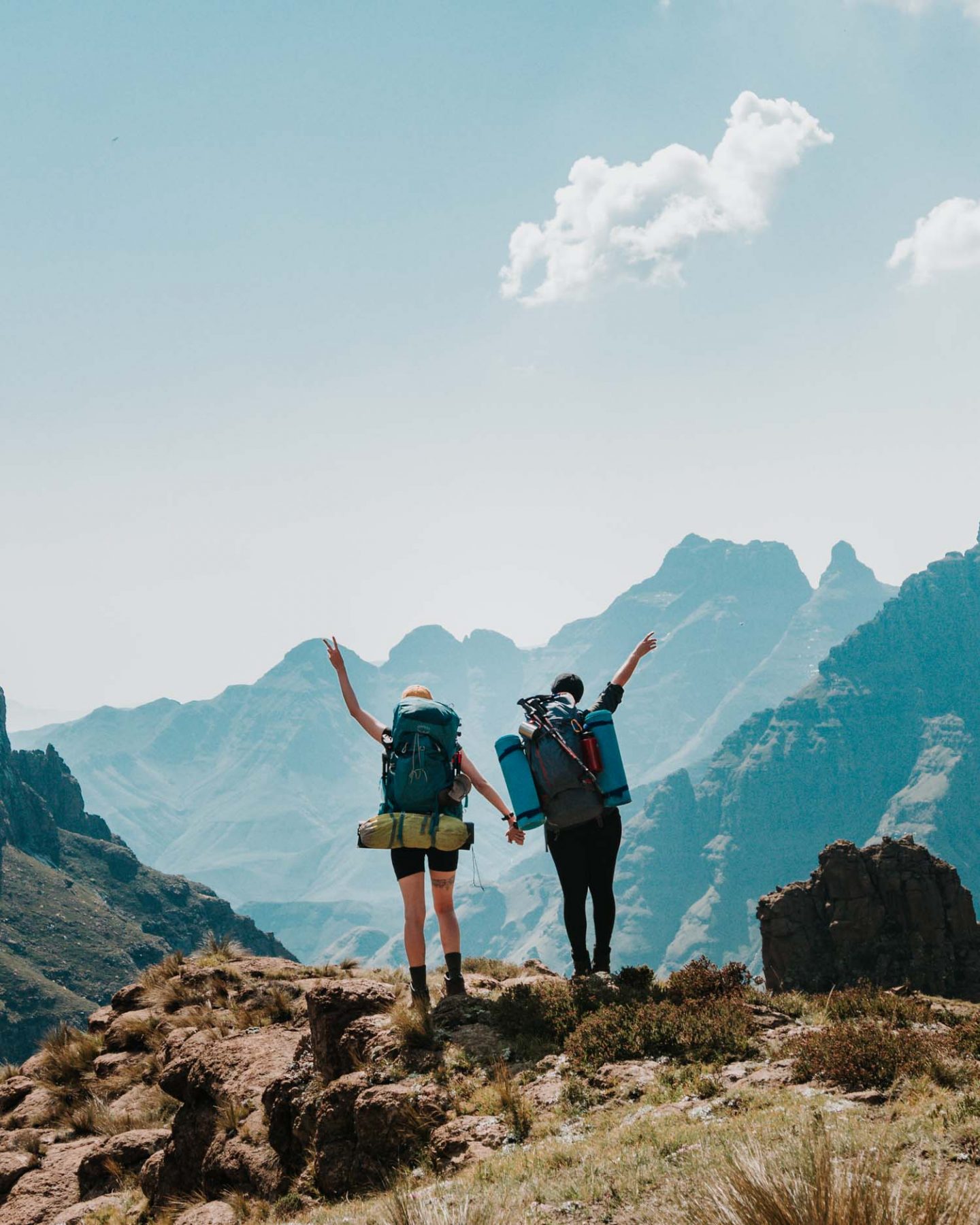
For colder temperatures of if you want to limit sun exposure on your legs, add a pair of long pants to your hiking packing list.
Hiking leggings are a great choice, but if you’re going through more bushy areas, opt for more durable hiking pants .
I did Mnweni without a pair of thermals , and I will never make that mistake again.
Thermals are excellent base layers when you want extra warmth and double as pyjamas in the evening.
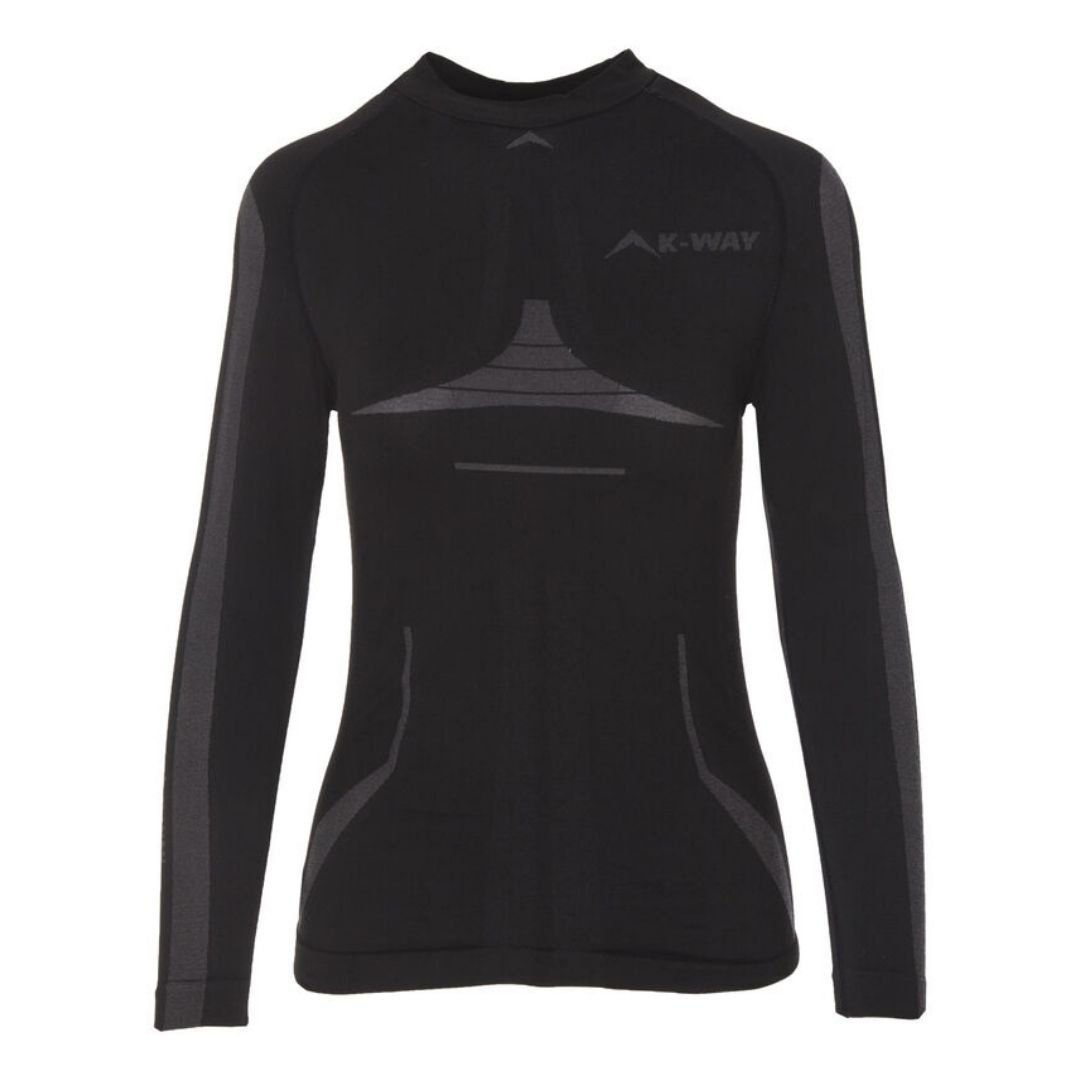
Have you ever had sunburn on your head or ears? It’s the WORST! Protect yourself with a sun hat on your overnight hiking trip.
I often wear a cap from Stoked (one of my favourite South African brands) but opt for a wider brim hat like Olive Venture Wide Brim Hat if you want extra protection.
A thick pair of hiking socks will go a long way in preventing blisters.
For your hiking packing list, look for hiking socks that are breathable, moisture-wicking and odour resistant.
I like to double up my socks as an extra precaution for blisters, and it works like a dream!
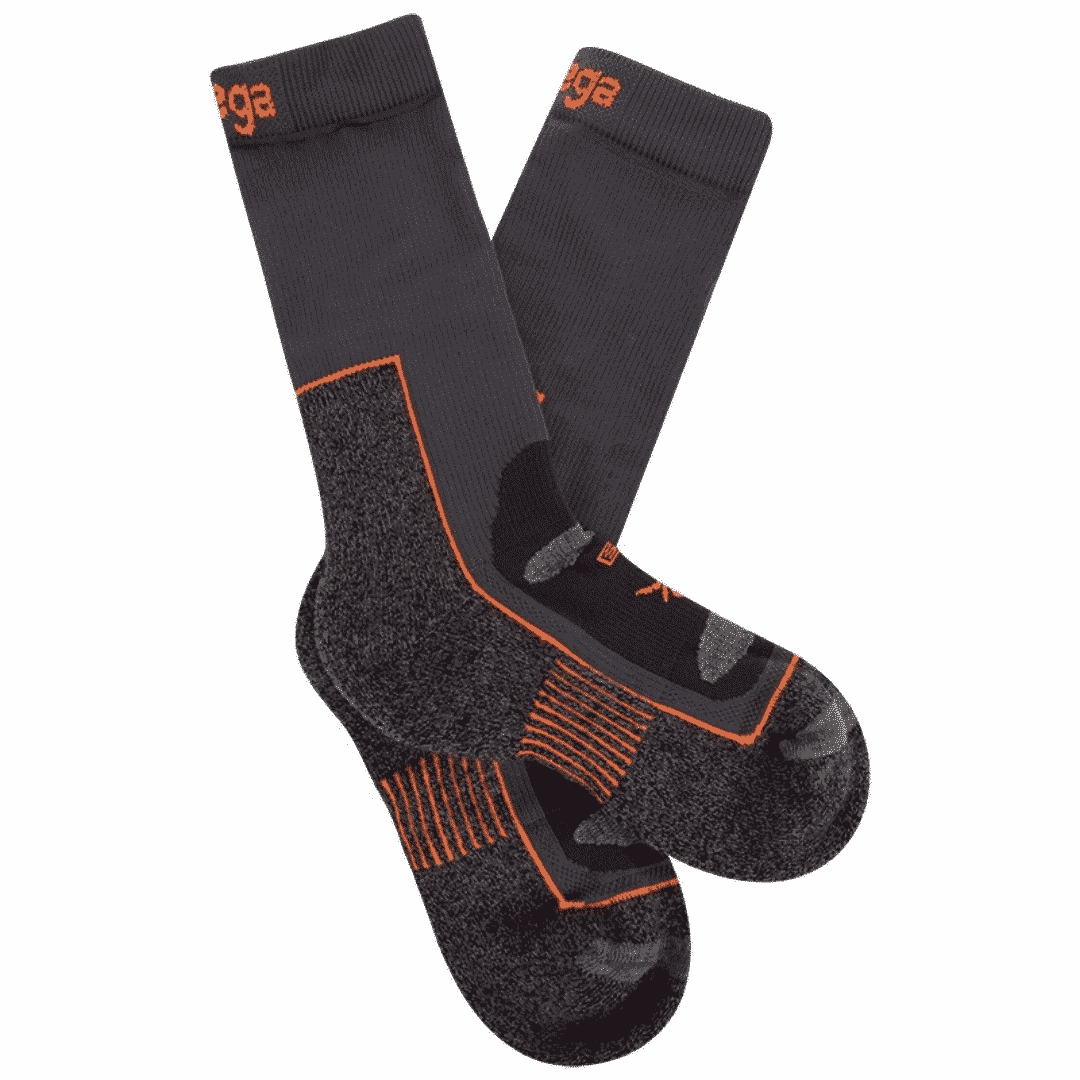
After a long day of hiking, a pair of sandals will feel like the ultimate luxury for your toes.
I bring a pair of flip flops , but if you want to wear socks with your sandals in the evenings, opt for a pair like the K-Way K-Way Women’s Lily Sandal.
Gloves are essential for your trekking gear list if you’re going to colder climates or the temperature will drop quite a lot in the evenings.
Gloves will keep your hands toasty in the evenings and make it easier to cook or take photos in the cold.

Another must-have for sun protection is a pair of polarised sunglasses .
I love the Gold Vintage Octo Lens With Metal Frame from Escape Society. These sunglasses are super affordable and stylish.
Buffs are a handy piece of gear to own.
You can use them as a mask when shopping or use them to protect your neck and face from the sun, wind, and cold.
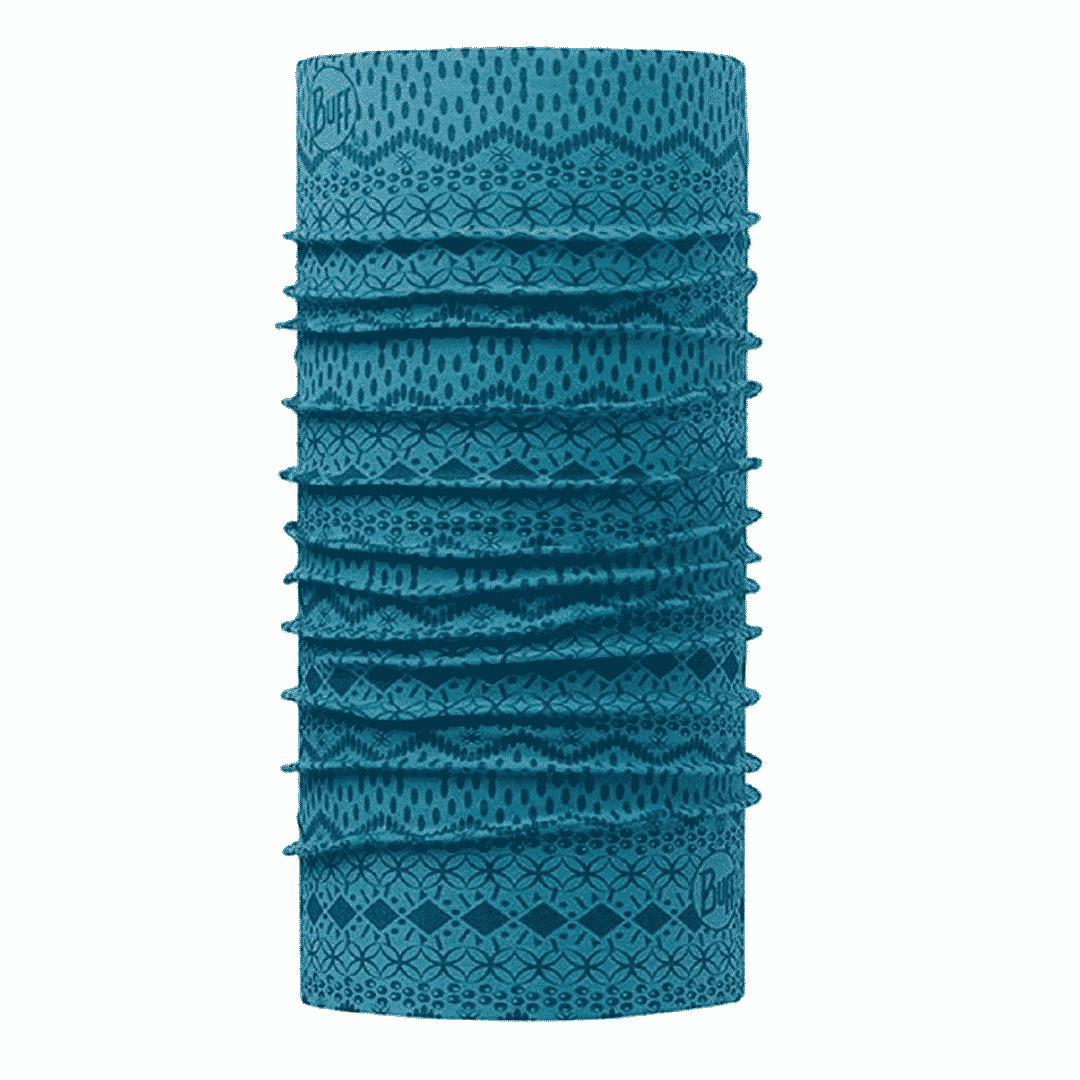
Camping Equipment
For overnight hikes, your camping equipment can make or break your trip. Here are some backpacking essentials to make your night in the wilderness more comfortable:
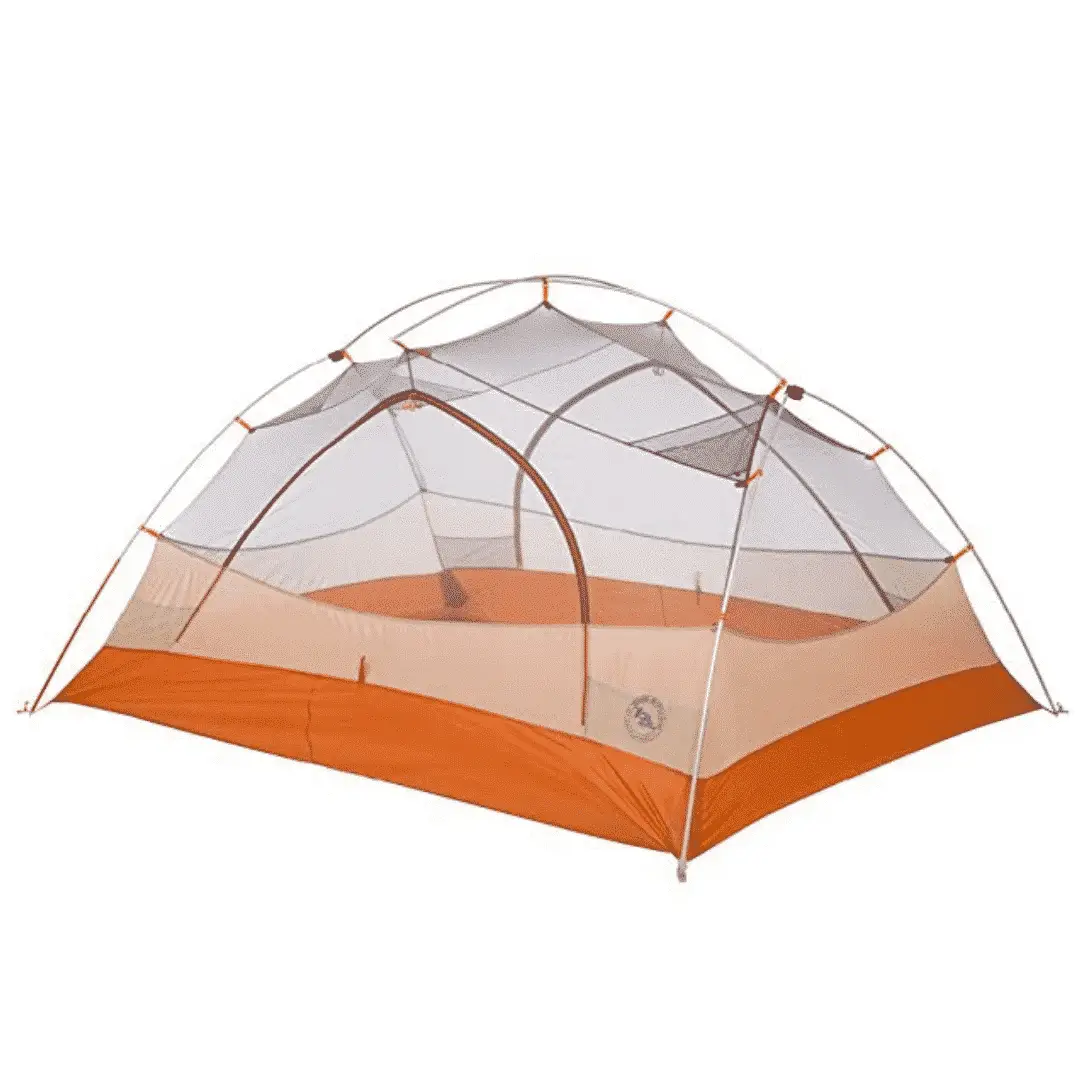
For multi-day hikes, you want to pack a light-weight tent that can handle outdoor elements like wind and rain.
My go-to tent is the Helio 2 Person 4 Season Hiking Tent . It’s small enough to fit into the bottom of your pack and weighs only 2.45 kg.
The right sleeping bag is crucial to getting a good night’s rest on your overnight backpacking trip.
When I first started multi-day hiking, I used the same cheap sleeping bag I bought for OppiKoppi. BIG MISTAKE. I froze my butt off and didn’t sleep a wink.
For my next trip, I added the First Ascent Ice Breaker Down Sleeping Bag to my hiking packing list. It has a comfort rating of -3°C and an extreme rating of -18°C. The bag weighs 1.62kg and is made from responsibly sourced down filling.
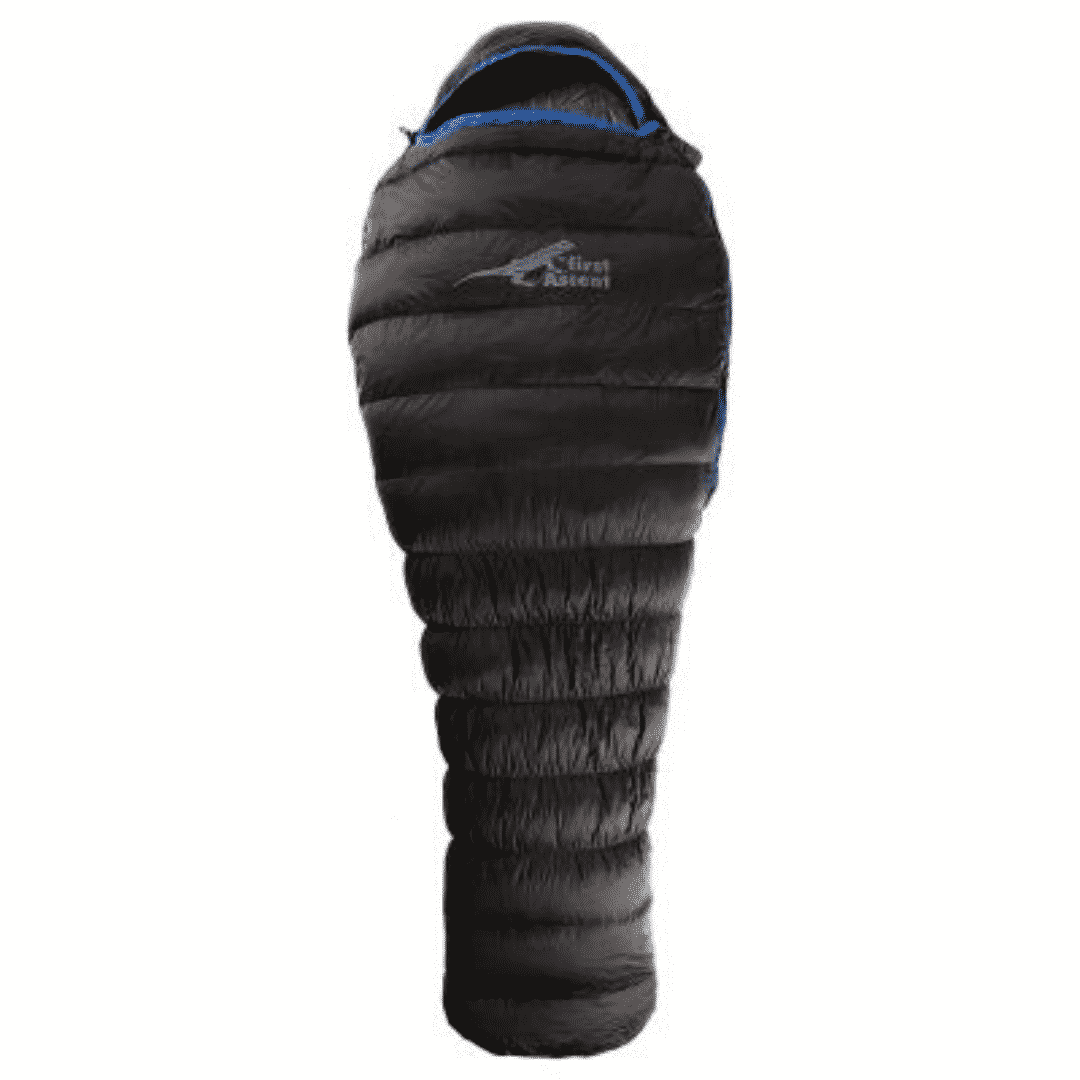
Sleeping bag liners aren’t necessary, but they go a long way if you’re someone like me who struggles with staying warm.
Without a doubt, one of the most underrated items on an overnight hiking checklist is an insulated mattress .
After sleeping on a yoga mat inside a Drakensberg cave , I had the worst sleep in my life. I kept on getting cold, my entire side would go numb, and I could never get comfortable.
When I got back home, I invested in First Ascent Ultralight Insulated Mattress . It’s light-weight, takes up hardly any room, and insulates your body heat, so you don’t freeze to death at night.
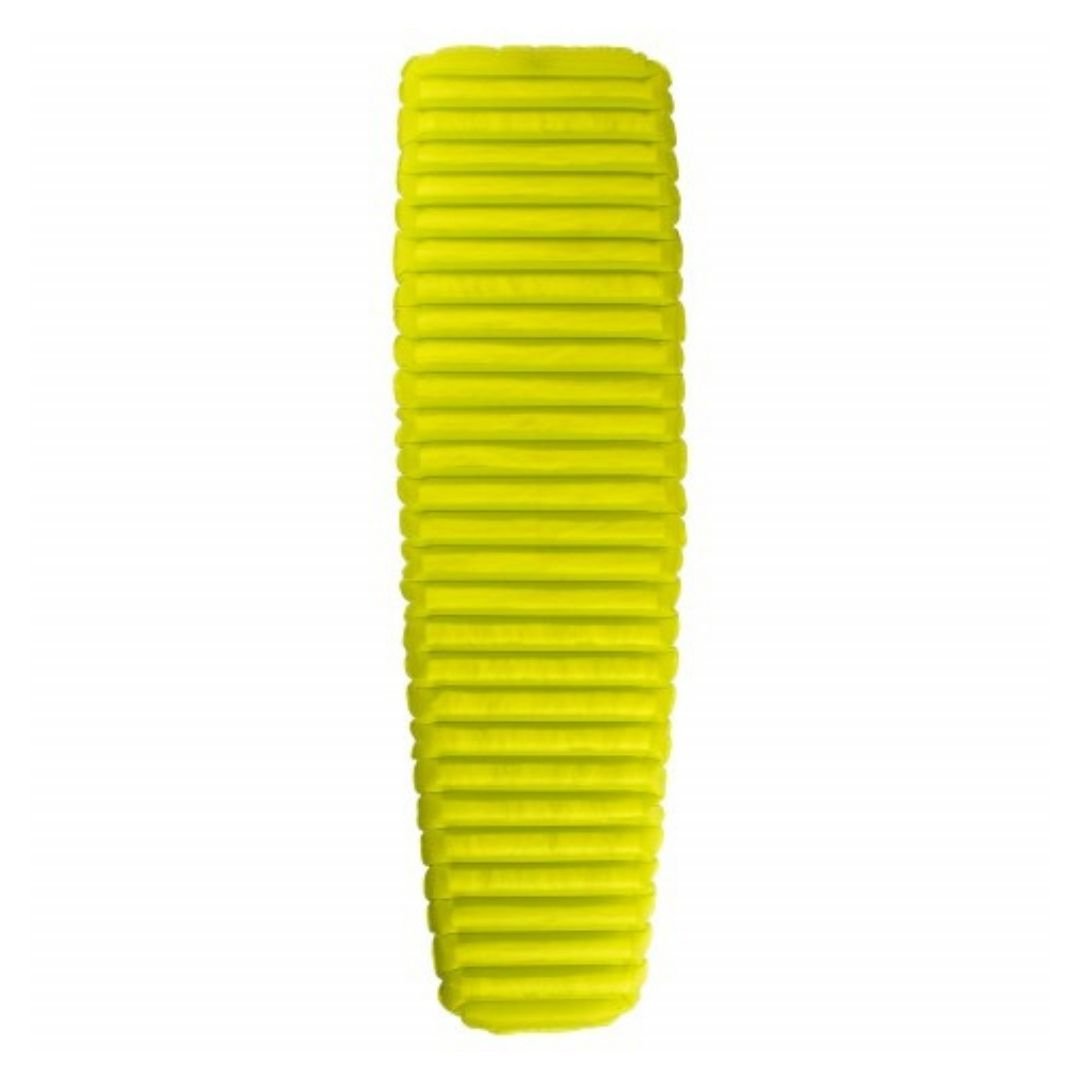
For some reason, I never bought a hiking pillow until my overnight hike to Tugela Falls . In the past, I used a neck pillow or my backpack.
After taking the plunge and buying a self-inflating pillow, I’m never going back. The First Ascent Deluxe Pillow is light-weight, compact, and comfy.
When hiking and camping in the wilderness, one-ply toilet paper is the way to go. It’s the best for the environment as it breaks down quicker than two-ply.
You should always pack a plastic bag to practice leave-no-trace principles and keep the trail waste-free.
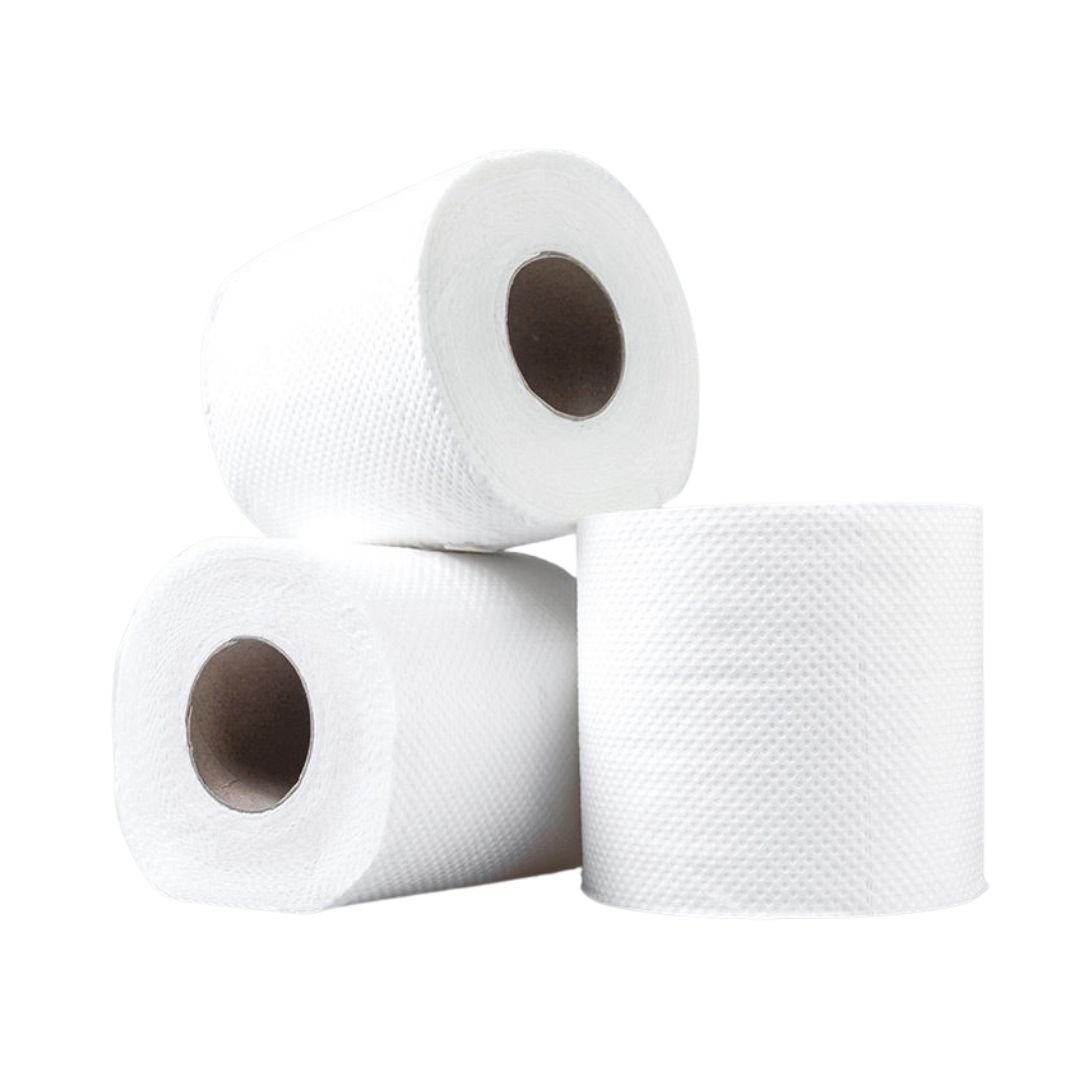
After one or three nights camping in the wilderness with no showers, you’re going to feel gross.
Packing baby wipes can help you feel a bit cleaner, especially if there aren’t any rivers to swim in. Just don’t bring scented baby wipes, or you might attract hordes of bugs.
You never know when you might need a knife. From cutting rope, opening bags/cans, or cutting something up for dinner.
Duct tape is one of the most useful items you can pack. Your tent pole could snap, and you need a quick fix, or your sleeping pad gets a hole.

Kitchen Equipment
The best part of any backpacking trip? Taking your pack off, putting on your flip flops, and making a delicious cup of hot chocolate with mini marshmallows! Here are the kitchen essentials you need to survive a night or two in the wilderness:
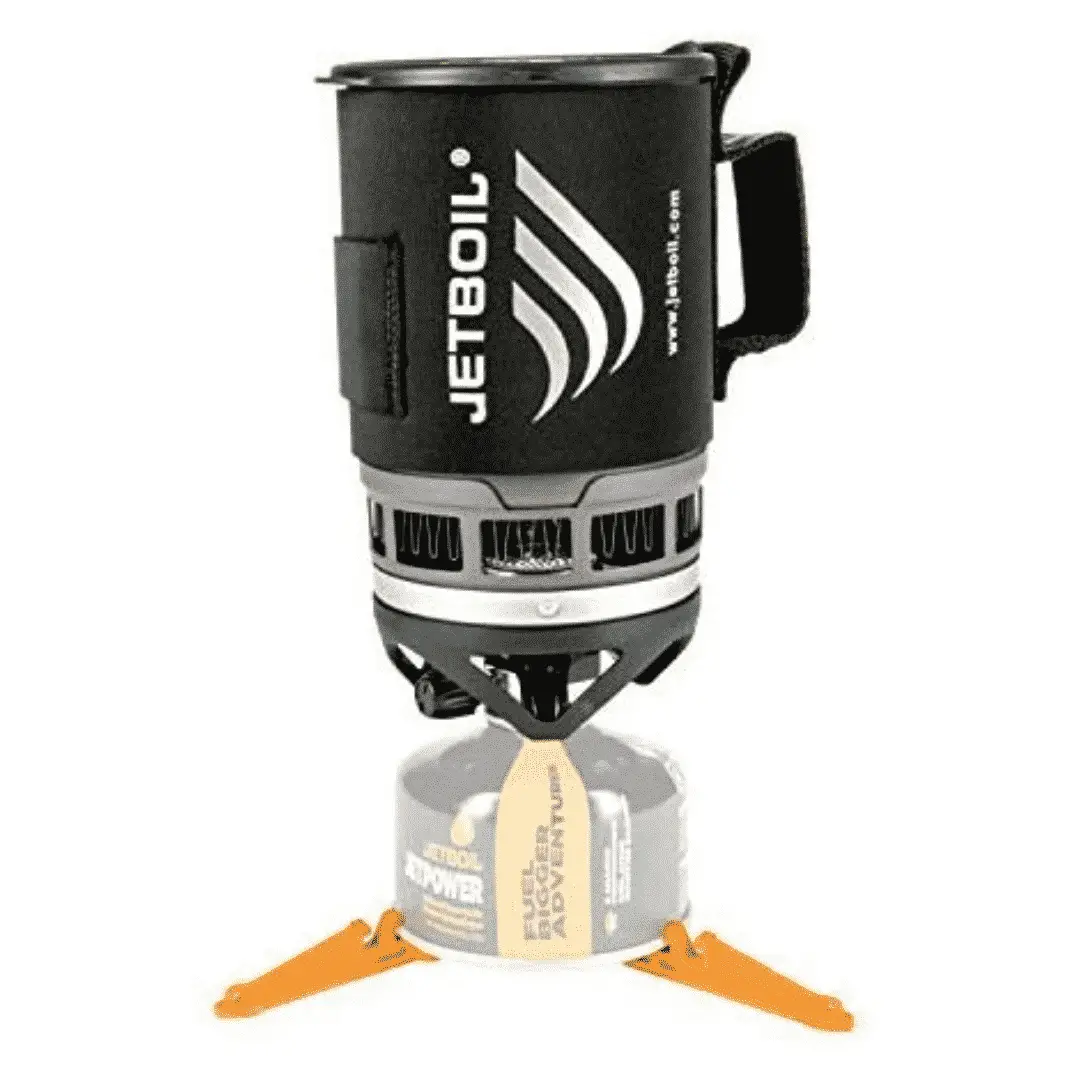
A Jet Boil is an investment, but it will change your life. It’s a nifty device that boils water in less than five minutes!
Plus, most Jet Boil’s come with a 2-in-1 pot and bowl, helping you save space in your pack. Just don’t forget the fuel!
Always pack a lighter. Even if you think you won’t need it, chances are something will happen, and you will.
Plus, it’s always a good time to have a spliff on a mountain at sunset.

I tend to DIY some trail mix on multi-day hiking trips, throw in a few energy bars, and dried food.
At Outdoor Warehouse, you can buy dehydrated food packs , which are super light-weight but a bit pricey. Don’t forget to bring along some instant coffee or a coffee press if you don’t mind the extra weight.
A spork is an excellent backpacking utensil. It doubles as a spoon and a fork, meaning that’s one less thing for you to pack.
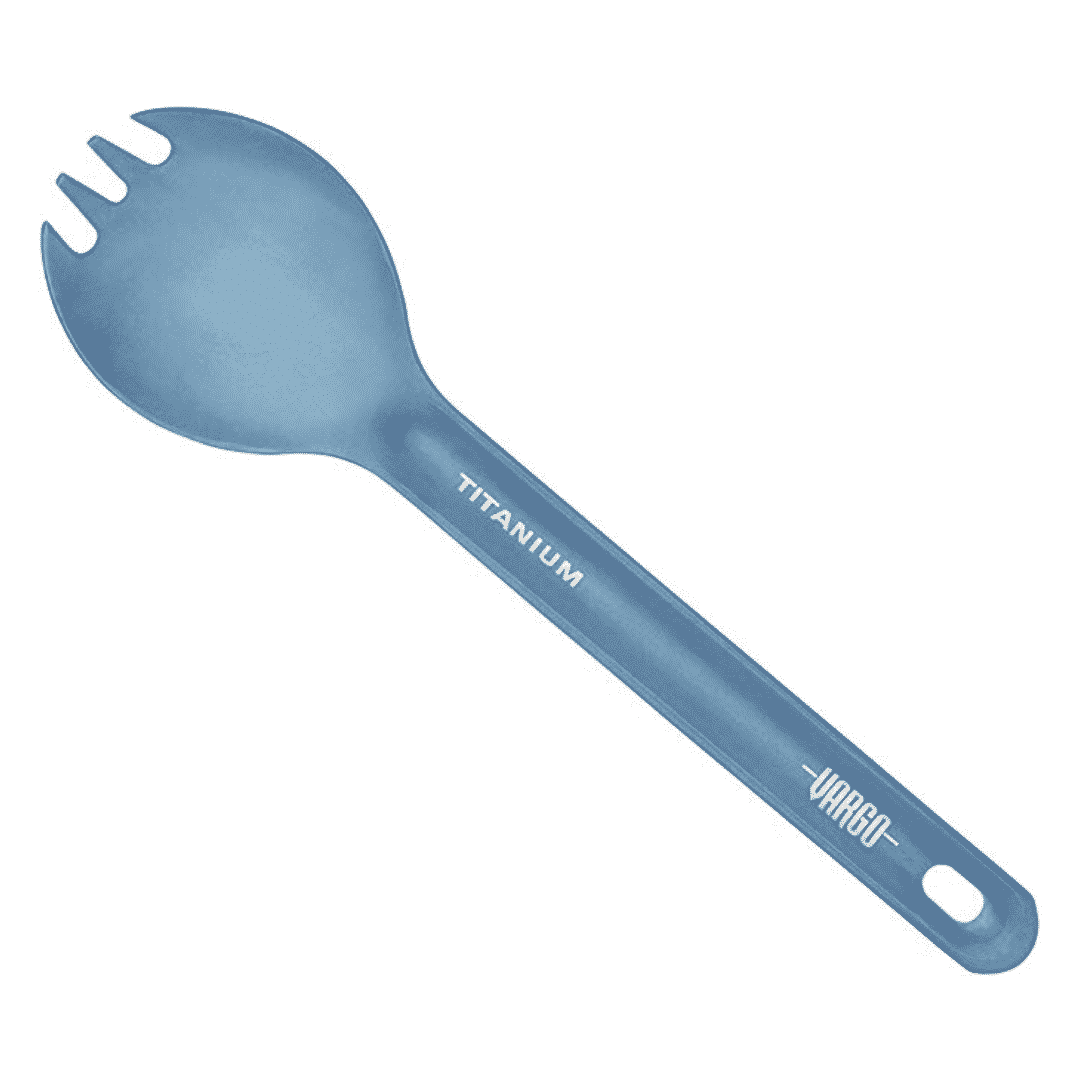
Pack a mug for your coffee or tea. You can clip your mug to the outside of your bag if you’re running out of space.
Bring along a small water bottle to use at the campsite at night.
It’s super useful for when you’re cooking with your Jet Boil or when you need to clean your pots and utensils.

I usually decant a small amount of dishwashing liquid into a travel-sized bottle and pack a small cloth.
It makes the clean-up process in the evening and morning that much easier!
Electronics Equipment
You don’t need a lot of electronic equipment for a hike, but here are a few essentials you may want to pack:
Tip #1 for making your battery last longer, put it on Airplane Mode.
Tip #2, always add a fully charged portable charger to your hiking packing list.

For the casual photographer, your smartphone camera is perfect for multi-day hikes.
However, if you’re someone who wants to shoot landscape or get fancy with astrophotography , you’ll need to pack a camera.
I currently shoot with a Canon 80D and the 18-35mm 1.8 fs Sigma Art lens , but mirrorless cameras from Canon, Sony, and Fuji are a better light-weight option.
You only need to pack a tripod if there are specific shots you need, and stability is a must!
I use the Manfrotto Traveller range.
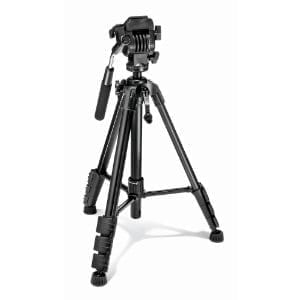
What are your essentials for a hiking packing list? Hit ya gurl up in the comments!
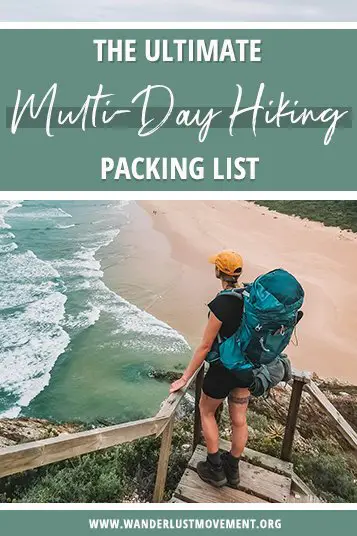
About Lauren Melnick
Lauren Melnick is the founder of Wanderlust Movement, Wander to Here and is a South Africa travel blogger. She's been travelling the world as a full-time freelance writer since 2016 and has visited over 40 countries.
When she isn't typing up a storm, you can find her conquering overnight hikes around the Western Cape, rock climbing, and hosting sold out group travel trips around South Africa, Namibia and Morocco.
Reader Interactions
Leave a reply cancel reply.
Your email address will not be published. Required fields are marked *
This site uses Akismet to reduce spam. Learn how your comment data is processed .
Love The Content?
What to Pack for a Day Hike: Essential Gear and Complete Packing List
Post summary: A comprehensive list of 40+ items to pack for a day hike , including the ten day hike essentials and a free day hike packing checklist!
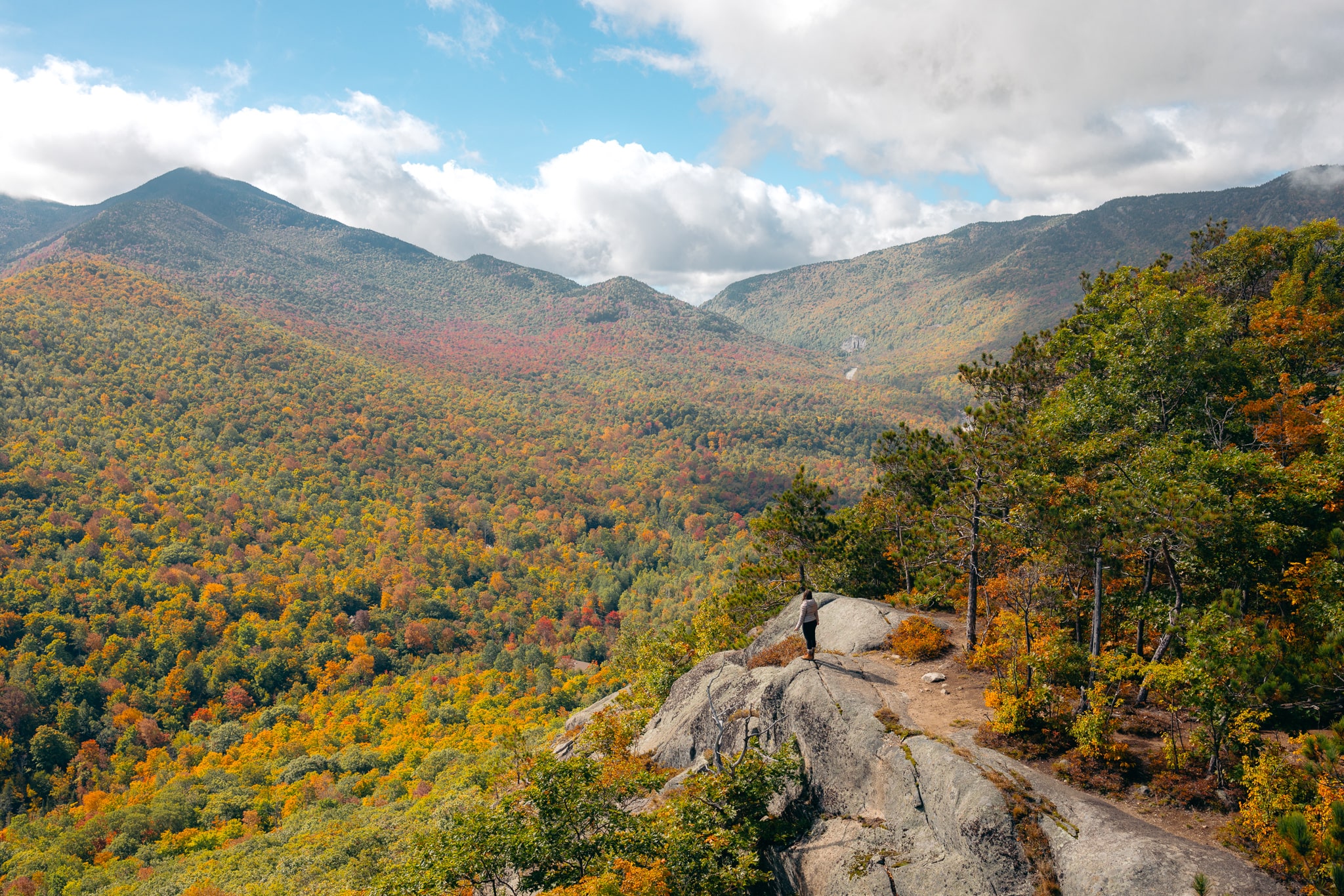
This post contains affiliate links, which means that I will make a small commission if you ma ke a purchase using my links – at absolutely no cost to you!
You picked the perfect hike, the weather forecast looks great, and you’re ready to lace up your hiking boots and hit the trail. But not so fast. Before you head out on your hike, make sure you pack all of your essentials and the correct gear !
When you’re getting ready for a day hike, the last thing you want to worry about is what to pack . That’s why we’ve put together this essential gear and packing list to help make your day on the trails as enjoyable and as safe as possible.
Whether you’re hiking in the Adirondack Mountains , across the desert in Sedona , or through the jungle of Costa Rica , make sure to bring along these key items!
Scroll down for a list of what to pack for a day hike, or jump to the following sections:
- Selecting the right hiking backpack
- 10 essentials you absolutely need for your day hike
- What to wear on a day hike
- Beyond the the 10 essentials: things you should also pack
- Luxury items
- Things NOT to bring on a hike
Table of Contents
Short on time? Pin now, read later!
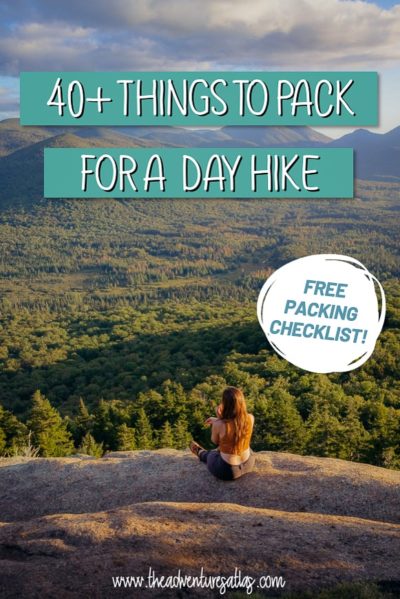
SELECTING THE RIGHT HIKING BACKPACK
When it comes to hiking, one of the most important pieces of gear is your backpack . The best backpack is comfortable and fits all of the essentials items you need to bring on your day hike!
There are a few key things to consider when selecting the right hiking backpack:
- Size: Hiking backpacks are measured in liters. A 10-30L pack is the ideal size for most day hikes. A pack under 20L is a fine for short day hikes or if you’re only packing the essentials. If you’re like me and you like to bring a few extra layers, camera gear, and lots of snacks, then you will want to choose a backpack between 20-30L. .
- Fit and comfort: A hiking backpack that doesn’t fit properly can leave you sore and uncomfortable. For this reason, it’s extremely important to have a high quality hiking backpack that fits you properly before you hit the trails. . Check out REI’s Fit & Torso Size Guide for more information on how your pack should fit. . The best way to test a backpack’s fit and comfort is to try it on in store with the help of an expert. However, if you buy online, I suggest buying from REI or Osprey, who offer free returns and exchanges. .
- Lots of external and internal pockets for storage and organization
- Padded hip belt and chest strap to distribute weight
- Mesh back panels to allow airflow so your back doesn’t get overly sweaty
- Attachment points and gear loops
- Hydration reservoir compatibility
BEST BACKPACK TO CARRY YOUR GEAR AND HIKING ESSENTIALS
I personally recommend investing in an Osprey backpack. Osprey makes some of the best-fitting, highest-quality hiking backpacks on the market.
For men, I recommend the Osprey Talon 22 .
For women, I recommend the Osprey Tempest 20 .
READ THE FULL GUIDE: Best Hiking Backpacks for Women: Find Your Perfect Hiking Pack

PACKING FOR A DAY HIKE: THE 10 ESSENTIALS
If you’re wondering what to pack for a day hike, start with The 10 Essentials. The 10 Essentials are the things you should carry with you every single time you go hiking. They’re the very basic items you would need to keep you safe and even save your life in the event of an accident, an emergency, or if you unexpectedly had to spend the night outside.
Whether it’s 2 miles or 20 miles, these are the things that should always live in your backpack:
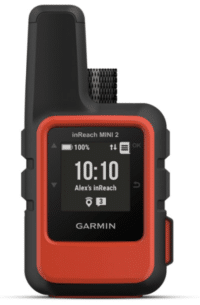
Even if you know where you’re going, navigation is an essential item to bring on your day hike because you never know what could happen!
We personally carry a satellite phone for navigation, maps, and satellite communication. After having been unexpectedly stuck in the Oregon Wilderness overnight without service, we love the peace of mind a satellite phone provides should we ever be stuck in that situation again (*knock on wood*).
Here are the best options for navigation according to your budget:
- Satellite phone ($$$): The Garmin inReach Mini 2 offers 2-way communication, tracking, maps, and emergency SOS capabilities. You can also share your location with your loved ones, which is a wonderful safety feature. .
- Paid apps ($$): Apps like AllTrails and Gaia GPS provide access to offline maps so that you can use your cell phone to navigate without cell coverage. However, you do need to purchase the premium subscription to access that feature. AllTrails premium costs $29.99 per year, while Gaia GPS premium is slightly more expensive at $39.99 per year. .
- Compass, paper maps, free hiking apps ($): The most reliable, budget friendly option is a compass or a good ole’ paper map, which you can sometimes pick up for free at park offices. You can also use the free version of AllTrails or Gaia GPS, but they’re essentially useless if you lose cell service.
FIRST AID KIT
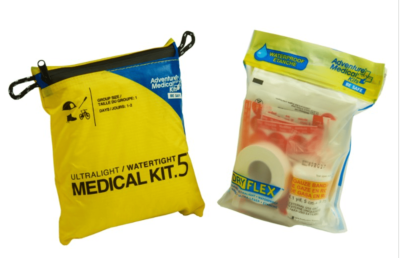
As much as we don’t want to think about them, accidents can certainly happen – especially in the outdoors. That’s why carrying a first aid kit is essential for any hike.
A well-stocked first aid kit should include items like bandages, antiseptic wipes, pain relievers, and sting relief cream. These items can be vital in the event of a minor injury or accident.
I recommend the Adventure Medical Kit because it contains everything you need to treat common hiking injuries, such as cuts, scrapes, blisters, minor allergic reactions, and bug bites. It’s also ultra lightweight and watertight so the contents stay clean and dry. I’ve used mine many times for myself and to help fellow hikers on the trail.
Remember to take inventory of your first aid kit on a regular basis and restock as needed!
EMERGENCY SHELTER
If you get lost or injured, an emergency shelter can provide crucial protection from the elements and prevent hypothermia until help arrives. While most hikers will never need to use their emergency shelter, it’s always better to be safe than sorry.
Your emergency shelter doesn’t have to be a tent, either! An effective emergency shelter can be a tarp, a thermal blanket, or a bivy (which is essentially just a waterproof sack).
HEADLAMP AND EXT RA BATTERIES
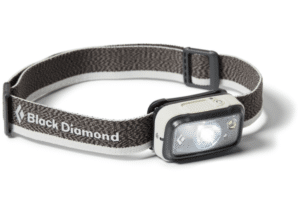
A headlamp is one of the most important items you can bring on any hike. Not only will it help you see where you’re going in the dark, but it also allows you to signal for help if you get lost.
I recommend a headlamp over a regular flashlight, because they free up your hands so that you can use them for other things, like holding trekking poles or navigating tricky terrain.
There are a variety of different headlamps to choose from, but in general, they’re all relatively inexpensive and easy to use. The Black Diamond Spot 350 Headlamp is a great compact headlamp that comes with multiple brightness settings, red night vision, and a strobe light.
Don’t forget to always carry extra batteries!
EXTRA WATER
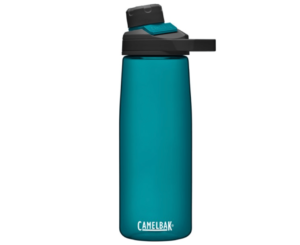
As a rule of thumb, you should carry at least 1L (33.8 oz) of water for two hours of hiking. This doubles for strenuous hikes, or if you are hiking in hot and dry environments.
Carry your water in a reusable water bottle. Look for a bottle that’s lightweight and skinny enough to fit in your backpack pockets. I recommend this 0.75L bottle for short day hikes.
For longer day hikes, you may want to use a hydration bladder instead of a water bottle. This one from Osprey holds 3 Liters of water and fits in a hiking backpack.
The downside to using a hydration bladder is that they can freeze in the winter. To prevent your hydration bladder from freezing on winter hikes, fill it with hot (not boiling) water and slip a cover over the hose to insulate it.
We also never hit the trail without an emergency water filtration system. I personally recommend the Katadyn BeFree Water Filter Bottle or a Lifestraw , but water purifying tablets work just as well.
NUTRITIOUS FOOD
Stave off hiker hunger by packing enough food to keep you going on your hike – plus some extra in the event of unexpected changes to your trip.
The best kind of food for hiking are things that are calorie dense and ready to eat. I prefer trail mix, granola, nuts, and GoMacro Bars. If you are hiking in hot, arid environments, pack some extra salty snacks to help replace the sodium you lose when you sweat.
EXTRA CLOTHES
When you head out for a day hike, it is important to pack a few extra layers or a change of clothes. Even if the weather seems fine when you set out, conditions can quickly change in the outdoors, leaving you cold and wet if you don’t have appropriate clothing on hand.
Extra layers of warm clothes can also be helpful when climbing to higher elevations or facing strong winds, while waterproof pants and jackets can provide extra protection against rain or snow. In addition to keeping you dry and warm, having extra clothes in your pack can help to prevent common injuries like blisters and chafing caused by damp or sweaty clothing.
You will have to adjust your packing list according to your environment. But at the very least, I recommend always packing an extra pair of socks and a rain jacket.
For winter hiking, add an extra pair of mittens, a hat, and micro-spikes. Microspikes are essentially just a net of stainless steel spikes that fit over your boots to give you traction on icy trails. These ones from Kahtoola are the best on the market.
Read next: The Best Microspikes for Hiking on Ice and Snow
KNIFE/MULTI-TOOL AND REPAIR KIT
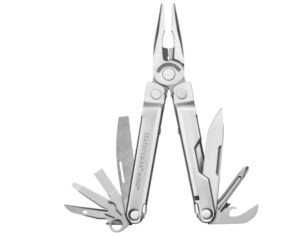
A knife or multi-tool is an item that you should pack for all of your day hikes because it can be useful for so many tasks, from cutting rope to preparing food.
You should also carry a small repair kit , which can be used to patch up holes in gear or clothing. A small roll of duct tape and some zip ties (for shoe lace repairs) are usually all you need for short day hikes.
FIRE STARTER / HEAT SOURCE
A reliable fire starter or heat source is essential to pack , even for a day hike. It doesn’t matter what time of year it is. You will be glad for the ability to make a fire or keep warm if you ever needed to.
Your fire starter doesn’t have to be super fancy or take up a lot of space. In fact, I recommend a few hand warmers, a box of storm proof matches, and a fire starter. Throw those into a small waterproof bag and you’re good to go.
For longer hikes in cold weather, I recommend taking along a small camp stove as well, which you can use for extra warmth if needed.
SUN PROTECTION
Your level of sun protection will depend on where you’re hiking. But at a bare minimum, you should carry a small bottle of sunscreen, sunglasses, and a hat to shade your face. This applies even if it’s cold or cloudy!
For tropical environments, add a long sleeve sun shirt and a hat that covers your ears.
READ MORE: Top picks for Eco-Friendly Sunscreen
PERSONAL ITEMS AND MEDICATION
While not one of the 10 essentials, you will still need to pack any essential medication or personal items . I like to carry a small pouch on my day hikes with my ID, car keys, and some extra cash.
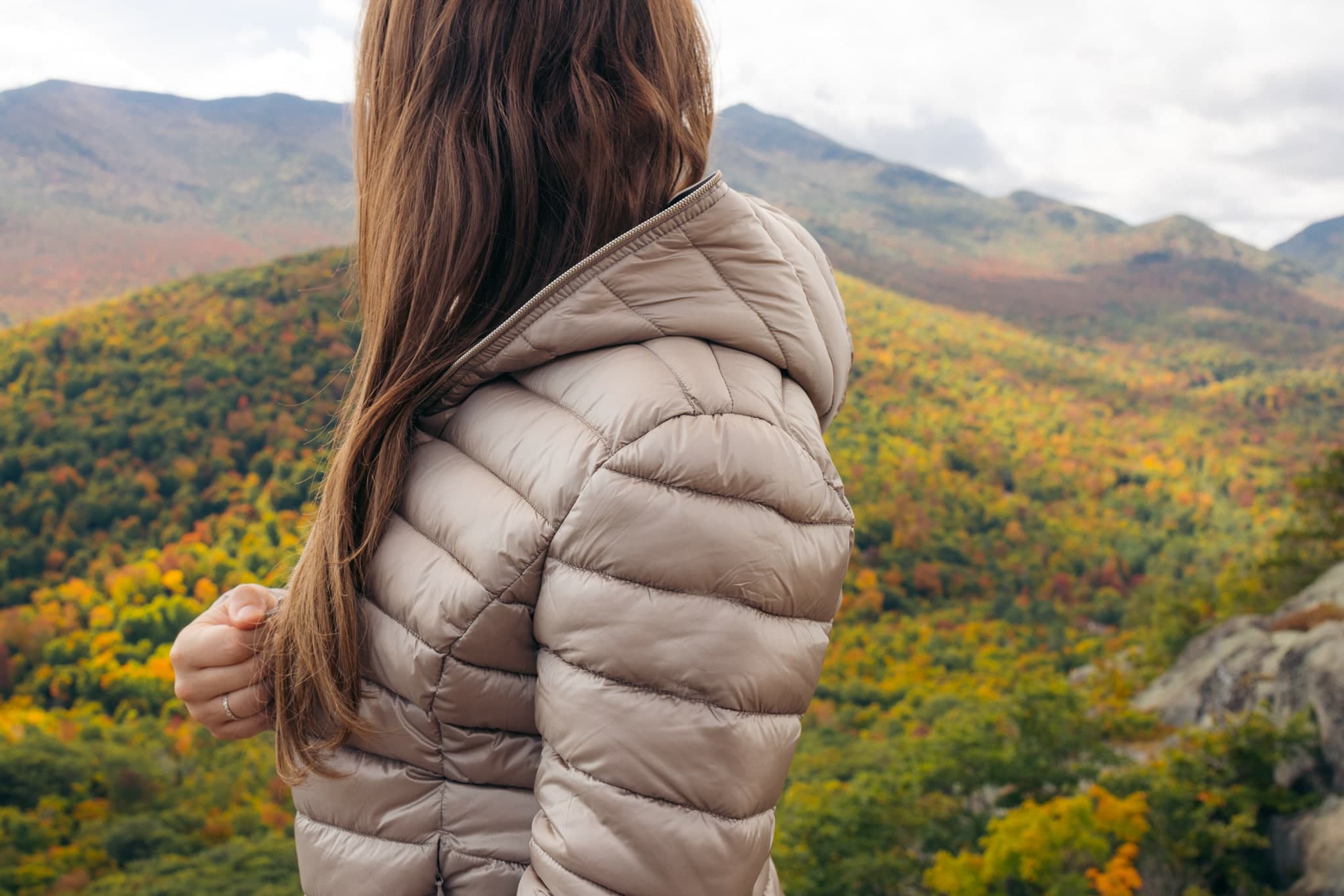
WHAT TO WEAR ON A DAY HIKE
Proper clothing is an important part of deciding what to bring on your day hike.
When it comes to hiking clothes, you should avoid cotton at all costs. This is because cotton retains water and holds the sweat close to your body, which will make you soggy and uncomfortable. Instead, choose hiking clothes that are made of breathable, sweat-wicking material , such as Merino wool, nylon, and polyester.
COMFORTABLE HIKING BOOTS
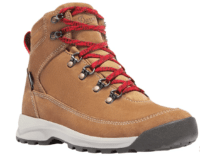
If there is one piece of hiking clothing you decide to splurge on, make it your hiking boots.
High quality hiking boots are an absolute must! The right hiking boots will keep your feet comfortable and dry, as well as provide increased stability and traction on the trail.
For technical hikes or long day hikes on rough trails, I recommend choosing a durable hiking boot with ankle support. There are a lot of good hiking boot brands out there, but Danner boots are my favorite .
For shorter hikes or walks on well maintained trails, choose lightweight hiking shoes instead.
Always remember to break in your new hiking boots before you hit the trail! There’s nothing worse than blisters half way into your hike.
BREATHABLE BASE LAYERS
Your base layers and underwear are what will be sitting against your skin while you’re hiking. That’s why its important to choose base layers that wick away moisture and regulate your body temperature.
The absolute worst material you can wear hiking is cotton. It’s heavy and takes forever to dry, which can draw heat away from your body and lead to hypothermia.
The best base layers are made out of Merino wool, polyester, nylon, or some combination of the three.
Check out the lists below for some of my favorite base layers.
Women’s Tops:
- Artilect Boulder 125 Crew Base Layer Top (lightweight)
- Smartwool Merino 250 Base Layer Quarter-Zip Top (midweight)
- Icebreaker 200 Oasis Crew Top (midweight)
- Icebreaker 260 Tech Long-Sleeve Crewe Base Layer Top (heavyweight)
Women’s Bottoms:
- Icebreaker 150 Zone Leggings (lightweight)
- REI Co-op Midweight Base Layer Tights (midweight)
INSULATING LAYERS AND OUTERWEAR
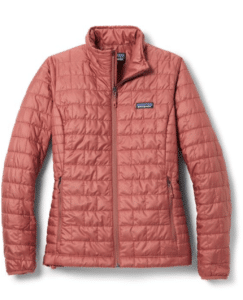
Dressing in layers allows you to easily modulate your core temperature throughout your hike. Of course, the layers you wear will depend on your specific day hike and environment, so you will have to adjust accordingly.
Start with your base layer and then add layers as needed , or store them in your backpack.
For warm weather, a light weight fleece zip up or Merino wool pull over will be enough. In cold weather, you will want to add a mid-weight or heavy-weight fleece and a packable, windproof jacket to keep warm.
Keep in mind that high elevation summits bring strong winds and cold temperatures, even in the summer. Keep warm by packing a jacket, like the Patagonia Nano Puff Jacket , which is super warm but packs up nice and small.
HIKING PANTS
Choose hiking pants that are durable and breathable. Good hiking pants will keep your legs cool and protect you from twigs, thorns, and brush along the trail.
I typically hike in my leggings from lululemon, but they definitely don’t hold up as well as pants designed for hiking.
For more technical or high elevation hikes, I wear the prAna Halle Pants II . They’re stretchy, fast-drying, super flattering and worth every penny.
For cold weather hiking, you can add Merino wool leggings underneath your hiking pants for added warmth (see the list of base layers above).
RAIN JACKET
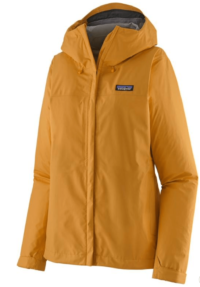
The weather can be unpredictable, especially on longer hikes or at higher elevations. For this reason, I recommend always packing a rain jacket , just in case.
When it comes to rain jackets, you can buy ones that are *actually waterproof* or ones that are water-resistant.
Water- resistant rain jackets are a lot cheaper than waterproof jackets, and generally work fine for very light wind and rain showers.
However, I 100% think i t’s worth paying a little bit more for a rain jacket that is fully waterproof and will hold up against heavy downpours and a much wider range of conditions overall. You’ll get much more use out of it this way.
I recommend the Patagonia Torrentshell Rain Jacket , which is constructed from 3-layer waterproof, breathable polyester. It also packs up super small, which makes it convenient to throw into your backpack.
HIKING SOCKS
Do yourself a huge favor. Leave your everyday socks at home and invest in a quality pair of wool hiking socks. Admittedly, it took me years to figure out the value of socks specifically designed for hiking, but now I will absolutely never hike without them.
Wool hiking socks provide cushion and support in all the right places to prevent chafing and blisters. They also help wick moisture and dry very quickly, keeping your feet cool when it’s hot out and warm when it’s cold.
Here are the hiking socks I recommend:
- Smartwool Performance Hike Light Cushion Margarita Ankle Socks
- Smartwool Performance Hike Light Cushion Crew Socks (light cushion)
- Darn Tough Hiker Micro Crew Cushion Socks (medium cushion)
HATS, GLOVES, ACCESSORIES
Most of your body heat escapes through your head, so its always a good idea to carry a beanie for cold weather and high elevation hikes. For winter hiking, add a pair of mittens.
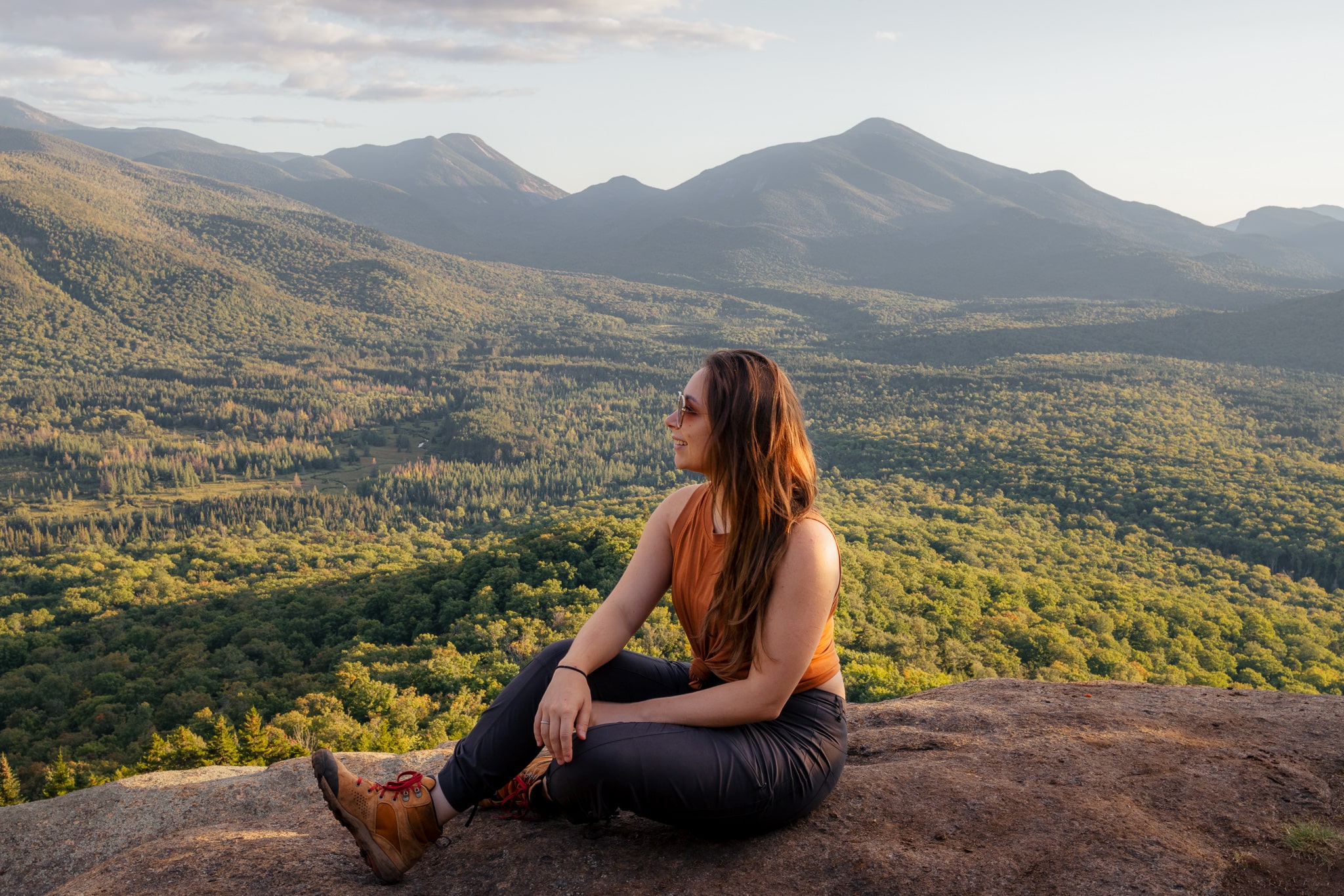
BEYOND THE 10 ESSENTIALS: ADDITIONAL ITEMS TO PACK FOR YOUR DAY HIKE
In addition to the 10 day hike essentials, there are a few other items that can make your hike more comfortable. These are the items that you should absolutely pack if you have room because, chances are, you’ll be glad to have them.
TREKKING POLES
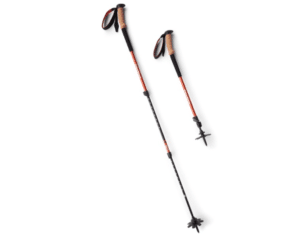
While not essential, trekking poles are wonderful to have on longer or steeper trails, especially if you have sensitive knees. They’re also there to lend support on mud, scree slopes, or other treacherous terrain.
These Black Diamond trekking poles are lightweight, sturdy, and super easy to adjust, so you can spend more time enjoying your hike and less time worrying about your gear.
GARBAGE BAG
By following the Leave No Trace Principles , we can all help to keep our trails clean and pristine. This means packing out everything you pack in , including all garbage, toilet paper, and all food scraps.
Carrying a garbage bag with you is a super easy way to carry out all of your trash. You can also use it to pick up any litter you come across on the trail.
I always carry a compostable grocery bag with me, but you can use whatever trash bag you have handy. It also weighs nothing, so there’s really no reason not to bring it along.
Once the bag is full, simply use a small carabiner to attach it to the outside of your pack until you find a trash can.
TOILET PAPER
If nature calls during your day hike, having a few squares of toilet paper will make you a lot more comfortable. Be sure to follow the Principles of Leave No Trace and pack out the toilet paper when you’re done.
PORTABLE CHARGER
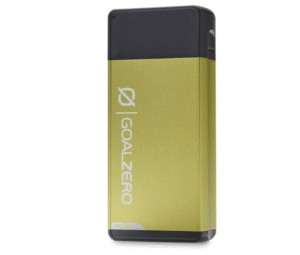
Having a portable charger is essential for keeping your phone powered up on the trail so that you can enjoy a worry-free adventure. After all, your phone’s battery drains much faster when it’s actively using GPS or searching for signal out in the wilderness.
Getting caught with a dead phone halfway through your hike can be not only inconvenient, but also potentially dangerous if you end up losing your way in unfamiliar territory.
Fortunately, there are plenty of options when it comes to portable chargers. For a lightweight and compact solution, consider using a charging case that fits on your phone or a tiny power bank that can provide your phone with an extra boost of power, if needed.
WET WIPES
Wet wipes come in handy for removing dirt, cleaning off sweat, and leaving your skin feeling a little bit fresher. Buy a travel size or pack a few in a zip lock bag and throw them in your hiking backpack for when you need a little refresh.
I like to bring these Sea to Summit Wilderness Wipes along when hiking and camping. While they say they are compostable, you should never leave them behind. Always follow the LNT principles and pack them out!
There’s nothing worse than constantly swatting at bugs while you’re hiking. Add a small bottle of bug spray to your list of day hike essentials to deter mosquitos, flies, and other annoying insects.
There are a number of effective insect repellents on the market. DEET is one of the most popular and longest-lasting options, but there are also natural repellents made from ingredients like lemon eucalyptus oil that can provide protection for up to six hours.
Here are my favorite, most effective DEET-free bug repellants:
- Sawyer Picaridin Insect Repellent Lotion
- Natrapel Lemon Eucalyptus Pump Spray Insect Repellent .
READ MORE: How to Survive Black Fly Season in the Adirondacks
If you’re hiking in grizzly bear country, you should carry bear spray as a bear deterrent. Bear spray is essentially like pepper spray on steroids, formulated specifically to deter an aggressive or charging bear.
Carrying bear spray is highly encouraged if you are hiking in places like Grand Teton National Park, Yellowstone, Glacier National Park, Banff, and British Columbia .
However, bear spray is the absolute last tool you should use to deter a bear, and it does not justify complacency in bear country.
Some parks, such as Yosemite, do not allow you to carry or use bear spray. Check park regulations before your trip.
You can buy bear spray online or in person at outdoor retailers.
While not part of the 10 day hike essentials, every hiker should still carry a tube of chapstick in their backpack.
Not only are chapped lips no fun, but being outdoors in the sun can lead to sunburnt lips. Choose a chapstick that contains SPF and store it in the pocket of your hip belt for easy access.
PACKABLE TOWEL
A small backpacking towel comes in handy for everything from wiping your hands to drying off after an impromptu swim. I’ve also used mine as a picnic blanket a few times.
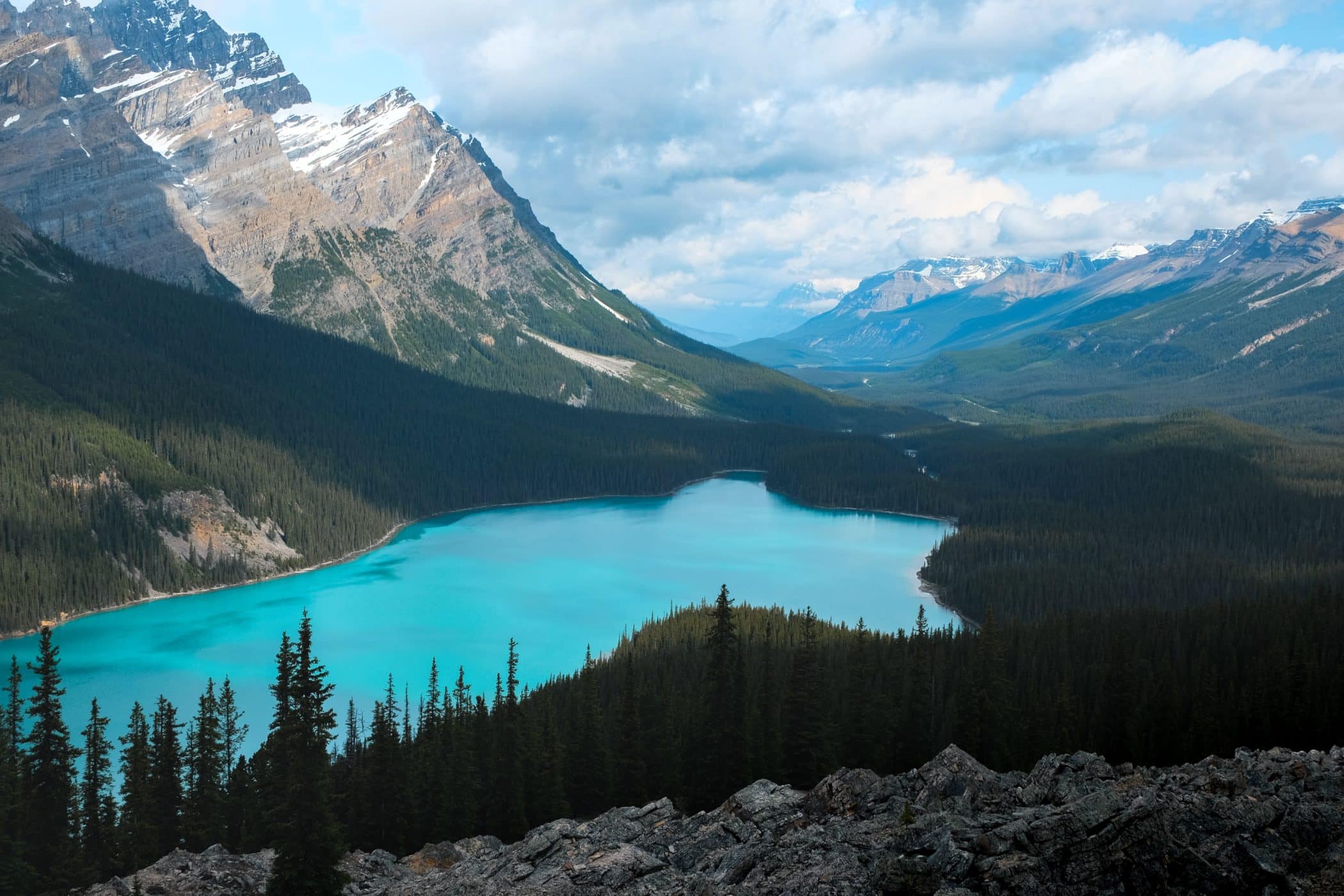
PACKING FOR A DAY HIKE: LUXURY ITEMS
To round out our list of what to pack on a day hike , let’s cover some luxury items that you might want to bring along. These are the things that you don’t need to bring with you, but are nice to have!
Lets be honest – hiking to photo-worthy views is one of my favorite things to do.
While a camera isn’t an essential item to pack for a day hike, having one with you can make your hike that much more special.
Whether you’re taking photos of the scenery, the wildlife, or your hiking buddies, a camera can help you preserve memories of your hike that you can look back on later. And if you’re lucky enough to see something truly unique, like a rainbow or a brilliant sunset, a photo can help you remember the experience for years to come.
As a photographer, I always carry my Canon EOS R5 with me. But if you don’t feel like dragging a giant DSLR with you up a mountain, a GoPro or your cell phone will also do the trick!
YOU’LL LOVE: 20 Bucket List Hikes in Upstate New York for Every Skill Level
A tripod is convenient for taking selfies or long exposure shots. Tripods for full size cameras can be cumbersome and heavy, so I invested in the Sirui Carbon Fiber Travel tripod, which only weighs 1.87lbs and easily fits in the side pocket of my backpack.
I also bring along this t ravel-sized Gorillapod for my cell phone. You can mount it almost anywhere in order to take photos or videos of yourself, which is SO convenient.
BOOK OR KINDLE
Books are a great way to relax when you reach your destination. Simply climb into your hammock and dive into a good story after you take in the views. You can also pack a small survival book to help you identify local plants and animals along the trail.
Whatever book you choose, opt for paperback books, which are much lighter and easy to replace than hardcover books.
Bonus if have a kindle, so you can bring more than one book!
BINOCLUARS
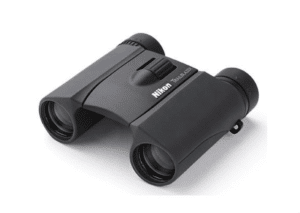
A small pair of binoculars can be a valuable addition to your hiking kit! They can help you spot birds, get a better view of the landscape, and allow you to see wildlife up close while maintaining a respectful distance.
They’re also small and lightweight, so they won’t add much bulk to your pack. I recommend investing in a cheap pair like these Nikon Trailblazer Binoculars , which are also waterproof and weigh less than 1lb.
HAMMOCK
I can’t even count how many times we’ve strung up our hammock on our day hikes. There’s honestly nothing better than arriving at your destination and getting to relax in total comfort while you soak in the views.
The ENO double nest hammock is a wonderful option that fits two people. It’s relatively lightweight and super easy to set up. Simply string it up between two sturdy trees and kick back and relax.
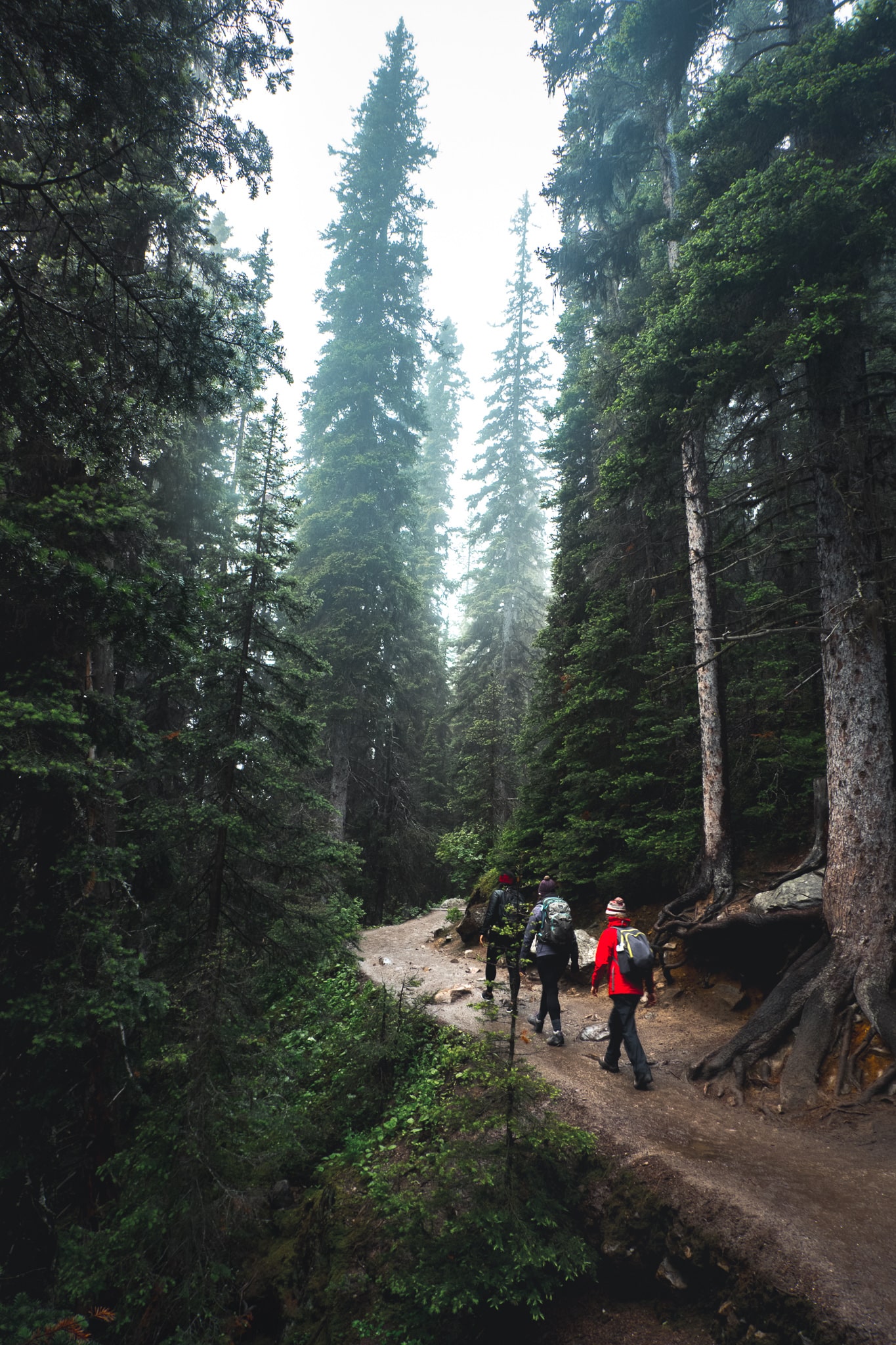
WHAT NOT TO TAKE ON A HIKE
When it comes to what to pack for a hike, it can be easy to get carried away with all sorts of gear and equipment. However, there are certain things that you should avoid bringing on your day hike.
- Jewelry – Fancy jewelry has no place on trail. It’s too easy to lose it or ruin it, and it might end up irritating you once you start sweating. .
- Cotton clothes – say no to cotton clothes. Cotton is too thick and absorbs water, which can be irritating in the summer and down right dangerous in the winter when you run the risk of hypothermia. Your entire hiking wardrobe should be Merino wool or synthetic fabrics that are quick drying and breathable
- Speakers – Part of good hiking etiquette is to respect fellow hikers, and no one wants to listen to someone else’s music on the trail. If you want to listen to music, try wireless ear buds instead :) .
- Too many clothes – I know, I know. I just told you to pack layers. But you should only pack the layers you need, nothing less, nothing more. Anything else will just weigh you down. This also goes for carrying winter gear in the summer. .
- Expensive electronics – You won’t need electronics, like your laptop or unnecessary camera accessories.
DOWNLOAD THE PACKING CHECKLIST
Now that you know what to pack for your day hike, grab this free downloadable checklist. You can print it out and use it to make sure you have everything you need next time you hit the trails.
If you have any questions or need advice on what to wear or pack for your specific hike , leave a comment below. I love getting feedback from you and helping hikers of all levels get the most out of their outdoor adventures!
Are there any other items that you would add to this list? Let me know in the comments!
Day hike inspiration.
Indian Head and Fish Hawk Cliffs in the Adirondack Mountains (The Complete Hiking Guide)
Hike the Artists Bluff Trail in Franconia Notch State Park NH
Hiking the Tiger Fern Falls Trail in Cockscomb Basin Wildlife Sanctuary, Belize
Hiking the Mount Van Hoevenberg Trail in the Adirondacks (Amazing Views for Little Effort!)
Pins for your Pinterest
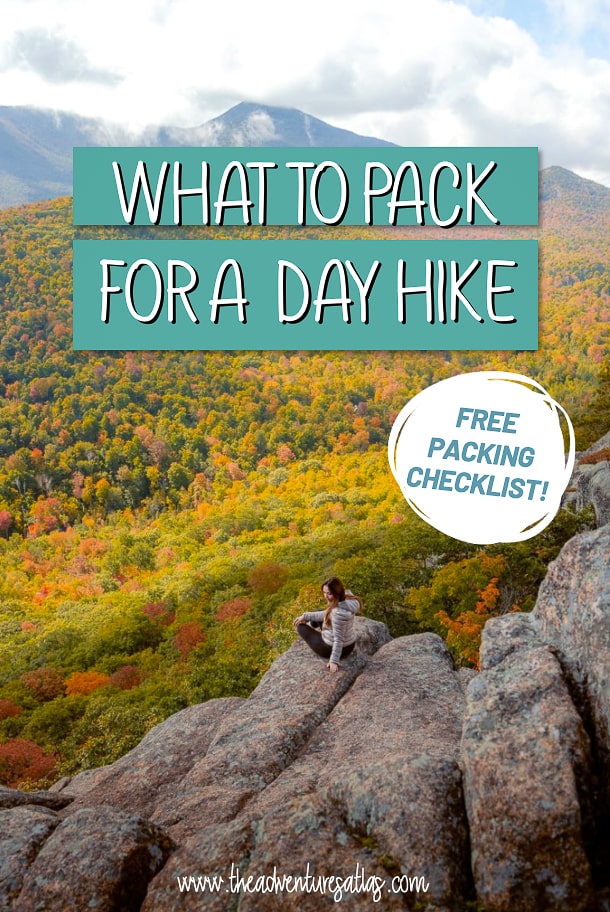
Related Posts
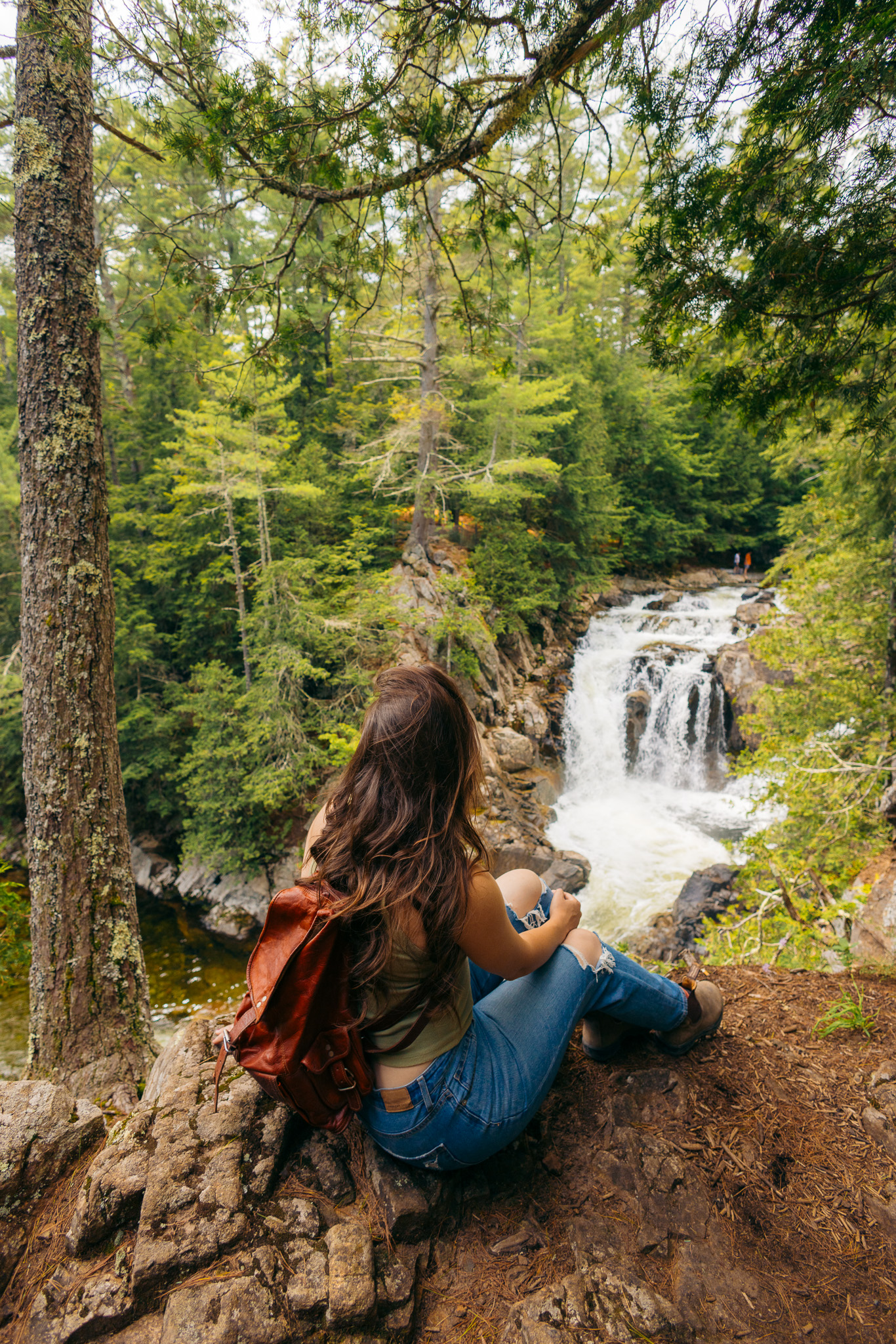
Top Things to Do in Lake Placid NY in the Summer
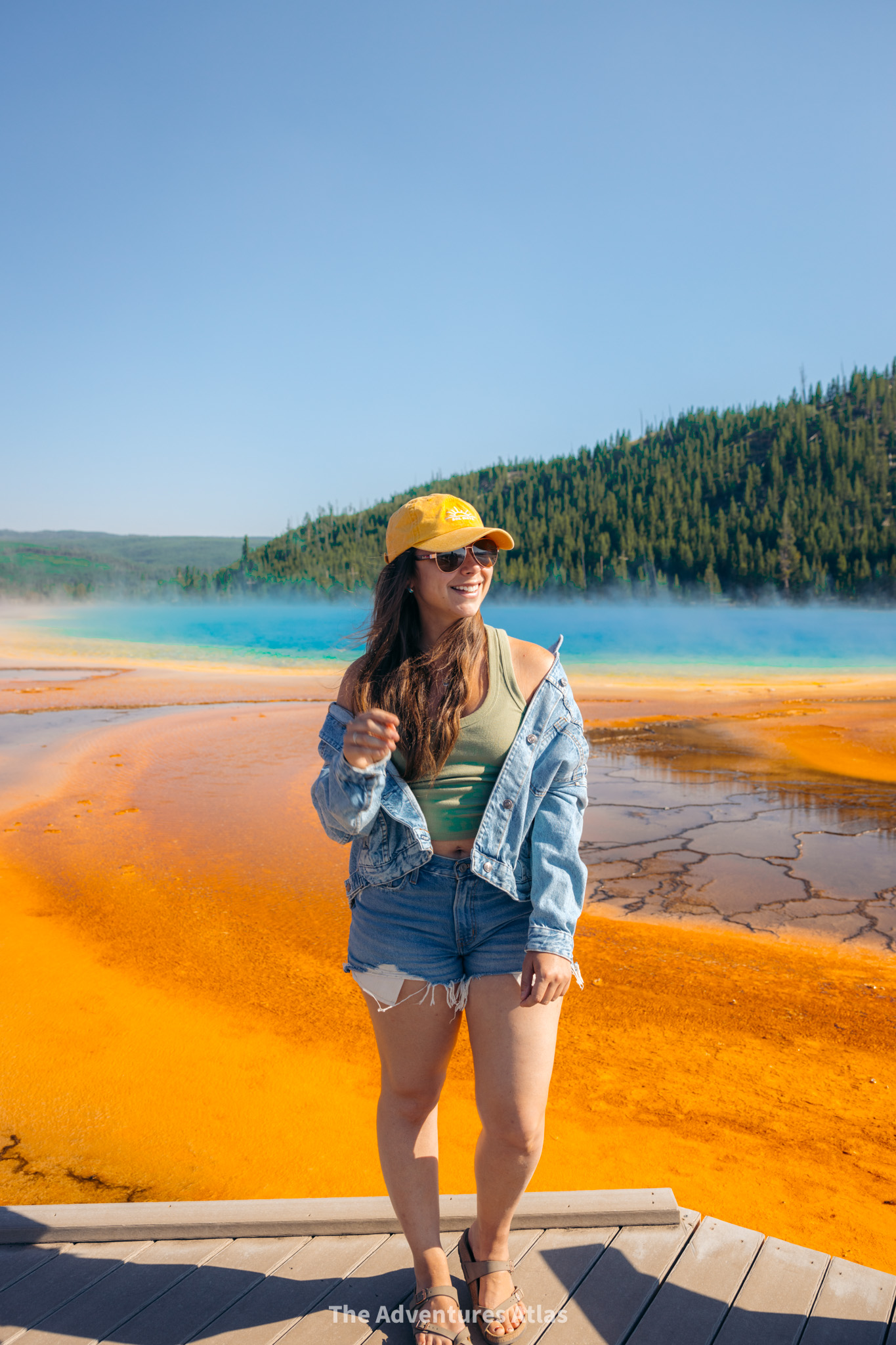
How to Spend 2 Days in Yellowstone National Park
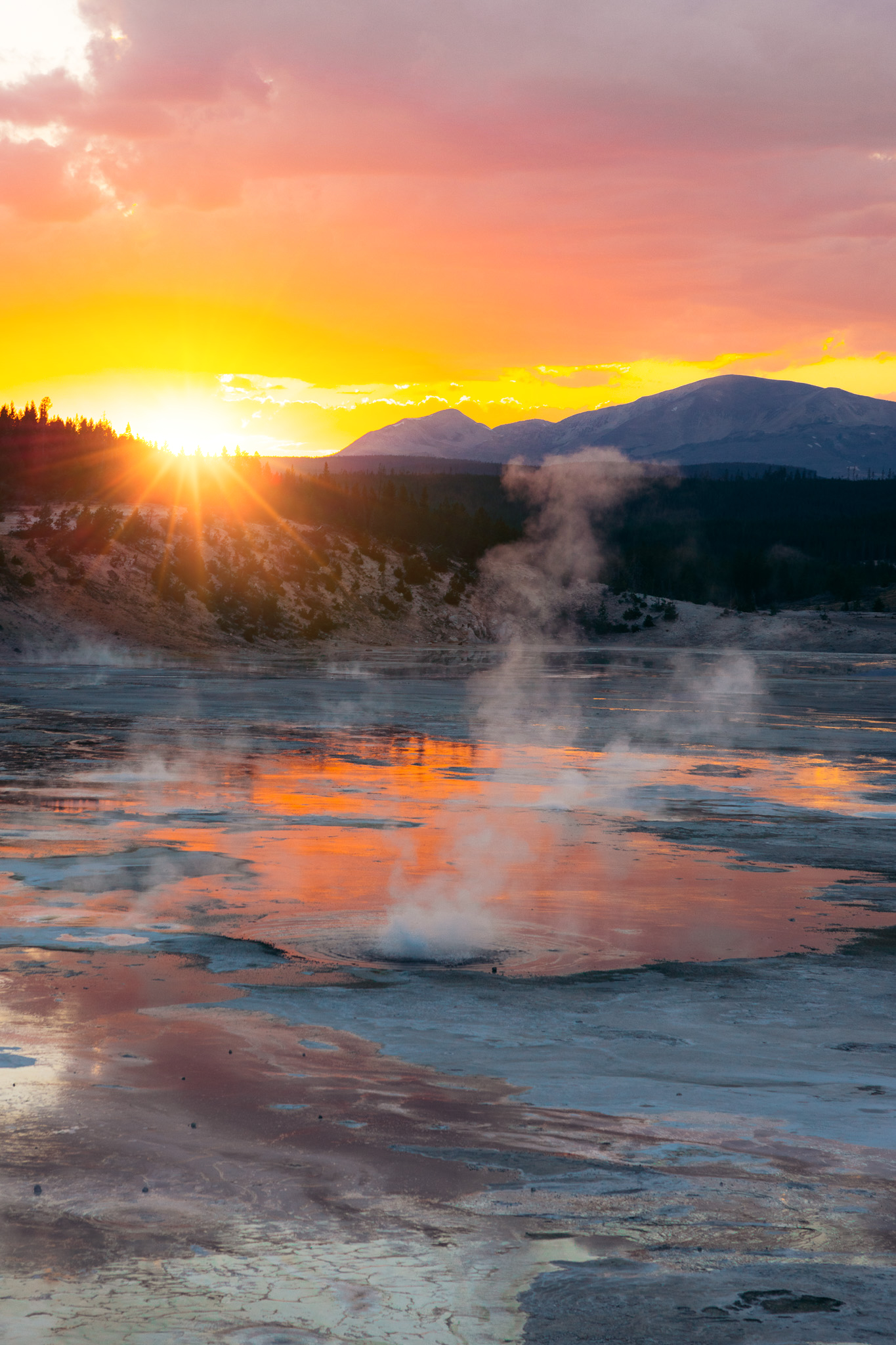
Yellowstone National Park Entrances: Which is Best?
I know it may be silly, but for bear deterent, how about bringing along a whistle? I use to carry a couple of bear bells but heard it does no good and attracts bears curiosity. Was told a whistle very effective and makes them aware that you are coming instead of surprising them and putting them in attacking mode. Lol! Would call it a great item on a day hike list.

Hey Ernie – great point! I’ll have to add a whistle to the list with my next update. Thank you!
Leave A Comment Cancel reply
Save my name, email, and website in this browser for the next time I comment.
WANT TO SAVE MONEY TRAVELING?
Check out the travel resources →
Check out my list of reliable budget-friendly travel resources that are guaranteed to save you the most money, without compromising your experience.
This error message is only visible to WordPress admins Error: There is no connected account for the user 17841400792270379.
Get in touch
Contact Portfolio Let’s work together
Explore the blog
Destinations Guides and itineraries Travel planning tips
Let’s connect
Never miss an adventure, privacy policy | terms of service | disclaimer | by zazen designs.
Back to top

Day Hiking Checklist
We cover all you need to hit the trail for the day, from clothing and gear essentials to extras like sunscreen and snacks.
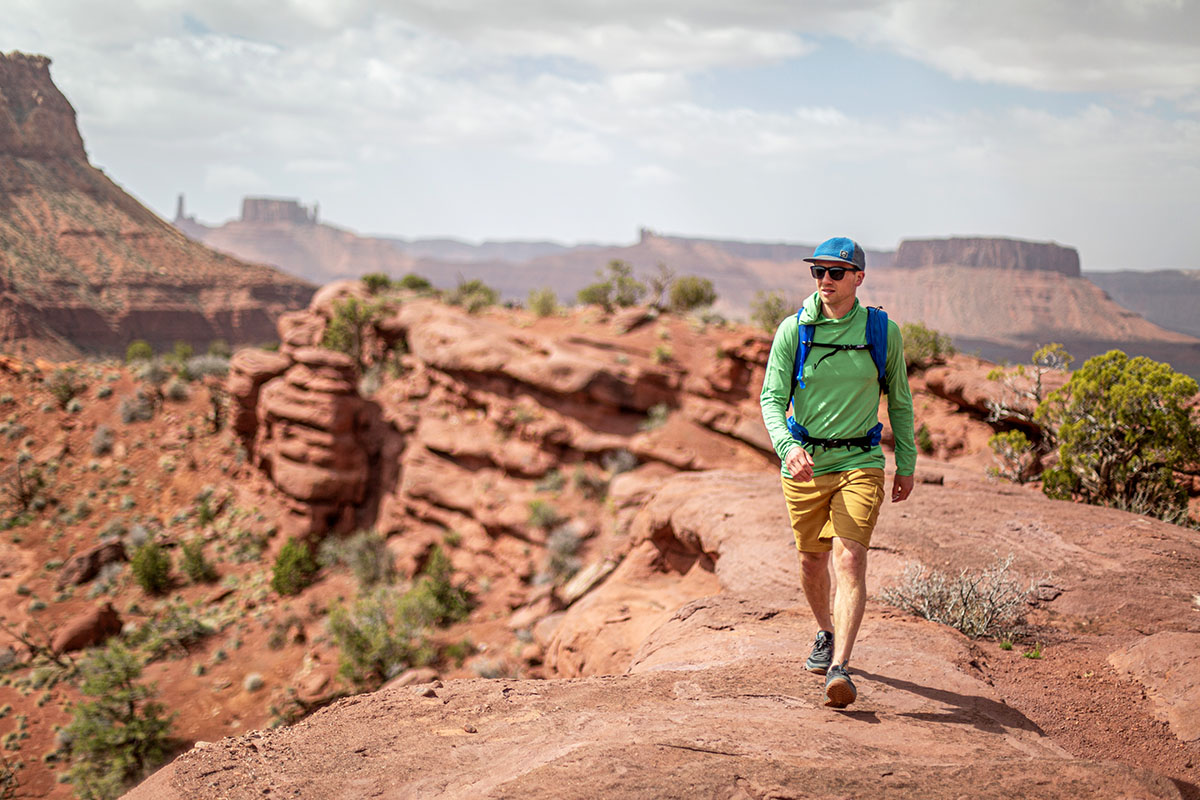
Switchback Travel ( Brian McCurdy )
We use affiliate links and may receive a small commission on purchases. Read more about us .
A day hike can be as simple as walking a well-maintained trail near your home, or as complex as a dawn-to-dusk journey through a remote wilderness. The items you bring may vary slightly depending on the difficulty and length of the hike, but no matter how you travel, it’s always nice to be prepared. Below, we list the most important items for day hiking, including clothing items such as a rain jacket and hiking pants, essential equipment like a daypack and trekking poles, and extras and personal items . For more information on each category, many of the headings link to our detailed product articles. And for all our recommendations in one place, see our hiking gear reviews .
Day Hiking Footwear and Clothing
1. hiking shoes or trail runners.
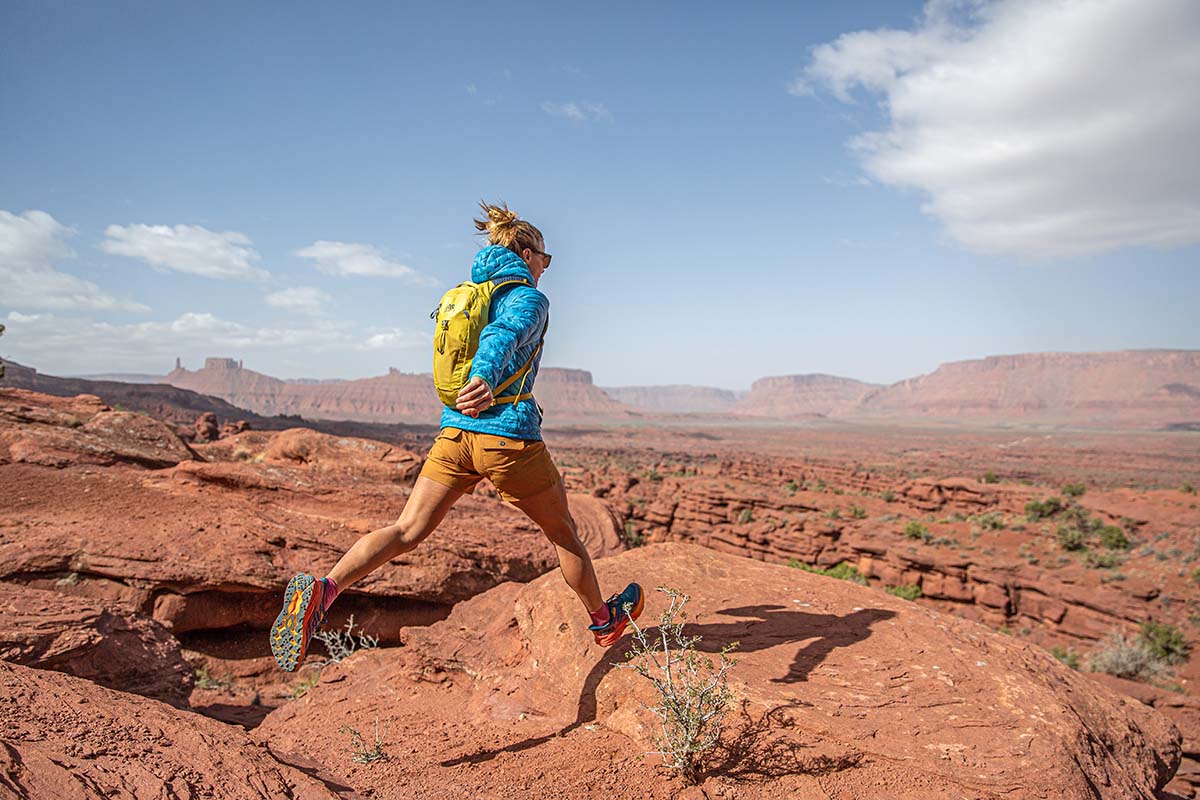
2. Hiking Socks
As we mentioned above, happy feet make for a happy hiker. Once you’ve settled on a pair of shoes or trail runners, it’s important to look for a set of hiking-specific socks to complete your setup. We prefer wool socks to those made with cotton or synthetic materials: Wool has an incredible ability to regulate temperature, stays warm when wet, and dries much faster than cotton. Our favorite socks for keeping our feet happy are the Darn Tough Micro Crew Cushion , which also come with a lifetime warranty. In terms of height, most hikers prefer crew-cut socks for protection against low branches and debris, but quarter-height and no-show designs are lower-profile and cross over well for use with sneakers and trail runners.
3. Hiking Pants or Shorts
.jpg)
6. Down Jacket or Synthetic Jacket
Whether you’re walking through a canyon, ascending a mountain ridgeline, or just taking a break in the shade, you’re likely to encounter a range of temperatures throughout your hike. It’s a good idea to have an insulated layer stowed in your backpack so you can stay warm regardless of activity level or weather. Down packs into a tiny package, is feather-light, and provides a surprising amount of warmth, making it our favorite type of insulation for hiking. That said, some will prefer a synthetic jacket instead, which insulates even when wet and surpasses down in terms of breathability. Two of our favorite insulated jackets for hiking are the down-filled Mountain Hardwear Ghost Whisperer/2 and the synthetic Patagonia Nano-Air Hoody .
Day Hiking Equipment
.jpg)
13. Navigation
Even if you’re familiar with the area where you’ll be hiking, it’s a good idea to bring along some sort of navigational tool. A high-tech GPS device will cover all your bases, but it’s a bit overkill for a day hiking application. In fact, a paper topographical map—especially when laminated or printed on waterproof paper—is the most sure form of navigational help, as it does not rely on battery power. That said, our favorite means of tracking location are GPS-powered navigational apps on our phone. Apps such as TopoMaps, Gaia, and Hiking Project can pinpoint your location at any given moment—even when cell phone service is non-existent—and even give details like hiking pace, elevation, and mileage.
14. Satellite Messenger
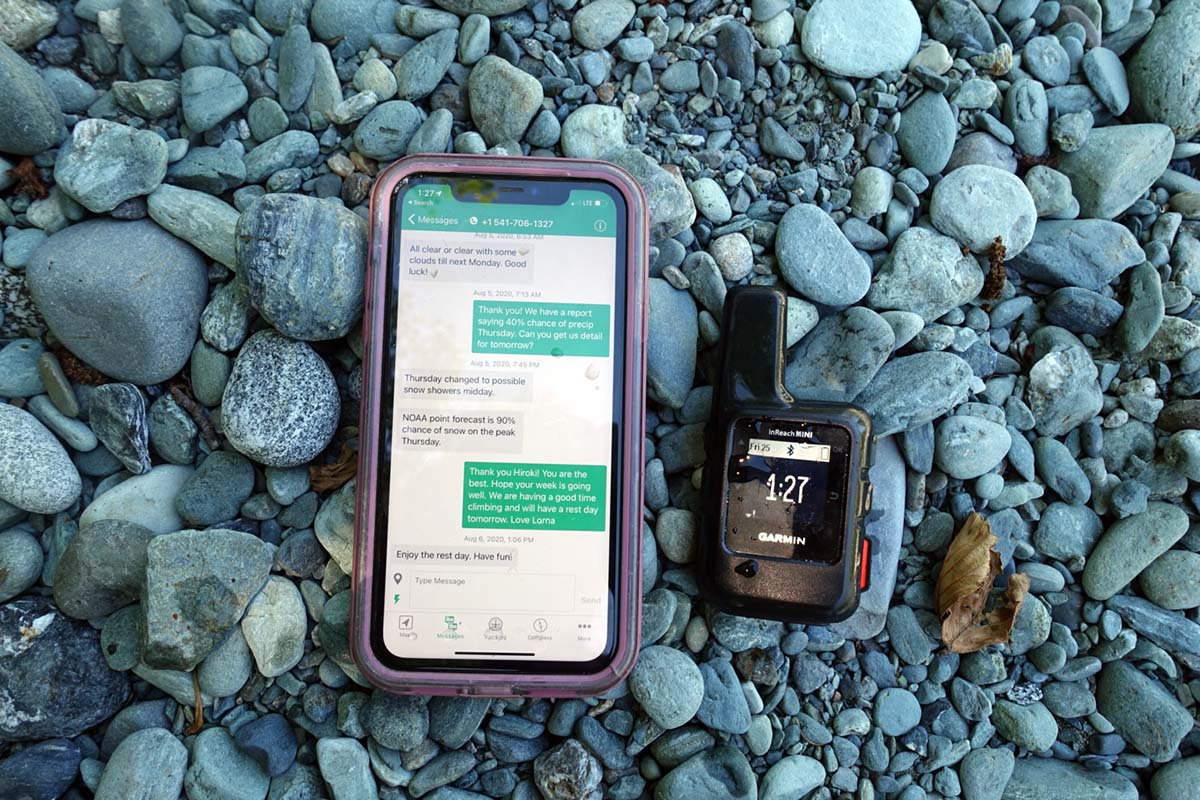
Along with water, it’s essential to pack enough food for your hike (and even a little more). In general, we recommend eating between 300 and 400 calories per hour of hiking, depending on your body type and level of exertion. High-energy foods like nuts, bars, cheese, and dried fruit provide great nutrition and calories while keeping weight low. Some of our favorite energy bars are Kate’s Real Food Bars , delicious high-calorie snacks made with quality ingredients in the small town of Victor, Idaho. Additionally, Snickers bars and sandwiches provide easy trail food solutions at a lower cost.
Extras and Personal Items
- Insect repellant
- Toilet paper and trowel
- Bear spray (depending on the area and season)
- Simple repair kit (a bit of duct tape and paracord should be plenty)
- Multitool or Swiss Army knife
- Emergency blanket or bivy
- Lighter or waterproof matches
- Whistle for emergencies
- Winter traction devices and gaiters (depending on conditions)
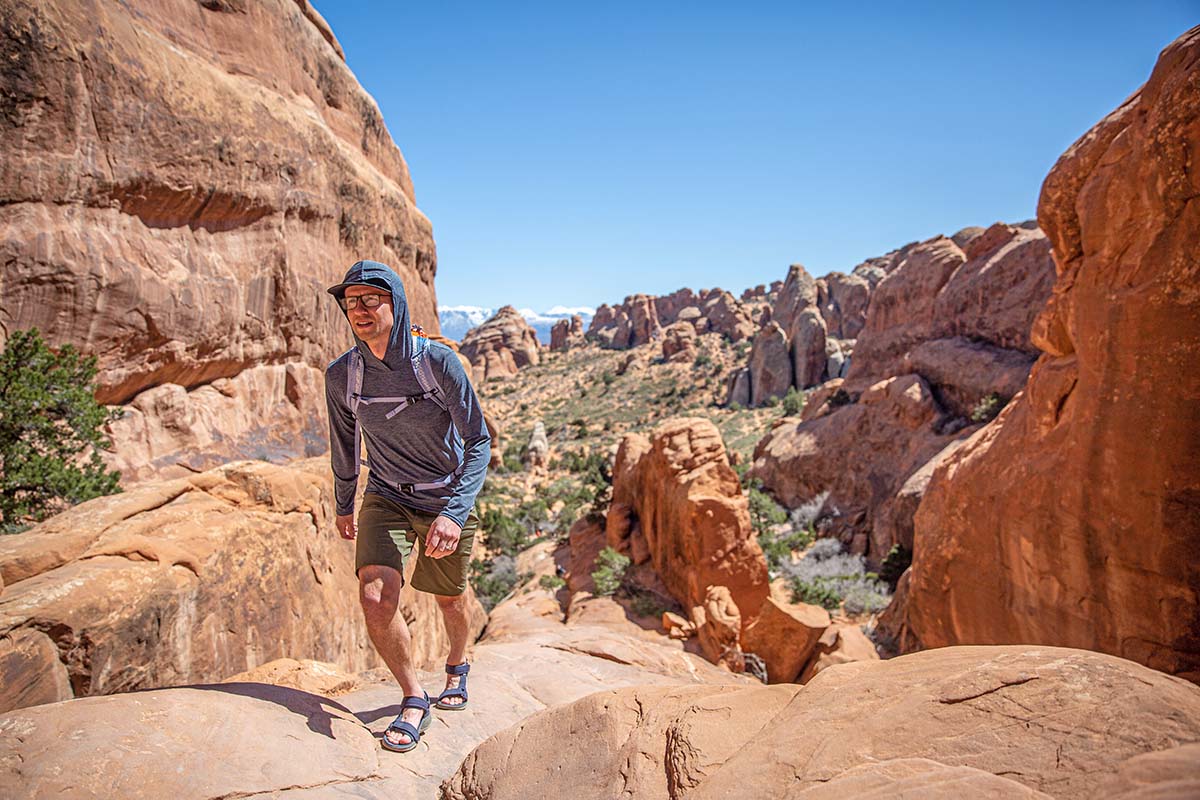
Where to Buy Hiking Gear
Although much of this gear can be found online, we first recommend visiting your local gear shop or consignment store. There’s simply no substitute for looking at items up close, trying on clothing, backpacks, and footwear, and receiving personal advice from the experts. If you do choose to shop online, REI Co-op and Backcountry are two of the most reliable retailers when it comes to hiking gear. Both have impressive selections, provide free shipping on orders over $50, and offer generous return and exchange policies. And as a bonus, REI has over 175 brick-and-mortar stores across the country, so you can try on before you buy or pick up your order in store. Finally, for cheaper items and those who need gear quickly, it’s hard to beat Amazon and the sheer volume of their inventory. Back to Our Day Hiking Checklist See Our Hiking Gear Reviews
Learn More About Outdoor Gear
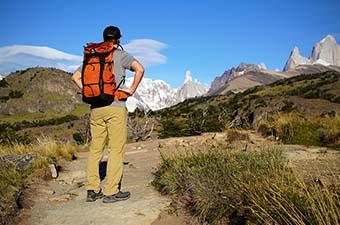
Hiking Gear Reviews
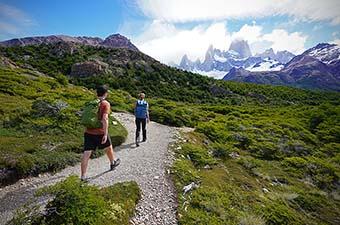
Best Hikes in El Chaltén, Argentina
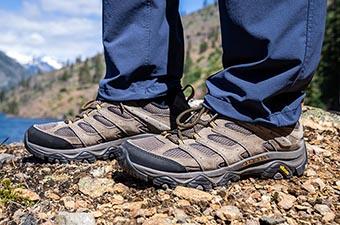
Best Hiking Shoes of 2024
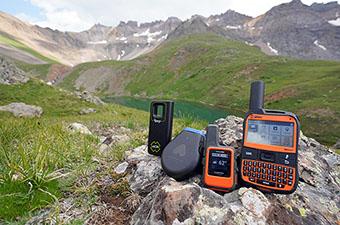
Best Satellite Messengers of 2024
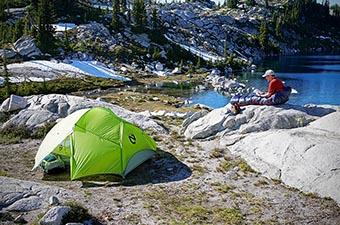
Backpacking Checklist for 2023
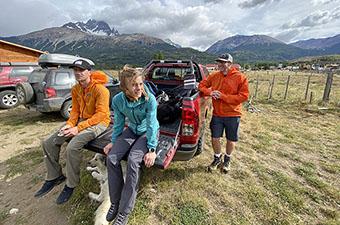
Best Windbreaker Jackets of 2024
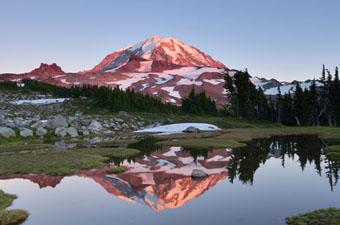
10 Great Day Hikes from Seattle
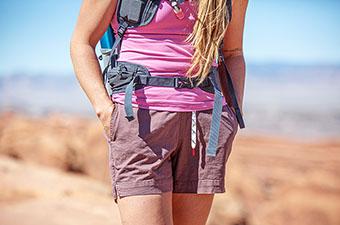
Best Women’s Hiking Shorts of 2023
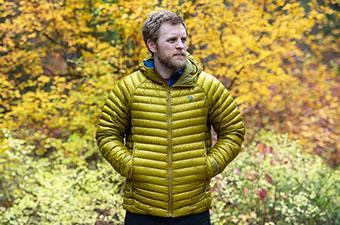
Mountain Hardwear Ghost Whisperer/2 Hoody Review

Mobile Menu
Megamenu - desktop hamburger menu.
- Hiking Gear
- Backpacking Gear
- Biking Gear
- Camping Gear
- Footwear Reviews
- Climbing Gear
- Skiing Gear
- Winter Gear Reviews
- In-Depth Gear Reviews
- Hiking Shoes
- Hiking Boots
- Trail Running Shoes
- Mountain Bike Shoes
- Approach Shoes
- Climbing Shoes
- Beginner Climbing Shoes
- Mountaineering Boots
- Winter Boots
- Rain Jackets
- Down Jackets
- Synthetic Jackets
- Fleece Jackets
- Hardshell Jackets
- Softshell Jackets
- Windbreaker Jackets
- Ski Jackets
- Winter Jackets
- Hiking Pants
- Hiking Socks
- Trekking Poles
- Baby Carriers
- Running Vests
- Backpacking Tents
- Backpacking Packs
- Backpacking Sleeping Bags
- Backpacking Sleeping Pads
- Backpacking Stoves
- Backpacking Food
- Water Filters
- Altimeter Watches
- Handheld GPS
- Mountain Bike Helmets
- Mountain Bikes
- Mountain Bikes Under $1,000
- Mountain Bikes Under $2,000
- Gravel Bikes
- Bike Brands
- Kids' Bikes
- Hitch Bike Racks
- Camping Tents
- Rooftop Tents
- Camping Sleeping Bags
- Camping Mattresses
- Camping Chairs
- Camping Stoves
- Duffel Bags
- Rock Climbing Shoes
- Climbing Helmets
- Climbing Harnesses
- Climbing Quickdraws
- Belay Devices
- Climbing Ropes
- Climbing Backpacks
- Winter Gloves
- 4-Season Tents
- Ski Helmets
- Ski Goggles
- Ski Backpacks
- All-Mountain Skis
- Ski Bindings
- Backcountry Skis
- Backcountry Ski Boots
- Skis for Beginners
- Hardpack Skis
- Mirrorless Cameras
- Full-Frame Cameras
- DSLR Cameras
- Point-and-Shoot Cameras
- Travel Cameras
- DSLR Lenses
- Mirrorless Lenses
- Lofoten Islands
- Lofoten Hiking
- Hardangervidda
- Jotunheimen
- 10 Great Norway Hikes
- Public Huts
- Torres del Paine
- Chalten and Glaciares
- Lake District
- Patagonia National Park
- Milford Sound
- Abel Tasman
- Marlborough
- Great Walks
- Adventure Towns
Add adventure to your inbox
- Privacy Policy
- Terms of Service
© 2024 Switchback Travel. All Rights Reserved. No part of this site may be reproduced without our written permission.

- February 12, 2024
- Outdoor Recreation
Essentials For Hiking: Day Hike Packing Checklist

Whether you’re new to hiking and trying to figure out what to pack for a day hike or an experienced hiker looking to upgrade some gear, this guide shares all the day hiking essentials you’ll need.
Hiking is my favorite outdoor activity and hobby because it keeps me physically and mentally healthy!
You can usually find me hiking in my hometown of Phoenix, Arizona, and throughout the National Parks of the southwest! Ever since I started hiking solo, I’ve learned a lot more about hiking gear and how I can stay safe and enjoy more time on the trails.
While I will never say you *need* something to spend time outside, there are some items that are essential for a day hike and gear you might want to consider to make your hike more enjoyable.
There is much more to hiking than outfits and gear, so I recommend checking out my post on how to start hiking alone as a woman for tips on safety, essential gear, and more! But if you’re looking for the best hiking gear, keep scrolling!

Hey! I wanted to let you know that this post contains affiliate links! By purchasing through these links, I earn a small commission at no extra cost to you. Thanks for your support!
Table of Contents

Why Do I Need Special Gear For Hiking?
If you’re new to hiking, you likely own everything you need to go on your first easy hike! I hiked in my tennis shoes and used an old backpack all through college.
However, if you plan on taking up hiking as a hobby or are looking for some gear to upgrade your adventures , it’s a good idea to invest in some pieces that can help you be safer and more comfortable while spending time in nature.
Hiking requires special gear for a few reasons:
- Safety : Special hiking gear is designed to protect you from the elements and ensure that you have a safe hike. For example, hiking boots with good traction can help prevent slips and falls on uneven terrain, and a waterproof jacket can protect you from rain and wind.
- Comfort : Special hiking gear is designed to be comfortable and to help regulate body temperature. Wicking and quick-drying clothing, for example, can help keep you cool and dry, preventing chafing and overheating.
- Functionality : Special hiking gear is designed to be functional and to help you carry the essentials you need for your hike. A backpack, for example, is designed to hold a water bottle, snacks, a map, and other items you’ll need to carry with you.
- Durability : Hiking gear should be durable enough to withstand the rigors of the trail and to last for multiple hikes. Quality hiking boots and backpacks are built to be sturdy and to last a long time.
- Safety : Certain tools and equipment, like a map, compass, GPS, emergency whistle, flashlight, etc, will help you navigate and stay safe in case of any emergency.
I highly recommend investing in quality hiking gear , so you can ensure that you have a comfortable and safe hike, and that your gear will last for multiple hikes, if not years. You’ll see a lot of REI links in this article because I’m a big fan of the durability of their gear and amazing return policy .
10 Essentials For Hiking
Here are some of the hiking essentials that everyone should consider bringing on a hike:
- Navigation tools (map, compass, GPS device)
- Sun protection (sunscreen, sunglasses, hat)
- Insulation (extra clothing)
- Illumination (headlamp/flashlight)
- First-aid supplies
- Fire starter (matches, lighter, fire starter)
- Repair kit and tools (knife, multi-tool, duct tape)
- Nutrition (extra food)
- Hydration (water bottle, water treatment supplies)
- Emergency shelter (tent, emergency blanket, bivy sack)
It’s important to note that the 10 hiking essentials listed above are not intended to be an exhaustive list of everything you might need on a hike. They are a basic set of items that should be carried at all times to help you respond to unexpected situations and emergencies.
Day Hike Packing List

A good day pack is at the top of your day hike packing list for a reason! No matter how long you’re on the trail for, you’ll need something to carry your essential gear.
If you’re a beginner hiker and not ready to invest in a hiking day pack yet, an old backpack from school will work if you’re not going to far! If you are serious about hiking and looking to buy a day pack, you’ll want to consider capacity, comfort, durability, and weather resistance.
For size, a good day pack should range from 18 – 40 liters. This will hold extra layers, and all of the other day hiking essentials that we cover below.
You’ll want to look for an interior sleeve for a hydration pack, a hip belt, and a sternum strap when shopping for a day pack. I did a deep-dive post on day packs with all of these features and more in my recent post on the best day packs for women .
Here are a few of my favorite hiking daypacks:

If I’m headed out on a longer hike (5+ miles), I’m bringing my Gregory Juno 30 because it can fit my lunch, extra layers, and camera gear! I’m a big fan of the ventilated back panel because it keeps my pack feeling light and gives great airflow, so I don’t have to wear a sweaty backpack.

If you’re looking for a small day pack for hiking, the Gregory Nano 18 H20 Hydration Pack is the best choice! This handy bag is the one I grab the most for short hikes and bike rides. It features an easy-pull top drawcord, plenty of pockets to stash your must-haves, and a 3 Liter hydration reservoir that helps you stay hydrated on the move.
PSST! Want to save $$$ on a new hiking backpack?
Use code JACEY15 at checkout for 15% off your newx Gregory Purchase!
Shop now >

Water Bottle or Bladder
Water is the most important thing to bring on a hike and in the past I’ve learned a very important lesson: Always bring more water than you think you’ll need.
A general rule of thumb is to drink at least two liters of water per day and more in hot conditions. I love using a 3-Liter hydration pack for drinking on the go, but any stainless steele or BPA-free plastic bottle should work for short hikes!
Hiking Clothing
Some of the most important hiking gear is the outfit you wear. No matter the season you’re hiking in, wearing layers on the trail is essential for comfort and safety reasons. Read my guide on cute and practical hiking outfits for more information.

Cute + Practical Hiking Outfits For Women

Guide To Hot Weather Hiking Shirts For Women

Gregory Backpack Comparison: Reviewing 4 Hiking Day Packs

Base layers
When choosing a hiking shirt, I recommend going for moisture-wicking and quick-drying fabrics like merino wool or polyester. These materials will keep you dry and comfortable on the trail!
The REI Co-op Sahara T-Shirt is one of my favorite budget-friendly hiking shirts and my go-to when I want to wear short sleeves. I also love Patagonia Capilene Cool Daily Graphic T-Shirts for women because they are lightweight, soft, and wash well!
If I need sun protection or want to keep the bugs away, I’ll opt for the REI Co-op Sahara Solid Long-Sleeve Shirt or the REI Co-op Sahara Shade Hoodie .
For cold weather hikes, my favorite long sleeve hiking top is the REI Co-op Merino 185 Long-Sleeve Base Layer Top .

Warm mid layer
Middle layers are all about adding warmth! No matter the weather, you’ll likely want to bring a middle layer . Again, I suggest avoiding cotton and going for something synthetic or wool so it is breathable and moisture-wicking.
For colder-weather hikes, I’ll bring a thick hoodie with fleece lining (or two if I know it’s going to be extra cold!). On warm-weather camping trips, I like to bring a thinner, breathable sweater like this quarter-zip from REI .

Outer layers
If the weather is going to be cold or you’ll be hiking at higher elevations, you’ll want to bring an insulated jacket as an outer layer. Insulation traps heat inside the jacket, keeping you warm even in freezing temperatures. Additionally, insulated jackets protect you from the wind.
Insulated jackets come in different types of insulation: Down and synthetic . Synthetic insulation is generally better for damp or humid, where down insulation is more lightweight and compressible.
Since I live and hike in Arizona, my favorite jacket to bring hiking is the REI Co-op Magma 850 Down Hoodie 2.0 because it’s durable, lightweight and super packable! If rain is in the forecast, I’ll opt for the REI Co-op XeroDry GTX Jacket to stay dry.

Rain jacket
When looking for a rain jacket for hiking , keep waterproofness and breathability in mind! Look for a jacket that is made from waterproof and breathable fabric such as Gore-Tex, eVent or other similar membranes. These fabrics will keep you dry in wet conditions while also allowing sweat to escape, so you don’t overheat.
You’ll also want a rain jacket with a hood, lots of pockets, and room for layering clothes underneath! The REI Co-op Rainier Rain Jacket checks all those boxes and more.

There are a couple of things to consider when shopping for hiking footwear. In addition to being comfortable right out of the box, a good pair of hiking boots should have arch support, good traction, be waterproof, be breathable, and be lightweight.
Remember to try on different shoes and take a walk around the store to make sure they fit well and are comfortable. It’s also a good idea to ask for recommendations and read online reviews.
Thanks to my job as an outdoorsy content creator, I’ve been able to try a lot of different hiking boots. The best hiking boots I’ve tried are the Moab 3 Mid Waterproof Hiking Boots from Merrell . If I want something more casual, I’ll opt for the HOKA Mafate Speed 4 Trail-Running Shoes or the Altra Timp 4 Trail-Running Shoes .

The socks you wear can make or break your hike! To avoid blisters and pain, opt for moisture-wicking, quick-drying materials like wool .
Wool socks are the best choice for hiking because they are super durable, moisture-wicking, extra padded, and odor resistant! There are different types of wool but merino wool is the most popular choice for outdoor gear due to its softness, warmth, and moisture-wicking properties.
The best wool hiking socks are the Micro Crew Socks from Darn Tough ! Not only do these socks come in a bunch of cute patterns, but they are also made in the USA and have a lifetime warranty!
Sun Protection
As someone who lives and hikes in Phoenix, Arizona, I am passionate about protecting my skin from the sun. No matter the weather, I always wear at least UPF 30, a wide-brimmed hiking hat, and sunglasses.
Sun protection is even important in the winter! If you’re hiking in the snow on a sunny day, you can also get a sunburn from “snow blindness”.
Sun protection is essential for day hikes because it helps prevent injury! Here are some of my favorite pieces of gear for sun protection:

First Aid Kit
Hiking can result in blisters, scrapes and other unexpected injuries so it’s a good idea to in a small first aid kit that permanently lives in your day pack. While it’s unlikely that you’ll need everything that comes in the kit, it’s better to have on you in case an emergency happens.
I bring a simple, small first-aid kit on every hike and it’s come in handy multiple times! Some first-aid essentials are band-aids, moleskine for blisters, adhesive tape, gauze, antiseptic wipes, and pain relievers. I added a lighter, emergency whistle, and allergy medicine to my kit.
Map / Navigation Tools
Reliable navigation is essential for every hike. In addition to researching the trail before you go, it’s a good idea to have a paper map or download the trail map to your phone.
I typically use trail maps on AllTrails . You need the “Pro” version of the app to download the trail maps for offline use. It’s a good idea to download the map before you leave your house because there’s a chance you won’t have cell service in the wilderness!
If you are going on more advanced hikes in the backcountry, you might want to consider investing in an emergency communication device like a Garmin InReach . This GPS device will help you navigate and communicate when you are in the wilderness.

Hiking Snacks
Snacks are an important part of hiking! While everyone has different snack preferences, you’ll want to pack something that is packed with nutrients for a quick source of energy and help keep your blood sugar levels stable.
Some of my favorite hiking snacks are trail mix, energy bars, fresh fruit, cheese and crackers, candy, and a peanut butter and jelly sandwich!
It’s important to make sure you have enough food for your day hike and I recommend bringing a bit extra in case of an emergency. You’ll also be burning more calories than you’re used to so don’t be afraid to throw and extra granola bar or two in your pack.
Headlamp or Flashlight
It might seem excessive to bring a headlamp on short hikes but if there is a slight chance that your hike takes longer than expected, you want to be able to make it back to your car in the dark.
What if you hurt yourself and have to wait for help as the sun sets? What if you spend a little extra time at the mountain summit to watch an amazing sunset? What if a storm hits and you get stuck taking shelter? You’ll need a headlamp.
Of course, a flashlight also works but headlamps are more convenient, safer, and cost and weigh as much as a nice flashlight.
I usually carry my $20 headlamp from Petzl . It’s compact, and convenient, and goes on every hike with me.
Toilet Paper or Pee Cloth

It’s important to be prepared to use the bathroom if you need to! If you have to go #2, you’ll want to bring a trowel to dig a hole and bury it. For toilet paper, I recommend burying it deep or packing it out in a Ziploc bag.
If you just have to go #1 and don’t want to carry used toilet paper out with you, I recommend investing in a Kula Cloth! It’s a reusable pee cloth that has a ton of innovative features – read all about it here !
A Knife or Multi-Tool
If your gear breaks or you need to cut rope, creat splints, or simply open a snack, a knife will come in handy! It could also help you start a fire or make shelter in emergency situations.
And in rare cases, a knife can be used for self-defense against animals or humans.
It’s important to note that bringing a knife on a hike also requires responsibility and proper usage, as a knife can be a dangerous tool if not handled correctly. Always be aware of your surroundings and follow local laws and regulations regarding the carrying of knives.
Beyond The Essentials
Trekking poles.
While these aren’t considered a day hiking essential, trekking poles come in handy if you’re tackling a steep, challenging hike! Trekking poles are designed to take pressure off your knees, give you more momentum on the ups, and help maintain balance while hiking.
When I first started hiking, I used an inexpensive pair of trekking poles from Costco for years. As the years have gone by and I’ve used them more and more, I invested in the Leki Lhasa Trekking Poles .
If you are hiking in grizzly bear country, or want to feel more protected on your solo hike, you’ll want to bring bear spray . In an emergency, you can spray it at the bear to give yourself a chance to escape.
ID and Money
While not technically a hiking essential, it’s a good idea to always carry your ID, credit card and/or cash on a hike. You never know when you could need them and it’s better to be prepared.
Photographing nature is one of my favorite parts about hiking! Whether you’re using your iPhone or fancy camera, you’ll likely want to document your adventure.
For casual hikes to a destination where you can hang out for a couple of hours, I recommend bring a hammock! I love bringing my ENO DoubleNest Hammock to string between two trees! Some of my favorite hiking memories are of being cuddled up in my hammock, enjoying a nap to the sounds of nature.
Budget Hiking Gear
There is no need to break the bank to enjoy the great outdoors. If you’re looking for some great deals on budget-friendly hiking gear , here are several places to look:
- Online retailers : Online retailers like REI, Walmart, and Amazon offer a wide range of hiking gear at different price points. You can often find good deals and discounts on these sites, and you can compare prices across different brands and models.
- Sporting goods stores : Sporting goods stores like Dick’s Sporting Goods and Sports Authority have a good selection of budget-friendly hiking gear. They can also have clearance sections that have even more discounts.
- Outlet stores : Outlet stores such as REI Outlet , Columbia, and The North Face that sell discounted hiking gear often have discounted prices on older models or seasonal items.
- Second-hand stores : You can also find great deals on hiking gear at second-hand stores like Goodwill or Salvation Army. Shopping second-hand is also a great way to help the environment by reducing consumption of new products.
- Online marketplaces : Online marketplaces like REI Re/Supply , Patagonia Worn Wear , eBay, Facebook marketplace, etc, is a great place to find used gear!
When shopping for budget hiking gear, it’s important to keep in mind that you may have to compromise on some features or durability to get the best deal. Also, make sure to read reviews and check the specifications of the gear you’re interested in to ensure it will meet your needs!
Additionally, some brands and retailers have seasonal sales, or clearance sections on their website, it can be a good idea to check for those as well!

Hiking Tips For Women
Now that you know all about the 10 essentials and the best hiking gear, I have some hiking tips to share! While these are mostly hiking tips for beginners, experienced hikers can always benefit from a refresher!
- Invest in good hiking boots and break them in before your hike.
- Wear comfortable, moisture-wicking clothing and layer appropriately for the weather.
- Carry enough water and snacks to fuel your hike.
- Consider bringing a small first aid kit and a means of communication, such as a cell phone or a personal locator beacon.
- Let someone know your hiking plans and expected return time, including the trailhead name and any significant landmarks along the trail.
- Be aware of your surroundings and use caution when hiking alone.
If possible, hike with a friend or a group.
It’s important to also review the map before you go and if you know how to use them, bring a map and a compass.
Pay attention to trail signs and markers, and stay on designated trails to minimize impact on the environment and to avoid getting lost.
Lastly, always check the weather forecast before heading out and be prepared for any changes in the weather.
Want to get started hiking alone? Click here to read all my tips on how to do it safely .
Frequently Asked Questions About What To Take Hiking
What should you pack for a short hike?
You should pack a hiking backpack, the 10 essentials, extra layers, snacks, water, durable hiking boots, a headlamp, and a fully charged smartphone.
What are the 10 essentials for a day hike?
The 10 essentials for a day hike are navigation, illumination, sun protection, first aid kit, repair kit and multi-tool, emergency shelter, extra food, extra water, fire starter, and extra clothing layers.
What can you not take on a day hike?
I suggest leaving your nice clothes, shoes and jewelry at home! Additionally, don’t wear clothing made of cotton or denim, or open-toed shoes.
What is the #1 etiquette rule while hiking?
The #1 hiking etiquette rule is to Leave No Trace ! One of the most important principles for beginner hikers to know is to pack out all trash. This inlcudes all the little pieces of snack wrappers, water bottles, and orange peels. It’s a good idea to pick up any trash you come across on the trail, even if it isn’t yours.

Final Thoughts On What To Bring Hiking
At the end of the day, the best hiking gear is the pieces that help you feel more comfortable and keep you safe while spending time in nature!
Let me know if you have any questions about what to wear or bring hiking – I’m always happy to help!
Share this post -

Meet the author
My mission is simple: Inspire you to get outside. I like camping, hiking, mountain biking, backpacking, and exploring National Parks. I’m passionate about sharing all the details of my adventure so you can plan some of your own!
Related Posts

Beginner’s Hiking Guide | Video Series
I’m so excited you found my beginners hiking guide! Hiking is one of my favorite outdoor activities because it’s accessible, inexpensive, and so rewarding! I’ve

Packing For Three Weeks In A Carry-On
Last May, my husband Dominick and I went on our very first international trip! We had three weeks off and chose to spend our vacation

How to start hiking alone as a woman | Solo Hiking Tips
“Is it safe to hike alone as a woman?” is one of the most commonly asked questions I get when I share my solo hiking
You may also like...

Let's Connect
- My Favorites
- Visit my YouTube
- Get in Touch
Blog & Resources
- Travel Tips
- Lifestyle Content
- Free Packing Guide
- Free IG Bio Audit
Get my weekly newsletter!
© copyright 2023, jacey out west.
- Privacy Policy
- SOCIAL MEDIA MARKETING
- Site Credits
- my portfolio
- Explore the blog
- my favorites
Day Hike Packing List: What Do You Really Need to Pack for a Hike
Published by sarah vaughan on may 29, 2022 may 29, 2022.
Are you new to hiking and trying to figure out what to pack for a day hike? Or an experienced hiker looking to upgrade your gear? In this article, we’ll tell the 9 items that are always on our packing list for day hikes, along with our favorite pieces of gear for each. We’ll keep it simple, and highlight the items we always keep in our hiking backpack for easy to moderate day hikes.

Two Outliers may contain affiliate links and is a member of the Amazon Services LLC Associates Program. As an Amazon Associate I earn from qualifying purchases at no extra cost to you. For more information, see our privacy policy.
The classic 10 essentials for day hiking
Whether you’re an experienced hiker or just getting started, you’ve probably heard of the 10 essentials, supposedly must-carry items for any hike. The first time I read this list, I was frankly quite surprised, mainly by the following items: shelter and fire starting tools. Does anyone actually carry a shelter with them on every day hike? I certainly never have.
In fact, a recent study reported by Backpacker showed that carrying the 10 essentials did not actually result in better outcomes for hikers. As a data scientist by day (the inspiration behind the name Two Outliers ), I’m highly motivated by the numbers, and yet every article I’ve read about what to pack for a day hike swears by the 10 essentials. To me, it feels like something you’re just “supposed” to say…
Note: The classic 10 essentials include fire-starting supplies, a first aid kit, water, a light source, insulation, a map and compass, food, a shelter, sun protection, and a knife or multitool.

You may also like

7 Best Hiking Jackets for Women

Guide to the Best Hiking Shorts for Men

Best Hiking Clothes for Women

Our Essential Backpacking Gear List & Spreadsheet
What do you really need to pack for a hike.
Now I don’t want to minimize the importance of being prepared for a hike. We always carry extra layers, a headlamp, and more food and water than we think we need just in case of an emergency.
But I also want to be practical about what’s reasonable to expect to pack for any average day hike. A compass will do you no good if you don’t know how to use it, and odds are you aren’t going to learn before setting off on a 5-mile day hike.
If you’re heading on a 20-mile trek deep in the backcountry, the day hiking packing list we’ve compiled here isn’t the list for you (check out this backpacking gear list instead). But if you’re just looking for a practical and realistic day hike packing list, we’ve got you covered!

Our day hike packing list
Below are our 9 essentials things to bring on a day hike that are always on our packing list – nothing more and nothing less. We truly never hit the trails without these items!
- Day hiking pack
Hiking boots
- Trekking poles
Headlamp or flashlight
- Navigation (GPS device/maps)
First Aid Kit
Water, snacks and lunch.
- Sun protection
Non-essentials always on our day hike packing list:
- Camera gear

Day hiking backpack
Perhaps the most important piece of gear to bring on a day hike is a good hiking backpack. For years I (Sarah) hiked with one of Matt’s “one-size-fits-all” backpacks, and as a 5’4” women, one-size-fits-all does NOT fit me…
I didn’t realize that it was possible to finish a hike without having horrible back and shoulder pain until I purchased my own day pack that actually fit!
I love my Cameback Helena 20L because it’s just the right size to pack my day hike essentials and fits either a 2L or 3L bladder. Plus, all the straps are adjustable so it actually fits my body . Goodbye back pain!

Trekking Poles
While not necessarily essential for day hiking, I never hit the trails without my Black Diamond trekking poles . In fact, an article by Outdoor Magazine discusses that studies have shown using hiking poles helps you move faster, makes it feel easier, helps with balance, and reduces the impact on your joints and muscles.
Interestingly, using hiking poles also allows you to burn more calories (about 20% more!), a fact that could be viewed as either good or bad news. On one hand, it could help you melt off those pesky 5 pounds or allow you to indulge in that double-cheeseburger and cold beer(s) post-hike.
On the other, it could mean you need to pack more food to keep you fueled throughout the hike.

A good pair of hiking boots can make a world of difference to your overall hiking experience. I love my Danner Mountain 600’s ! They’re the complete package – comfortable, durable, and not too heavy. Plus the fact that they’re actually a bit stylish (as far as hiking boots go…) is an added bonus!
Matt wears a pair of Salomon Ultra 4 Mid GTX , which are more like trail running shoes with additional ankle support, than the clunky, heavy hiking boots of days past. These are super light, uber functional, water resistant, and breathable.

Wearing or packing layers for your day hike is important, even if it feels warm when you set out when hiking in the summer . Usually, you can expect the summit to be significantly cooler and windier, and those extra layers will come in handy.
I love my Arc’teryx Cerium Down Hoodie for hiking on cooler days. It’s lightweight and incredibly warm with 850 fill down. If you hate being cold (like me), this is the jacket for you! I also usually wear a Smartwool base layer and quarter zip for extra warmth.
Unless it’s a short hike or I’m very confident there’s no chance of rain during your hike , I pretty much always pack a Patagonia Torrentshell rain jacket just in case. Especially if you’re hiking in the mountains, it’s all too common for an afternoon rain shower or thunderstorm to roll in without warning.

P.S. Read more about the best hiking jackets for women, from fleeces and rain jackets to the best down jackets for cold weather:

Unless you are doing a sunrise or sunset hike, you shouldn’t need a headlamp or flashlight. That being said, this is one of those extra safety items that I think is worth adding to your day hike packing list, especially on longer hikes.
If there’s even a slight chance that the hike will take you longer than expected, you want to be able to make it back to the trailhead in the dark.
I usually carry my Black Diamond Storm 400 , as it’s compact, hands-free, and easy to keep in my hiking backpack!
Navigation (maps, AllTrails, GPS device)
A reliable means of navigation is essential to pack for any day hike. In general, it’s a good idea not to rely on means of navigation that requires cell service, as there’s a good chance you won’t have it out in the wilderness!
We typically use pre-downloaded trail maps on AllTrails for day hiking. You need the AllTrails “Pro” version to be able to download the trail maps for offline use. Although the maps aren’t always perfect, we’ve found them to generally be reliable and get you where you need to go.
Looking back on the years that we hiked without AllTrails, it’s hard to imagine how we didn’t get lost more often!
In more remote areas where you know you won’t have cell service and/or on hikes that require route finding, it’s also a good idea to carry a GPS device. We have a Garmin InReach Mini and we pack it on every day hike we do now.
You can use it to drop pins to track your route, send updates to a friend/loved one without cell service, and provides great peace of mind to have in case of a serious emergency.

A simple first aid kit is high on the list of key things to bring on a day hike. For a day hike, you don’t need to pack anything too complex in terms of First Aid – a compact set of painkillers, bandages, and antiseptic treatment will do the trick.
We always carry this small First aid kit from REI, and over several years have used a few bandaids and Ibuprofens.
A bottle of sunscreen, chapstick and a pair of sunglasses are must-have items for day hiking. We are both obsessed with our Goodr sunglasses – they’re simple, cheap ($25) and non-slip, which means they don’t slide around when you start to sweat.
If you are prone to getting a burnt scalp, you may also want to bring or wear a hat.

Food and water is an area where it’s better to overpack just in case! Throw in an extra protein bar and bag of peanuts just in case you find yourself low in energy or your hike takes longer than intended.
For snacks and lunch while hiking, you want to look for compact, high-calorie foods that will take up less space in your bag and keep you energized longer, like trail mix, a Clif bars , Str oopwafels , peanut butter, etc.
We love using plastic bladders instead of water bottles, because they are lighter weight, fit more water and allow you to drink hands free (I find I stay better hydrated this way!). We both have a 2-liter Camelbak and 3-liter Osprey that we use depending on the length of the hike.
For longer hikes with water available along the trail, we also like to pack a water filtration device so we can refill along the way and carry less water to start. The Katadyn BeFree is amazing! Packs down small and seriously couldn’t be easier to use – simply fill the pouch and squeeze!

Non-essentials: Camera Gear
Although admittedly not essential, we never hit the trails for a day hike without packing our camera gear, so we felt it deserved a spot on our list of things to bring on a day hike. Here’s what’s in our camera bag:
- Camera | Nikon Z6 with Nikkor Z 24-70mm f/2.8 lens My camera gear is where all attempts to limit weight get thrown out the window. I always hike with my Nikon Z6 and 24-70mm lens, which totals just over 3lbs. If you’re looking for something smaller and less pricey, the Canon M100 was my first “real” camera and its compact size makes it great for hiking, while still taking great quality photos.
- Tripod | Sirui This is the lightest weight tripod I could find that is sturdy enough to support my camera and doesn’t cost an arm and a leg. It clocks in at about 2lbs.
- Peak Design Camera Clip | The Peak Design camera clip is a game-changer for hiking with a camera! It hooks onto your backpack strap and allows you to click your camera into place, making it much easier to lug around a heavy camera on the trail.
- Matador Camera Bag | The Matador camera bag provides lightweight protection for your camera that’s easy to take on and off, and includes a water resistant layer. It isn’t 100% waterproof, but it protects against splashes and rain showers.

When should all 10 essentials be on your day hike packing list?
If you’re embarking on a short hike in a place you know you’ll have service, you’re likely safe packing the items we’ve included on this day hike packing list.
Here are a few reasons you might want to pack all 10 essentials, namely a shelter, means of starting a fire, and knife or multitool, which we have left off our list:
- You are taking on a very long hike, which increases the chances of an accident and/or running out of daylight to complete the hike.
- You are hiking in a more remote area where you know you won’t have cell service.
- You are hiking alone, especially on a trail that is not very crowded.
- You are taking on a hike that has some extra element of danger or risk, like route-finding, high altitude, particularly steep or narrow trails, etc.

What to keep in a hiking backpack
To summarize, here are the top items that we always keep in our hiking backpack:
- Navigation device (compass, GPS device )
- 2 or 3 liter water bladder
- Extra snacks (ie. granola bars)
- First aid kit
- Water filter
- Extra layers ( rain jacket & warm jacket )
- Bear spray (if hiking in bear country – we always keep it in our hiking backpack just in case)
Clothes for a day hike
This article focuses on the essential pieces of gear for a day hike. If you’re looking for recommendations on the best women’s hiking clothes, I break down the pros and cons of my favorites things to wear on the trail here:

There are so many options for women’s hiking clothes out there that sorting through it all to find something you’ll actually be comfortable (and reasonably stylish…) in can be a challenge. As an avid hiker and backpacker, I’ve spent years trying different pieces of women’s hiking clothes and I think I’m close to perfecting my layers!…
Other tips for a safe day hike
While packing the right gear for a day hike is important, preparation and planning are key! Here are a few extra tips to help you have a safe and fun hike.
- Let someone know your plans – where you’re hiking and when you expect to be back – before you set out. In case of an emergency, it’s important that someone knows where you are.
- Always check the weather conditions in advance and be aware of potential dangers that changes in the weather could bring (ex: are flash floods a risk? do you need to finish summiting before afternoon thunderstorms roll in? Could rain make the trail slippery?)
- Research your chosen trail in advance so you know what to expect and can prepare accordingly. Checking recent AllTrails reviews, reading blog posts, asking a park ranger, and talking to other friends/hikers are all great ways to find more information about the trail.
- Determine if any special gear is necessary for the trail you plan to hike (ex: microspikes for trails that may be icy, bear spray if hiking in bear country, water shoes if there are river crossings, etc).
- If you know you won’t have cell service, download the trail map in advance (for example using AllTrails Pro) and/or carry a GPS device.
- Make sure that you wear or pack appropriate hiking clothes depending on weather conditions and where you are hiking.

Other useful resources
For inspiration for your next hike and more useful gear recommendations, check out the following resources:
- What to Pack for Hiking in the Rain
- Best Hiking Jackets for Women
- All the Gear you Need for a Backpacking Trip
- Our Complete Road Trip Camping Essentials plus Checklist
- 59 Best Songs About Travel & Adventure
Questions about our day hike packing list? Let us know what questions you have about what to pack for a day hike below!
Sarah Vaughan
Hello! I'm Sarah, one half of the couple behind Two Outliers! In 2023, I quit my job as a Data Scientist to travel around the world on an epic 15-month journey in search of the world's greatest hikes and outdoor adventures. Matt and I started Two Outliers in 2021 as a place for visitors to find concise, accurate, and honest information to plan their own adventures. We hope our experiences inspire you to hit the trail! Happy Hiking! Sarah
Leave a Reply Cancel reply
Related posts.

Backpacking for Beginners: A Detailed Starter’s Guide
In this guide to backpacking for beginners, we’ve outlined everything we wish we knew when we started our backpacking careers.

Hiking Gear
There are so many options for women’s hiking clothes out there that sorting through it all to find something you’ll actually be comfortable (and reasonably stylish…) in can be a challenge. As an avid hiker Read more…

12 Best Day Hiking Lunch Ideas
As both foodies and hikers, we’ve compiled a list of twelve of the best day hiking lunch ideas! Heading out on the trail but sick of the same boring snacks and lunch options? Luckily for Read more…
Discover more from TWO OUTLIERS
Subscribe now to keep reading and get access to the full archive.
Continue reading

The ULTIMATE Day Hiking Packing List (Gear, Clothes, & Essentials)
By: Author Charles
Posted on August 25, 2023
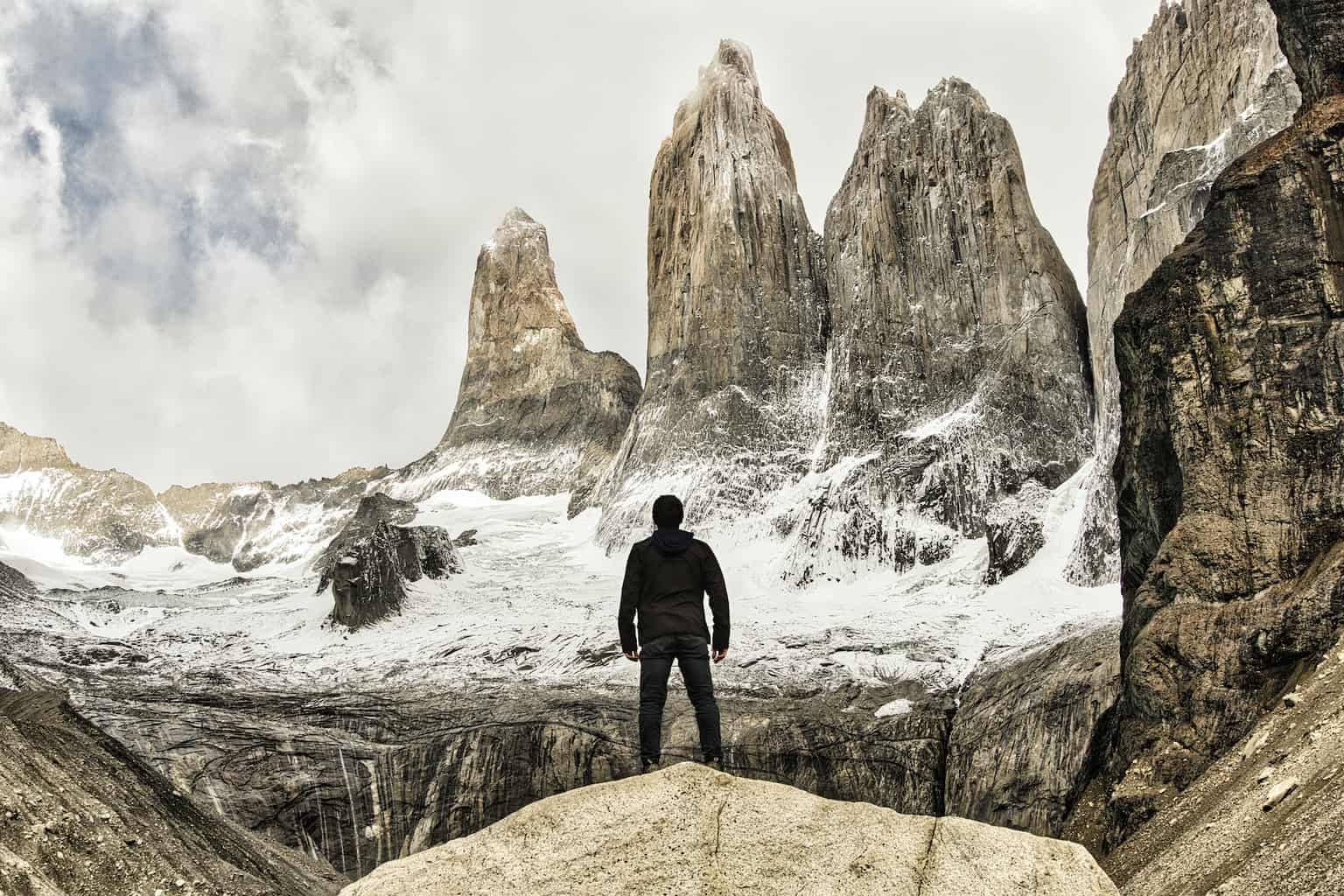
As I have traveled more around the world, I have continuously grown my passion for hiking. Whether it be up in the mountains, through the rainforests, along the coasts, or in valleys, I am always searching for that next hiking trail.
Over the years, I have also learned how important my supplies are that I bring along with me on a hike. Whether it be staying hydrated and fueled, or being comfortable enough for any conditions, a thorough day hiking packing list is essential when hitting the trail.
If you are an experienced hiker or just a first timer out there, I am hoping that this hiking packing list can help you out with your travels.
* Affiliate Disclosure : This post may contain affiliate links, which means I may receive a commission if you make a purchase through the links provided, at no additional cost to you. Thanks for supporting the work I put into TripTins!
1) Day Hiking Packing List Overview
By far the most popular type of hike to take part of will be a classic day hike. But not all day hikes are built the same.
Some hikes may just be a couple hours long while others may last an entire day. Some hikes may be up in the mountains, while others may be in the desert.
There is just so much variety when it comes to hiking trails around the world.
This hiking packing list can cover all ends of the day hike spectrum. Now, you may not need every single item on every single day hike, but this list will have you covered when it comes to hitting the trails.
In general, the packing list will go over the following main categories:
- Hiking Shoes
- Electronics
- Other Essentials
I should also note that the list can also be utilized for overnight hikes (1-2 nights), where you will be able to sleep in huts, refugios, or any other type of accommodation along the way.
If you are heading out backpacking, you will need to bring additional supplies like tents, sleeping bags, stoves, etc. You can certainly use this packing list as a baseline though if that is the case.
Throughout the list you will find links for you to purchase the gear to get that packing list ready for the trails!
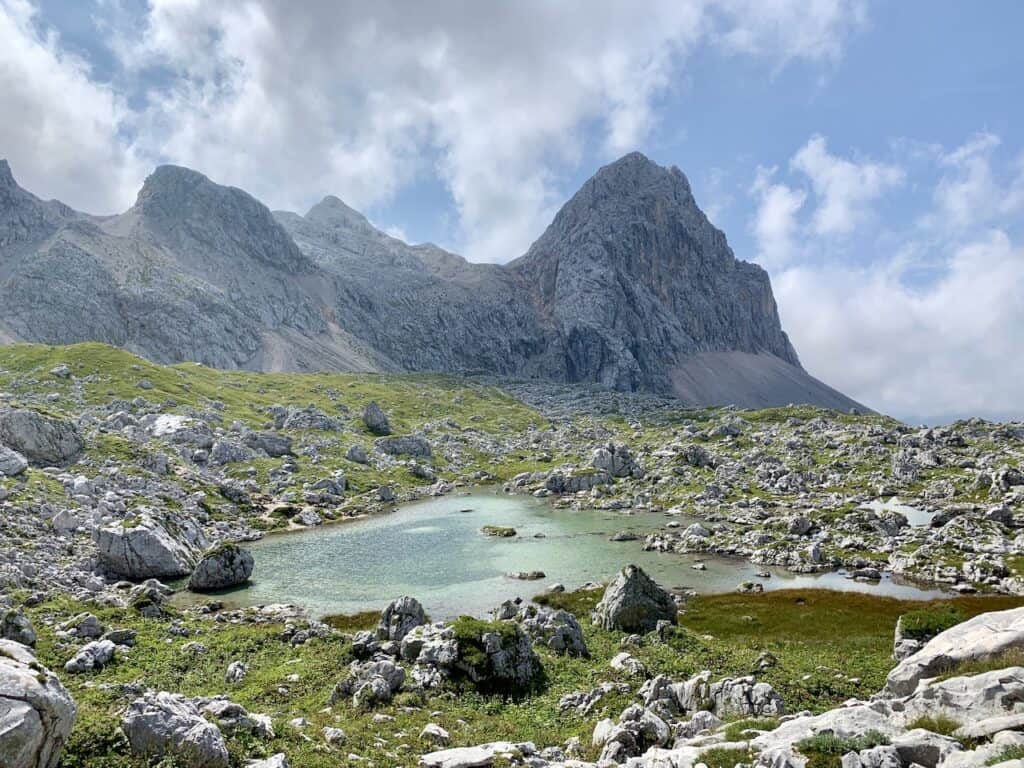
2) Weather Preparation
Before getting into the hiking packing list, I did want to call out one of the most important considerations when heading out on a hike – the weather.
Ideally, when going out on a day hike, you will be able to do so on a day where the weather cooperates.
However, that may not always be the case. Rain, wind, clouds, sun, and even snow can all come and go during a hike.
Just because it may start out as a nice sunny day out on the trail, does not always mean it will end that way.
Your day hike packing list should be put together with that in mind. Be sure to always prepare for weather conditions around the region you are hiking.
When it comes to weather forecasts, I tend to favor a site called Meteoblue .
On the site & app you will be able to see forecasts for different altitudes, including hours of sun, precipitation, and wind conditions. They even have webcams integrated so you can get some live views of the region you are heading to.
With that said, lets now get into the day hiking packing list to cover all the the most important items for your hikes.
Learn More : Up on the site is a Hiking Weather Overview that deep dives into these types of apps and points out what to look out for when going about a hike.
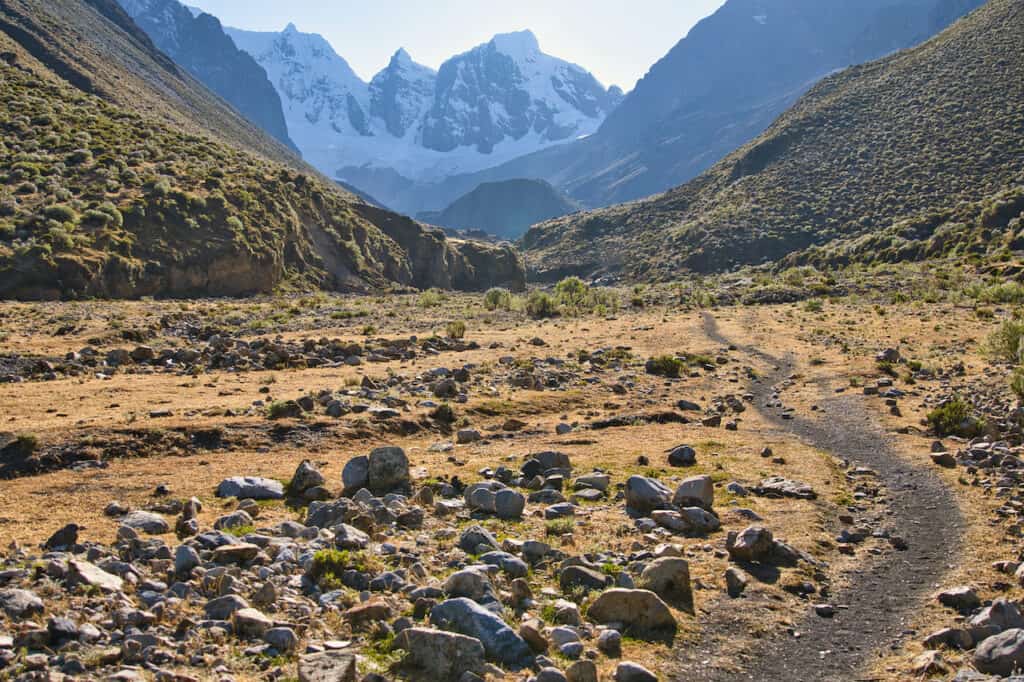
3) Clothing
When climbing a mountain or dealing with cooler temperatures, it is vital to bring along clothing layers for all parts of the hike.
A normal type of hike could start with an early morning in cooler temperatures wearing all layers, followed by a sweaty ascent up with just a T-shirt and shorts on, and finishing up top with the layers back on as the wind blows and frigid mountain air settles in.
You never know what certain hikes can bring, so being prepared with those layers is essential. Just do not assume the weather you start the hike in will be the same all the way through.
Clothing Material
Going off of that – when choosing your clothing layers, be sure to pick those that are NOT made of cotton material. Cotton absorbs moisture, which can be very problematic when it comes to sweat.
Always opt for dri fit polyester or wool material that passes along the moisture from one layer to the next and ultimately into the air (these are called moisture wicking materials).
Clothing Layer Note
You can of course add or remove some items given the exact type of hike and climate you will be experiencing .
Not every hike will require clothing layers. If you know the weather will be very hot (or very cold), then you will simply want to bring along the layers that make most sense for the hike.
Below are a list of all layers that I will think about bringing along with me depending on the hike:
Boxers / Underwear
The first layer you will want to use is your boxer/underwear layer.
I always opt for my dri fit Under Armour boxers, which have continuously worked well for me no matter what the conditions.
I am not an expert here on the women’s side, but did see the below linked Reebok line as a solid option.
Recommended Boxers / Underwear
- Men’s Boxers | Under Armour Men’s Tech
- Women’s Underwear | Reebok Women’s Seamless
Hiking Socks
A comfortable hiking sock is essential no matter what type of hike you are heading out on. You will want to choose a solid wool or dri fit type of sock that can keep you warm and dry during the trail.
Recommended Hiking Socks
- Men’s Socks | Darn Tough Merino Wool Crew Mens
- Women’s Socks | Darn Tough Merino Wool Crew Womens
Long / Short Sleeve Hiking Shirt
Having a short sleeve and/or a long sleeve shirt (depending on month) to choose from should be a good combo to work with as you make your way along the trail.
Recommended Short Sleeve Shirt
- Men’s Option | Under Armour Men’s Tech
- Women’s Option | Under Armour Women’s Tech
Recommended Long Sleeve Shirt
- Men’s Option | Under Armour Men’s Tech 2.0
- Women’s Option | Under Armour Women’s Tech 2.0
Trekking Shorts / Pants
Similar to having a short or long sleeve shirt, you will also want to consider either trekking shorts and/or trekking pants.
There have been several instances where I may start off in pants and switch to shorts later on in the day.
Recommended Trekking Shorts
- Men’s Shorts | MAGCOMSEN Men’s Hiking Shorts
- Women’s Shorts | Eddie Bauer Women’s Guide Pro Shorts
Recommended Trekking Pants
- Men’s Pants | Eddie Bauer Men’s Guide Pro Pants
- Women’s Pants | Eddie Bauer Women’s Guide Pro Pants
Mid-weight Fleece / Pullover
After a short/long sleeve layer, I also bring along one lightweight Patagonia type jacket.
Even during the warmer months, I found this type of layer to be super useful when hiking at altitude or earlier on before the sun is fully out.
Recommended Mid-weight Fleece / Pullover
- Men’s Fleece | Columbia Men’s Ascender Softshell
- Women’s Fleece | Columbia Women’s Kruser Ridge II Softshell
Down Jacket
I do not think you will need a third layer here for many treks. But it sure can be helpful during day hikes in colder climates or higher altitudes for example when even in the summer, you can see snow and very cool temperatures.
Recommended Down Jacket
- Men’s Jacket | Eddie Bauer Men’s CirrusLite
- Women’s Jacket | Wantdo Women’s Hooded Packable Ultra Light Weight
Packable Rain Jacket
A packable rain jacket is the perfect item to add to any hiking packing list. Not only can it help out with those rainy moments but it can also help drastically with windy conditions.
Be sure to get a waterproof one (like the one below), and not just a water resistant one.
Recommended Packable Rain Jacket
- Men’s Rain Jacket | Columbia Men’s Watertight II
- Women’s Rain Jacket | Columbia Women’s Arcadia II
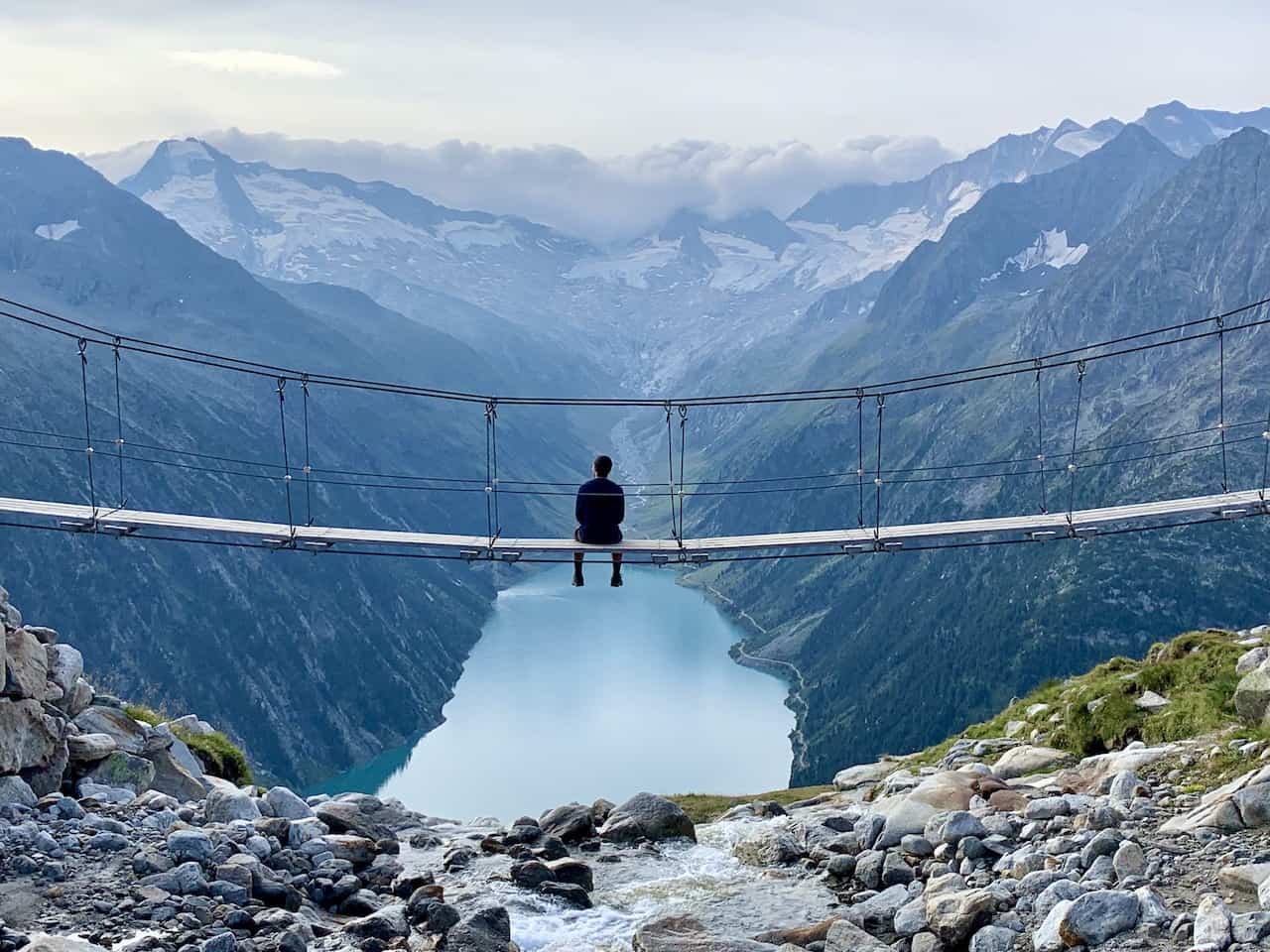
4) Hiking Shoes
Going on a hike would not be complete without a sturdy pair of hiking shoes. I have seen so many people over the years do some pretty technical hikes with just sneakers on.
And I can’t tell you how many times I have seen these people slip, slide, and fall all over the place.
If you want to hit the trails, I highly suggest investing in a solid pair of hiking shoes.
This will all depend on fit for you but some of the main brands include:
- Keen (Targhee Series)
- Merrill (Moab Series)
- North Face (Ultra Series)
- Salomon (X Ultra Series)
Hiking Shoes Note
- When choosing a hiking shoe, you will want to consider how much support you want (i.e. how high above the ankle the shoe goes).
- You will also want to consider waterproof shoes too . This will be the more expensive of options, but keeping your feet dry in all conditions can definitely be worth the extra cost.
Trail Runners Note
For most people out there, I would recommend an actual hiking shoe. However, for those with more experience on the trails, you can also opt for trail running shoes.
These will be lighter and (usually) less supportive compared to hiking shoes. But they are something I have begun to use more and more out on hikes.
My go to has been the Saucony Peregrine trail runners if you would like to give them a try.
» I would also recommend buying some Sneaker Deodorizer Balls to keep your shoes smelling nice and clean.
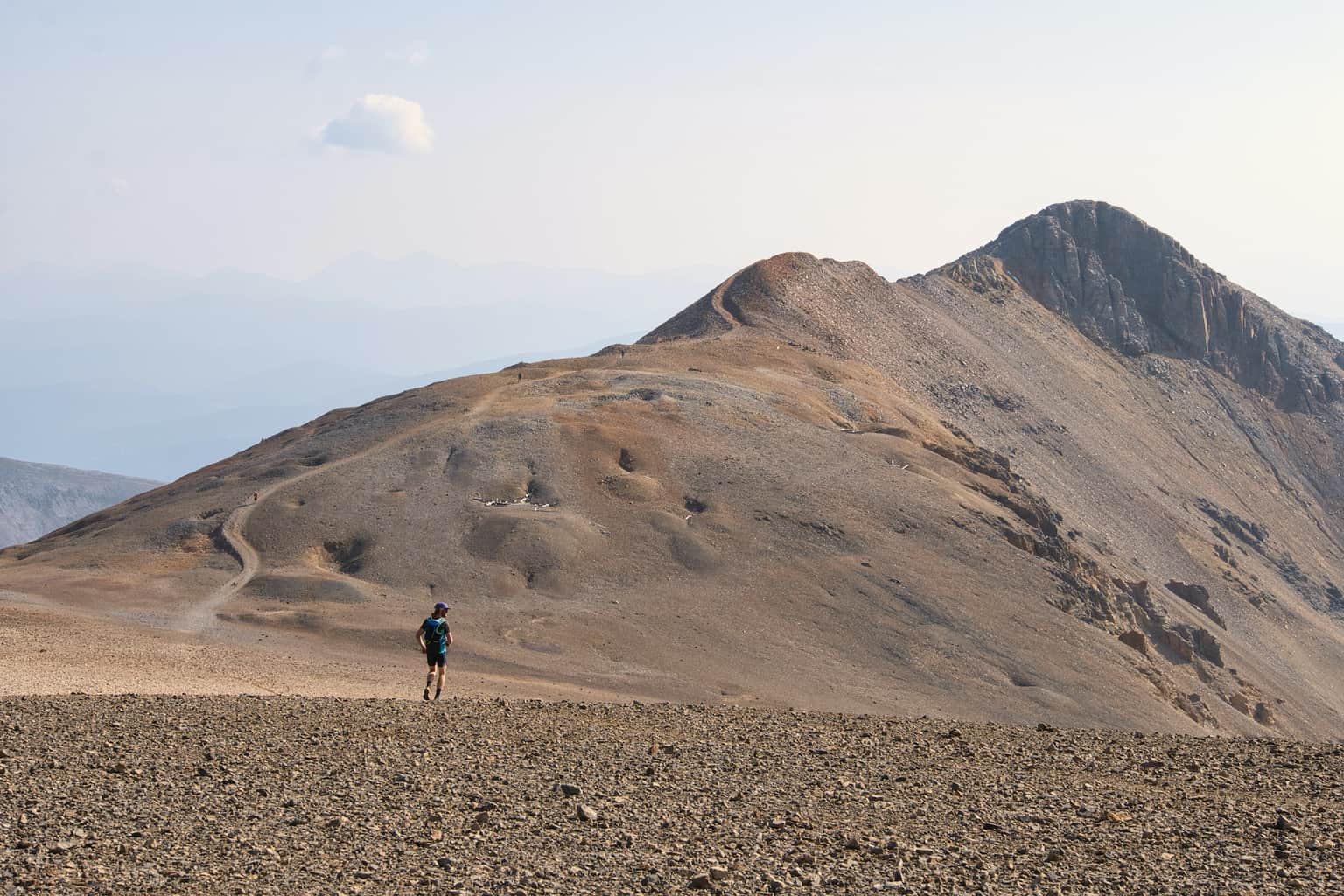
5) Hydration
There is probably nothing more important that staying hydrated during a hike. Especially if it a hike in hotter weather when you will start sweating a lot and losing that fluid.
I always fill up a sturdy reusable water bottle and depending on how long the hike it I would bring along another disposable bottle – whether than be just a regular bottle or a 1.5 liter one. You can also think of getting a hydration bladder if you want to store more fluids in an efficient way.
- Recommended Water Bottle | Camelbak Chute Water Bottle
- Recommended Hydration Bladder | Osprey Hydraulics Reservoir
Now, instead of bringing along just a regular water bottle, you could also opt for a water bottle with a built in filter. This can give you the option to fill up the bottle during the trail if you happen to pass by some flowing water.
Recently I have also been testing out this Katadyn Water Filter Bottle which has worked very well.
5) Fuel & Nutrients
Not only do you need water on the trail but you will also need some nutrients & fuel.
Since you will want to keep your body going at peak performance throughout a hike it is very important to bring along some food.
My go to options usually include Clif Bars, Fruit & Nut Mixes, and Granola Bars. Now this can be up to you depending on taste but always make sure to bring something with you during a hike.
Also don’t forget to have a hearty dinner and breakfast before a hike. Preparing your body beforehand is always an important thing to do.
- Clif Bars | Clif Bar Variety Pack
- RXBars | RXBAR Variety Pack
- KIND Bars | KIND Bar Cranberry Almond + Antioxidants
- Fruit & Nut Granola | Bear Naked Fruit & Nut Granola
- GU Energy Gels | GU Energy Gel Variety Pack
- Other Bars | PROBAR , Honey Stinger , Clif Builder Protein
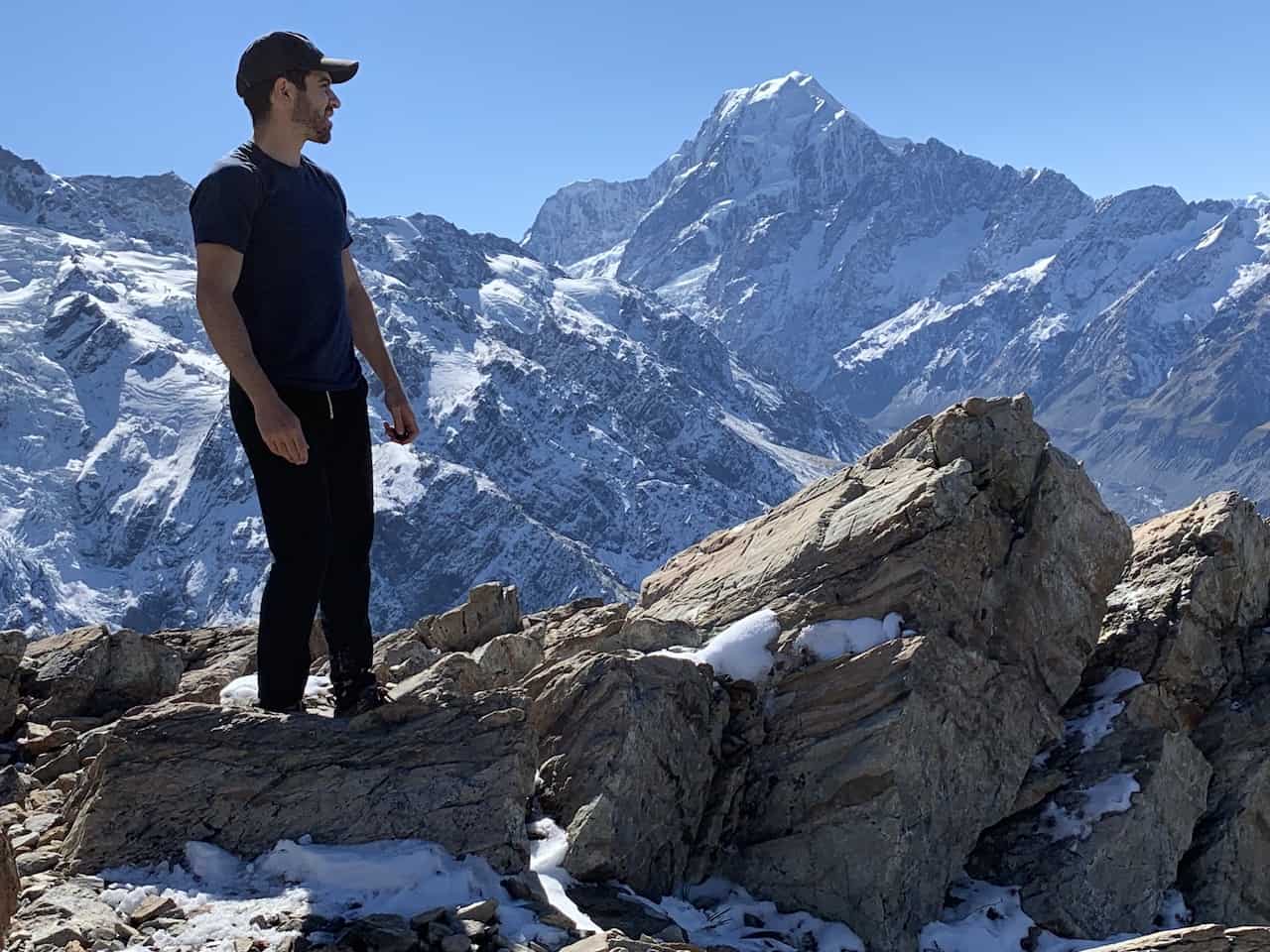
7) Electronics
Whether it is capturing the moment or just staying connected on the trail, I would recommend on bringing some electronics along the way with you:
GoPro & Accessories
This may not be for everyone but bringing along a GoPro to capture some footage during a hike has been one of my favorite things to do.
A phone or regular camera may work but getting those wide angle shots of the trail and yourself heading up it, is always going to be better shot on a GoPro.
Bringing along some GoPro accessories too will make capturing your footage a bit easier. From head straps to expandable sticks, there are plenty of accessories to choose from.
- Recommended GoPro | GoPro Waterproof Action Camera
- Recommended Accessories | Neewer 50-In-1 Action Camera Accessory Kit
Portable Charger
Whether you are using your phone for directions or photo taking, you will always want to have it charged during a hike.
Phone batteries can die sooner than you think if you are constantly taking shots or taking a look at a map. I usually bring a small portable charger along to keep my phone charged.
Portable Charger Recommendation | Anker PowerCore 5000mAh
Mirrorless Camera
As I continued to travel, I found myself wanting some better quality photos. I ended up purchasing a mirrorless Sony camera during my around the world trip .
The Sony A6600 (and other cameras in the series) are lightweight enough for the trail, and can fit into most daypacks.
Mirrorless Camera Recommendation | Sony A6600
Below are some other accessories to go along with the camera too:
- Extra Battery
- 256GB SD Card
- Mini Tripod
Photography Gear : Check out my latest travel photography gear list to see what is my camera bag these days
If you are starting before sunrise or planning to come back after sunset, then bringing along a headlamp is a must. I have recently been going with the Petzl Actik Core which has worked great in all conditions.
Garmin inReach
Lastly on the electronics list is the Garmin inReach 2 Mini . While a more expensive purchase, it was important for me as a solo independent hiker to buy one.
The Garmin can help you keep in contact with family and friends if you do not have service on the trail. It can also be used for others to track where you are.
In case of emergency, the device also has a SOS button, which can be of vital importance.
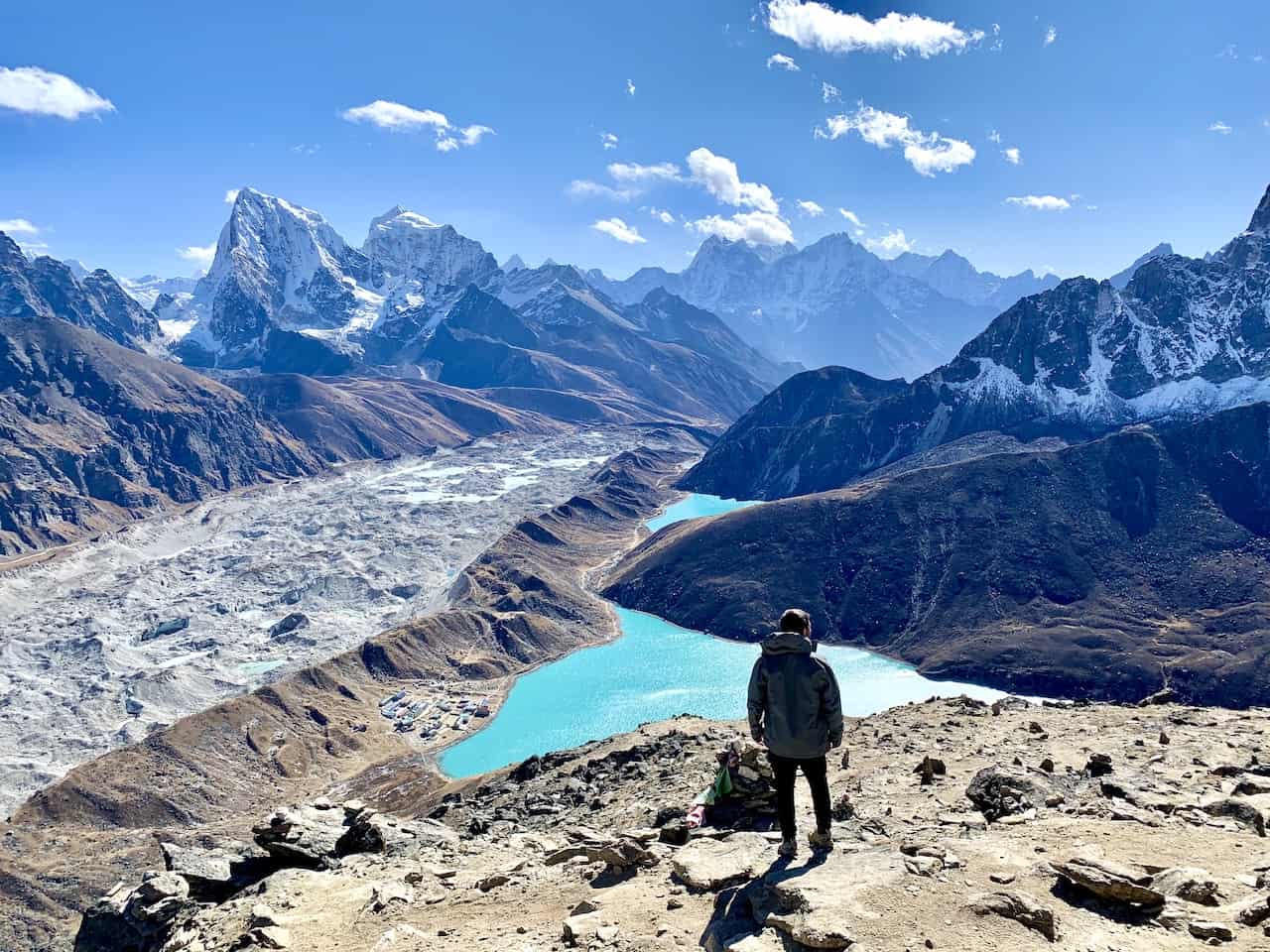
8) Other Essentials
Here is a list of a few more essentials that I believe should be brought along when hiking. While you may not need every item on every hike, I wanted to write them down just so you can decide for yourself when preparing for the trail.
Trekking Poles -> Depending on the hike, you may want to consider brining along trekking poles. These can help greatly with those steeper inclines and declines.
- Recommended Hiking Poles: Black Diamond Distance Carbon FLZ Trekking Poles
Hat and Sunglasses -> You will want to protect your face and eyes from the sun if you are consistently being exposed to it during a long hike. Even if it is not necessarily a hot day, the sun can still be strong out there. Pack a pair of sunglasses and a baseball hat just in case.
Sunscreen & Bug Spray -> Going along with protecting your body, sunscreen is also an extremely important item to bring on a hike. The sun is strong so making sure you are protected from those rays will go a long way.
If I am going on a rainforest hike and there are a lot of bugs out there, then taking some bug spray is essential to not getting all bitten up.
- Recommended Sunscreen | Neutrogena Ultra Sheer Non-Greasy Sunscreen
- Recommended Bug Spray | Sawyer Insect Repellent Spray
Toiletries -> there are also some hygiene items you may want to consider bringing along. These include tissues, hand sanitizer, Neosporin, band-aids, and lip balm.
9) Backpack
Now that you have all these items it is time to put them all into a backpack. I have basically only used Osprey (Talon Series) and Thule packs through the years.
I have also found newer brands such as Matador and Hyperlite that offer solid options too.
They are durable, reliable and have plenty of different pockets to store all your items above. You won’t need one that is too big for day hikes but it should be at least in the 20+ liter range.
- Mens Hiking Backpack: Osprey Talon 22
- Womens Hiking Backpack: Osprey Tempest 20
I would also bring along a backpack rain cover to protect your belongings from any rainfall as you never know when a quick storm may pass by.
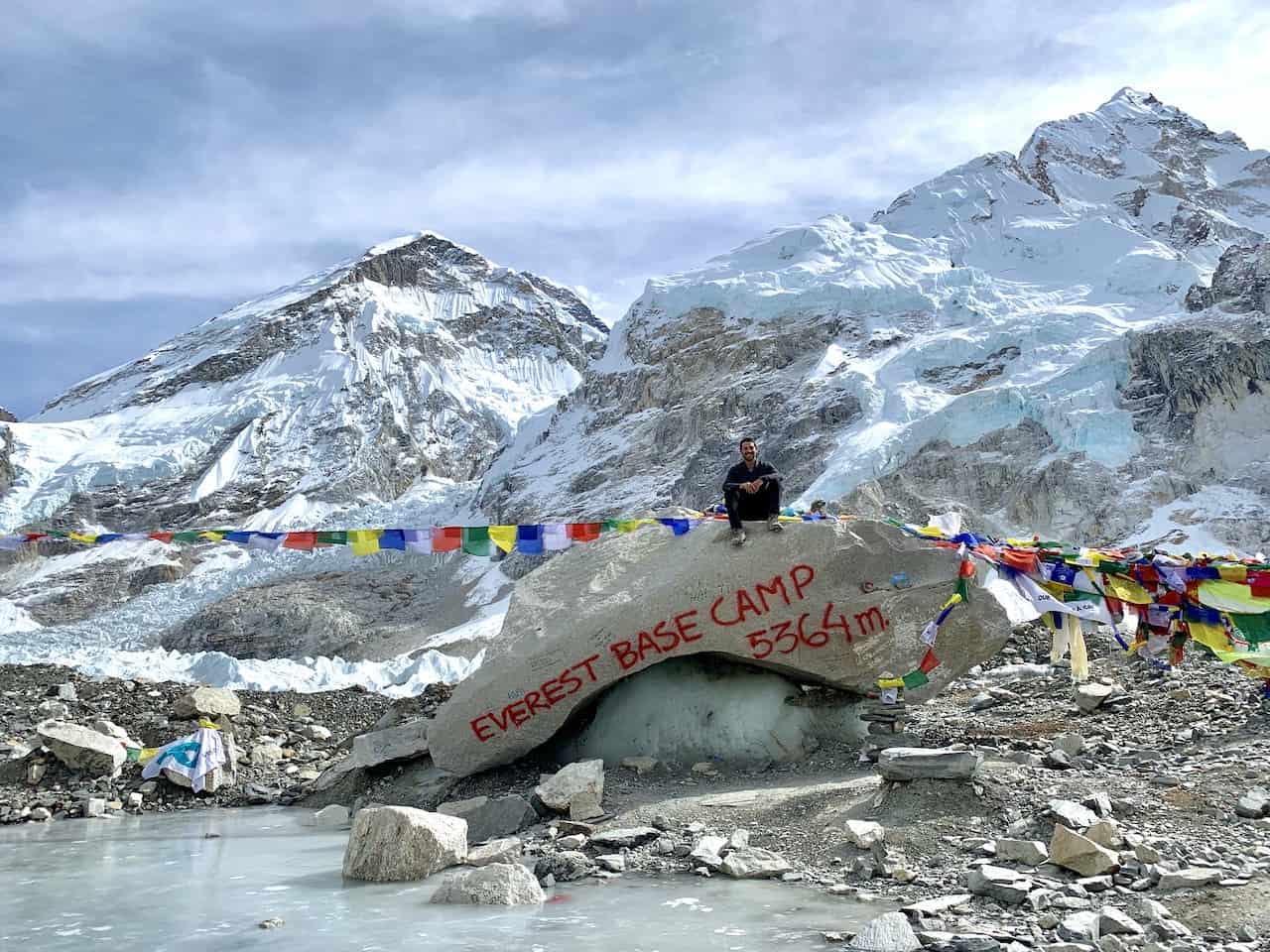
10) Hiking GPS Navigation App
While all the above will help prepare you for hitting the trails from a gear perspective I also wanted to point out a very helpful mobile app to get you around the trails.
The app Maps.me has been an essential part of my hiking experiences.
Basically, with maps.me you can download the offline maps of the area where you will be hiking so when you head on the trail, you will always know where you are (even when you have no service).
The app has almost all hiking trails mapped out, along with places of interest, viewpoints, etc. so you know exactly what to expect along the way.
During certain hikes where there are multiple routes or poor signposted trails, you can just look at maps.me and be on your way in the right direction. Believe me this is one app you want to have!
Other apps like AllTrails and Gaia offer similar types of navigation help if you would like to give those a try too.
Learn More : Up on the site is a Hiking Navigation Overview that goes over how to plan your route for the trail.
Well then, that about does it for an all inclusive hiking packing list. I hope you have learned a bit more about what to bring along on the trails and why some of these items can be essential out there in nature.
If you have any additional recommendations feel free to write them in below! Always open to hearing other people’s thoughts when hitting the trails.
Also be sure to check out some other hiking resources like these tips & tricks for hikes .
Have fun out there and safe travels!
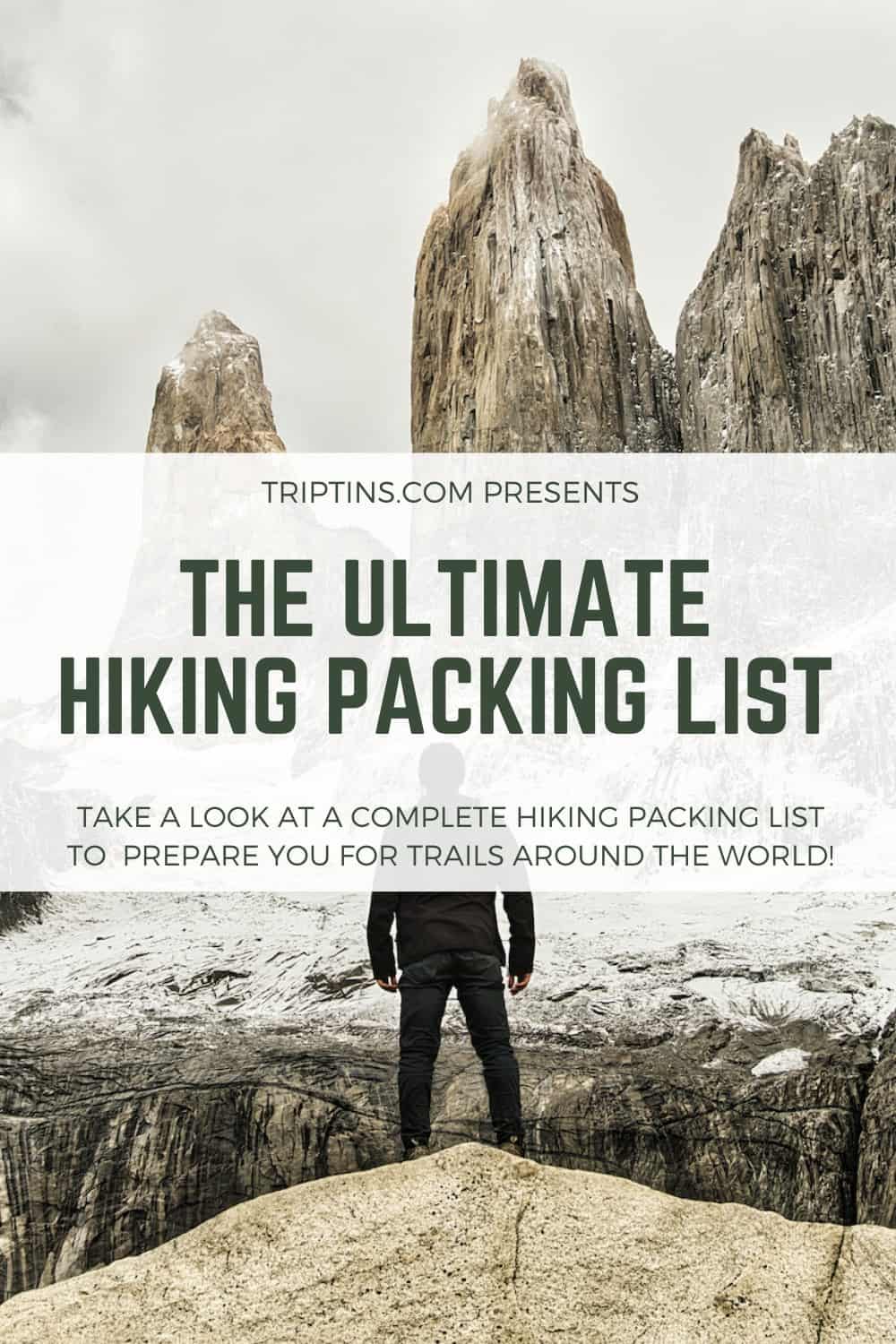
Related posts:
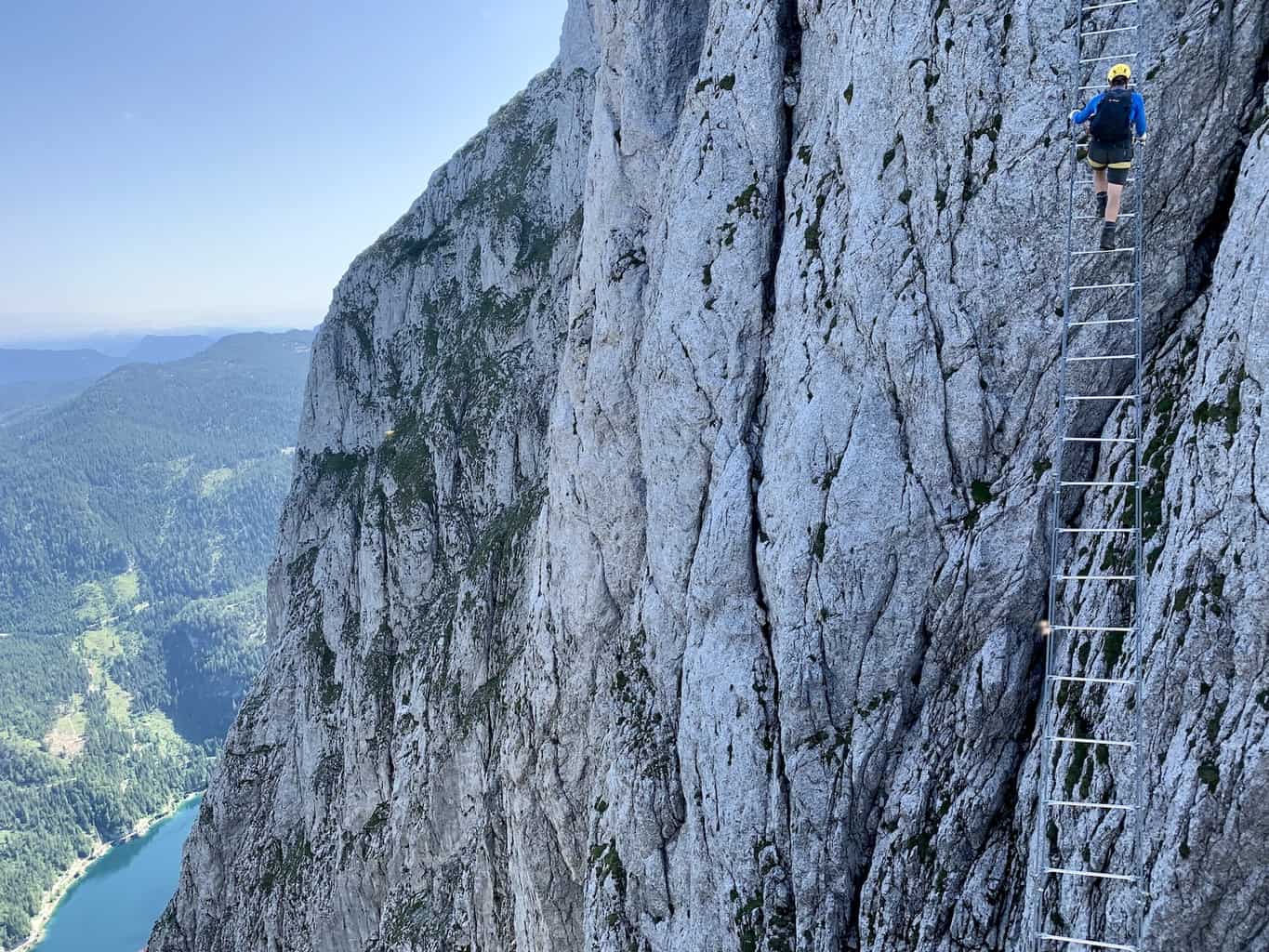
Sharing is caring!
Saturday 8th of April 2023
Going for my first trekking experience in Sapa soon, thanks for the helpful tips and advice :)

40 Hiking Essentials: The Ultimate Hiking Packing List
Heading out for a hike is a wonderful way to explore nature with family and friends, or even by yourself. Choosing the right hiking essentials is the key to a perfect hiking packing list.
Whether you want to dive deep into a multi-day trek or stay closer to home, the places to go are plenty. Many State and National Parks offer a massive network of trails.
Hiking and exploring the outdoors is one of our favorite activities to do while traveling. It doesn’t matter if you are a person who loves to explore on shorter day hikes or if you are more adventurous and are planning a multi-day backcountry adventure this hiking packing list will help you out.
Choosing your hiking style and length on the trail will help you fine-tune your hiking essentials.
Shorter hikes will no doubt involve smaller bags and not as much food and gear, and backcountry or multi-days hikes will require much more gear and preparation before you depart.
Deciding what your hiking itinerary entails is a must before starting your adventure. Let’s get started!
Table of Contents
Hiking Essentials for Any Type of Hiking
1. solar powered lantern.

This may seem like a weird item, but one of the best things about some solar-powered lanterns is that they compress down.
A favorite of ours if the MPOWERD Luci Solar Lantern (The Original Inflatable Solar Light). This makes them a great space-saving item as it is inflatable.
Even if you are only planning a day hike it is a good idea to bring a light with you in case you happen to take a little longer or the weather turns bad.
A good plus for a backcountry hike is that you will get a broader spectrum of light out of a lantern for better sight at night.
2. Headlamp

Another great option for a light source while hiking is a headlamp. Usually a little lighter weight choice than a lantern, headlamps are quite handy. Personally, this is one of those hiking essentials that we never travel without.
Whether or not you plan to hike at night, it shouldn’t matter, bring a headlamp. You never know what a day of hiking will bring your way.
A great choice of ours is the Black Diamond Spot Headlamp . It is super lightweight with a double power white LED light (300 Lumens). This Black Diamond headlamp is also waterproof making it a safe choice for any hike.
Read more How to Choose the Best Headlamp
3. Hiking socks

Our hiking essentials always include good hiking socks. As important as a hiking boot is great hiking socks. You’ll want to choose a comfortable lightweight and breathable fabric for your hiking socks.
We like to use Smartwool Merino Wool hiking socks . They provide great warmth, moisture control, odor control and great breath-ability. It also never hurts to pack an extra pair, just in case.
Read more 10 Best Socks for Hiking & Travel
4. Hiking Shoes/Boots

You will first have to decide what type of climate you will be hiking in to be able to choose a great hiking boot. Choose a good ankle boot no matter the climate for the great support.
Lighter style boots for summer and fall months will help keep your feet cooler and more comfortable. Same goes for winter and Spring, you can find warmer boots with deeper tread for added traction on muddy or snowy trails.
A women’s hiking shoe favorite of mine is the Salomon Women’s Speedcross. They feature anti-debris mesh to keep out grit and sand. Salomon’s Sensifit construction wraps your foot for a close fit.
Similarly, the Merrell Men’s Moab 2 Vent Mid Hiking Boot is a great choice for men. They offer amazing comfort with durable leather, a supportive foot-bed and outstanding traction.
5. Emergency Blanket

This is an item that we always add to our hiking packing list and cannot stress enough to have one with you on a hike.
They are lightweight and can truly be lifesaving if unexpectedly caught in a storm or a change of weather. There are many different styles of emergency blankets ranging from wool to the Mylar space blankets .
6. Insect Repellent

It goes without saying that insect repellent is a must for summer and fall hiking treks. Nothing can ruin a hiking trip faster than being attacked constantly by mosquitoes.
You will especially need insect repellent for hikes that involve going in and out of shady areas frequently.
It may feel nice to get a break from the sun for a little bit while hiking a steep mountain slope, but the mosquitoes are usually plentiful in these areas.
Protect yourself with this great REPEL Plant-Based Lemon Eucalyptus Insect Repellent. The scent is not too off-putting and the natural lemon and eucalyptus are much better for your skin.

Whether you’re off on a day hike or a several day hikes, waterproof matches or matches in a waterproof container are always a great item to have with you in case of emergency.
You can use them for momentary light at night, to light candles or to start your campfire. Regardless, they belong on your hiking packing list.
8. Hiking Backpack
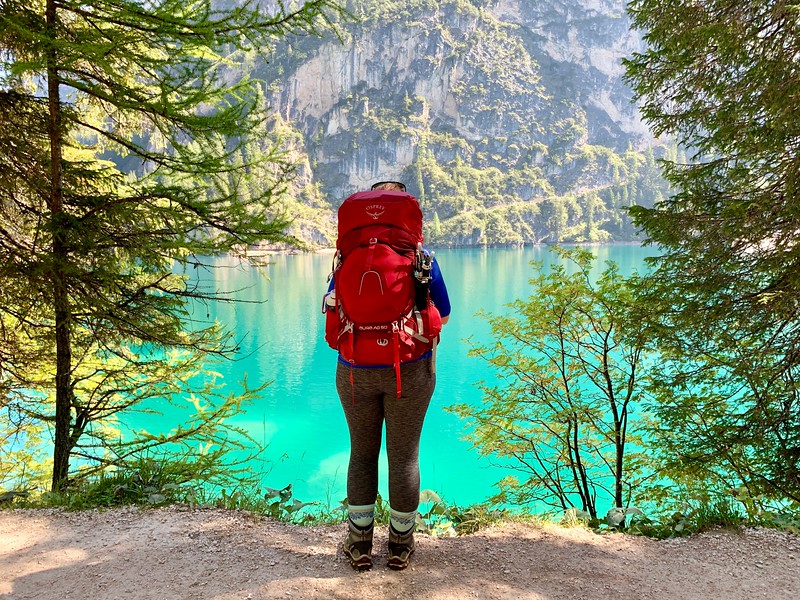
Once again, finding the perfect hiking backpack is completely dependent on your hiking plans. A day pack of 20 L would be a great choice for a single day hike .
For women, we really like the Osprey Packs Sirrus 24L Hiking Backpack and for men, the Osprey Packs Talon 22 Hiking . Osprey makes great day packs that are lightweight and supportive with great exterior pockets with additional room for hydration bladders.
You will be able to fit snacks, camera gear, and your emergency essentials inside with a little room to spare. Most of those smaller day packs also come with water bladders for easy water storage.
A backcountry hike will require a larger bag, one that you are able to fit a sleeping bag in or on as well as a tent. 50-65 L is of a good size.
For these longer multi-day hikes we are big fans of the Women’s Osprey Aura AG 65L backpack and Men’s Osprey Aether 70L backpack.
Most have nice supportive and breathable frames to make your long days on the trail a little easier. Opt for one with good side pocket access and straps on the outside.
Read more 10 Best Hiking Backpacks for Your Next Adventure
9. Hydration Pack or Water Bottle

As mentioned above, many day pack backpacks offer water bladder/hydration packs inside of them. They usually hold more water than a single water bottle and come with a handle drinking tube so you don’t have to take the water out.
Water bottles with an area to clip to your bag are also great ideas. This makes them very easy to reach while hiking, either by yourself or with someone who is on the trail with you.
Read more Best Travel Water Bottle: Top5 + How to Choose

Every hiking packing list should include snacks no matter the length of your adventure. Always pack a little more than you think you will need.
Better to be over-prepared than to be hungry and not have enough. Choose snacks with protein and high-calorie count to help keep you energized on the trail.
Great options to stock up in bulk are: Power Up Trail Mix, Mega Omega Trail Mix , Frooze Balls Plant Protein Powered Fruit & Nut Energy Balls and the Hangry Adventure Kit , which are perfect for Biking, Hiking, and Camping.

11. Rain Jacket

This item is essential for any hiking trip. Since being out on the trail can give way to changing weather at a moment’s notice it is important to be prepared.
Another plus to rain jackets is a layer of wind protection as well. Get one with a hood for added protection from the elements.
A great rain jacket option for women is the Mountain Hardwear Acadia Jacket Women’s Lightweight Waterproof Rain Jacket . This jacket is great as it is super lightweight and features underarm zippers for extra ventilation for those warm rainy days.
For men’s rain jackets a great choice is Marmot Minimalist Men’s Lightweight Waterproof Rain Jacket . Featuring Gore-Tex material with Marmot’s Paclite technology provides you with optimal waterproofing and breathability.
Similar to the women’s rain jacket above, this jacket also features Pitzips, which allow you to regulate the internal temperature by increasing airflow when needed.
Read more Best Travel Rain Jacket to Stay Dry on the Go

Dressing in layers is the smartest thing to do while hiking. It’s always better to be overdressed and take off layers than to be cold and not have enough clothing with.
We like lightweight breathable base layers followed by a great moisture-wicking merino wool long sleeve top.
Smartwool is a great brand for merino wool base layers. They offer a wide range of products for both men and women and are one of the best in the business.
13. Warm Jacket

It goes without saying that you should always add a nice warm jacket to your hiking packing list for backcountry hikes and depending on the area you are in, even for a shorter day hike.
If you are hiking a mountain peak trail for a day hike, it will be warmer in the valley than at the top of the peak and a warmer jacket will come in handy for resting and appreciating the work you just put in to get to the top, without getting a chill.
We prefer the pack-ability of down jackets. They are very lightweight and often come with a stuff sack attached they can fold into. You can buy a variety of down jackets now. From full down, synthetic or a mix of both.
Hands down, Eddie Bauer is a favorite of ours for down jackets. They are made of high-quality materials, are ultralight, packable, and very versatile.
A great women’s jacket we love is the Eddie Bauer Women’s CirrusLite Down Jacket , which is filled with 650 premium down insulation.
In addition to Eddie Bauer, we really like the quality of Columbia products as well. The Columbia Men’s Crested Butte II Omni-Heat Jacket is another great option when looking for down jackets.
This jacket features an Omni-Heat reflective thermal lining to trap your own body heat for warmth without the bulk.
Read more Best Packable Down Jackets
14. GPS Device

A GPS is another great survival item to have on your hiking packing list. Especially if you will be going on some isolated backcountry hikes where you will not have cell service or access to highly trafficked trails and roads.
There are a variety of styles available today. Most have extensive battery life, weather forecasting and messaging capabilities to stay in contact with your hiking buddies.
Read more How to Choose the Best GPS for Hiking
15. Maps & Compass

In addition to a GPS, a map of the area or trail is a great item to have on hand in case you get off trail or need to reference something quickly without worrying about wasting your GPS battery life.
A lot of National and State Parks offer extensive trail maps. They outline where ranger stations are, how long trails are and sometimes even the difficulty of the hikes. The best part is if gathered from the park they are usually free.
You should also always have a compass with you when hiking. Being able to orient yourself should you become lost, whether on a day hike or longer, is essential to finding your way back to safety.
We like to carry the SUUNTO A-10 Field Compass with us on all hikes. Personally, this is one hiking essential we never hit the trail without. And you shouldn’t either.
16. Hiking poles

We cannot stress enough the importance of hiking poles and this item belongs on every hiking packing list, no matter your age.
Not only are they a lifesaver for those steep ascents and descents of mountain peaks but they are great for providing extra stability and support throughout your entire hike.
Many styles now are collapsible which allows them to be easily stored on your pack while resting or if not in use.
17. Sun Protection
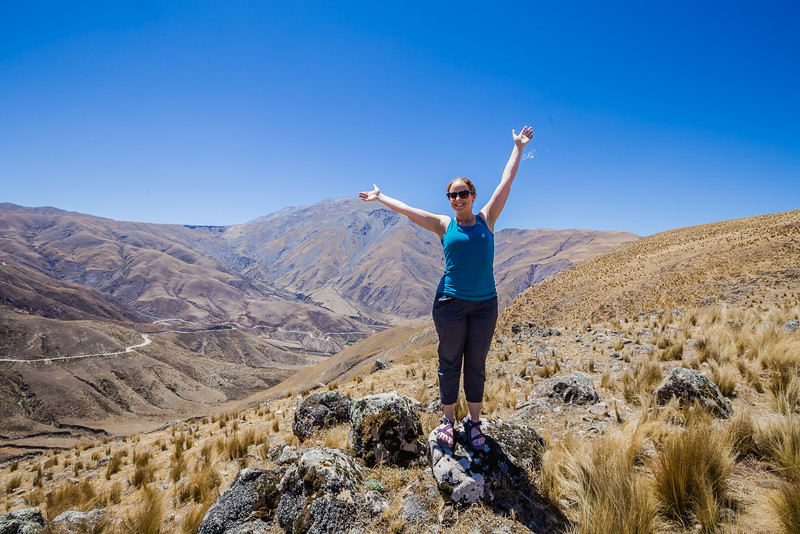
Always one of those hiking essentials when spending time outdoors, especially with the rise in skin cancer and skin cancer awareness. Even on cloudy overcast days you can still get a sunburn so make sure to protect yourself.
Try to choose a sunscreen with at least SPF 30+ such as Neutrogena Beach Defense SPF 70 and re-apply every 2 hours. If this is something you just will not do, there are great options for sun protective clothing (UPF).
These items will protect your skin without the need to constantly reapply sunscreen.
18. Lightweight Hat
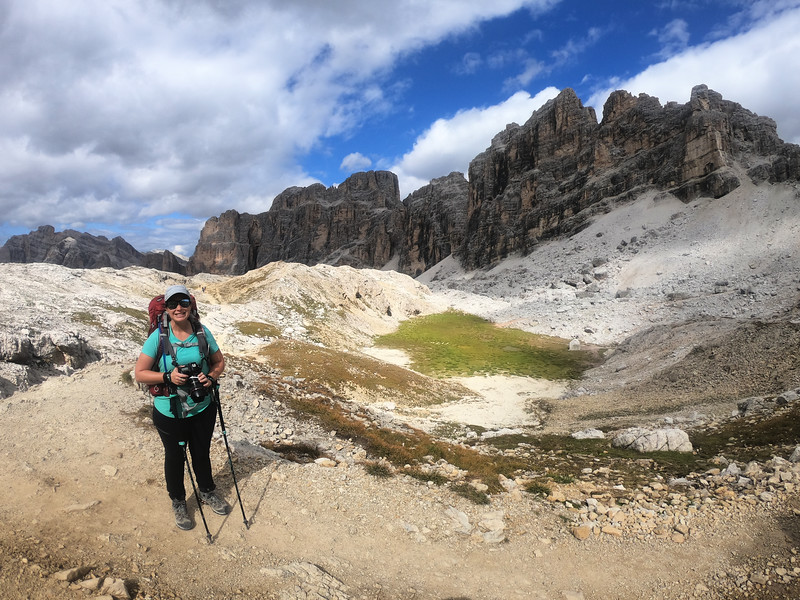
Just as mentioned above about sunscreen for your body a hat is a great additional item to add to your hiking packing list that will provide coverage of your face, neck and ears.
The Columbia Unisex Bora Bora II Booney Hat is a great option for both men and women and provides great sun protection.
These areas are the most forgotten areas when applying sunscreen and can easily be protected by a wide-brim sun protective hat. Try to buy one that is lightweight and moisture-wicking with a minimum of 3” brim.
19. Warm Hat

Just as packing a warmer jacket is important, so is a stocking hat. Whether you will be needing it for your entire adventure or just packing it in case of colder weather, a warm hat is essential.
There are a variety of styles available ranging from beanie style to stocking hats with brims.
Just make sure you don’t buy something too heavy and make sure it still has moisture-wicking capabilities or you will get too warm and end up taking it off when you need it.
20. Buff Headwear

Buff headwear is a great alternative to bringing a sunhat. The Buff has many functions. You can wear it as a bandana, ponytail holder, sun guard, scarf, hat, or neck gaiter.
They come in many solid colors as well as fun designs and are made of 100% polyester microfiber. They are durable, soft, wind-resistant, breathable and moisture-wicking. Buff headwear is Seam-Free so you won’t have any irritation from seams.
Even if you are heading into a colder climate for hiking, you can still buy a Buff headwear as they even make some out of Merino Wool .
21. Binoculars

The last thing you want is to be on some amazing hike, then spot wildlife, just to realize you didn’t pack your binoculars. Pick a pair based on what you want to carry.
There are a variety of full size and palm-size binoculars to choose from. Get a pair that are also great in rainy weather conditions and that are rated for long-distance animal viewings.
Many times in the mountains, for example, you may be hiking a peak only to look down in the valley and see a herd of sheep or elk.
Read more Best Compact Binoculars
22. First Aid Kit

A simple first aid kit is a great addition to anyone’s hiking packing list. Pack just a few essentials for the day or maybe even an extensive one for a multi-day adventure.
Kits that include second skin or steri-strips are great in the case of bigger cuts or injuries. In addition to that make sure there are splint items, gauze and ace bandages in case of sprains or breaks.
23. Multi-Tool

Bringing a pocket knife or multi-tool is a very functional item for hikes. They have many uses and can be used for protection as well.
Multi-tools are wonderful for multi-day hikes as you will be opening packages for meals, eating food, cutting down kindling for fire starter, etc.
24. Bear Spray

If you’re going to be in bear country, this is one of those hiking essentials. You can find bear spray at most outdoor stores or online. Other great bear detractors are bells and whistles or even clanking your hiking poles together.
Remember that you cannot fly with bear spray, so you will have to plan on purchasing this item when you arrive in your destination.
25. Toilet Paper/Wipes

An absolute necessity, as you may not be able to control when the need for these items hit you.
Choose whichever you are most comfortable with but several brands make hiking/camping specific toiletries that are more compressed and lightweight for carrying in your pack.
The plus to bringing wipes is you will also have them for wiping your hands off or wiping yourself down after a long sweaty day on the trail.
Of course, with this item you should also pack a large zip lock bag (one of those hiking essentials) because you need to pack out what you pack in. Do not, under any circumstances, plan to leave your toilet paper or wipes on the trail.
26. Sunglasses

We cannot stress the importance of a great pair of sunglasses as one of your hiking essentials.
Not only are they great protection for your eyes against the sun’s harmful rays but they also make those long full sun days much easier on your eyes.
I definitely start to get a headache when I am constantly squinting from forgetting my sunglasses.
Oakley is one of our go-to sunglasses brands. Try to buy a pair of sunglasses with polarization in addition to UV protection.
Having polarized lenses provides you a clean and crisp view through your lens cutting any glare from the sun.
27. Whistle

You never know when an emergency situation may happen, so this is definitely one of those hiking essentials.
In addition to packing a great first aid kit, you should also include items, like an Emergency Whistle , that may help you be found in case you get lost. It’s a small inexpensive item, but it may save your life.
Recommended Multi-Day Hiking Essentials
28. dehydrated meals.

Don’t knock them till you try them. For those spending the night out on the trail, dehydrated meals are a great option. They are lightweight and take up very little space in your pack.
Also, all they need is hot water and presto, a hot meal after a long day hike. There are several different types of meals and flavors so if you are a picky eater buy a few beforehand to make sure you have something you’ll actually like to eat after your long day on the trail.
If you’re planning a longer multi-day hike, these hiking essentials can be a weight and space saver for you too.
29. Hiking Stove

Depending on what your hiking plans entail will help you decide if you need to pack a stove.
We like the single-burner style like the Jetboil Flash Camping Stove Cooking System since they are lighter weight and very convenient for cooking food after a long day of hiking.
Read more Best Backpacking Stoves for Hiking
30. Backpacking Tent

Lightweight tents are one of those hiking essentials that can be hard to perfect. The tent needs to be small and light but also strong and sturdy.
There are hundreds of options on the market, so this an be one of the hardest tasks you’ll face when buying gear for hiking.
Ultralight gear is super popular among hikers, but you have to remember that, while light, this gear isn’t made for rugged multi-day trips with varying weather.
You want to find something that can hold up to some wind, stands strong and can block rain.
Ultimately, what you decide to buy will depend on where you are hiking and the climate. Not all tents are created equal, so be sure to do your research and buy one that suits your needs.
Read more Best Backpacking Tent: Top 5 + How to Choose
31. Sleeping Bag

Depending on what the weather will be like while you’re out hiking will ultimately determine how warm of a sleeping bag you need to have with you.
Just like our warm jacket suggestions, we prefer down sleeping bags for their lightweight build, packability, and warmth.
A great sleeping bag option for men or women is the Sea to Summit Ascent Down Sleeping Bag . It is great for most sleeping conditions with a 25 degree Fahrenheit rating.
It is packed with 750+ Ultra-Dry down insulation and is a mummy shape. Featuring vertical chest baffles, a shaped hood, oversized draft collar, and zipper draft tube.
Read more How to choose theBest Sleeping Bag
32. Sleeping Bag Liners

Sleeping bag liners are one of those hiking essentials that is commonly overlooked when planning for a hike.
They come in a variety of different shapes and sizes, but figuring out which style is best for your frame and build, may well be a process of trial and error, to find the most comfortable gear for you.
There are generally two shapes when it comes to sleeping bag liners: the ‘Mummy’ design or the rectangular fit.
Sleeping bag liners are great for providing an extra layer of warmth around you inside your sleeping bag. A favorite of ours is the Sea to Summit Stretch Silk Sleeping Bag Liner .
This liner features AA-grade ripstop silk & polyester with lycra stretch side panels. It is smooth and comfortable and can be used alone in warm weather or as an added layer in your sleeping bag in colder weather.
Read more Best Sleeping Bag Liners: Top 12 + How to Choos e
33. Sleeping Pad

A sleeping pad is another great addition to your overnight hiking list. There are a variety of sleeping pads available but always look for a lightweight, packable one to keep your weight down in your pack.
The Klymit Static V Sleeping Pad is an a ffordable lightweight camping pad with a V-chamber design to limit air movement and heat loss for better support and comfort. It’s very easy to use and has a push valve allowing for quick inflation and deflation.
Read more Best Sleeping Pads: Top 5 + How to Choose
34. Camp Utensils

Camp utensils are also one of those commonly overlooked hiking essentials when formulating a backpacking trip list. However, no days, you can find great multi-functional sets of utensils that are lightweight and durable.
The Gerber ComplEAT, Camp Cooking Tool features 4 components: spoon, fork, dual-sided spatula, and a 4 function multi-tool. All of them together weigh less than 2.5 ounces.
The 4 function multi-tool features a serrated Package opener, can opener, bottle opener, and a veggie peeler.
35. Multi-Day Hiking Backpack

Your hiking backpack for any long-duration trip is one of the most important items you have. Finding the perfect bag for you is not always easy and may require multiple trips to outdoor stores to find what brand and style works best for your frame.
Some companies make bags that fit women’s bodies better than other companies and the same goes for men, so don’t be afraid to try several different kinds before settling.
A great option for women is the Osprey Packs Pack Aura Ag 65L Backpack . Offering great anti-gravity suspension which helps make you feel like you are carrying less weight than is actually in your pack.
It has great features like trekking pole attachments, adjustable harness and hip-belt, internal hydration reservoir sleeve, removable floating top lid, and dual zippered pockets with web attachment points.
A great option for men is the Osprey Aether AG 70L backpack . This pack has continued to stay at the top of lists for its great mu lti-position torso adjustment which fits a wide range of body sizes.
With a durable open-cell foam lumbar pad and molded channels, this pack provides maximum comfort and airflow. The great design offers a separate sleeping bag compartment, compression straps, and exterior pockets for strategic packing.
36. Repair Kit
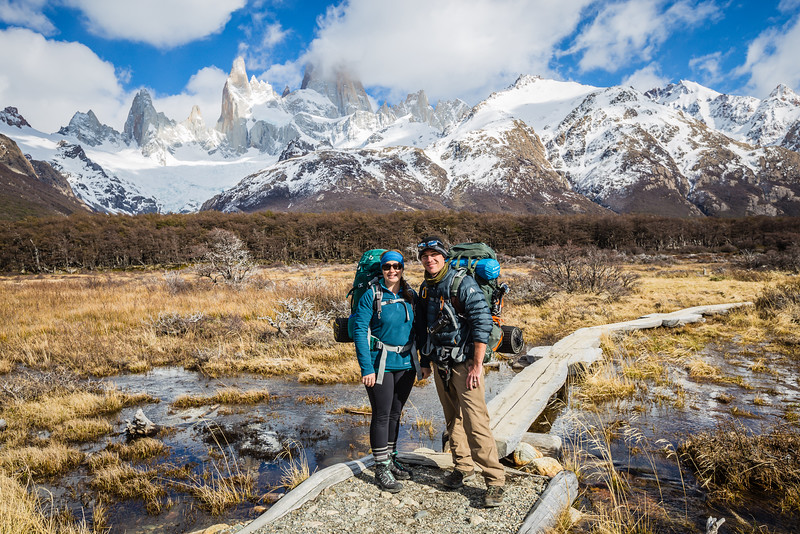
Preparing a list of hiking essentials for your hiking adventure includes trying to anticipate the need for worse case scenarios.
Having a Tear-Aid Fabric Repair Kit on hand is an essential hiking item for those long backcountry hikes.
You never know when you may get a tear in your pack, tent, or sleeping bag. Accidents happen all the time and better to be prepared than to struggle for the remainder of your trip.

Gloves are an essential hiking item no matter the duration of the trip or the weather.
They are lightweight and will make a huge difference if you encounter unexpected weather changes out on your hike. We really like Waterproof Outdoor Gloves .
They are windproof, waterproof and have touch screen fingertips to allow you to work your devices without removal. They also feature an anti-slip design to help with grip while climbing those steep ascents.
38. Kindle/Book

I know, a kindle, not quite an essential item for a packing list but after a long day of hiking it is nice to unwind and relax by the campfire while reading a good book.
Reading also really helps me get relaxed and ready to sleep so I never travel without it. The newest Kindle Paperwhite is a great choice as it is now waterproof! They are also lightweight and offer up to 8 weeks of battery life from a single charge.
Of course, there are several great e-readers to choose from and you can also always just download a book app onto your phone as well.
39. Backpacking Chair

Backpacking chairs may not be an essential item but they are super handy. Especially after a long day out on the trail.
The Sportneer Portable Lightweight Folding Camping Chair is sold as a two-pack and is crafted from ultra-breathable, super-absorbent mesh that circulates air and keeps you relax.
Setup is super easy and fast. The aluminum frame keeps these chairs lightweight, coming in at around 2 lbs. They are also pretty heavy duty, supporting up to 350 lbs.
40. Microfiber Towel
Lastly, this is one of those hiking essentials that you’ll be thankful to have in your pack at the end of a long hiking day.
We carry microfiber towels with us on every hike because you never know when you’re going to need one.
If you’re roughing it, you may want to hop into a nearby lake or river to rinse off and cool down. If you don’t have access to water, you will want it wipe away sweat from your face.
If your hike has huts or refuges, you may have access to a spigot or shower, so having a towel with you is always a good idea.
Read more Best Travel Towels: Top 5 + How to Choose
Wherever your adventure takes you we hope this packing list has provided you with a great base for your upcoming hiking trips!
More on Hiking:
- Best Backpacking Stoves for Hiking & Travel
- How to Choose the Best GPS for Hiking
- Best Hiking Backpack for your Next Adventure
- The Best Backpacking Tent: How to Choose the Right One
- How to Choose the Best Sleeping Bag
- Best Sleeping Bag Liners: Top 12
- Best Compact Binoculars for Outdoors & Travel
- Choose the Best Packable Down Jacket for Travel
Did you like this story? Share it!
Travel planning resources, about david stock.
I have always been an outdoorsman so becoming an adventure traveler was just the next natural step. I love nature, I love to get off the beaten path and I like to explore. I enjoy scuba diving and cars. And yes, Lina and I have a naked dog.
Leave a Comment Cancel reply

OUTSIDE FESTIVAL JUNE 1-2
Don't miss Thundercat + Fleet Foxes, adventure films, experiences, and more!
GET TICKETS
Powered by Outside
The Ultimate Dayhiking Checklist
Don’t leave this indispensable gear at home..
Heading out the door? Read this article on the new Outside+ app available now on iOS devices for members! >","name":"in-content-cta","type":"link"}}'>Download the app .
Dayhiking is one of the simplest and most liberating ways to immerse yourself in nature: You can rack up wilderness solitude, views, and exercise without carrying a heavy pack or planning for an overnight. But while many hikers bring nothing more than a water bottle, boots, and snacks, it’s best to come prepared for any trail outing by referencing a thorough gear checklist. The Ten Essentials , which are included in this list and recommended for any kind of wilderness trip, offer an extra degree of safety in the event that your hike doesn’t go as planned. Note: This list is meant for three-season dayhiking only—you’ll need additional or different gear for winter hiking or when traveling in specialized environments. Time to grab your pack and hit the trail.
Click here for a printable checklist. Extending your trip into an overnight? Our backpacking checklist has you covered.

– A 10- to 35-liter daypack
The type of daypack you bring will depend greatly on how many miles you intend to hike, how much extra gear you bring, the terrain, and the weather. Important features to consider include the frame (frameless packs are lighter, while internal-frame packs have a great carrying capacity), hydration sleeves or water bottle side pockets, and access points, from roll-top to front zipper. Small, trail running-oriented daypacks tend to leave less space for layers and gear, but prioritize stability with minimalist silhouettes and harness-style shoulder straps. They also typically have plenty of front pocket storage for on-the-move access. Dayhikes that involve extra layering—like on rainy or cold days—extra water, or equipment for children and dogs can push you into the 35 liter-plus range. Check out some of our favorite packs here.

– Hiking boots , hiking shoes, trail running shoes, or hiking sandals
– Underwear
– Shorts, pants, or other bottoms such as a hiking skirt or kilt
– T-shirt or long-sleeve shirt (for insects and sun protection)
– Sunglasses
Carried or Worn (Depends on Conditions)
– Insulating midlayer, such as a fleece
– Packable down or synthetic jacket
– Hardshell jacket or rain poncho
A one-day hike gives you the added benefit of having a weather forecast to base your kit on. But even if the report calls for sunny skies and temps in the 70s, it’s best to pack a shell for wind and rain and some sort of insulating layer just in case the conditions turn sour. Pants will save your legs in buggy, exposed, or brushy environments. On muddy, wet, or snowy trails, waterproof boots will keep your feet happy. Remember the saying “cotton kills”: The material holds on to moisture and doesn’t insulate when wet—the perfect recipe for hypothermia. Only wear wool or synthetic layers for the best temperature regulation. Read more about dialing in your layering system here.
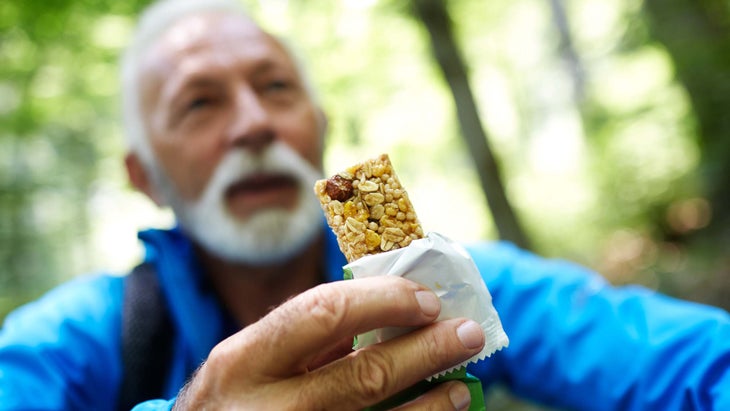
– An extra day’s supply of food
A calorie-rich lunch and plenty of snacks might be all you need for a day on the trail, but it’s best practice to bring an extra day’s worth of food along with you. Bring no-cook food, like nuts, bars, or cured meat, which is better in the off-chance that you don’t have access to water or the conditions to make fire during an emergency overnight.
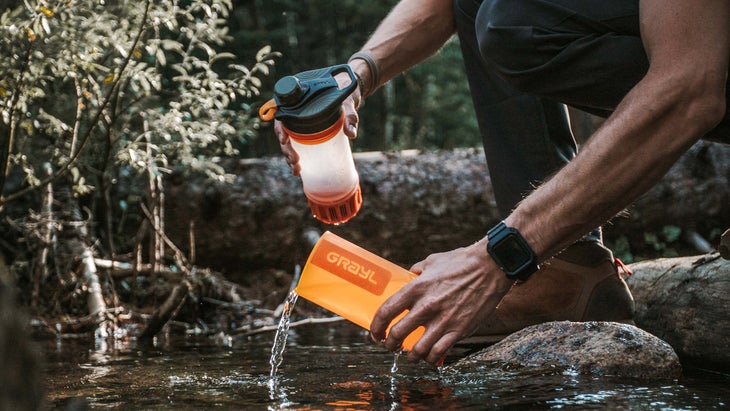
Water Storage and Filtration
– Water bottle and/or water reservoir
– Compact filter or purification system
Expect to drink around a liter of water every two hours as a loose rule. (In warm climates, at high altitude, or on very strenuous ascents, you may need more.) If you’re going on an extended day hike, don’t want to carry extra water on your back, and expect to find fresh sources along the way, a small, lightweight filter will cut your pack weight. Regardless of whether you plan to refill, it’s a good idea to bring some form of purification—even as simple as iodine tablets—for a worst-case scenario. Read about some of our favorite water filters here .
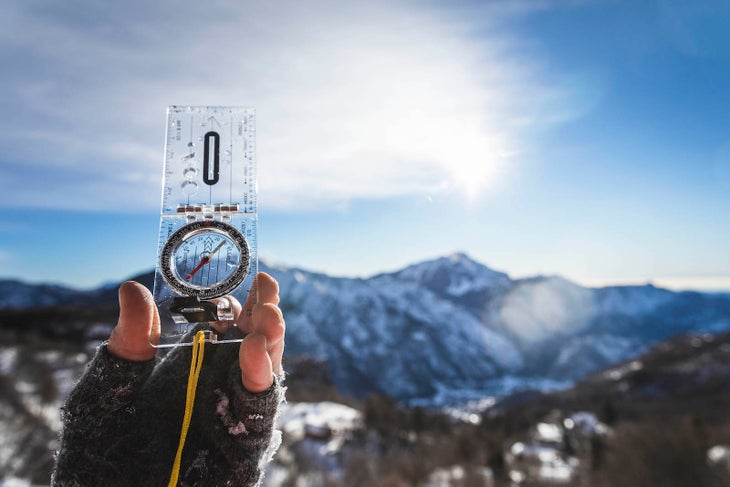
– Map, compass, and the knowledge to use both
– GPS device (optional)
– Navigation app, like Gaia GPS (optional)
Just because you’re only heading out for a few miles doesn’t mean there isn’t a danger of getting lost. Map out your route ahead of time, and always carry a topographic map and compass and know how to use them. Staying found requires carrying only a few extra ounces and a quick navigation course. Read more about backcountry navigation here.

Electronics
– Headlamp with extra set of lithium batteries (or rechargeable headlamp)
– Satellite messenger or personal locator beacon (optional)
If you’re planning a solo trip or heading to a remote backcountry location, a satellite messenger or PLB can offer peace of mind. Always bring a headlamp in case you end later than you planned or have to spend the night. Read more about some of our favorite backcountry electronics here.
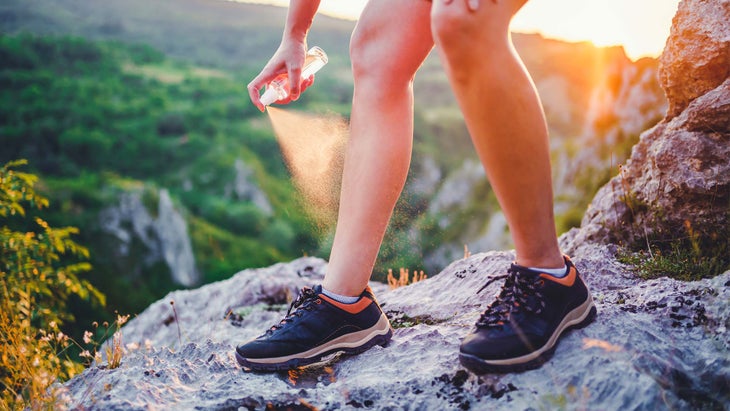
Personal Hygiene
– Toilet paper or backcountry bidet
– Hand sanitizer
– Sunscreen and SPF lip balm
– Bug repellent
– WAG bag (if required)
– Menstrual products and pack-out bags (if not using a menstrual cup)
– Female urination device (optional)
– Pee rag (optional)
How you take care of business in the backcountry depends on the environment. The easiest scenario involves moving 200 feet from a water source, trail, or camping area, digging a six- to eight-inch deep hole, clearly marking your spot, and cleaning your hands thoroughly. In certain environments—such as deserts or tundra—or protected and popular parks, a WAG bag may be required. And remember: tampons are always a pack-out item. Read more about backcountry hygiene here.
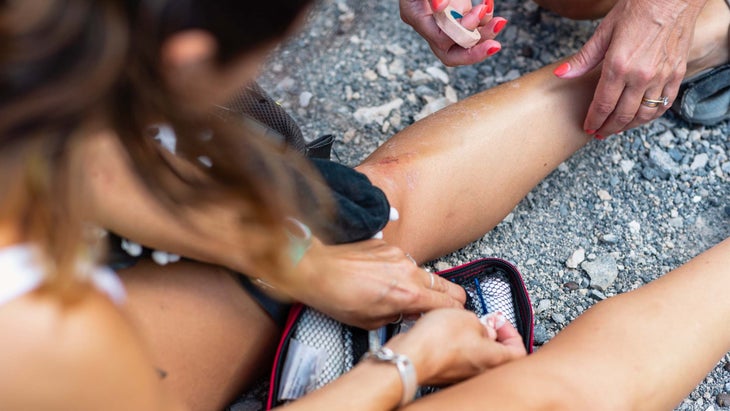
– First aid kit
– Knife or multitool
– Duct tape
– Waterproof matches/ firestarter
– Emergency shelter or space blanket
– Bear spray (in grizzly country)
Odds are you’ll never have to use the contents of your emergency equipment, but you never know when do-it-all duct tape or an extra ibuprofen will come in handy. You can easily buy a first aid kit that has everything you need (and more), or simply grab a waterproof bag and raid your own medicine cabinet or pharmacy for a low-cost alternative. Read more about building emergency kits here.
Popular on Backpacker
Related content from the outside network, what’s it like to go on a 200-person hike better than you think., how to pack for backcountry skiing, the original yosemite firefall, hiker charges mountain lion.
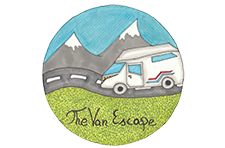
Day Hiking Packing List with Printable PDF Checklist
Check out this comprehensive Day Hiking Packing List with Printable PDF Checklist if you are wondering what gear you need to hit a trail. Whether you are an experienced hiker or are just starting, we have prepared the day hike essentials you should pack for every hike. It is our must-have list, the practical gear we use and can recommend. We love hiking, but we packed useless items at the beginning of our hiking adventures. Years ago, we had various adventures with the wrong equipment or the necessary gear missing. We have gained experience and knowledge, which we can now share with you. Please find below our Day Hiking Packing List containing all the essentials you should pack to keep you safe on the trail. Furthermore, we share plenty of tips on how to choose your perfect gear! Finally, you can print our Day Hiking Packing Checklist!
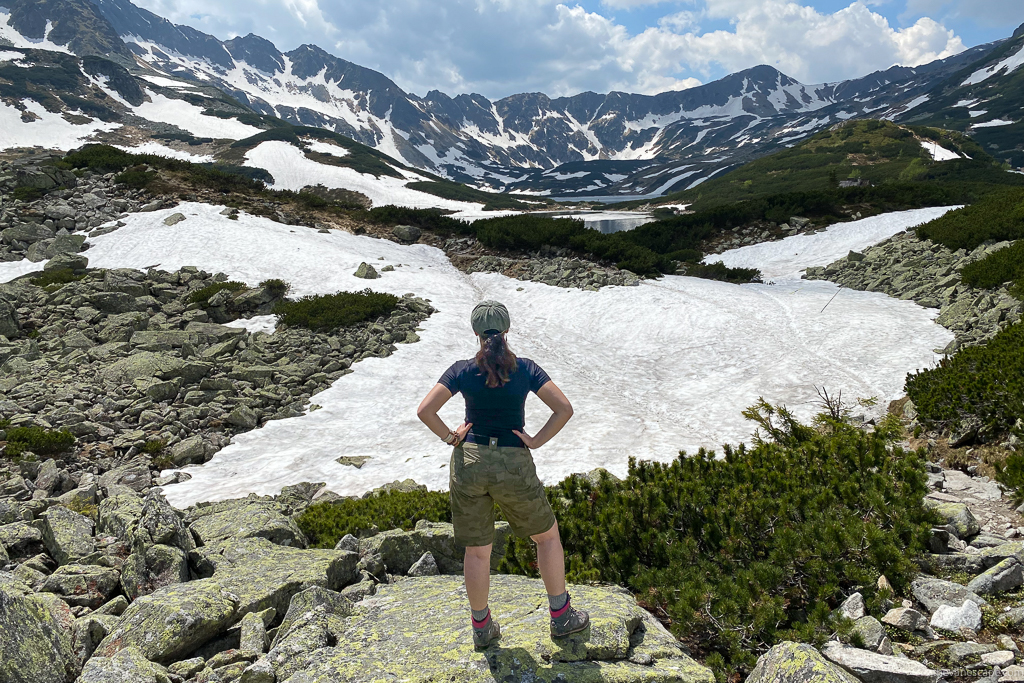
Day Hiking Packing List – Introduction
My partner Chri and I have wandered hundreds of miles of trails from Alaska to Florida, Central and South America, Asia, and Europe. We have also hiked wilderness areas where trails are not marked. We have hiked through snow, mountainous regions, deserts, and forests.
We love hiking and try to spend every free day actively. This list is the result of our many years of hiking experience. In this article, we share our Day-Hiking Packing List.
Moreover, we share plenty of tips on how to choose your perfect hiking gear. What features to pay attention to before buying equipment? So, you will find below a few chapters about hiking gear essentials. The sections are Daypack , Hiking Gear & Tools , Clothing & Footwear , Navigation & GPS Devices , Emergency & First Aid , Food & Water , Health & Hygiene , Personal Items , Day Hiking Extras.

We present a Day Hiking Packing List of gear that we use and like. All this stuff has worked or works excellently on our hikes. We like it and recommend it. Finally, you can print our Day Hiking Packing Checklist!
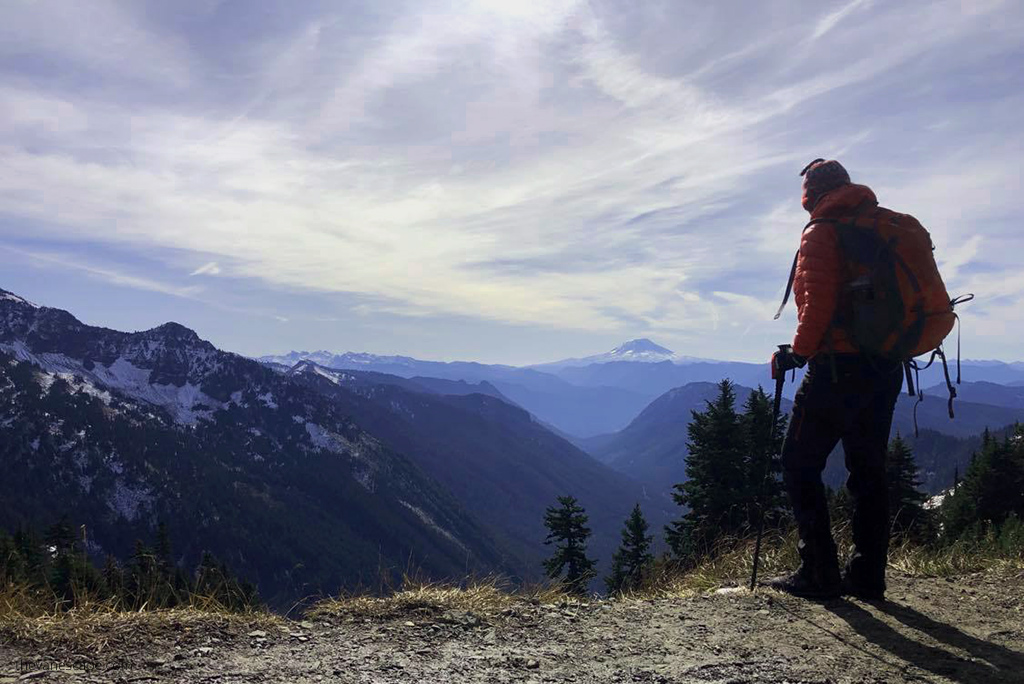
Day Hiking Packing List – Daypack for Your Hiking Adventure
How to choose a perfect daypack.
First of all, a proper backpack is an essential gear for day hiking. It must be your perfect hiking companion. So, how to choose a perfect daypack?
Before you buy a daypack, consider these four things:
- Activity : How are you going to use your daypack? Only for a short few hours and easy hikes? Or maybe longer all-day trails with moderate/challenging levels?
- Capacity : Do you need extra clothes because of the weather changes, or do you want to pack your camera and lenses? The size of the backpack depends on how much gear you plan to carry.
- Fit : Your torso length and hip size are relevant factors, so check the size before you buy your daypack.
- Features : Things like frame type, belts, number of pockets and compartments, and backpack access affect how the daypack works. How easy it is to find an item when you need it.
The backpack has to be lightweight, sturdy, waterproof, or with a cover, you can put on in case of rain. It should have a lap belt to protect your spine. It’s great to open it from the top and bottom to reach any item you need easily. It is important to keep the weight down as much as possible, so try not to go for a backpack with a capacity of more than 30-40 liters for women or 40-50 for men.
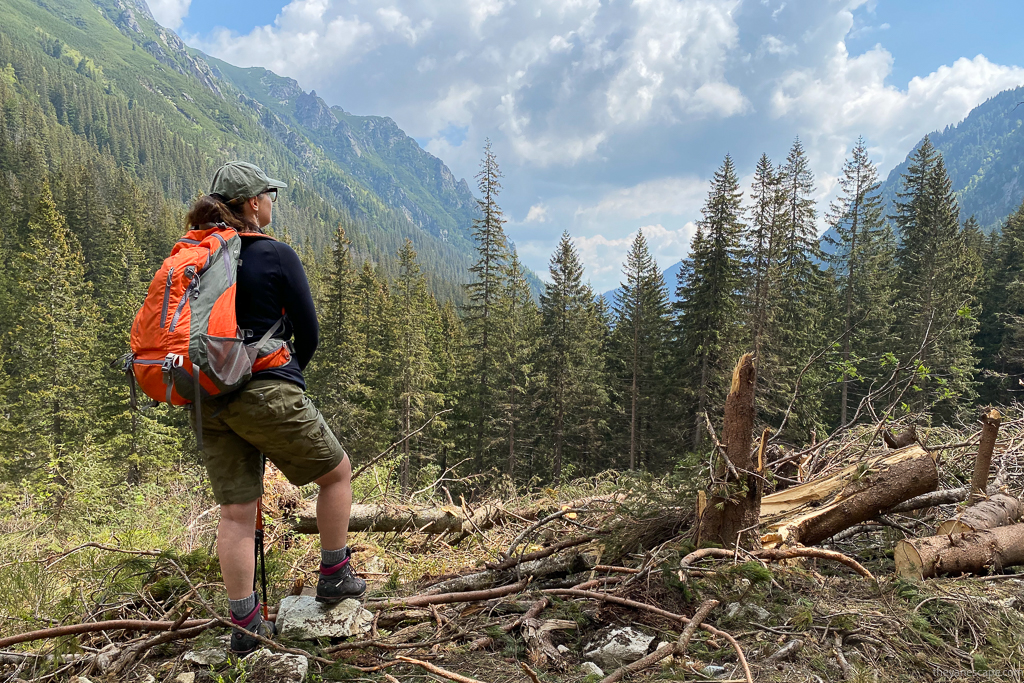
Daypack for a short & easy day hike
For short few miles & easy trails with predictable weather conditions, 20-30 liters daypack should be enough.
Day Hiking Packing List – Daypack For Women
Agnes likes Osprey Sirrus 24 Women’s Hiking Backpack because it has a Stow-On-The-Go Trekking pole attachment allowing you to attach and carry trekking poles while wearing the pack quickly. Moreover, it has an internal hydration sleeve accommodating up to a 3L reservoir.
Day Hiking Packing List – Daypack For Man
Chris uses Deuter Freerider Pro 28 , an ultralight that lets you go faster and farther. It has ample cargo room and is very comfy. The construction just fits very well with your build. Great venting.
Best Daypack For All-Day Hike
But most of our hikes are longer, and we also carry photo gear, so we usually use a bigger daypack. If your hike is longer than 3-4 hours go and back; you need food, more water, additional clothing, or gear; consider a bigger daypack of 30-45 liters. You need a very comfortable and high-capacity backpack for your day trips.
It is crucial to your daypack to have a lap belt that relieves your spine. We love our Osprey backpacks . So, here are our favorite men ‘s and women ‘s backpacks that we use.
Best Daypack For Women
Agnes likes Tempest 40 Women’s Hiking Backpack . 40L of capacity is perfect for committing day hikes or even lightweight multi-day trips. It has a comfortable wrap hip belt, which gives an incredibly stable carry system. It is also more breathable. Agnes loves the Stow-on-the-Go trekking pole carry system, which is useful during climbing when you need free hands. It has an external hydration sleeve that accommodates up to a 3L reservoir, which is a great solution.
Best Daypack For Man
Chris uses Stratos 36 Hiking Backpack , a ventilated, featured, and durable backpack for one-day hiking. Smartly organized pocketing keeps all your equipment where you need it when you need it. It has a Stow-on-the-Go trekking pole attachment and an internal hydration sleeve. Ample size for coats, food, drinks, and a camera. It has excellent quality.
Daypack Budget Option
We know that these Ospreys or Deuters are not cheap backpacks, but they are the best. So, if you are looking for something more affordable and still good quality , we can highly recommend this Waterproof Hiking Backpack .
Agnes uses it and likes it because it is ultralight, tear-resistant, and waterproof. It has padded shoulder straps, an adjustable sternum strap, and a rain cover. It is very comfortable and great for all-day hiking. Its 45L capacity makes it perfect for even a few days’ trips.
Day Hiking Packing List – Hiking Gear & Tools
Trekking poles.
There are many advantages to using trekking poles . Above all, the poles used for hiking need to be smoothly regulated. Trekking poles relieve the joints and the spine. When walking, especially in rough terrain or in the mountains, the body is exposed to heavy loads, the effects of which can be minimized by using poles. With trekking poles, you can gain more control when going down and soften the momentum of descent. You can also partially transfer loads to the upper body.
Using trekking poles allows you to correct your posture. When using trekking poles, you often feel less tired. Trekking sticks help keep balance in places that are difficult to cross. Thanks to them, you can reduce the risk of falling on unstable surfaces. So, trekking poles are a must on our Day Hiking Packing List.
One of our favorite models is Foxelli Carbon Fiber Trekking Poles . We have used them for years. They are great value for money. They’re made of sturdy material, so you can use them and scratch them without worrying they’ll break. Furthermore, they are lightweight enough. They are easy to unfold and fold. Finally, the grip is perfect because it is less sweaty. The newest poles Agnes bought last year are Black Dimond . They are sensational but more expensive. So if you haven’t used the hiking poles yet and want to see if it’s a good solution, consider buying the trekking poles mentioned earlier.
Headlamp or Flashlight
A strong headlamp or flashlight with extra batteries is also a must-have item for every hike. Even on short trails, we take a small flashlight. Remember that a flashlight can be used to call for help, so it’s a tool for emergency use. Years ago, we lost a trail during our hike. It was getting dark immediately after sunset. Thanks to our headlamps, we found the proper path. So, we always pack headlamps and an extra set of batteries , because you never know when they will need replacing.
We use these model of PETZL – TACTIKKA Headlamp . The lamp is bright, simple to use, and has a thick and comfortable headband.
Multi-tool or Knife & Repair Kit
We use these Pocket Knife with Multitool , which is ideal for outdoor activities like camping and hiking. It has great Swiss army-quality stainless steel. We like it because it is a compact multitool with essential implements that maximize usefulness while keeping bulk to a minimum. It’s essential for gear repair, food preparation, and first-aid. You never know if you might need a knife in an emergency. All of the tools are easy to open and close. The scissors are very sharp.
Day Hiking Packing List – Navigation & GPS Devices
Navigation is essential for your safety during your hike. So, we present our must-have.
Map & Trail Description
We always pack a paper map for our hikes. And we use paper maps. Of course, we use phone applications as well. Our favorite app is AllTrails . But electronic devices can fail, especially on rough terrain where there is no coverage or batteries on your smartphone can run out. The map helps you find a proper trail, especially when the trail split off in different directions.
So, the paper map is always on our Day Hiking Packing Checklist. Our Favorite Hiking Maps are National Geographic Trails Illustrated Maps .
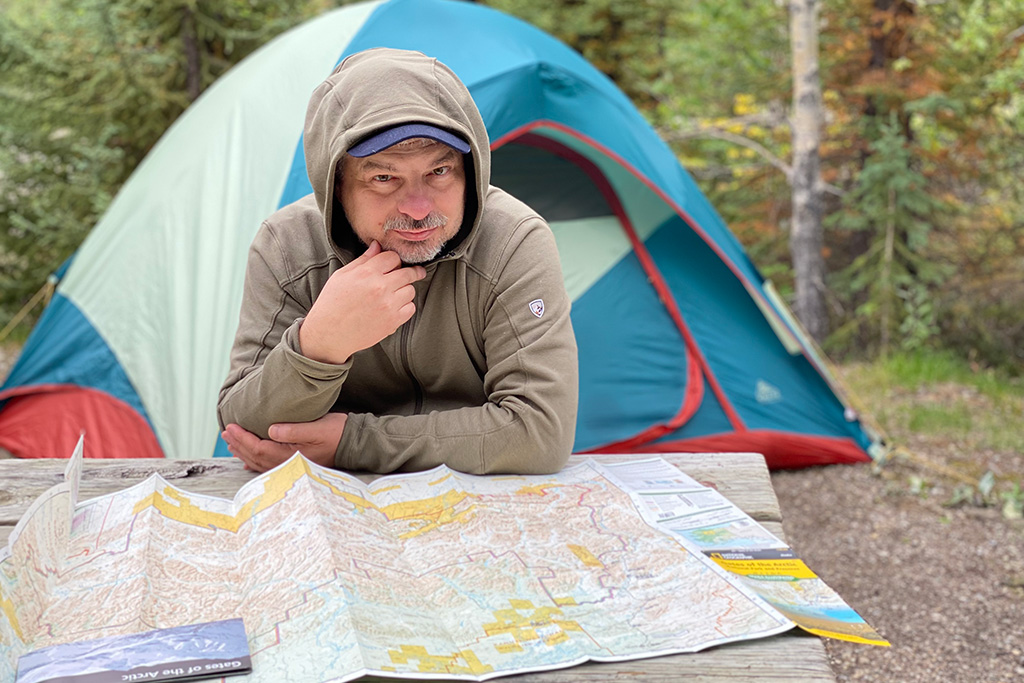
Outdoor Watch with GPS
If you love hiking and great outdoor adventures, you need a reliable GPS watch. It is helpful for everyday activities and in measuring your every sporting activity. A good GPS watch offers top navigation features and a long battery life, making it suitable for multi-day adventures.
It helps you enjoy your adventures, but most of all, it is a great safety tool, which enables you to find the right way. Outdoor watches can measure the altitude and speed of your hike, offer GPS guidance on walks or runs, and track your trips with long battery life. We love Garmin & Suunto outdoor watches.
Chris uses Garmin Instinct GPS Watch which has navigation, uploading of GPX routes, elevation data, storm alerts, and TrackBack (for following waypoints back to your starting location). There’s a heart rate monitor on board, and much more.
Agnes uses Suunto 7 GPS Watch , which fits her perfectly. It works great during hiking and everyday activities. Suunto 7 doesn’t only track your sports but your daily activity, stress levels, and sleep quality as well. It offers 60 customizable sports modes, so you can get relevant statistics regardless of your sport.
Small Basic Hiking Navigation Compass is a must just in case all devices fail. We use GPS devices, which have excellent quality, but the simple small compass is always in our backpack .
We use the Silva Ranger Compass , which is great for our adventures. This compass features a detachable distance lanyard as well as a sighting mirror so you can stay on track. The Ranger 2.0 Compass also has a magnifier for greater detail when reading your map. Luminous markings enable nighttime navigation. If you are looking for something more affordable we recommend this simple Costin Compass.
Day Hiking Packing List – Optional Devices
We use these devices only as an option when we go into a more difficult, inaccessible area, a wilderness area, where there are no marked routes and where there is no phone reception. It’s not in our backpacks during regular hikes, where trails are well-marked.
These devices have been very useful for us during Alaska road trips, several times on the more difficult trails in Utah , the Wave hike , and in New Mexico when we went to the Bisti Badlands . So, we recommend them only for more challenging terrain.
Handheld GPS
GPS devices are very useful for safety, and we like to use them. For us, it is an essential gear in more remote areas.
When we lost in the wilderness area without a marked trail, our Garmin GPSMAP 64st navigated us and helped to find our way back . You don’t want to stay overnight in the middle of nowhere, on the rough terrain. Getting lost might be very dangerous for your safety. GPSMAP 64st includes a 3-axis electronic compass with a barometric altimeter, wireless connectivity, and preloaded TOPO U.S. 100K maps. It is helpful during hiking and quite intuitive and straightforward to use.
We also had the opportunity to check the Garmin Oregon 700 Handheld GPS in the field. And it is also fantastic piece of technology. It’s very functional but learning how to use it presents a small challenge.
But, if you can afford it, please consider Garmin in Reach Explorer+ with Satellite Communicator . If you love challenging/strenuous trails, hiking in the wilderness area without marked trails, or you are a solo hiker, it is a perfect solution to have an SOS satellite search and rescue communicator. It is an extremely useful device that can save your life.
Personal Locator Beacon
Personal locator beacons (PLBs) are a satellite-synced device that sends an SOS signal to rescue agencies, along with your location. It works in remote areas worldwide and has multi-year battery life. It has a more reliable signal than a satellite messenger (unobstructed view of the sky works best). There are no subscription fees and no ability to send messages home or cancel an SOS call. PLBs must be registered. This device should be considered most of all by solo hikers who love challenging trails in remote, wilderness areas.
Satellite messengers
Satellite messengers are similar to PLBs in that they also allow you to send SOS distress signals from remote areas where there is no cellphone coverage. Most important are additional features like the ability to exchange texts from home and to do GPS navigation.
Day Hiking Packing List – Emergency & First Aid Kit
First aid kit.
Don’t forget the First Aid Kit for your hike. We always have a First Aid Kit in case of an accident. So, it is a must-have on hiking trails.
We like this set because it is compact, light, waterproof, and contains everything necessary. What’s inside the kit? This set includes shears, a polyester bag, adhesive bandages with different shapes, cotton gauze swabs, cotton swabs CPR Pouch with instructions, Crepe Bandage, an emergency blanket, hypoallergenic tape, nitrile gloves, safety pins, splinter probes, strip wound closures, First Aid Guide, tweezer, whistle, and more. So, it is perfect for an adventure. A First Aid Kit is a must-have even for a short & easy hike.
A safety whistle is also essential in your daypack. Our First Aid Kit set has it. If your set doesn’t include a whistle, you should buy it. It is small and light. You can attach it to a backpack, and it will not take up space. Sometimes, there is no coverage. So, the only way to be found is to be heard. The loud, crisp sound of the safety whistle help find your location in case of an accident.
Day Hiking Packing List – Optional Emergency Gear
For hikes all-day long way, we always pack Fire Starter & Emergency Shelter. Just in case. In case we lose the trail and have to come back at night, in case of sudden weather breakdown. They take up little space and are light.
Fire Starter & Lighter
A firestarter & waterproof lighter is also essential just in case of emergencies. If you lost your trail and have to spend the night in the middle of the wilderness or in the mountains, this small lightweight item might save you.
Emergency Shelter
A sudden weather breaking may prevent your hiking. It may also happen that the temperature drops a dozen degrees even during summer. Or darkness surprises you on the trail. That’s why you should have just in case an emergency shelter and emergency blanket . We have these Life Tent Emergency Survival Shelter .
Day Hiking Packing List – Food & Water for Your Hike
Water and snacks are a must during a hike when you lose energy. Always take more water than you need just in case. Get yourself hydrated the day before the hike. What do we have on our Day Hiking Packing List?
Water Reservoir & Water Bottle
Here are our favorite water reservoirs, so that you can reduce your plastic waste. Agnes uses these HydraPak Water Bladder (3 liters) and Chris has Camelbak Reservoirs . They are perfect for hiking. Very high quality and well constructed. Watch your body while hiking. Even experienced hikers have weaker days.
If you start to feel dizzy, disoriented, or nauseated, take a rest. Drink water, eat a salty and high-protein snack, and rest as long as you feel better. If you are hot, drink more water and rest. The amount of water you carry on should depend on the length and intensity of your hike, your fit condition, sweat rate, season & weather conditions. So, if our hike is longer, and especially in summer, we carry on also a durable water bottle .
Hiking Snacks
You should pack snacks even for a short hike. For all-day hikes we always pack: energy bars , beef jerky , different nuts , energy gels or electrolytes . We take bananas, apples, or sandwiches. We prefer high protein & energy foods and drinks.
Don’t forget the waste bags , and don’t leave any trace behind . Even a banana peel must be taken. Their scent can lure wild animals, so you must pack all your rubbish.
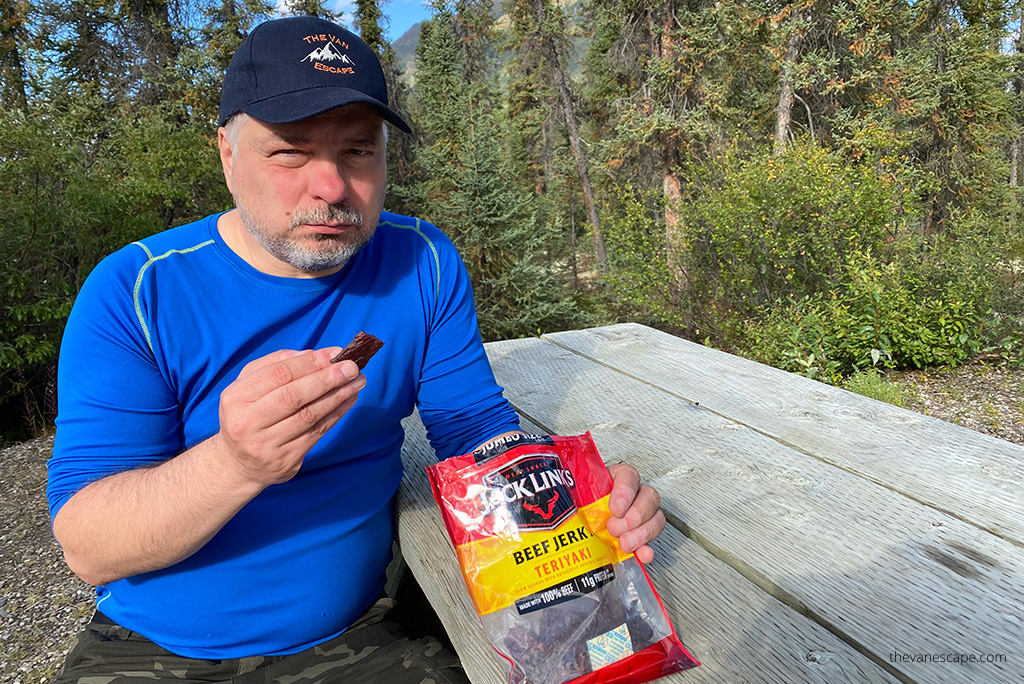
Day Hiking Packing List – Optional
Water filter.
Emergency Water Filter is optional. We take it for longer hikes, or when we hike in the remote/wilderness areas. And when we know that there are rivers or streams in a given area from which it will be possible to draw water.
Potable aqua tablets are light and makes questionable water bacteriologically suitable to drink within 35 minutes, so just in case we pack them.
Or you can pack a Survival Straw Water Filter which is a perfect solution. They use American Space Program NASA Technology: The material of the filter is made from Ahlstrom Disruptor adsorptive technology to ensure the water is free of impurities and safe to drink.
If you pack for your hike any dish, salad or yogurt don’t forget to pack a hiking spoon/fork .
Extra Supply of Food
For longer, strenuous hikes, where we use our energy faster and burn more calories, we pack additional food.
Day Hiking Packing List – Clothing & Footwear for Your Hike
This part of our Day Hiking Packing List is about clothing & hiking boots. Proper clothes and footwear are essential for your comfort and most of all for your safety during your hike. Even for a one-day hike pack some extra clothes. Wear layers. You have to be prepared for the sudden weather collapse or storm. If your hike is long, not marked, or in a remote area, you should pack warmer clothes just in case you have to spend an unplanned night on the trail.
Always check the forecast before your hike, and make sure to dress suitable for the weather conditions. Even if you are hiking during summer and it’s hot, remember that temperature differences can be over a dozen degrees.
Hiking Boots or Shoes
Your hiking boots should become your best friends. What kind of footwear wear is determined by the type of your hike, the terrain you are going to, and the season. If you are going to hike in mountain, desert, or rock areas on rugged trails, you need hiking boots or shoes with excellent traction. We choose shoes covering the ankle. In our opinion, hiking boots with excellent traction are essential in rocky and deserted terrain. Always protect the whole feet and ankles if in your hiking area is possible to occur rattlesnakes, spiders, scorpions, or ticks. So check our favorites from Day Hiking Packing List.
Our favorite hiking boots are Mammut , which we used it for over three years right now. We hiked in Mammut’s boots in the mountains in Europe, Argentina, Chile, Alaska, and also Arizona, Utah, New Mexico, and more. We love them. They provide exceptional support. We used them during all seasons. They managed in the rain, snow, and the scorching sun. So, we can higly reccomend them.
Agnes uses Mammut Boots DUCAN High GTX and they fit her perfectly. They are lightweight, direct, close-fitting, and close to the ground. Furthermore, they have a climbing zone that provides additional comfort, a precise fit, and safety.
Chris uses Mammut Men Trovat Advanced High Boot . They are great boots, very durable, super comfy with very good arch support. They worked great both in summer and in the snow.
To be honest, we have several pairs and shoes for several brands. Depending on the trip and terrain we choose the right one. We also have, and we also like La Sportiva boots , Keen boots , Merrell boots .
With short shoes, Chris likes these La Sportiva Men’s Akyra Mountain Shoe with great traction, impact, and downhill runner.
Agnes use these short KEEN Women’s Targhee . The shoes have good support and keep her feet warm and dry even when hiking in the rain. Very comfy.
Layers of clothing are an essential part of all our hiking gear. So before your hike, think about these types of layers. Depending on the time of year, weather conditions, and the area you are hiking in, you may need other items, which we present below on our day hiking packing list.
For a longer day hike, we add to our backpack an extra pair of socks. It’s essential to have a dry foot. Good moisture-wicking socks are a must-have during your hike. When during the trek it is possible to rain or to go through a stream, we pack Smartwool Socks . Or we pack socks just in case of sweaty during summer. This way, you prevent getting blisters or undercooling your feet.
Our choice is Wool Hiking Socks , which are incredibly soft and warm and have natural wicking and odor-resistant properties. As a result, keep you dry and comfortable while active in cold weather.
Moisture-wicking Underwear
First of all, you need high-quality and quick dry underwear, for the reason that it’s essential to feel comfortable during your hiking. So choose well your travel underwear. For Agnes’s best hiking, underwear, a sports bra, and a quick dry women’s outdoor bikini. Chris’ choice is breathable travel boxers. Breathable and moisture-wicking are the most important features. Our favorite underwear is made of ultra-light mesh fabric and thus they provide an ergonomic fit. The mesh fabric is smooth to the touch and extremely comfortable, which makes these underwear briefs offer superb durability and efficiently wick moisture away from the skin. Furthermore, due to the nylon and spandex fibers, they also dry very fast and offer good stretch.
Long Sleeve Thermal Base Layers
The weather is unpredictable. That’s why layered clothing will help you get ready for any conditions. Right thermal underwear is essential during hiking. We always wear a breathable base first upper layer . Its thickness depends on the season. We prefer lightweight long sleeve because it protects skin before the sun and before the bugs. So, the first upper layer you wear should be perfect.
Long Sleeve Top For Woman
For colder days , Agnes’ choice is Smartwool Women’s Base Layer Top – Merino , which is soft and warm and helps stay warm without overheating. The quality is perfect. For fall/winter, she always chooses a set with the highest weight (230-250gm) to protect against cold.
For hiking on warmer days she wears Woolly Clothing Co. Merino Wool , which is also the perfect top, which is no-odor, anti-microbial, fire-resistant, moisture-wicking. It is 150 Ultralight Weight Model, but in combination with an additional sweatshirt, it can also be worn on colder days.
Long Sleeve Top For Man
Chris’s choice for mountains hiking is Smartwool Men’s Base Layer Top with 1/4 Zip . which has a perfect quality. This heavier 250, soft, 100% Merino wool fabric offers breathable warmth, moves sweat away from the body, odor control, thermoregulation, and provides next-to-skin comfort in colder weather conditions .
The lighter top he uses is Smartwool Men’s Long Sleeve Shirt – Merino 150 . It is super light and of great quality. Really nice on the skin. It is the perfect choice for all of your spontaneous detours.
Second Upper Layer – Lightweight Fleece or Jacket
We always pack Upper Mid-Layer for our day hike. It is usually a light breathable jacket or fleece. What we pack always depends on the hike area and weather conditions. For us seccond upper layer is essential on our Day Hiking Packing List.
Agnes loves her The North Face Women’s Thermoball Eco Hoodie . It’s one of the best she ever had because it’s warm enough and comfortable. This jacket is excellent for everyday layering in chilly weather. It also has deep pockets for necessary gear as smartphone & the hidden inside pocket. Very warm and comfty. This jacket stows in the hand pocket, so it is great for keeping in your backpack. Finally, it is waterproof.
Chris’ choice is Mammut Men Aconcagua Light Midlayer-Jacket which is warm and great as a layer as well. It is the mid-layer you can rely on in the mountains. The lightweight, comfortable, and stretchable material with high breathability will help you conquer ascents and descents. The flat design of the seams makes it feel very comfortable to wear and avoids chafing under a backpack. A technical mid-layer placing top priority on a good performance.
Rain & Wind Upper Layer
Windproof and warm jacket in the mountains is a must-have. Windbreaker & Waterproof is ideal for backpacking and hiking. Packaging a raincoat or poncho is a good idea even if you don’t expect the rain.
Agnes loves Marmot Women’s Starfire Lightweight Waterproof Hooded Rain Jacket. It is lightweight, hooded women’s rain jacket is great for long travel days, tackling the tough mountain, and challenging hikes. Waterproof and breathable 3-layer NanoPro MemBrain fabric provides superior weather protection in moderate rain, snow, and wind.
Chris usually packs his Marmot Men’s Magus Lightweight Waterproof Rain Jacket . Which is a great-fitting, waterproof & breathable 2.5-layer NanoPro fabric with stretch for moderate rain, snow, and wind; taped seams ensure true waterproofing.
Third Upper Layer For Cold Weather (Optional)
It’s optional and depends on the weather and your hiking area. During winter, if it will be extra cold or huge temperature amplitudes are possible, or if you are going to the summit in the mountains, where it might be much colder, pack an extra warm jacket.
For women, Winter Warm Snow Coat is a great solution. This waterproof ski jacket is made from polyester, which is waterproof, windproof, durable, and stain repellent. It fits perfectly and is excellent for hiking and other outdoor activities. Special high-density fabric and coating, film composite process to obstruct the air intrusion effectively and works well on windproof. It provides enough warmth for outdoor life.
For men, we can recommend as heavier down jacket these Marmot Men’s Tullus Hoody Winter Puffer Jacket . Which is ideal for chilly, damp conditions when hiking or climbing. Moisture-resistant Down Defender treatment on 600 fill power down keeps you warm in wet conditions.
Hiking Pants and Hiking Shorts
We prefer light waterproof outdoor long trousers which are also windproof. It’s important to be breathable and quick drying. If it is cooler out, consider adding thermal wool under the layer as well . However, for summer hiking adventures we prefer hiking shorts.
Hiking Pants and Hiking Shorts For Women
Agnes loves KÜHL’s FREEFLEX™ ROLL-UP Women’s Pants , which are lightweight, durable, surprisingly quiet, and packable. What’s more, they are moisture-managing and quick-drying. Perfect for hiking. Breathable and quick-drying, keeping you cool and dry when hiking. Have excellent quality at a reasonable price. For summer hiking adventures her favorite hiking shorts are Women’s SPLASH™ 11 . Here you can check photos and review the best hiking shorts .
Hiking Pants and Hiking Shorts For Man
Chris likes K Ü HL Klash Pants , which are perfect for hiking and climbing. They have durable soft-shell fabric with a 2-tone weave, added abrasion resistance, and a durable water repellent (DWR) finish for year-round performance for a multitude of activities. For summer hiking activities his choice is KÜHL’s innovative venting system and a nine-pocket design, the AMBUSH™ Cargo Men’s Short .
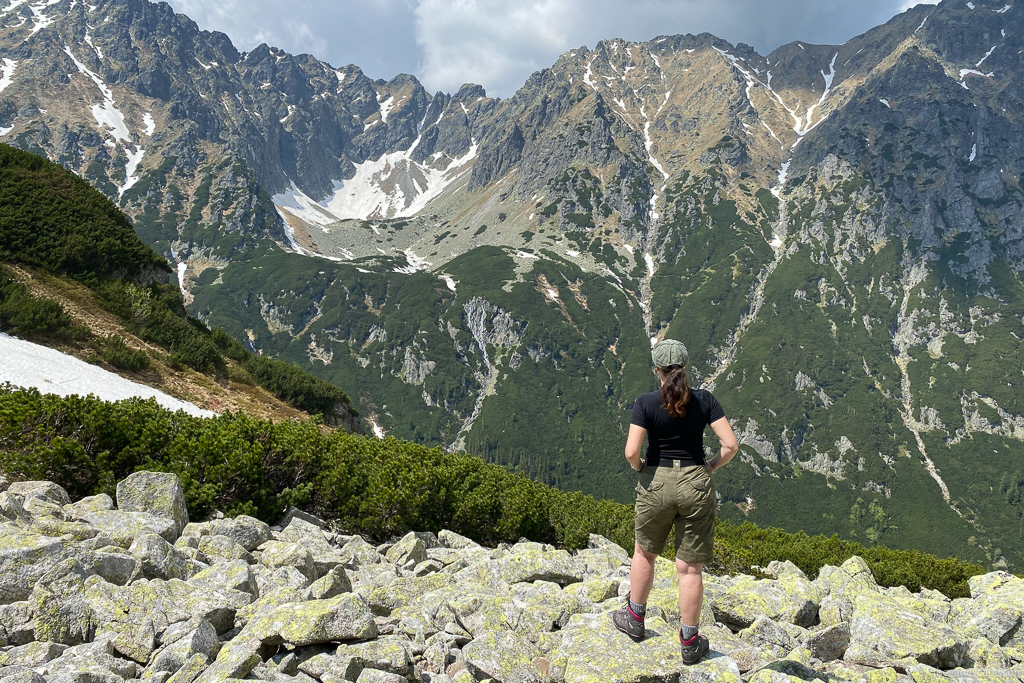
Beanie & Headbands or Hats
Depending on the weather, take a hat to protect the head against the sun. Don’t forget about your sunglasses , as well. Or a warm beanie & headbands to protect against the cold.
We use gloves not only during the winter. They are also helpful during hiking, especially when climbing in mountainous or rough deserted terrain. That’s why we always have gloves on our Day Hiking Packing List.
Extras For Cold Weather (Winter)
Head & foot warmers.
If you are planning a winter hike or trek in an area where it can get colder like the ascent to the peak, consider packing hand and foot warmers. It can save your life if you are surprised by a severe frost. Check our Yellowstone in winter photos and tips to see how cold it might be. We have already used these heaters several times in winter conditions. They turned out to be a great solution. So, pack a few pairs Hand Warmers , and Foot Warmers or Toe Foot Warmers .
If you expect snow on your trail, it is worth packing hiking crampons . It might be useful.
Day Hiking Packing List – Health & Hygiene During Your Hike
Hand sanitizer.
Taking care of hygiene is also essential during hiking, so a small hand sanitizer gel with alcohol must always be in our backpack.
Biodegradable Wet Wipes & Toilet Paper
We also always pack moisturizing/ wet wipes . Choose biodegradable ones. We use them for refreshing the face, wiping hands, for intimate hygiene, or for cleaning dirty surfaces (picnic tables). Small biodegradable toilet paper is always on our daypack.
Day Hiking Packing List – Optional Items
We do not pack the trowel for short routes, where there are rest areas with restrooms along the way. But for wandering remote areas and for longer hikes, we always pack small and light trowels. It is essential not to leave your trace. It’s also for your safety because your smell can attract wild animals.
Remember to protect your skin depending on the season and the place where you are hiking. Take a small sunscreen with you to avoid getting burned.
As above, it is worth protecting your lips before the sun and before frost. During physical exertion, the lips crack faster, so we wear lip balm at any time of the year.
Insect Repellent
We carry bug Spray/Lotion or Bug Wipes only if needed. It depends on the area of our hike and the season. During summer months or rainy, it might be a massive problem with insects, especially mosquitos & flies. We prefer wipes because they are easier to use. Check if your insect repellant contains DEET , which makes it more effective.
Menstrual Products
Don’t forget menstrual products , if you need them during a hike.
If you take any medications or have repetitive ailments like migraines, don’t forget to pack the right pills, which helps you.
Day Hiking Packing List – Personal Items
Id & emergency contact with itinerary.
ID is a must on your day hiking packing list. Don’t forget it. Furthermore, for your safety, you should have a note with the emergency contact number of the person to be notified of an accident that happened to you. You should also inform someone about your hiking plans, especially if you are hiking alone. So give someone your itinerary. Leaving your itinerary in the car (under the seat) with your contact and emergency contact numbers is also a great solution.
Credit Card/Cash
Take some cash or credit cards if you go on a trail where the fee must be paid. If you are going to the national park, don’t forget your annual pass.
Cellphone & Power Bank
Don’t forget your cellphone and power bank . Yes, you need it. Very often, there is no coverage on the trails. The phone trying to find a connection will discharge faster. Also, when using the app or taking pictures, the battery runs out quicker. So, a power bank is always on our day hiking packing list.
Travel Insurance
Travel Insurance is the basis of the journey. No matter if you are going on a one-day hike or longer backpacking hiking, take the insurance. No matter if you are going on an organized luxury vacation or a road trip, remember about insurance. It’s crucial to travel & hiking safely.
If your trip requires additional permits – don’t forget to take/print your permission.
Day Hiking Packing List Extras
What else you pack for the hike depends on your needs and for the type of your trek. These optional extra items on your Day Hiking Packing List might be:
DJI Osmo Pocket Camera or Go Pro
Chris was not a big fan of videos until he got DJI Osmo pocket to his hands. This camera is so small and so flexible that you can record great youtube videos only with this. And it is 4K. After using it for a couple of weeks, we have fallen in love and decided that we don’t need anything else. DJI Osmo Pocket is enough for most of the tasks on the road trip, perfect during our hikes. And we decided to share our experience with you in this short DJI Osmo Pocket Review .
Bear Spray or Bear Bells
If you are planning a trip to bears areas, like Alaska, Wyoming, or Canada, you have to be aware that you can see bears. And it is essential that this meeting is safe for both sides. So, just in case take bear spray or bear bells.
Rain Pack Cover
If your backpack is not waterproof or does not have a cover, be sure to pack Rain Pack Cover .
We love to rock in the hammock and read books. That’s why if our hike leads through a wooded area and is not very long and tough, we often take these light hammock . It is wonderful to rest in it during the hike.
Book or Kindle
If your hike is not too long and too strenuous and you have time for a more extended rest, you can always take your favorite book or Kindle to read and relax.
Plan a Trip and Don’t Know What to Pack? Check also our related articles and gear reviews
- Havasupai Packing List
- Road Trip Packing List Essentials
- KUHL SPLASH 11″ Hiking Shorts for Women – Review
- KUHL KULTIVATR Women’s Shorts Review
- How to Choose the Best Backpacking Hammock?
- KUHL Flight Jacket Review
- KUHL ENGINEERED Women’s Hoody Review
- How To Choose and Use Trekking Poles?
- KUHL SILENCR ROGUE KARGO PANT REVIEW
- KUHL SPEKTER Full Zip Hoody Review
- How to plan a road trip?
- KUHL PRISM Hoody Review
- KUHL AMBUSH Cargo Shorts Review
- Car Camping Checklist with Printable PDF
- KUHL FREEFLEX ROLL-UP Pants Review
- The Best Camping Gift Ideas Guide

Agnes Stabinska is a writer, photographer, and co-founder of The Van Escape. She loves wildlife, landscape photography, and outdoor adventures, especially hiking, camping, and exploring U.S. national parks. Although she has traveled to many countries for almost 20 years, her favorite places are Alaska, the American Southwest, and the Pacific Northwest, which she often visits and explore with her partner, Chris. Their travel tips, itineraries, and recommendations will help you get away from it all and plan a wonderful vacation.
19 Comments
Good to use a packing list even for day hiking to make sure that nothing gets left behind. We try to remember that accidents and emergencies can happen. And a little preparation may make all the difference. We recently bought hiking poles and I must admit they were the best purchase we made all year! A great way to let me have stability and move much faster. A GPS watch or portable devices is a great thing for directionally challenged people like my hubby! We have also toyed with the idea of personal locator beacons. Not so much for hiking but for scuba diving! Too many “left at sea” scuba stories! I will use you list to check against the one we use. Thanks!
Thanks for putting together such a thorough guide. Like you, we also used to pack way too many things that we never used. We started buying specialty light-weight items, but even then we still packed too much. I list like this is super helpful for newbie hikers. I also love that you mentioned Osprey packs. Those are definitely our go-to’s when it comes to hiking and backpacking.
This is an amazing list of brands required for outdoors. Thanks for the packing list too. This is super useful for me coz I always tend to forget things. Also, when I am out shopping or online doing so, I get so confused with the brands. This post is perfect to get the right recommendations. I love the various features of products that you have detailed , making it easier to look for substitute brands in my area.
I am starting to enjoy day hiking since I moved here in Australia. I discovered so many beautiful places that we can found just in the middle of the forest, and can’t be seen by Google Map. I agree on carrying first aid kit. Being prepared is always cool.
This is a great list for hikers. I’m still a newbie at it, so I’ve found even more useful things I need to bring!
This is a super comprehensive guide! I love it! There are so many thing here that I would totally forget if i were just to just pack and go! A first aid kit is such a must as you just never know when an accident might happen! I have been looking for some good quality hiking trousers too for a while so will definitely be checking the ones you suggested out! Thanks
This is soooo helpful. I am not really a good packer as I tend to bring a lot that my husband says it is no longer practical. Anyway, thank you for sharing this checklist. Bookmarking this post for future reference.
I am not a hiker type per se. However I can see that you put together a very comprehensive list. I like the idea of bio-degradable wet wipes or toilet paper. That is also useful on a road trip which I do frequently!
This is a neat and very helpful list. Honestly, I had never considered so many things about a backpack but yes the number of pockets is very relevant and yes it must be comfy to carry. I realized the importance of headlight once when I did river camping in Bhutan. Right hiking boots and safety or first aid is definitely essential. I dint know about the satellite messenger devices, thanks for that. I like the book reading advice. Its never a bad time to catch up on a book.
Although I have several day packs, I need to be better stocked on emergency usage items such as a First Aid Kit. I don’t do a lot of tough and long hikes but when I do once in a while, I have got to make sure I am well prepared! I love the hiking shoes you have recommended. Also, the idea of a life tent sounds pretty cool, and its so compact and easy to carry!
These are awesome tips! I never would’ve guessed there was so much gear involved in hiking, but I supposed for long-haul treks it would be necessary! Great list – I’ve also been one to overpack items I never used before. I’m looking at taking up more hiking in the next year or so closer to home, so this is really helpful!
I ALWAYS forget to take something when I go on a day hike (I am usually okay when going on longer hikes). This list is great. I never would have thought of bringing a whistle on a day hike, but since I often hike solo, it sure would be a good idea. Thanks for this!
This is a fantastic post. Everything that anyone would need is here which is super useful! I am not much of a hiker but I’d be keen to give it a go so thank you for the tips!
Great packing list! I have recently realized how important gloves are. On a hike during the summer, we found an area that was still covered in snow and it was so icy that it was impossible to go through. We had to take a detour, which also meant not going through the trail. After just a few moments, we found ourselves climbing over some rocks. Back then I did not have gloves with me, my hands were all covered in scratches after that. Since then I always make sure to have gloves with me! Thank you for sharing this list 🙂
This is the best and most comprehensive camping packing list I have ever seen! I can confirm that these Garmin Satellite devices and GPS watches are excellent and absolutely essential!
That’s a nice and detailed guide on packing. We often take it easy when packing for a hike. We always carry the first aid kid and insect repellent with us, no matter where we go. It comes so handy even when we had a scratch or a bite.
This is a nice comprehensive list of hiking essentials. My favorite thing that you mentioned is the waterproof/windproof pants. Mine have kept me dry and toasty when I’m hiking on my travels, and don’t have the option to reschedule just because of rain. One thing I do need to get is a GPS watch, so thanks for the recommendations.
Wow, what a beautiful and a thorough packing list for hiking. It is important to have a comprehensive list such as this so nothing is forgotten. You have included some great recommendations here as well, which makes this a perfect list.
Glad to see lip balm on the list .. but I’d also have to add hand cream. I hate having dry lips or hands, and when you’re hiking, both seem to get really dry. My favorite brand is Body Shop .. they do a Hemp one for both, and it sinks in without being greasy. They also do the hand cream in a small tube, so ideal for a day pack.
Leave a Reply Cancel reply
Your email address will not be published. Required fields are marked *
Privacy Overview
- It's Time To Get Your Hike On

5 Day Hiking Pack List: What To Take and What To Leave Behind
Here is your 5 day hiking pack list. Packing for a five-day trek is like piecing together a complex puzzle; each item must be essential and fit perfectly in your backpack.
Key Takeaways
- Choose a robust daypack or hydration pack and prioritize safety and comfort in gear selection.
- Pack high-energy foods, water filter or purification tablets, and aim for one liter of water per hour of hiking.
- Wear lightweight and moisture-wicking clothing, sturdy hiking boots with ankle support, and carry navigation and communication devices.
- Carry a well-stocked first aid kit, essential medications, sunscreen, insect repellent, and emergency blanket for safety and comfort during the hike.

You’ve likely heard the stories of those who’ve ventured into the wilderness unprepared, only to find themselves burdened by excess or longing for a forgotten tool at a critical moment. To help you avoid such pitfalls, we’ve compiled a comprehensive pack list that balances utility with weight, ensuring you’re equipped for whatever the trail may present.
From selecting the right gear that will stand up to the rigors of the backcountry to choosing layers that will keep you comfortable through changing climates, each recommendation is tailored to enhance your journey.
Stay tuned to uncover the intricacies of this list, which might just become the blueprint for your most successful adventure yet.
In This Article
Essential Gear and Equipment
Packing for a day hike requires both attention to detail and an understanding of the essentials. The gear you choose is your lifeline in the wilderness, providing safety and comfort as you explore. Start by choosing a daypack or hydration pack. It should be robust yet not overly burdensome, offering ample space for all your necessities.
Within your pack, the Ten Essentials are paramount. A map and compass act as your navigational anchors, steering you through unfamiliar paths. In the event of an emergency, a lightweight shelter serves as a critical barrier from the elements. It’s also wise to carry extra clothing. The weather can shift unexpectedly, more so in remote areas.
Food and water are non-negotiable. They fuel your journey, ensuring you have the energy and hydration needed for the day’s challenges. However, keep pack weight in mind. Overpacking can transform an enjoyable hike into a strenuous ordeal. Choose high-energy foods and consider a water filter or purification tablets to reduce weight.
Clothing and Layering
When you’re gearing up for a hike, remember that clothing is your first line of defense against nature’s unpredictability. The right layers can be the difference between reveling in your outdoor adventure and being at the mercy of the elements. Dressing smartly is key to unlocking the full experience of the wilderness.
Begin with a base layer that keeps your skin dry by wicking away sweat. It’s the foundation of temperature regulation. Over that, wear a long-sleeve shirt that breathes and wards off the sun’s rays and insect bites. Cap it with a fleece or jacket, providing the warmth you need.
Be mindful of the weather’s fickle nature. A clear sky can cloud over with the threat of rain, and temperatures can plummet without warning. Stay ahead of the game by packing an extra layer or two and choosing hiking shoes that can tackle diverse terrain.
Imagine your clothing as a team, each layer with a specific role but all working together:
- The base layer is like the goalkeeper, preventing moisture from getting too close to your skin.
- The middle layer, akin to a defender, guards your body heat.
- The outer layer acts as the forward, facing the external conditions head-on.
- The extra items are your substitutes, ready to step in when conditions demand it.
- And your shoes, much like a trusted midfielder, provide support and stability, no matter where you tread.
Food and Hydration
On any hiking adventure, it’s essential to maintain your energy and hydration. Always pack plenty of snacks and water. When you prepare for a day hike with the right sustenance and drinks, you’re setting yourself up to tackle the trails with energy and health. Remember, your freedom to explore nature is built on good preparation.
Consider this list as your guide to fueling up:
- Water : Aim for roughly one liter for every hour you hike. Whether you prefer a water bottle or a hydration reservoir, make sure you can carry and access your water easily.
- Snacks like energy bars : These are ideal for a quick energy boost. They’re light, nutrient-dense, and perfect for when your stamina starts to wane.
- Trail mix or nuts : Opt for these snacks for lasting energy. They’re convenient for eating while moving.
- Lunch (optional for longer treks) : Should your hike extend beyond a few hours, pack a lunch. Choose something simple but filling to enjoy surrounded by the beauty of the outdoors.
Stay proactive with your hydration by drinking water before you feel thirsty. Keeping hydrated is crucial for maintaining your rhythm and enjoying your hike. While the spirit of adventure may lead you, rely on your provisions to stay energized and hydrated.

- Humans can live 3 days without water but 1 gallon (the recommended daily water intake) weighs over 8lbs. When you are on the move, chances are you’ll be able to find water somewhere, just not the kind you can drink safely.
- Our filters weigh only 2oz and measure 8 inches long, so you can take it with you anywhere. Be prepared when camping, hiking, enjoying the outdoors, or when facing stressful situations such as natural disasters, national supply chain issues, accidents, or just about anything.

- Extra-Large Capacity: After the survey, 6L capacity is the most appropriate solution for group water needs. Our water filter camping can provide you with enough reliable sources of pure drinking water at any time and anywhere
- 4-Stage Filtration: Our camping water filter is made up of 0.1-micron hollow fiber ultrafiltration membrane, coconut shell GAC filter, and double PP fiber filter. Removes minimum 99.9999% of Escherichia coli, Cryptosporidium Parvum, Giardia lamblig, S. enterica Serovar typhimurium, odor, iodine, chlorine, heavy metals, filters up to 5,000 liters outdoors water
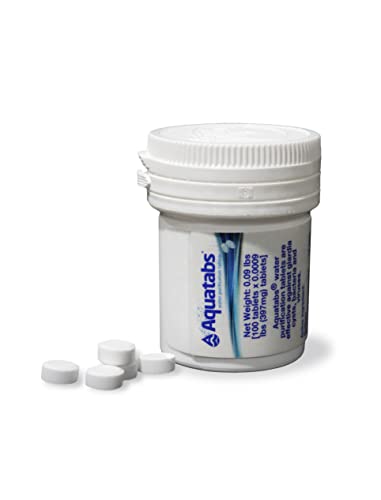
- DRINKING WATER, ANYTIME, ANYWHERE – Aquatabs are the world’s most popular tablet and the ultimate choice for portable water treatment tablets. Removes 99.9999% of Bacteria, 99.99% of Viruses, and 99.9% of Cysts (Giardia).
- FEEL SAFE OUT THERE – Aquatabs are an excellent solution for purifying water while camping, RVing, or in emergency survival situations. Simply add one 397mg Aquatabs tablet to 4 gallons of water and wait 30 minutes.
As you walk, let the quiet whispers of the wilderness remind you of stories from cultures near and far that revere nature’s majesty. Though the journey is your own, the echoes of countless footsteps along these trails are a subtle reminder that you’re part of a greater narrative. Keep your communication with nature open, your steps light, and your pack full of life’s essentials.
Navigation and Communication
After stocking up on necessary provisions such as food and water, the next step is to ensure that you can confidently navigate the terrain and maintain communication for safety purposes. The freedom you experience in the vastness of nature is contingent on your capacity to pinpoint your location and reach out when needed, particularly when you’re a small presence in the expansive wilderness. Your backpack should be equipped with the Ten Essentials, with particular attention paid to tools for navigation and communication.
Before embarking on your journey, it’s crucial to check the weather forecast and gear up accordingly. Tailor your plans to the expected weather, the length of your trip, and the distance you’ll be from assistance. Ensure all your devices are fully charged, and consider carrying an additional power source for emergencies.
Here is a concise inventory of items that should form your navigation and communication arsenal:
In terms of navigation, carry a map and compass as your primary tools. A GPS device or smartphone app can serve as a digital guide, while an altimeter watch can provide valuable information about elevation. Keep a route description or guidebook handy as it acts like a silent storyteller of the paths you’ll tread.
For communication, a satellite messenger or personal locator beacon could become your lifeline. A fully charged phone, with emergency numbers saved, is indispensable. Don’t forget a backup power source—either extra batteries or a solar charger—to ensure your devices remain operational.

- Don’t have cell coverage or battery dies on your smartphone when you are out hiking, backpacking, or hunting? The Bushnell BackTrack Mini GPS will help you get back to your basecamp or trailhead.
- The Bushnell Backtrack Mini uses GPS technology to capture your trip or waypoint so you can guide back to your starting position. Battery lasts up to 35 hours. Rugged and waterproof to handle anything you put the Bushnell BackTrack Mini GPS through

- Small, rugged, lightweight satellite communicator enables 2 way text messaging using the 100 percentage global Iridium network (satellite subscription required).Special Feature:Bluetooth.
- Trigger an interactive SOS to the 24/7 search and rescue monitoring center (satellite subscription required). Display size-0.9 x 0.9 inch

- Once activated, an SOS distress signal with GPS position is sent direct to Search and Rescue forces worldwide using the 406 MHz Emergency Distress Signal with 121.5 MHz Homing Signal (No Subscription Required)
- Small, rugged, lightweight personal locator beacon that is buoyant and includes attachment clips including a belt clip, oral inflation tube clip, straps and lanyards for increased wearability for hikers, boaters, campers, climbers, RVing and all your outdoor adventures
As you prepare, remember that the beauty of the outdoors isn’t just in the landscape but also in the preparation and self-reliance that comes with it. Your journey, much like navigating the chapters of a book, will be shaped by the tools and knowledge you carry with you.
Health and Safety Supplies
When venturing into the wilderness, your health and safety are paramount. To ensure peace of mind, a well-stocked first aid kit is indispensable. It should include medical tape, gauze, and antibiotic ointment for treating wounds, plus moleskin for blisters. These are the tools that stand between a minor setback and a trip-ending injury.
In your arsenal, essential medications are a must. Ibuprofen manages pain, while Benadryl counters unexpected allergic reactions. These pills are small but mighty allies against discomfort and danger.
Moreover, securing clean drinking water is critical. Whether by straw filter or chemical tablets, purifying your water protects you from unseen threats lurking in even the clearest streams.
Finally, a communication device, like a satellite messenger, is your lifeline to civilization when cell service is a distant memory. It’s your modern-day smoke signal, ensuring that help is just a call away.
As you lace up your boots and feel the call of the untamed paths, remember that true freedom in adventure comes from being prepared. Carry these essentials, and the great outdoors becomes not just a landscape to conquer, but a story to live safely.
What’s Next?
You’re now as prepared as a scout with your 5-day hiking pack list in hand. With the right gear, layers, and nourishment, you’ll conquer trails like a pro.
Remember, your safety’s in the details—navigation tools and health supplies are your lifelines.
So, lace up your boots, hoist that pack, and step into the wild with confidence.
Adventure awaits, and you’re ready to meet it head-on, come rain or shine.
Wilderness Survival Skills Course
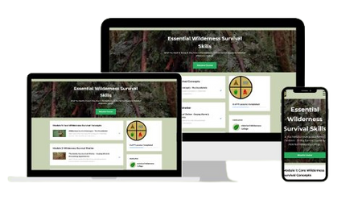
In this course, you’ll rediscover the lost knowledge our ancestors had and the key components to become self-sufficient in nature.
- If you like to go hiking , you’ll have the confidence to handle yourself if you get into a difficult situation.
- If you’re ever caught in an accident while travelling or a natural disaster, you’ll know what to do to survive.
- Or if you’re a survivalist who wants to know how to live completely off the land, you’ll have the skills to do so.
Discover how the wilderness has everything you need to not only survive… to thrive.
Douglas is an avid hiker, outdoorsman, and explorer. He and his wife, Michelle, currently live in Middle Tennessee.
We are participants in the Amazon Services LLC Associates Program, an affiliate advertising program designed to provide a means for sites to earn advertising fees by advertising and linking to Amazon.com

How To Pack For A Hike And The Best Hiking Gear List For You
H iking is like TLC for the soul. It’s fun, adventurous and adds a little bit of spark to our day-to-day lives . From hiking Kilimanjaro to Angel’s Landing to name a few, a hiker’s journey is a once-in-a-lifetime experience that is surely one for the books. If you’ve recently been eyeing a potential new hiking trip, chances are that you may be asking yourself “How do I pack for a hike?” and “What’s the best hiking gear out there so I don’t freeze to death?” While taking hiking trips on a whim is adventurous, knowing how to pack safely and efficiently while copping the best gear isn’t only important, but crucial for your safety. And though packing for a hike doesn’t need a Ph.D. in hikeogoly (yes, we made that one up), even the most experienced and seasoned hikers will warn you of common packing mishaps, which can make the experience not so fun. So, without further ado here’s a guide to help you pack for that upcoming packing trip and the best gear to help ensure a fun and enjoyable experience.
How to pack for a hiking trip
It’s easy to throw a few things in a bag and call it a day, however, hiking is a serious form of exploration that not only requires you to pack the right items, but to pack them efficiently. Here’s a list of how to pack for an upcoming trip, the right way.
Roll your clothes instead of folding
Rolling your clothes is a packer’s best friend when it comes to saving space. It can seriously help you to pack more essential items while making it easier to access clothes you may need on your hike. Start off by rolling any shirts, pants, and lightweight hiking jackets at the bottom of your pack and follow through with other essential clothing you may need such as rainjackets and layered clothes.
Place essential gear on top and not-so-essential gear on bottom
When packing for a hike, try to pack your backpack from bottom to top with the least important things at the bottom and the essentials on the top. Doing so will help you access the items you need with ease rather than having to take everything out and put everything back in multiple times. Dividing your pack into different categories such as food, water supply, jackets and clothes, and other tools needed like knives, first aid kits, and footwear, can make your journey easy and efficient.
Step 1: Pack your sleeping bag first
You always want your lightest gear at the bottom to help prevent backaches and spinal problems. You always want to put your sleeping bag at the bottom because it takes up less volume for less weight and you won’t necessarily need it until the end of your day.
Step 2: Pack your base layer clothing second
You won’t need your base layer clothing until nighttime anyways, so it’s better to pack this item at the bottom of your pack.
Step 3: Start packing your heavier items
Packing your heavier items in the middle will help to support your back a little bit more than if they were placed at the bottom. This includes food and a backpacking tent.
Step 4: Pack your lightest items at the top
Packing your lightest, most essential items at the top will prevent the hassle of having to look for them in your pack. This includes any tools, your main layer clothing, electronics, shoes, and toiletries.
Avoid overpacking
Many hikers sometimes have a tendency to overpack, which can make hiking with a backpack a lot harder. To help you along your packing process, start by separating the essentials from the non-essentials. This can help you better determine the items you need while weeding out the ones you do not. Keep in mind that you have to carry your backpack on possible mountains and steep hills, so it is crucial that your back remains intact.
What To Pack
Packing for a hike can bring on some potentially overwhelming emotions, which is why we’ve compiled a list of everything you should back below.
Some Good Old Hiking Boots
Although sneakers are great for support, supportive hiking boots are much better. REI , Palladium , and Merrell are great options for copping the best hiking boots.
Weather Appropriate Clothing
This is probably one of the most important things next to packing food and water. Although looking up the weather is great in advance of a hiking trip, you never know when things can get rainy, nippy, and out of sorts. Packing items such as a heat-insulated rain jacket and moisture-wicking layers can seriously help you stay ahead of harsh weather conditions.
Food For Thought And Of Course, Survival
Now this is a must for ensuring that you have the proper nutrition and energy you need. Regardless if a hike is only four to five hours, packing high-energy food and snacks is imperative for an enjoyable experience. This includes having tons of water as well so you stay hydrated during the course of the hike.
Navigation Tools
Navigation tools such as compasses, maps, and GPS locators are great for hiking. And though there’s a ton of mystery in seeing where a hike takes you, navigation is extremely important so that you don’t get lost.
First Aid Kit
We really can’t emphasize how important this one is. Having a first aid kit is imperative in the event of a hiking accident. We wouldn’t want to scrape our knee and have an infected cut now, would we?
Pocket Knife and Multi-Tool
There are many uses for a pocket knife and multi-tool that have helped hikers out of some scary life-or-death situations. It’s always important to remain safe rather than sorry.
The Best Hiking Gear For A Hike
There is a ton of gear out on the market that claims one thing but really does another. Before hiking a mountain or a trail, it’s important to put quality first, which is why we’ve compiled a list of the best hiking gear you need for that upcoming trip.
Best Hiking Jackets
Breathable, functional, and easy to pack.
Best Hiking Boots
Extremely supportive and will help you tackle some of the hardest hiking terrains.
Best Hiking Pants
Breathable and easy to move in.
Best Hiking Backpack
Stylish, supportive, and efficient.
Best Survival Kit
Perfect for any emergency.

- Newest Products
- Elite Series Cerakote Flashlights
- Tactical Pen Lights
- WF and WT Series
- Headlight Accessories
- Bike accessories
- CL Series Camp Lanterns
- Filters / Diffusers
- Pressure Switches
- Traffic Wands
- M-Lok Mounts & Accessories
- Accessory Compatibility Chart
- For your Keychain
- For your Pocket
- For your Pack or Glovebox
- Emergency Preparedness
- Law Enforcement and Security
- Weapon lights, mounts, switches
- Search and Rescue
- Mechanics and Construction
- Powerline and Utility Work
- Inspectors and Pest control
- Safety Rated Lights
- Camping and Hiking
- Trail Running
- Caving/Spelunking
- Hunting and Fishing
- Rechargeable
- With Red Light
- With Magnet
- Compact Lights (under 4")
- Small Lights (4"-6")
- Large Lights
- 21700 Battery
- 18650 Battery
- 16340 Battery
- CR123A Battery
- AAA Battery
- 100 to 299 Lumens
- 300 to 799 Lumens
- 800 to 1499 Lumens
- 1500 to 2999 Lumens
- 3000 to 9999 Lumens
- 10000 Plus Lumens
- Special Colors
- Bundles and BOGO
- Light and Battery Discounts
- instagram Instagram
- twitter Twitter

- Special Offers Deals and Discounts Special Colors Bundles and BOGO Light and Battery Discounts Open Box
The Complete Hiking Essentials Checklist for 2024
Key takeaways:.
- Comprehensive Preparation: Packing the right hiking essentials ensures both comfort and safety, allowing you to handle unexpected situations during your outdoor adventures.
- Essential Gear: Core items such as a durable backpack, appropriate footwear, layered clothing, and navigation tools are non-negotiable for any hiking trip.
- Illumination is Crucial: A reliable Fenix flashlight, such as the PD36R, and a headlamp are vital for safety and navigation in low-light conditions.
- Hydration and Nutrition: Always carry more water than you anticipate needing and pack high-energy, lightweight foods to maintain energy levels.
- Emergency Readiness: Equip your pack with a first aid kit, multi-tool, and emergency whistle to enhance your preparedness for any situation.
- Environmental Responsibility: Adhering to Leave No Trace principles helps protect the natural beauty and sustainability of outdoor environments.
Venturing into the great outdoors requires more than just a strong will and a good pair of boots. As the natural environment constantly evolves and as outdoor equipment technology advances, so does the list of hiking essentials. From the latest in durable gear to safety gadgets that can save lives, every item on your checklist plays a crucial role in ensuring a safe and enjoyable adventure. This comprehensive guide covers everything you need for hiking in 2024, including a must-have Fenix flashlight, which has become synonymous with reliability and high performance among outdoor enthusiasts.
Understanding the Importance of a Well-Prepared Hiking Pack
Preparation is key when it comes to hiking. Whether you're planning a short day trip or a multi-day expedition, the right gear can make all the difference. It’s not just about comfort; it’s about safety. A well-prepared hiking pack ensures that you are equipped to handle unexpected situations, from sudden weather changes to emergencies.
Core Hiking Gear: The Non-Negotiables
- Backpack: A durable, lightweight backpack with enough capacity for your trip is essential. Look for one with adjustable straps, good back support, and multiple compartments for easy organization.
- Appropriate Footwear: Depending on the terrain, choose between hiking boots or shoes that offer support, protection, and traction. If you're not sure, it's always better to plan for the more intensive option and wear boots, just in case!
- Clothing Layers: Pack breathable, moisture-wicking base layers, an insulating layer, and a waterproof outer layer. This layering system allows you to adjust to changing weather conditions.
- Navigation Tools: A GPS device, a physical map, and a compass are indispensable for keeping you on track. Learning to use a compass and a map might not be necessary in our day to day lives thanks to smartphones, but you'll definitely want to know how to if you get lost and your battery dies or you lose service!
- First Aid Kit: Customize your kit to include personal medications, bandages, antiseptic wipes, and other essentials. Consider taking a basic first aid course to be better prepared.
- Multi-tool: A good multi-tool can be invaluable for gear repair, food preparation, and emergency situations.
- Hydration System: Water bottles or a hydration bladder is crucial, and always carry more water than you think you'll need. Consider a portable water filter or purification tablets.
- Food and Snacks: High-energy, lightweight foods like nuts, dried fruits, and energy bars are ideal. Always pack extra in case of delays.
Illumination and Signaling Devices
- Fenix Flashlights: For 2024, the Fenix PD36R V2 rechargeable flashlight is a top pick for hikers. Its robust build, long battery life, and powerful beam make it an essential part of any hiking kit. Not only does it ensure safe night-time navigation, but it can also be used to signal for help in emergencies.
- Headlamp: A hands-free headlamp with extra batteries is also recommended, especially if you plan to hike around dawn or dusk.
- Emergency Whistle: A loud whistle can alert others if you are in distress, helping to locate you more quickly.

Shelter and Comfort
- Tent or Tarp: Depending on the length and nature of your hike, carry a lightweight tent or tarp for protection against elements. Even if you don't plan on an overnight trip, a tarp is still a good lightweight choice that can be used for an impromptu shelter if you get stranded for any reason.
- Sleeping Bag and Pad: A suitable sleeping bag for the climate and a pad for insulation from the ground will help you rest better.
- Fire Starting Gear: Waterproof matches, a lighter, and fire starters are important for warmth and cooking.
Sun Protection and Insect Defense
- Sunscreen and Lip Balm: SPF 30 or higher is vital for protecting skin and lips from UV rays.
- Sunglasses and Hat: Protect your eyes and face from the sun with UV-blocking sunglasses and a brimmed hat.
- Insect Repellent: A good repellent is crucial, especially in areas prone to disease-carrying mosquitoes and ticks.
Personal Items and Extras
- Toilet Supplies: Biodegradable soap, a small shovel, toilet paper, and hand sanitizer should be in every hiker’s pack.
- Camera or Smartphone: For capturing memories or in case of emergency, technology has its place on the trail. Ensure they are protected and kept in waterproof pouches.
- Powerbank or portable battery: To extend the battery life of your smartphone in emergencies. Fenix also offers a combination Flashlight/Powerbank in the E-CP . This allows you to not only have portable power, but also a spare light in case your main one fails for any reason.
- Trash Bag: Leave no trace behind by carrying all your garbage out, and possibly even picking up trash found along the trail.
Frequently Asked Questions
What is the best way to pack a hiking backpack?
Organize your pack by weight, with heavier items close to your back and centered. Frequently used items should be easily accessible, and the rest packed around them for balance.
How do I choose the right hiking footwear?
Consider the terrain and the length of your hike. For rugged, uneven trails, opt for boots that provide more ankle support and protection. For lighter, faster hikes, trail shoes might be sufficient.
Can I use regular batteries in my Fenix flashlight if it's rechargeable?
It's best to use the battery recommended by the manufacturer to ensure performance and safety. For the Fenix PD36R V2, a rechargeable lithium-ion battery is preferred. Always make sure to check the user manual for recommended use cases for all electronics.
What should I do if I get lost while hiking?
Stay calm, stay put if it's safe, use your map and compass to orient yourself, and signal for help using your whistle or flashlight.
How can I minimize my impact on the environment while hiking?
Follow the principles of Leave No Trace: plan ahead, stay on trails, manage waste properly, leave what you find, minimize campfire impacts, respect wildlife, and be considerate of other visitors.
Embarking on a hiking adventure in 2024 with the right essentials not only enhances your enjoyment but also ensures your safety. This checklist serves as a comprehensive guide to preparing your pack with everything from the dependable Fenix PD36R flashlight to emergency shelters and nutrition. By adhering to this list, you’ll be equipped to tackle any trail with confidence and respect for the natural environment.
You may also like


3-Day Backpacking Checklist (with Printable Packing List)
This complete backpacking checklist includes all the lightweight gear you’ll need when packing for an overnight trip in the backcountry.
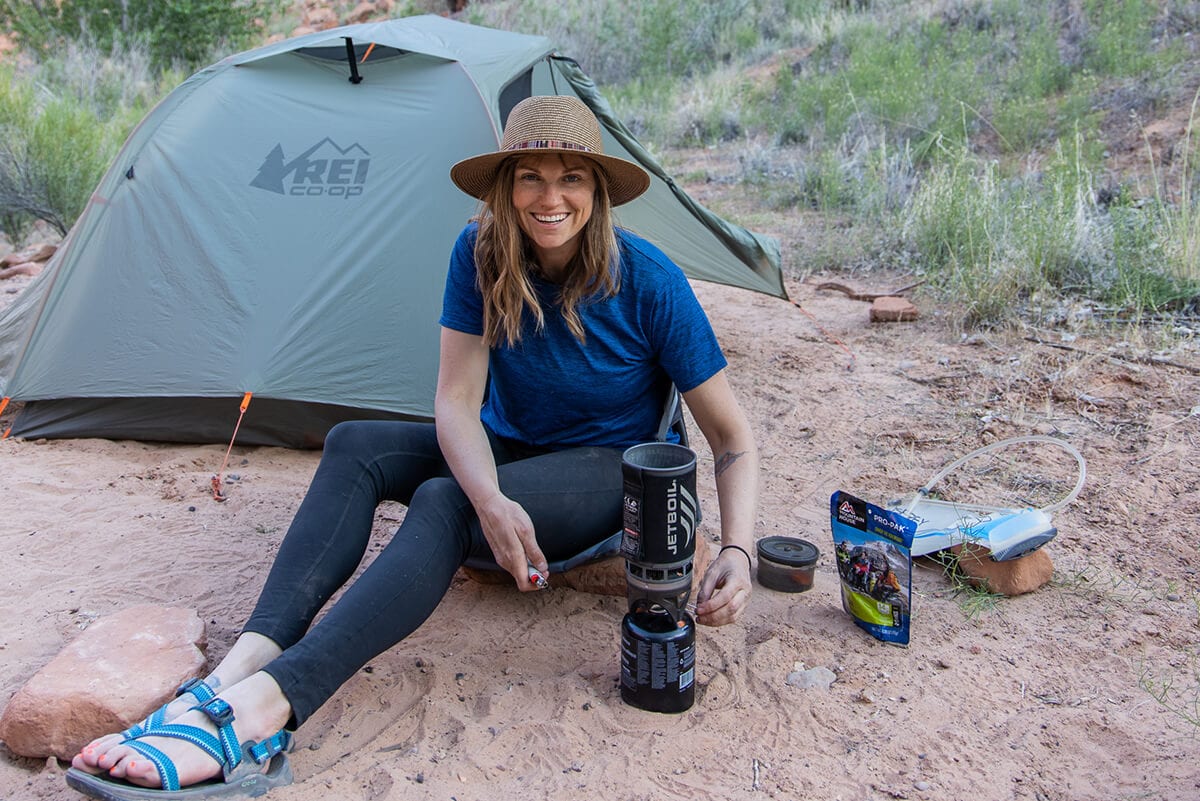
Are you planning a backpacking trip and feeling overwhelmed with figuring out what gear and supplies you need to bring? Don’t worry, you’ve come to the right place.
In this post, we’ll share our ultimate 3-day backpacking checklist (tailored for women) to help ensure you have everything you need for a successful and enjoyable trip.
From essentials like shelter and a comfortable sleep system to practical clothing choices, we’ve thought of all the basic essentials you’ll need to be comfortable on a weekend-long backpacking trip – nothing more, nothing less.
While this is a comprehensive list, I encourage you to adjust your checklist based on your own needs. That being said, I also encourage you to try and stick to the essentials. You may be surprised at how little you need!
The Big Gear Items
These are the essential pieces of gear that should always be on your backpacking checklist for every single trip you plan.
Backpacking Pack
I’ve tried many backpacking backpacks, and funny enough, the least expensive one I’ve owned has also been my favorite.
At 4 lbs. 8.7 oz., the Deuter Aircontact Core 60 + 10 SL Women’s Pack isn’t super lightweight, but it still weighs nearly 2 pounds less than my old Gregory backpack and it seamlessly molds to my body.
Deuter’s Aircontact series packs can adjust for a variety of torso lengths and also comes in a men’s model .
The 60 +10 SL pack is plenty big for a multi-day trip. In fact, this is the pack I took on my 22-day John Muir Trail hike, a 10-day backpacking trip in Alaska, and my Trans Catalina Trail backpacking trip .
For a shorter backpacking trip or if you’re splitting carrying gear with a partner, check out the smaller 45 + 10 SL version . This version is what BFT Director Linda uses on backpacking trips.
Shop Deuter Aircontact Core 60 at:
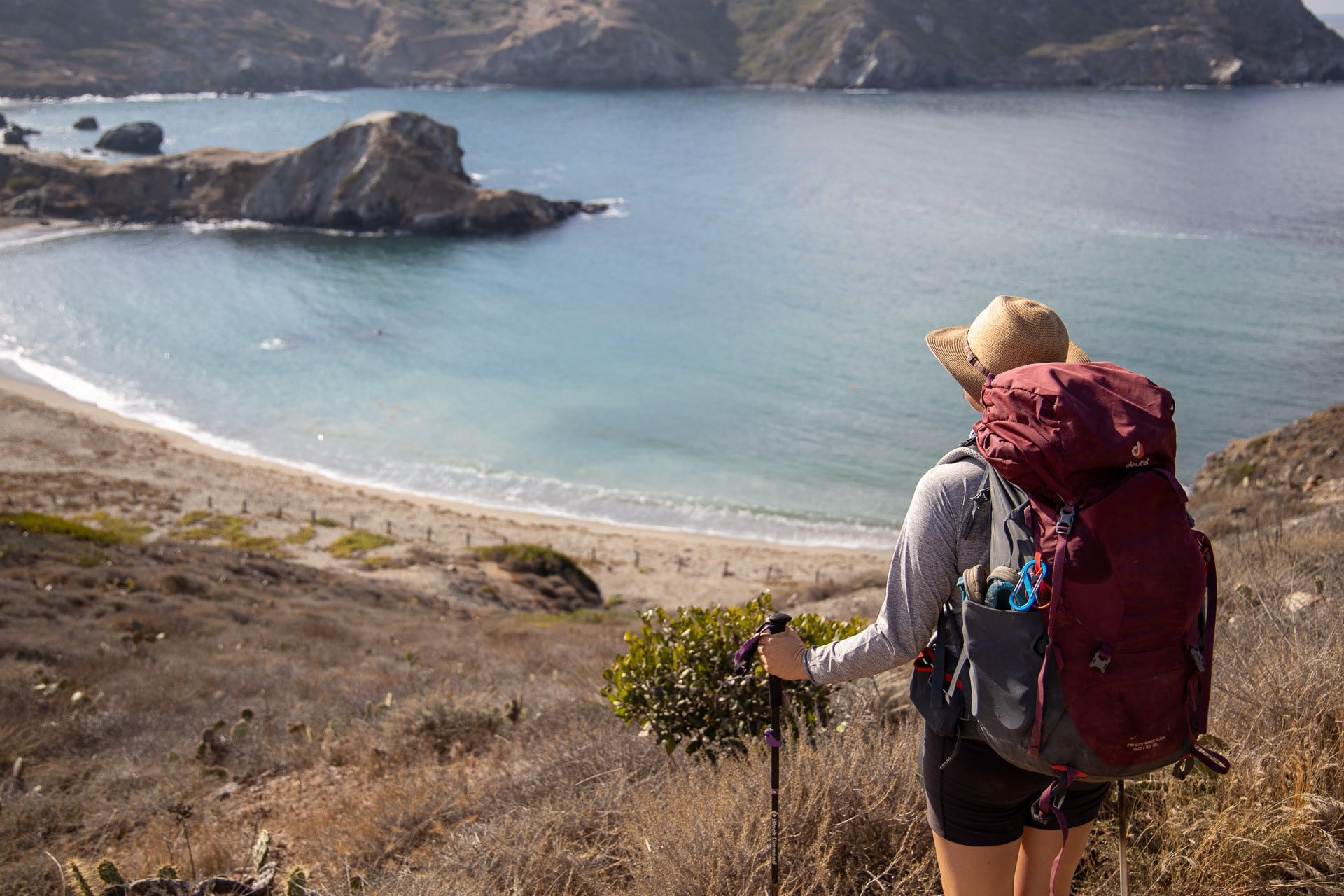
Backpacking Tent
Your tent choice can make the biggest difference in weight out of all the big gear items. However, the lighter your tent, the more money you’ll spend.
If you know you’ll be doing a lot of backpacking, I recommend investing in a good-quality, ultralight tent like the Zpacks Duplex . At just over 1 lb 5 oz, it’s one of the lightest tents on the market yet still roomy enough so you don’t feel like you’re sleeping on top of your partner.
It’s important to note that this Zpacks Duplex is a semi-freestanding tent. It does require two trekking poles (or the Duplex Flex Kit ) and guy lines (included) to set up.
Shop The Zpacks Duplex Tent at:
If you would like more room or backpack with a pooch, the Zpacks Triplex is just a half-ounce heavier and gives a bit extra space. My partner Ryan and I use the Triplex for backpacking trips which fits us and our 2 dogs, Charlie and Gumbo.
Read next: Interested in the Zpacks Duplex, but want to learn more? Head over to our detailed review to see if it’s the tent for you.
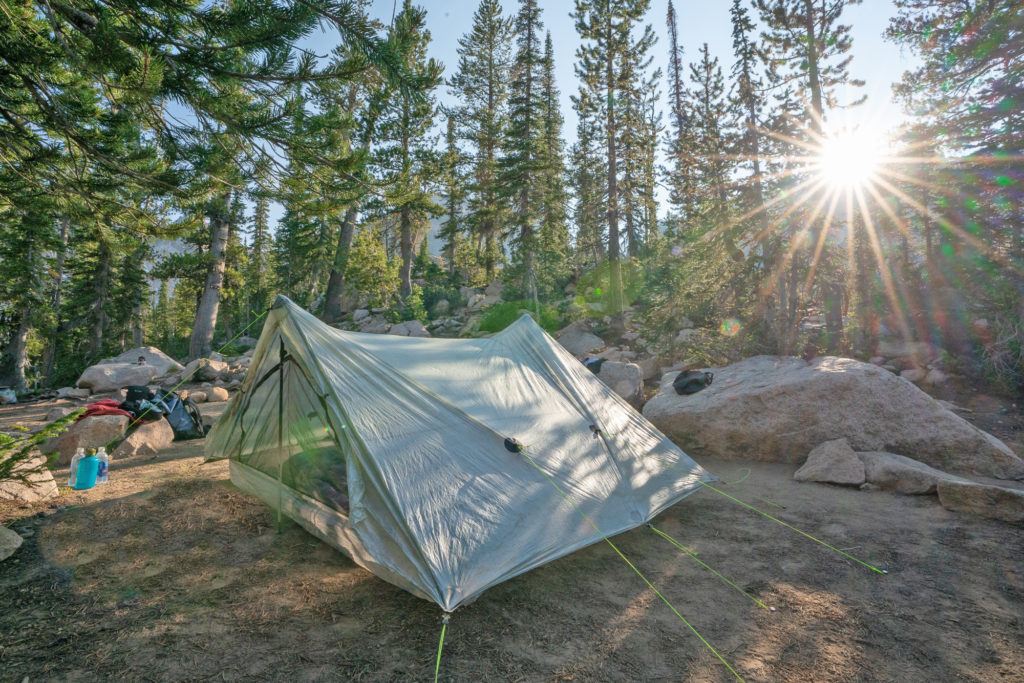
If $600+ is too much to spend on a tent (we don’t blame you!) or you want a freestanding tent, the REI Half Dome SL 2+ is a more budget-friendly option. It is a few pounds heavier at 3 lbs 15 oz, but still a great lightweight option.
Shop REI Half Dome SL 2+ at:
Sleeping Pad
I currently use the women’s Sea to Summit Comfort Light Sleeping Pad and love it. It’s lightweight, packs up small, and still manages to be warm and comfortable.
It’s also easy to inflate and comes with a pump integrated into the stuff sack, and it’s made out of durable ripstop nylon.
There’s a unisex version too in case you want something a little bigger.
Shop The Sea to Summit Comfort Light at:
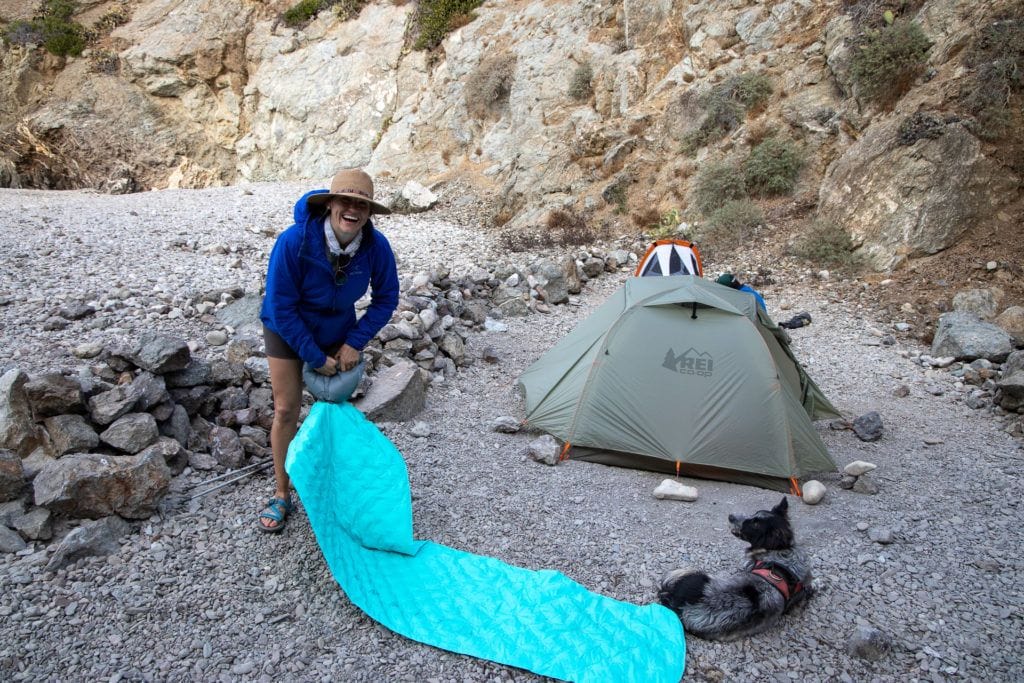
Sleeping Bag
More and more backpackers are opting for quilts over sleeping bags because they are more lightweight and versatile yet still keep you nice and cozy at night.
The Enlightened Equipment Revelation Quilt is our pick for a backpacking quilt. It’s incredibly lightweight at 1 lb 3 oz (850-fill, 30-degree) and we also love that you can customize it to your needs and preferences.
When ordering, you can choose between 850 and 950 fill power, select a temperature rating between 0 to 50-degree, and even customize your quilt length.
The Revelation Quilt is truly a revelation and one piece of gear I don’t leave at home when I’m heading out on a multi-day trip.
If you’re backpacking with your partner and prefer to cuddle, check out our post on the best double sleeping bags for backpacking .
Shop The Enlightened Equipment Revelation Quilt at:
More Big Gear Items
Backpacking accessories.
There are tons of backpacking accessories you can choose to pack, but here we list the most important ones that will keep you safe and comfortable on the trail.
Trekking Poles
On those uphill climbs, trekking poles help take some of the weight off your hips and legs by utilizing your arm strength. On the downhill, they help ease the pressure on your knees. And on those stream crossings, these puppies have saved me more times than I can count by helping me balance.
The Black Diamond Distance Carbon Z Trekking Poles are Black Diamond’s lightest foldable poles made of carbon fiber and come in 4 sizes to meet your height.
Shop The Black Diamond Carbon Z Trekking Poles at:
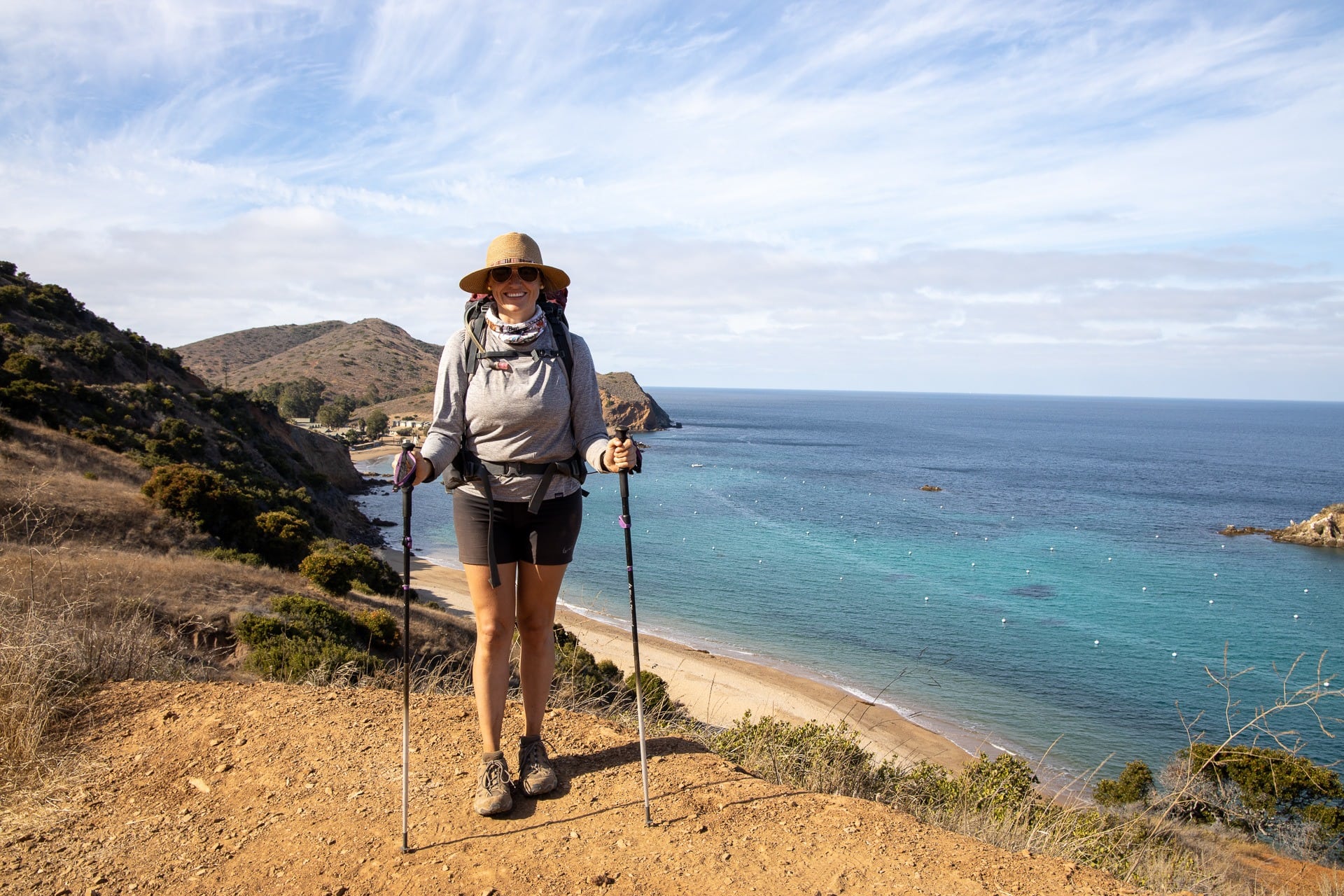
The BioLite Headlamp 325 is my new go-to headlamp for backpacking. It’s ultralight, low profile, and very bright with four lighting modes including red light so you won’t blind your basecamp buddies or compromise your night vision.
I also love that it is battery-free and USB-chargeable (just be sure to fully charge it before you head out!).
Shop The BioLite 325 Headlamp at:
Emergency Communication Device
I like to carry a tracking device with me that I can use to send a help signal in case of an emergency.
The Garmin inReach Mini 2 allows for two-way custom texting and also has GPS that you can use for navigating.
The Mini is much smaller and lighter than the regular Garmin inReach so I prefer it for hiking and backpacking when every ounce matters.
Shop the Garmin inReach Mini at:

First Aid Kit
You should always have a first aid kit when you are hiking in the backcountry. This ultralight, waterproof medical kit comes with the minimum supplies that you will need to address minor wounds, as well as travel-sized packs of some handy medications. I
In addition to what comes in this kit, you should supplement it with some extra blister band-aids and any medications that are specific to the hikers in your group .
Shop the Adventure Medical Kit at:
Read next: Prefer to put together your own medical kit? Read our guide on How to Build Your Own First Aid Kit .
Backpacking Chair
Packing a lightweight chair is definitely not essential for a backpacking trip, but it’s a nice-to-have item if you plan to spend a lot of time relaxing at camp. The Helinox Chair Zero packs down to roughly the size of 2 Nalgene water bottles and weighs only 1 pound, making it the perfect luxury item.
Shop the Helinox Chair Zero at:
Camping Accessories
Backpacking kitchen gear.
Next on our backpacking checklist is your camp kitchen gear. I tend to keep my cooking setup simple when backpacking. I mainly boil water for coffee or tea and oats in the morning and for backpacking meals in the evening.
Backpacking Stove & Fuel
The Jetboil Flash Cooking System is the most efficient backpacking stove I’ve found, especially if you are only boiling water.
Together, the stove and pot only weigh 13.1 oz. For a 3-day trip, one 230-gram fuel canister ( sold separately ) should be enough if you are using your stove for coffee, breakfast, and dinner.
Shop the Jetboil Flash at:
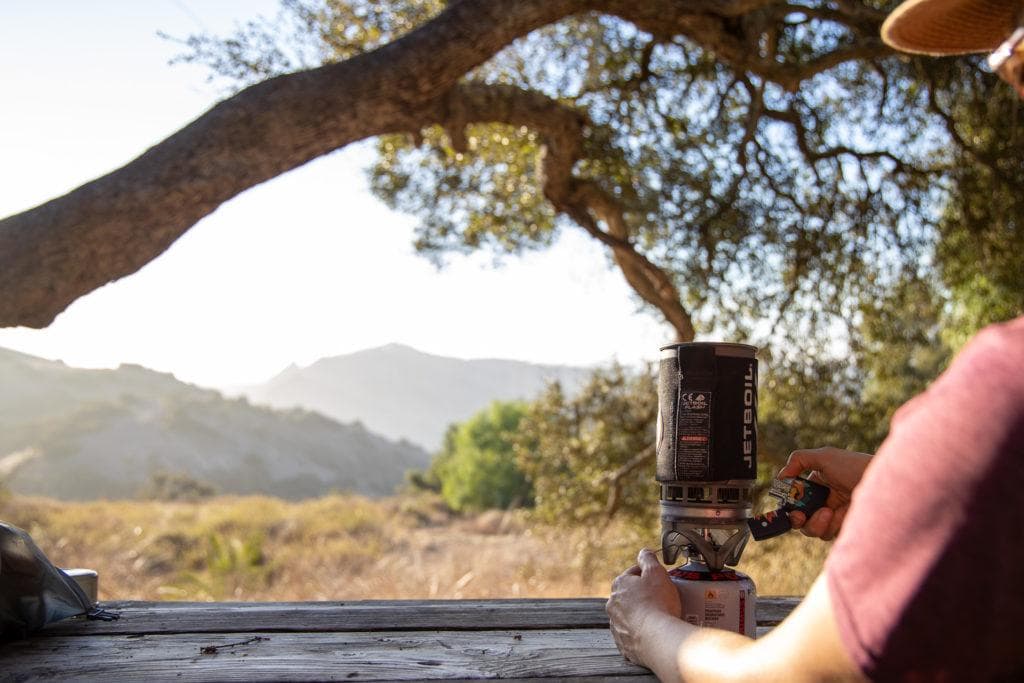
Water Bottles or Hydration Reservoir
I like to pack a few of these lightweight Platypus Soft Bottles that can be rolled up when they are empty. Compared to a hard water bottle like a Nalgene, these are much lighter and take up less space when backpacking.
Depending on water availability, I’ll bring up to three of these on my backpacking trips.
I also tend to use these instead of a hydration pack since a reservoir can be a pain to pull out of my backpacking pack each time it needs to be refilled.
But if you like to backpack with a hydration reservoir for easy water access while you hike, the Osprey Hydraulics Reservoir is a great option.
Shop the Platypus Soft Water Bottles at:
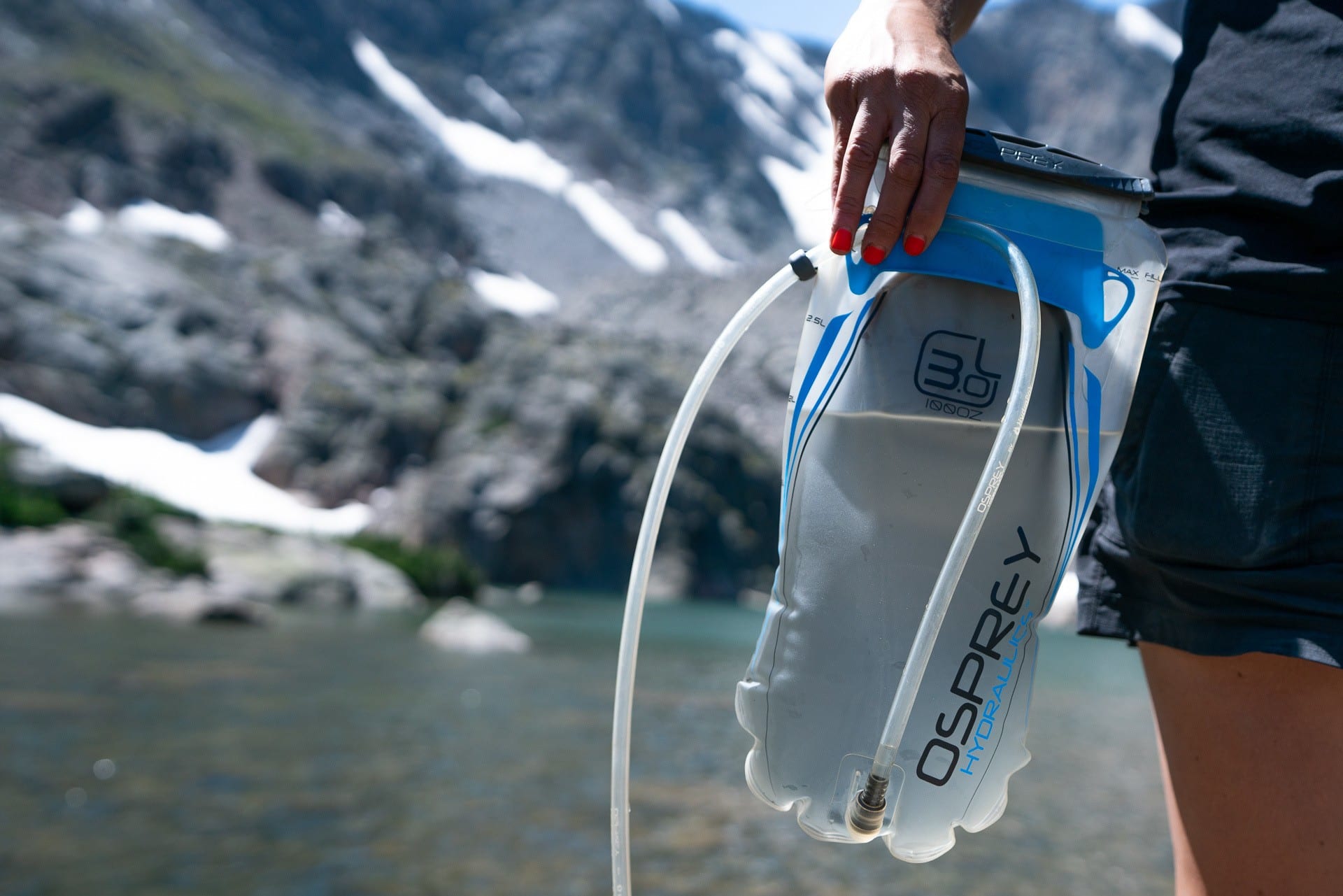
Backpacking Water Filter
The Platypus GravityWorks Water Filter System is absolutely the easiest way to filter your water in the backcountry, in my opinion.
This system relies on gravity to push water through, eliminating the need to pump by hand or manually squeeze water through a filter – meaning you can save your energy for the hike.
At 11.5 ounces you will barely notice this thing in your bag, and what’s really cool is you can connect the hose directly to your water bottle or any standard hydration reservoir.
I’ll also mention that it’s always good to carry a backup in case your water filter fails. These Katadyn Micropur Purification Tablets are great because they are super small and you can just throw a few in your first aid kit.
Shop the Platypus GravityWorks Filter at:
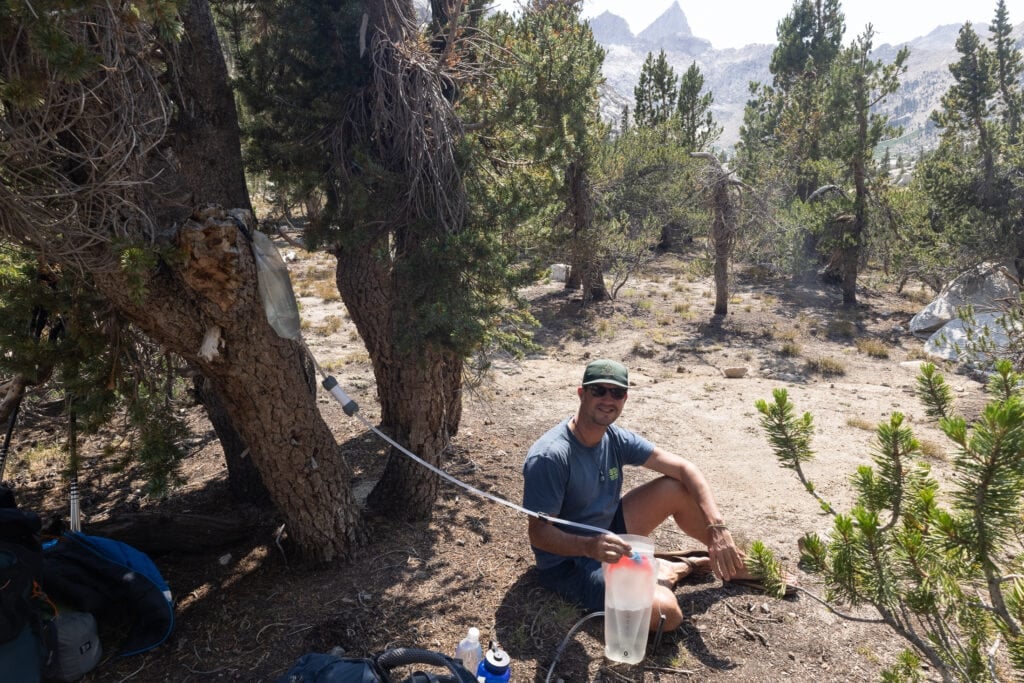
Lightweight Camping Mug
You’ll need something for that morning coffee and evening tea. The GSI Outdoors Infinity Backpacker Mug is lightweight and will keep your beverage warm in the coldest of conditions with its insulated wrap and sip lid. It even has a lightweight fabric strap as a handle.
Shop the GSI Outdoors Camp Mug at:
Eating Utensil
A girl’s gotta eat! Ramen, backpacker meals, oatmeal. This TOAKS Long-Handled Spoon is the only utensil you need, and it weighs shockingly little at 0.65 ounces!
It also has a long handle and can easily reach the bottom of that Mountain House bag.
Shop the TOAKS Long-Handled Spoon at:
Some people like to carry a multi-tool, but personally, I’ve always been able to get by with a simple, small knife.
This Gerber Mini Paraframe Knife can cut paracord or be used to prepare food and only weighs 1.4 ounces.
Shop the Gerber Mini Knife at:
Bear Canister
You may or may not need a bear canister depending on where you are hiking. They are required by law in California’s Sierra Nevada Mountains, spots in Alaska, Washington, Idaho, Wyoming, and more.
In some places, they may be available for rent but be sure to check before heading out.
If you are on a short trip and only carrying food for yourself, the Bear Vault 450 is a good inexpensive option. Or for a duo or longer trips, go for the larger version .
Shop the Bear Vault 450 at:
Backpacking Kitchen
Backpacking toiletries.
My beauty routine while backpacking is pretty limited and is focused purely on hygiene. That is what I’ve reflected in this backpacking checklist. No deodorant, no makeup, no hairbrush, etc.
The mountains can suck the moisture right out of those beautiful lips leaving them cracked and dry. Plus, your lips are just as vulnerable to sunburn as your face, so SPF is key.
Sun Bum Mineral SPF 30 has natural, organic ingredients and will keep your lips hydrated and protected.
Shop the Sun Bum Lip Balm at:
At high elevations, you can burn way quicker than you think, and all those hours hiking in the sun add up.
This Sun Bum sunscreen comes in a small tube, is water-resistant , and provides SPF 50.
Shop the Sun Bum Sunscreen at:
Toothpaste & Toothbrush
It’s all about those travel-size toiletries when backpacking. This Dr. Bronner’s Travel Toothpaste comes in a 1 oz size and is all-natural, fair trade certified, and the packaging is completely recyclable.
Shop the Dr. Bronner’s Toothpaste at:
Poop Kit – Trowel, Toilet Paper, & Ziploc Bag
In order to comply with the 7 Leave No Trace Principles , you need to dig a cathole that is at least 6-8 inches deep when you go #2.
You may think “I don’t need a shovel… I’ll just use a rock or stick.” I’ve made that mistake myself only to find that sometimes the dirt is so hard, you can’t dig a hole. And then panic ensues.
Make life easier for yourself by grabbing a BoglerCo Ultralight Trowel . It’s super lightweight and there’s really is no excuse to not bring it with you.
Also, when you go #2, you need to pack out your dirty toilet paper in order to maintain campsite and trail conditions for future campers.
There’s nothing grosser than finding a bunch of used dirty TP when you’re camping. I like to bring a Ziploc bag for my TP and then I store that in a small (not-see-through) stuff sack that I can rinse out later.
Shop Ultralight Trowel at:
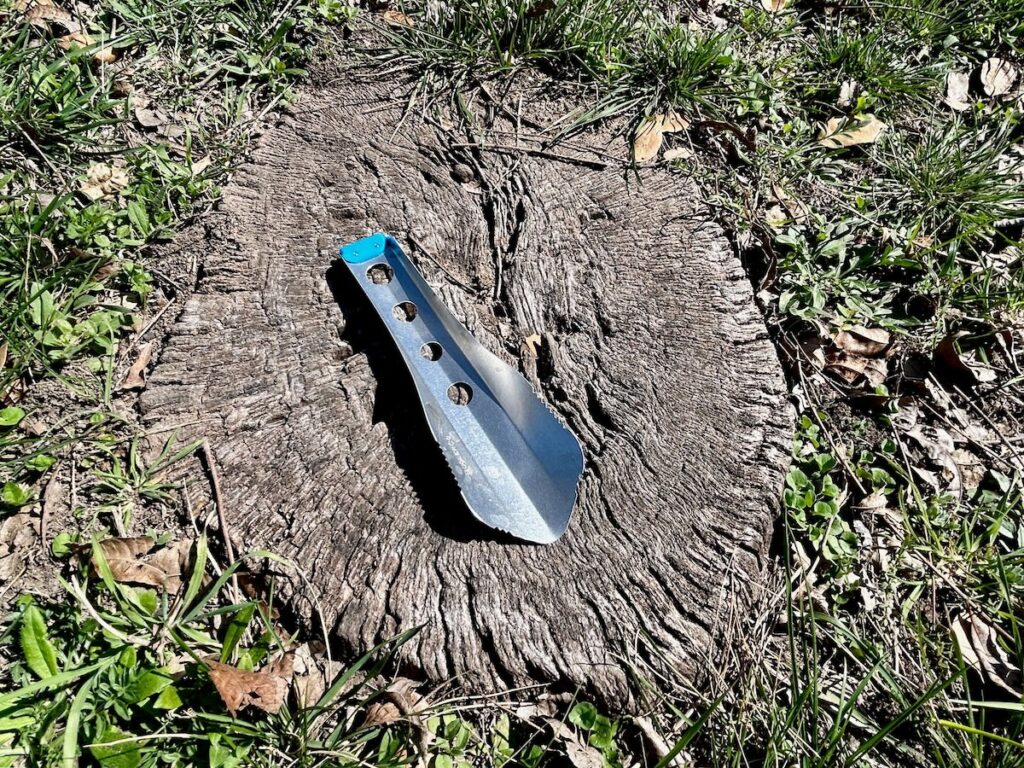
While this might sound strange to you at first, bringing a pee rag on your backpacking trip, like this specially made, antimicrobial Kula Cloth , is super helpful.
Instead of having to wipe with TP each time and pack it into your zip lock bag, and instead of not wiping at all which can result in odors and discomfort, just wipe with this reusable cloth!
When going to the bathroom, I drip dry and then pat myself off with this in order to keep my lady parts clean.
Then, I use my water bottle to rinse off the towel 200 feet from any water sources (as recommended by Leave No Trace) and hang it from my pack to dry.
Shop the Kula Cloth at:

Quick Dry Towel
A lightweight quick-dry towel is always handy, whether it’s for drying your hands and face, doing dishes, or going for a swim and doing some sunbathing.
They come in a variety of sizes so you can pack what you need and nothing more.
Shop the REI Multi Towel at:
Hand Sanitizer
A travel-size hand sanitizer is a must before eating and after going to the bathroom while in the backcountry.
I prefer hand sanitizer to soap because it’s easier to follow Leave No Trace. If you do choose a biodegradable soap, like this one by Dr. Bronner’s , be sure to abide by Leave No Trace and rinse 200 feet away from water sources.
Shop Dr. Bronner’s Hand Sanitizer at:
For shorter trips, you might be able to get away without wet wipes, especially if you’re using the pee rag method and you want to save weight in your pack.
However, if you want a little refresh, these Sea to Summit Wilderness Wipes are soft and gentle on both your skin and the environment. They’re unscented (better for not attracting wildlife) and even come in an extra-large size in case you want to wipe your whole body down after a hot sweaty day on the trail. Be sure to pack them out in your ziplock trash baggie to dispose of them properly.
Shop Sea to Summit Wilderness Wipes at:
Backpacking Clothing
How much clothing should you bring on a 3-day backpacking trip? The absolute minimum you need to be comfortable.
You’ll appreciate it when you start to feel the weight of your pack after a couple of hours of hiking.
You really only need 1 hiking outfit and 1 set of dry, warm clothes to change into when you get to camp and for sleeping.
The only thing I bring extra of is underwear and socks and maybe an extra shirt I can swap out depending on how many days I’m backpacking.
Helpful Tip
Avoid cotton.
When backpacking, you want to avoid cotton because it retains moisture, takes a long time to dry, and tends to harbor smells. Instead, opt for quick-dry materials that wick sweat and resist odors.
Insulated Jacket
A lightweight, packable, insulated (down or synthetic) jacket is key for when the temps drop in the evenings.
I prefer something with a hood so I can keep my head warm when it’s windy or extra cold, so I pack my Arc’teryx Atom Hoody .
Shop the Arc’teryx Atom Hoodie at:
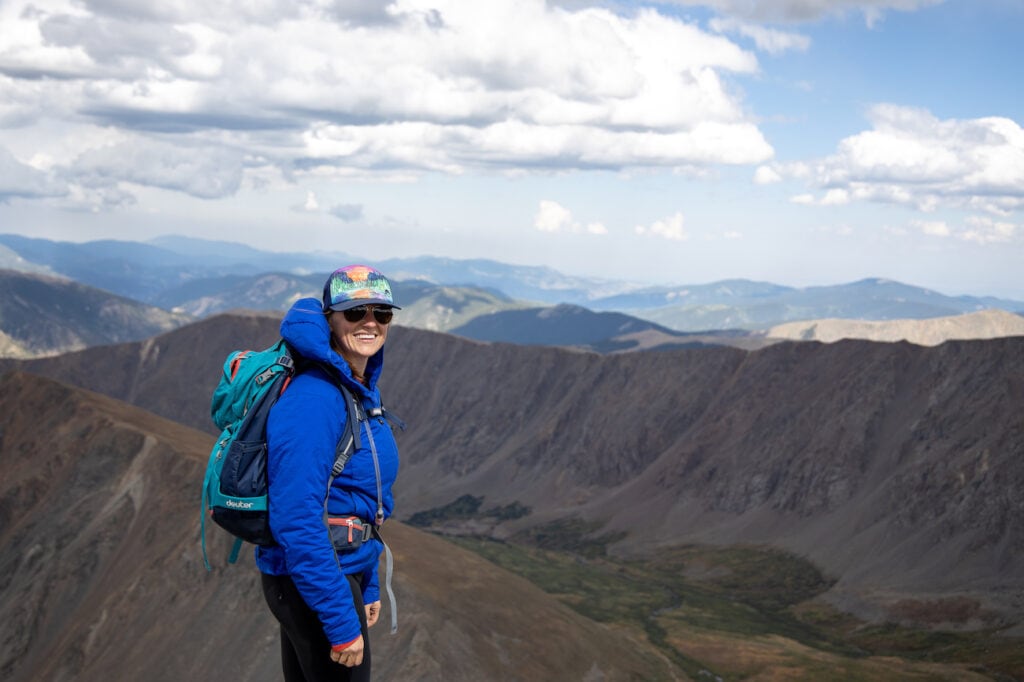
Rain Jacket
Always check the weather before you set out. Even if it’s looking like nothing but sun, I like to bring a lightweight rain jacket and the Arc’teryx Beta AR Rain Jacket is my top pick. It is definitely pricey (catch it on sale!) but once you invest in a piece like this, you’ll have it forever. It’s the rain jacket I wore on a backpacking trip in Alaska where it rained nearly every day.
For a more budget-friendly option, check out the REI Co-op Ranier Rain Jacket – it’s what Linda, BFT’s Director of Operations, currently uses and loves.
Also, if there is any chance of showers, I throw in a pair of rain pants too.
Shop the Arc’teryx Beta AR Rain Jacket at:
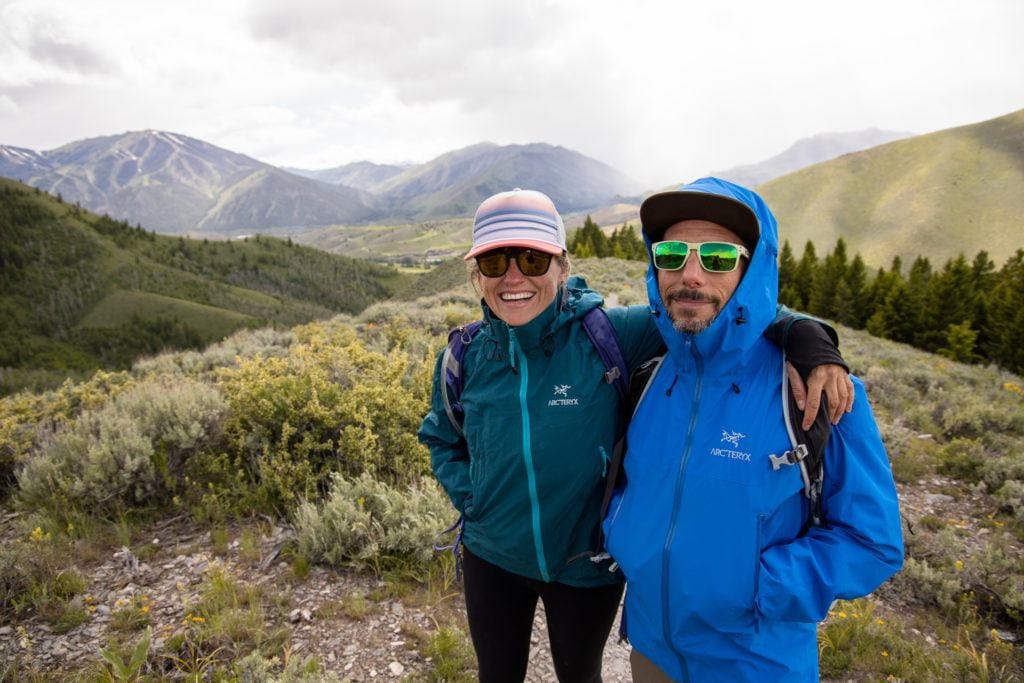
Base Layer Top
A warm, wool base layer is handy for changing into when you’re ready to get out of your sweaty hiking clothes and get warm at camp. It can be cozy to sleep in too.
I like the Icebreaker 200 Oasis Half Zip because it’s super soft and odor-resistant. I also opt for Icebreaker over other Merino wood brands because they have strong animal welfare standards.
Shop the Icebreaker 200 Oasis Top at:
Hiking Pants
I prefer to backpack in leggings (if it’s too cool for shorts that is). The REI Flash Hybrid Tights are a Bearfoot Theory team favorite because they’re designed specifically for hiking with thoughtful details such as snag-resistant fabric, a zippered pocket for keys, and a comfortable high-rise waist that won’t dig in or roll down while you’re hiking.
Shop the REI Co-op Flash Hybrid Tights at:
Moisture Wicking T-Shirt
I always hike in a non-cotton, quick-dry, moisture-wicking t-shirt, and most often it’s the Patagonia Cool Capilene T-Shirt .
As I get older, though, I’m preferring the long-sleeve version because it provides more protection from the sun. These shirts are lightweight, so even with the long sleeves, I stay nice and cool.
Shop Patagonia Capilene Tees at:

Hiking Shorts
I like to backpack in spandex shorts when the weather’s nice, but lately, I’ve been liking these REI Co-op Active Pursuits Shorts .
They’re comfortable and stretchy and offer a little more breathability than spandex.
Shop the REI Active Pursuit Shorts at:
Sports bras are my go-to even when I’m not hiking, and these days I’m personally loving the lululemon Run Times Bra .
It’s perfect for backpacking because it doesn’t shift around, my breasts are fully supported, and don’t bounce around AT ALL. I also love the thick straps becuase they don’t dig into my shoulders.
Shop the lululemon Run Times Bra at:
Quick Dry Undies
The lululemon InvisiWear Mid-Rise Boyshorts are lightweight and have a barely-there feel, making them great for backpacking.
I’ve tried two other cuts of these InvisiWear underwear, and the boyshorts stay in place the best out of all of them.
Shop the lululemon InvisiWear Boyshorts at:
Hiking Socks
I alternated between 2 pairs of Darn Tough Hiking Socks on my John Muir Trail hike. That was years ago, and I still wear these socks hiking.
They are extremely durable and stay put while you’re hiking so you don’t end up with nasty blisters. Plus, Darn Tough offers a lifetime warranty. Free socks for life!
Shop Darn Tough Socks at:
Hiking Boots
I’ve always been a big fan of Oboz and recently upgraded to a new pair of Bridger BDry Hiking Boots after wearing my last pair out through years of hiking and backpacking.
The mid-height helps support your ankles, plus they are waterproof and have a stiff sole, so you get plenty of support on those steeper, rockier slopes.
Shop the Oboz Bridger BDry Boots at:
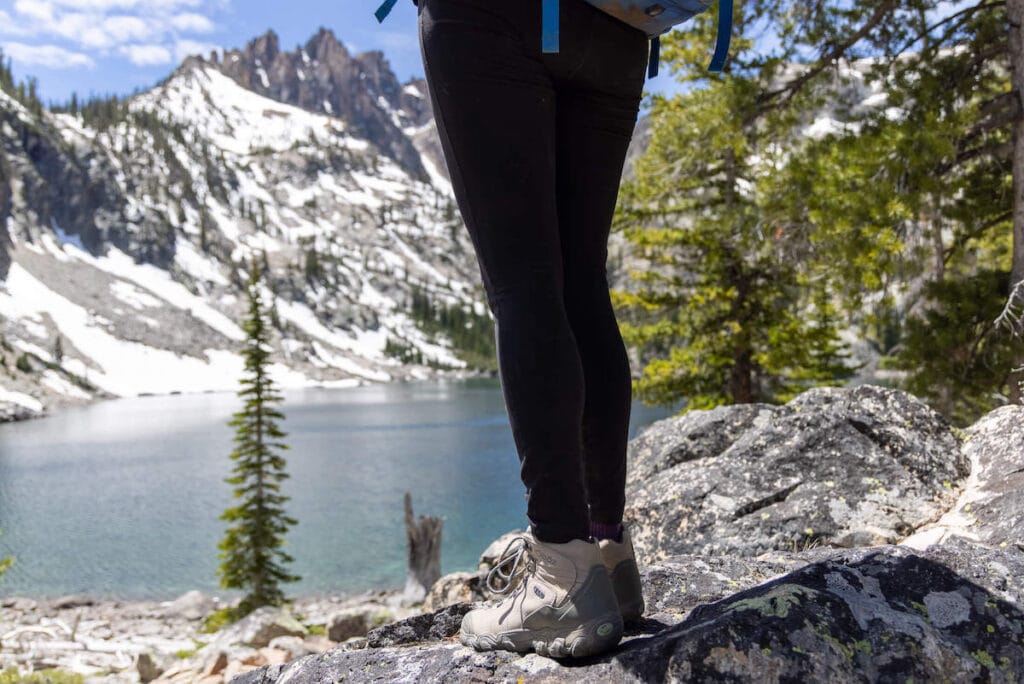
Camp Sandals
It’s always nice to take those hiking boots off when you get to camp to let your feet breathe, and for that reason, a pair of camp sandals are a must on my backpacking checklist.
These Teva Universal Trail Sandals are lightweight (1 pound for the pair) and provide structure and grip for walking around camp.
They have padding around the ankle and anywhere there is a buckle to prevent rubbing, and they are one of the most comfortable pair of sandals I’ve ever owned.
Plus, they are made from recycled water bottles, so it’s a win-win! See my full review here .
Shop the Teva Universal Sandals at:
Even if you’ll be hiking in the woods or the forecast looks cloudy, you’ll want to bring a sun hat to protect your face, neck, and shoulders from harmful UV rays. Not only do hats ward off sunburns, but keeping your skin shaded can also help prevent dehydration and heatstroke.
The Wallaroo Sedona Hat has been my favorite for years. I love the wide brim, stylish look, and that it can pack down without losing its shape.
Shop the Wallaroo Sun Hat at: (Use the code BEARFOOT20 for 20% off)
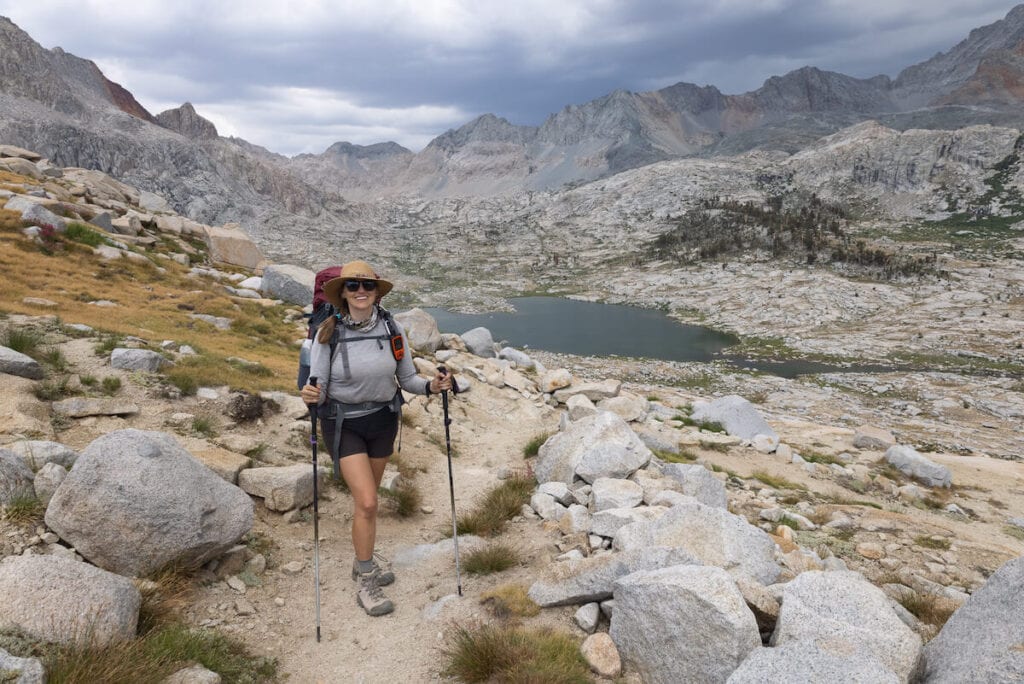
Don’t forget your shades at home! You probably already own a pair of sunglasses, but if you’re in the market for some new backpacking sunglasses, Goodr makes fun, affordable options. We also love that they are a member of 1% For The Planet.
Shop Goodr Sunglasses at:
I also highly recommend packing a buff – a versatile piece that you can wear around your neck for sun protection, around your face and ears if it’s windy, and even as a headband soaked in water to help keep you cool.
Shop Buffs at:
If it’s going to be cold, you’ll also want to bring a pair of gloves. I like these lightweight Smartwool liners . They’re touchscreen compatible and not bulking, so they work well with trekking poles.
Shop the Smartwool Liner Gloves at:
It’s a good idea to pack a lightweight, quick-drying beanie to wear at night or if temps drop during the day. The REI Ribbed Beanie is a simple hat that does the trick.
Shop the REI Ribbed Beanie at:
Backpacking Clothes
Need help planning or preparing for your trip? Check out these helpful backpacking how-to guides:
- How to Train for Hiking & Backpacking
- How to Pack a Backpacking Pack for a Multi-Day Trip
- How to Plan a Backpacking Trip in 12 Simple Steps
- Backpacking for Beginners: Wilderness 101 Tips
- Beginner Backpacking Mistakes to Avoid
- Tips for Backpacking With a Dog
Save this post to Pinterest

What’s on your backpacking checklist that we missed? Is there anything you’d add or subtract? Do you have any questions about what to bring backpacking? Let us know in the comments below.

With two decades of hiking and seven years of van life under her belt, Kristen has dedicated her life to helping people experience the positive effects of nature. As a pioneer in the outdoor blogging space, she founded Bearfoot Theory in 2014 and has since authored more than 350 blog posts about outdoor travel, hiking, camping, and van life. Her work has been featured in National Geographic, Outside Magazine, and Backpacker, and when she’s not on the road, she lives in Park City, Utah with her partner Ryan, their son, and two adventure pups.
Leave a Reply Cancel reply
Your email address will not be published. Required fields are marked *
Save my name, email, and website in this browser for the next time I comment.
59 Comments
Pretty nice list! I need to have a look at the Nemo sleeping pad, my Thermarest is annoying me so much recently.. Need something light and rectangular.
I’m totally with you re: trying to find a comfortable and convenient way to carry photography gear. Have you tried the Peak Design capture clip? I’ve used it for day hikes and have liked it so far but am not sure how it will work for weekend backpacking trips. Of course, even with the clip you’d need some decent bag for protection if you’re going through rough terrain or if the elements don’t cooperate. I like your approach with the sling though. 🙂
I have tried the Peak Design clip. They are pretty cool and I might be taking one with me on my upcoming trip to Nepal.
Check out Cotton Carrier’s Strapshot camera holster for your DSLR. It wraps around your backpack shoulder strap and provides a secure place to hang your camera with a 1/4 turn quick release and safety tether. I use it and have the full chest harness. (I’m not at all associated with them, just find their gear really convenient.) Thanks for the good read.
I also use the cotton carrier system – a disc screws into the tripod attachment of my camera (I pack in a Sony a6000 with an 18-200mm lens) and then there’s a holster that clips/velcros on to my backpack strap on my shoulder. You keep the strap around your neck for safety (more than twice I’ve been over, the camera unhooked from the carrier and I would have dropped it without the neck strap!) and then the camera is easily accessible when you want to shoot something. The downside is no protection from dust/moisture, so on dusty trails I’m brushing off the lens a lot. But it went with me to Everest Base Camp, Kilimanjaro and numerous 2-7 day backpacking trips with a large ziplock in my bag for water protection if needed. Love this setup.
I love my cotton carrier. I carry a full sized Nikon on it..have for 3 years… zero accidental disconnects… its tough for a piece of plastic too….
Great list Kristen, these checklists are so handy for people that are new to doing these kind of hikes. Have a great holidays! Stephen – Uncharted Backpacker
This is an awesome and very specific list! It’s very helpful you listed brands that you specifically like to use!
Just got the Montrail hiking boots. Loving it so far. Great list.
I THINK I obtained permits for Havasu Falls for this spring (I received confirmation emails, but still have a fear something may go wrong, but I’m hoping for the best). Starting to plan and struggle with what camera equipment to bring. I have a Nikon d7100 that I love, but would like to get by with just my 35 mm/1.8 lens. Think that’s wide enough to get good waterfall shots?
Hey Des, I’d highly recommend a wide angle lens. I brought a 16-35mm last time and it worked out perfectly. Have fun!
Amazing list! Seems to be the go-to stuff when comparing to other lists. That said, I\’d strongly suggest bringing a compass and map! On a longer trip would you change change the gear or simply bring a few more items of clothes?
Thanks Sean for the added recommendation of a compass and map! For a longer trip I would just recommend having at least one change of clothes in case of weather or for added layering. I backpacked the entire PCT for 5 months with only 2 shirts and 2 pairs of bottoms, so you definitely don’t need to expand on bringing more items necessarily.
A great list and this is going to be so useful to me. I go on treks very frequently and usually don’t get much time for backpacking. Thanks a lot for posting!
You literally just saved my life. Thank you for making this list!
Its always good to have a small extra knife just to be sure and ready for everything. A roadeavour knife wont add that much. only a size of a credit card. but very reliable.
Also a good thing to have is a collapsible water bottle like the one in roadeavour
n NZ if I went hiking with an umbrella, I would be laughed out of the hills. It would be really good to see exactly what you take in all the small bags, as this is wear weight accumulates and my pack gets heavy. Thanks for sharing.
Hey man, this is a very specific and a great list. Thanks for sharing with us such a awesome list.
Great list Kristen. Thanks for taking the time to put this stuff together. Your site is full of great info. I do the same stuff on a much less professional level on my youtube channel. Your site always has a few gems that even experienced hikers can find useful. Keep up the good work!
Thanks good stuff
Wow you hit the lottery? Most hikers couldn’t afford have your list. Anyone can go into a REI and buy the best available but a true backpacker can use whats handy and go on a trip. I am an assistant scout master for a Boy Scout troop and do trips including gas for a 3 hour trip, food for 12 and snacks for around 12 bucks each using basic gear for 3 days on the trail. Contact me and I can teach you how to hike on a tight budget.
I am so grateful to have stumble across your website. I am a beach bum. I have only done one day hikes. But, I have been invited to a three day hike in Korea. I will be doing the Jirisan Nature Reserve over three days. I have a bag and sleeping bag. That’s it. What elae do I need to prepare for this three day trek? It will be in September. Your help would be appreciated. I am an Expat teaching in Korea. I am exploring Korea through Hikes and wone tasting. I am open to suggestion.
Hi Gabriela, we are so glad you found us! Will you need a tent for your trek or will they be provided? We would recommend a sleeping pad as well. If you’d like to reach out and email us at [email protected] we can provide you with additional links to great articles and packing lists on our site to help you prepare for your trip. Sounds like an incredible adventure you have ahead of you!
Just what I was going to say. This is nice list of gear for anyone who has, say, a couple of thousand dollars to drop on a three-day (two-night?) backpacking trip.
What is your total weight of your pack?
Hi Rolando, that really depends on how long you are going to be backpacking. For a 3-day backpacking trip, we recommend trying to keep your pack weight as minimal as possible, depending on if you need to carry water or not. A good rule of thumb is not having your pack weight more than 20% of your body weight.
It is interesting that trekking poles can help manage the weight on your hips and legs by using your arms. My wife and I are going on our first backpacking trip in three months and we are trying to get everything together. We may consider going to a few camping stores near us to see what they recommend we bring too.
Hi James, So exciting to hear you and your wife are getting into backpacking! Trekking poles are a game-changer on the trail. We have a ton of comprehensive blog posts here about backpacking that you’ll probably find helpful. I suggest you start here: https://bearfoottheory.com/backpacking-101/ Let us know where you go and if you have any questions!
On my must pack list is a brightly colored bandana or two. So many uses; shade, neck warmer/cooler, dishrag, splint maker, wash rag, hunter safety gear (thus, brightly colored), and on and on. Thanks for great list, Kristen!
My thoughts, exactly…Black Diamond everything! If I’m going to spend $1000, might as well be in a hotel. There are countless other, just as good, options out there. Off-Brand does not always mean that you are compromising durability and/or performance. Do yourself a favor and think logically–don’t always believe sites like this. Some great info in here, I’ll agree, but focus on being “prepared,” and not showing off at the trailhead as you unload from your Volvo.
Ho! these are some really good checklist, thanks for sharing 🙂
Thank you. I will try everything on my first hike this fall.
Thanks for reading, happy hiking!
What are your thoughts on a woman hiking solo? Safe?
We thinking hiking solo as women can be done safely. In fact, it can be fun and empowering. Check out this blog post for more on this topic as well as safety tips for solo hiking: https://bearfoottheory.com/hiking-alone/
Thanks for this list, I’m planning out my first backpacking trip for myself and my husband and struggling to find a minimalist approach! I don’t want to pack everything and the kitchen sink but every blog seems to have twenty million things that are unnecessary. I’m looking forward to following your list! Any tips on seating? My husband is struggling with not being able to pack his giant camping chair.
Hi Claire – we know what you mean! Taking only what you need to be safe and comfortable will help you have a better experience. If you’re suffering under the weight of your pack it’s hard to have a good time. The Helinox Chair Zero in the blog post below is a good option. It’s super lightweight and packs down small making it great for backpacking. The REI Trail Chair in the same blog post is a good option as well if you don’t mind sitting on the ground. Another option is a lightweight, folding stool (just search “camp stool” online and you should be able to find a few options). Happy hiking!
https://bearfoottheory.com/best-camp-chairs/
Look up thermarest trekker chair. It converts/folds your sleeping pad into a sitting position.
That’s a great suggestion, thank you!
I will definitely keep this in mind in my next travels. thank you!
Thanks for reading!
What is your total weight including pack for 3 days? Also check out Lume deodorant on line. Some folks can go 72 hours with out stink. Safe for any body part. And no I don’t work for Lume, just having great results.
It varies depending on a few factors including the weather (how much warmth, rain gear, and shelter we have to pack for example) and whether a bear canister is needed which adds a little weight as well. I’d say our standard pack weight is anywhere from 15-30 lbs depending on how lightweight we’re going. And thanks for that deodorant recommendation!
Hi, thanks for taking the time to write these articles and share them, much appreciated. I have shared them on my own webpage/blog with my own followers as well – spreading the love.
Thanks Tania!
I was meant to find this post. I am a woman about to go on my first 3 day hiking/backpacking trip. I can’t tell you how helpful this info is. Thank you so much!
You’re welcome – happy trails!
The point is that if you’re looking to list existing products – it pays to ensure that you’re using the most effective techniques to instill trust, desire, and confidence in your buyers.
I love the mansplainers out there shaming her for touting nice gear. We all like to spend on different things. Some of us might go to REI to pick up a fun toy or two, and the rest of us probably have the brains to know how to substitute a cheaper item or repurpose something we have. First timers can also borrow gear from friends or neighbors before they commit to more frequent backpackers. It’s a great way to figure out what you like. This list was very helpful, Kim. Thanks.
Where’s your straw hat from though?? So cute!
It’s a Wallaroo Sedona Hat . My favorite wide-brimmed hat!
As others have said…THANK YOU. I have not backpacked in 8+ years and this was a great reminder and check list. I actually cannot believe some of the folks who harassed you about buying quality gear…guess their Momma never told them that “if you can’t say something nice, don’t say anything”…you would think they would have learned that on the trail. Their packs must get heavy carrying all that hate around…lose the weight! Franklly, I am always looking for ways to time weight and cost, but that is part of the fun and the process. Thanks again for a great list/refresher as I plan a 3 day in the Smokey’s!
So glad to hear you found this helpful! Enjoy your trip to the Smokey’s, and welcome back to backpacking! We actually have a fall travel guide for the park here in case you need help planning: https://bearfoottheory.com/smoky-mountains-fall-guide/
This is a very nice list, but if you put all these things together, the weight is not going to be ideal. The tent and sleeping bag is just about 6 lbs for start. All these are good products, but for the weight conscious, I would definitely be going for lighter items, if you don’t mind the weight, great list.
Hi Nikki, thanks for the input! These are the gear items we’ve personally carried when backpacking, even though they might not be the lightest on the market. For someone just starting out, buying gear can be really expensive so we’ve tried to strike a good balance between cost and weight in our recommendations. However, we’re working on an ultralight backpacking gear guide at the moment which will focus more on lightweight items.
Do you have an article on what you pack for food for a three day hike? I have always day hiked, and know my go to list for snacks, but haven’t ever done overnights, so not sure what to bring for calorie packed real meals. Thanks.
Hi Melanie, this blog post gives tips for what to pack for backpacking food, how much to bring, and our personal favorites: https://bearfoottheory.com/backpacking-food-ideas/
Thanks since I’ve become an old man I haven’t backpacked in a few years. So this was a good reminder. Appreciate you taking the time to post this. All the best for a safe and healthy season. Dave H Fort kent, Maine
MEMBER REWARDS DAY

- Refurbished
- CIGS Solar Tech
- Membership & Reward
- Refer& Earn $50
- Military-Only Offer
- Bougerv Events
- Order Tracking
- Where to Buy
- CR & CR Pro
- CR Colorful
- ED&CRD Dual-Zone
- Aspen & Aspen Pro
- F-150 Center Console Fridge New
- Fridge Accessories
- All 12V Fridges>>
- CIGS Solar Panels
- N-Type TOPCon New
- Fiberglass Solar Panels
- Bifacial Solar Panels
- Rigid Solar Panels
- Portable Solar Panels
- All Solar Panels
- Lithium Batteries
- Solar Controller
- Solar Inverter
- Cables & Connectors
- Mounts & Brackets
- Accessories & Tools
- Power Stations
- Solar Generators
- Air Conditioners
- Camping Water Heater
- Rocky Series New
- JuiceGo 240Wh Power New
- 50W Solar Panel New
- Center Console Fridge New

Backpacking Weight: How Much Should You Pack and Tips for Packing Light

When it comes to backpacking, every ounce matters. A lighter pack increases your agility and endurance over long distances, making your outdoor adventures more enjoyable and sustainable.
In this comprehensive guide, we'll explore backpacking weight, including good base weights, maximum weights, a backpacking weight chart, and more. Besides, we will also provide essential tips for cutting down on weight and highlight some must-have lightweight gear. This includes BougeRV's innovative products like the 240Wh JuiceGo portable power station and the 50W portable solar panel, designed to keep your journey energized without weighing you down.
Let’s dive into the blog now!
How Does Weight Impact Backpacking?
The basic idea behind backpacking light is to minimize the physical toll of heavy packs. Carrying a lighter backpack improves balance, reduces muscle fatigue, and enhances overall enjoyment. Here's why managing your pack weight is so important:
- Increased Comfort: Less weight means reduced strain on your shoulders, back, and legs.
- Energy Efficiency: Heavier packs deplete energy faster, leading to quicker fatigue. A lighter load conserves energy over long treks.
- Speed and Flexibility: A lighter backpack facilitates quicker movement and easier navigation across challenging terrains, enabling longer, less tiring hikes.
- Reduced Injury Risk: Heavy loads increase the risk of joint and muscle injuries, as well as falls. Lighter packs help mitigate these risks and promote safer travel.
Understanding Backpack Weight

Backpack Weight Key Terms
Understanding backpacking weight terms is crucial for efficient pack management and ensuring a safe and enjoyable hike. The key terms include:
- Base Weight : The total weight of your packed bag excluding consumables like food, water, and fuel.
- Consumable Weight : Items that get used up and lighten your load as the trip progresses.
- Pack Weight : The combined weight of your base weight plus consumables.
What Is a Good Base Weight for Backpacking?
A good base weight for backpacking should ideally be under 20 pounds . Lightweight backpackers often aim for a base weight of around 10 pounds or less to minimize strain and enhance mobility on the trail.
For most casual or beginner backpackers, aiming for a base weight between 15 and 20 pounds is practical and comfortable. This range allows for essential gear without overburdening you, ensuring a more enjoyable and sustainable outdoor experience.
What Is the Average Weight of a Backpacker’s Load?
The average weight of a backpacker's load varies depending on the length of the trip and individual needs, but it typically ranges from 20 to 30 pounds for a multi-day outing . This includes all necessary gear, food, water, and personal items.
Experienced or ultralight backpackers might carry less, often aiming for a total pack weight under 20 pounds by using highly specialized equipment. Conversely, if you’re new to backpacking or undertaking extended trips in challenging conditions, you might carry more, possibly exceeding 30 pounds.
What is the Maximum Weight for Backpacking?
As a general rule of thumb, the maximum weight for backpacking should ideally not exceed 20% of your body weight . For someone weighing 150 pounds, this means the backpack should ideally weigh no more than 30 pounds to avoid discomfort and potential injury.
However, the maximum or ideal weight can vary significantly based on several factors. The duration of your trip, your fitness level, the terrain you will be navigating, and the weather conditions are all crucial considerations that can influence how much you should carry. Therefore, it's important to adjust your pack weight according to these variables to ensure a safe and enjoyable backpacking experience.
How Much Should the "Big 3" Weigh in Backpacking?

"The 'Big 3' in backpacking—your backpack, shelter, and sleeping system—are critical for a comfortable trek. Ideally, the “Big 3” should weigh no more than 9 to 12 pounds . Maintaining this weight range is essential for balancing comfort and efficiency on the trail.
- Backpack : Typically, the empty weight of a backpack ranges from 1 to 5 pounds. Choosing a backpack that weighs around 2-3 pounds can significantly reduce fatigue and enhance your enjoyment during hikes.
- Shelter : For tents, a target weight of about 2-3 pounds is ideal for backpacking.
- Sleeping System : A good weight for the sleeping bag and pad combo should be around 3-4 pounds. This keeps your sleep setup light without sacrificing warmth and comfort.
Following these weight guidelines for the “Big 3” will help make your backpacking trips more manageable and enjoyable, especially on longer treks.
Backpacking Weight Chart
Below, we’ve outlined backpacking weight categories with general guidelines to help you plan according to your personal fitness level, trip duration, and terrain type.
Backpacking Weight Calculator Helps Organize Your Gear List
Numerous apps and websites offer planning tools to help visualize and organize your packing list. Here, we have listed two free, easy-to-use, and valuable backpacking weight online calculators as follows:
- Weigh My Gear
Additionally, books like 'The Ultralight Backpacker' and online guides also provide valuable insights into effective backpacking strategies.
Tips to Reduce Weight for Ultra-Light Backpacking

To minimize pack weight to enhance agility and hiking pleasure, here are seven key strategies:
- Assess Every Item
Begin by laying out all your backpacking items and scrutinizing each one. Each piece should justify its presence for necessity and efficiency. Ask yourself whether each item is essential, if it can be replaced with a lighter alternative, or if you can leave it behind. This process helps identify unnecessary weight and optimize your packing list.
- Focus on the “Big Three”
Investing in ultralight tents or hammocks, sleeping bags, and a lightweight, durable backpack made from materials like nylon or carbon fiber can dramatically decrease your base weight. These items are comfortable and durable as well.
- Choose Multi-Functional Gear
Select gear that serves multiple purposes to reduce the number of items in your backpack, thereby lessening the overall weight. For example, a lightweight scarf can serve as a towel, blanket, or sun protection; a sturdy trekking pole can double as a tent pole, etc.
- Embrace Minimalist Cooking
Consider minimalist cooking systems. Lightweight alcohol stoves, small fuel canisters, or compact wood stoves can significantly reduce weight compared to traditional camping stoves.
- Repackage Supplies and Ration
Ditch bulky packaging. Repack food into lightweight zip-lock bags, and re-bottle liquids into smaller containers. This not only saves space but also reduces weight significantly.
- Prioritize Water Management
Instead of carrying all your water, use a lightweight water filter or purification tablets and refill your bottles at water sources along the trail.
- Wear Your Heaviest Clothes and Shoes
To save weight, wear your heaviest items, such as boots and a jacket, instead of packing them. This technique reduces the load in your backpack and is especially useful in cooler climates where warm clothing is needed readily accessible.
Additionally, avoid these pitfalls when reducing backpack weight:
- Overpacking: Bringing items 'just in case' often leads to unnecessary weight.
- Sacrificing Essentials: Never omit critical items like navigation tools, a compass, or matches for the sake of saving weight. Safety should never be compromised for weight, so adjust judiciously.
Must-Have Lightweight Gear for Backpacking/Biking from BougeRV
If you’re looking to blend efficiency with innovation, BougeRV offers some exceptional lightweight power solutions that cater perfectly to your needs.
1. BougeRV Compact 240Wh JuiceGo Portable Power Station
One standout product is the BougeRV 240Wh JuiceGo Portable Power Station . Compact and weighing just over 6 lbs, this power station is a game-changer if you want to stay connected without the extra weight. It's ideal for charging smartphones, cameras, and even laptops, ensuring that all your devices are powered up no matter how remote your location may be.
2. BougeRV Lightweight and Foldable 50W Solar Panel

Complementing the power station, BougeRV's 50W Portable Solar Panel is a must-have for continuously powering your devices. This foldable and lightweight solar panel pairs seamlessly with the JuiceGo Portable Power Station, providing an endless energy supply sourced directly from the sun. It's durable, waterproof, and incredibly efficient, perfect for sustaining your electrical needs on long trips, whether you're using electronic devices for navigation, photography, or communication.
Packing and Preparation
Pre-trip checklist for lightweight backpacking.
Here's a quick checklist to ensure you're all set:
- Review and test all gear to confirm its functionality and condition.
- Check the weather forecast to adjust gear and clothing without overpacking.
- Ensure all devices are fully charged
- Inform someone about your itinerary and expected return.
Pack Your Backpack Effectively
Strategic packing goes beyond just choosing the right gear. Here's how to efficiently pack your backpack:
- Use Compression Sacks: These can help shrink down bulky items like sleeping bags and clothing.
- Balance the Load: Distribute weight evenly. Heavier items should be closer to your back and centered.
- Utilize All Spaces: Fill up gaps with small items to maximize space and stabilize the load.
- Test and Adjust: After packing, wear your backpack to ensure it feels balanced and comfortable.
In conclusion, mastering the art of packing light for backpacking can significantly enhance your outdoor experience. By aiming for an optimal base weight, investing in lightweight gear such as BougeRV's JuiceGo Portable Power Station and 50W Solar Panel, and applying efficient packing strategies, you can hike longer distances with greater ease and comfort.
Remember to use tools like backpacking weight calculators and prioritize safety by never skimping on essentials. Embrace these tips and gear up for a lighter, more enjoyable adventure into the great outdoors!
1. Is 35 lbs Heavy for Backpacking?
Yes, 35 lbs is considered heavy for backpacking. Seasoned hikers typically aim for a pack weight under 20% of their body weight, usually between 20 to 30 lbs.
2. Is a 3 lb Sleeping Bag Too Heavy for Backpacking?
For long trips where light gear is crucial, a 3lb sleeping bag can be heavy for backpacking. Aim for a lighter option, around 1 to 2 lbs, unless specific conditions necessitate a heavier, more insulating bag.
3. Is 4 lbs Too Heavy for a Backpacking Tent?
Yes, 4 lbs is considered heavy for a backpacking tent. Ideally, aim for a tent that weighs around 2 to 3 lbs to minimize pack weight and enhance mobility and comfort during long hikes or multi-day trips.
4. How Much Weight Should I Carry On a 3-Day Hike?
Carry no more than 20% of your body weight. Ideally, your pack should weigh around 25 to 35 pounds, including food, water, shelter, and essential gear to maintain comfort and safety without overburdening yourself.
5. How Much Does 3 Days of Food Weigh Backpacking?
For a 3-day backpacking trip, food typically weighs between 4 to 6 pounds. This estimate assumes about 1.5 to 2 pounds per day, focusing on calorie-dense and lightweight options to sustain energy levels while minimizing pack weight.
6. What Size Bag for 3-Day Backpacking?
For a 3-day backpacking trip, a backpack ranging from 35 to 50 liters is typically sufficient. This size accommodates essential gear, food, and clothing without being overly bulky.
7. How Much Does a 60L Backpack for Backpacking Weigh When Full?
A full 60L backpack typically weighs between 30 to 50 pounds, depending on the gear, food, water, and clothing packed. Lightweight materials and careful packing can help keep the weight at the lower end of this range.
8. What Is a Good Weight for a 3-Person Backpacking Tent?
A good weight for a 3-person backpacking tent is typically between 4 to 7 pounds. Look for lightweight and durable materials to balance comfort, space, and ease of carrying, especially when splitting the load among several hikers.
Table of Contents
LEARN MORE View all

Add a promotion

Backpacking Weight: How Much Should You Pack and Tips for Packing Light
May 13, '24.

When it comes to backpacking, every ounce matters. A lighter pack increases your agility and endurance over long distances, making your outdoor adventures more enjoyable and sustainable.
In this comprehensive guide, we'll explore backpacking weight, including good base weights, maximum weights, a backpacking weight chart, and more. Besides, we will also provide essential tips for cutting down on weight and highlight some must-have lightweight gear. This includes BougeRV's innovative products like the 240Wh JuiceGo portable power station and the 50W portable solar panel, designed to keep your journey energized without weighing you down.
Let’s dive into the blog now!
How Does Weight Impact Backpacking?
The basic idea behind backpacking light is to minimize the physical toll of heavy packs. Carrying a lighter backpack improves balance, reduces muscle fatigue, and enhances overall enjoyment. Here's why managing your pack weight is so important:
- Increased Comfort: Less weight means reduced strain on your shoulders, back, and legs.
- Energy Efficiency: Heavier packs deplete energy faster, leading to quicker fatigue. A lighter load conserves energy over long treks.
- Speed and Flexibility: A lighter backpack facilitates quicker movement and easier navigation across challenging terrains, enabling longer, less tiring hikes.
- Reduced Injury Risk: Heavy loads increase the risk of joint and muscle injuries, as well as falls. Lighter packs help mitigate these risks and promote safer travel.
Understanding Backpack Weight

Backpack Weight Key Terms
Understanding backpacking weight terms is crucial for efficient pack management and ensuring a safe and enjoyable hike. The key terms include:
- Base Weight : The total weight of your packed bag excluding consumables like food, water, and fuel.
- Consumable Weight : Items that get used up and lighten your load as the trip progresses.
- Pack Weight : The combined weight of your base weight plus consumables.
What Is a Good Base Weight for Backpacking?
A good base weight for backpacking should ideally be under 20 pounds . Lightweight backpackers often aim for a base weight of around 10 pounds or less to minimize strain and enhance mobility on the trail.
For most casual or beginner backpackers, aiming for a base weight between 15 and 20 pounds is practical and comfortable. This range allows for essential gear without overburdening you, ensuring a more enjoyable and sustainable outdoor experience.
What Is the Average Weight of a Backpacker’s Load?
The average weight of a backpacker's load varies depending on the length of the trip and individual needs, but it typically ranges from 20 to 30 pounds for a multi-day outing . This includes all necessary gear, food, water, and personal items.
Experienced or ultralight backpackers might carry less, often aiming for a total pack weight under 20 pounds by using highly specialized equipment. Conversely, if you’re new to backpacking or undertaking extended trips in challenging conditions, you might carry more, possibly exceeding 30 pounds.
What is the Maximum Weight for Backpacking?
As a general rule of thumb, the maximum weight for backpacking should ideally not exceed 20% of your body weight . For someone weighing 150 pounds, this means the backpack should ideally weigh no more than 30 pounds to avoid discomfort and potential injury.
However, the maximum or ideal weight can vary significantly based on several factors. The duration of your trip, your fitness level, the terrain you will be navigating, and the weather conditions are all crucial considerations that can influence how much you should carry. Therefore, it's important to adjust your pack weight according to these variables to ensure a safe and enjoyable backpacking experience.
How Much Should the "Big 3" Weigh in Backpacking?

"The 'Big 3' in backpacking—your backpack, shelter, and sleeping system—are critical for a comfortable trek. Ideally, the “Big 3” should weigh no more than 9 to 12 pounds . Maintaining this weight range is essential for balancing comfort and efficiency on the trail.
- Backpack : Typically, the empty weight of a backpack ranges from 1 to 5 pounds. Choosing a backpack that weighs around 2-3 pounds can significantly reduce fatigue and enhance your enjoyment during hikes.
- Shelter : For tents, a target weight of about 2-3 pounds is ideal for backpacking.
- Sleeping System : A good weight for the sleeping bag and pad combo should be around 3-4 pounds. This keeps your sleep setup light without sacrificing warmth and comfort.
Following these weight guidelines for the “Big 3” will help make your backpacking trips more manageable and enjoyable, especially on longer treks.
Backpacking Weight Chart
Below, we’ve outlined backpacking weight categories with general guidelines to help you plan according to your personal fitness level, trip duration, and terrain type.
Backpacking Weight Calculator Helps Organize Your Gear List
Numerous apps and websites offer planning tools to help visualize and organize your packing list. Here, we have listed two free, easy-to-use, and valuable backpacking weight online calculators as follows:
- Weigh My Gear
Additionally, books like 'The Ultralight Backpacker' and online guides also provide valuable insights into effective backpacking strategies.
Tips to Reduce Weight for Ultra-Light Backpacking

To minimize pack weight to enhance agility and hiking pleasure, here are seven key strategies:
- Assess Every Item
Begin by laying out all your backpacking items and scrutinizing each one. Each piece should justify its presence for necessity and efficiency. Ask yourself whether each item is essential, if it can be replaced with a lighter alternative, or if you can leave it behind. This process helps identify unnecessary weight and optimize your packing list.
- Focus on the “Big Three”
Investing in ultralight tents or hammocks, sleeping bags, and a lightweight, durable backpack made from materials like nylon or carbon fiber can dramatically decrease your base weight. These items are comfortable and durable as well.
- Choose Multi-Functional Gear
Select gear that serves multiple purposes to reduce the number of items in your backpack, thereby lessening the overall weight. For example, a lightweight scarf can serve as a towel, blanket, or sun protection; a sturdy trekking pole can double as a tent pole, etc.
- Embrace Minimalist Cooking
Consider minimalist cooking systems. Lightweight alcohol stoves, small fuel canisters, or compact wood stoves can significantly reduce weight compared to traditional camping stoves.
- Repackage Supplies and Ration
Ditch bulky packaging. Repack food into lightweight zip-lock bags, and re-bottle liquids into smaller containers. This not only saves space but also reduces weight significantly.
- Prioritize Water Management
Instead of carrying all your water, use a lightweight water filter or purification tablets and refill your bottles at water sources along the trail.
- Wear Your Heaviest Clothes and Shoes
To save weight, wear your heaviest items, such as boots and a jacket, instead of packing them. This technique reduces the load in your backpack and is especially useful in cooler climates where warm clothing is needed readily accessible.
Additionally, avoid these pitfalls when reducing backpack weight:
- Overpacking: Bringing items 'just in case' often leads to unnecessary weight.
- Sacrificing Essentials: Never omit critical items like navigation tools, a compass, or matches for the sake of saving weight. Safety should never be compromised for weight, so adjust judiciously.
Must-Have Lightweight Gear for Backpacking/Biking from BougeRV
If you’re looking to blend efficiency with innovation, BougeRV offers some exceptional lightweight power solutions that cater perfectly to your needs.
1. BougeRV Compact 240Wh JuiceGo Portable Power Station
One standout product is the BougeRV 240Wh JuiceGo Portable Power Station . Compact and weighing just over 6 lbs, this power station is a game-changer if you want to stay connected without the extra weight. It's ideal for charging smartphones, cameras, and even laptops, ensuring that all your devices are powered up no matter how remote your location may be.
2. BougeRV Lightweight and Foldable 50W Solar Panel

Complementing the power station, BougeRV's 50W Portable Solar Panel is a must-have for continuously powering your devices. This foldable and lightweight solar panel pairs seamlessly with the JuiceGo Portable Power Station, providing an endless energy supply sourced directly from the sun. It's durable, waterproof, and incredibly efficient, perfect for sustaining your electrical needs on long trips, whether you're using electronic devices for navigation, photography, or communication.
Packing and Preparation
Pre-trip checklist for lightweight backpacking.
Here's a quick checklist to ensure you're all set:
- - Review and test all gear to confirm its functionality and condition.
- - Check the weather forecast to adjust gear and clothing without overpacking.
- - Ensure all devices are fully charged
- - Inform someone about your itinerary and expected return.
Pack Your Backpack Effectively
Strategic packing goes beyond just choosing the right gear. Here's how to efficiently pack your backpack:
- - Use Compression Sacks: These can help shrink down bulky items like sleeping bags and clothing.
- - Balance the Load: Distribute weight evenly. Heavier items should be closer to your back and centered.
- - Utilize All Spaces: Fill up gaps with small items to maximize space and stabilize the load.
- - Test and Adjust: After packing, wear your backpack to ensure it feels balanced and comfortable.
In conclusion, mastering the art of packing light for backpacking can significantly enhance your outdoor experience. By aiming for an optimal base weight, investing in lightweight gear such as BougeRV's JuiceGo Portable Power Station and 50W Solar Panel, and applying efficient packing strategies, you can hike longer distances with greater ease and comfort.
Remember to use tools like backpacking weight calculators and prioritize safety by never skimping on essentials. Embrace these tips and gear up for a lighter, more enjoyable adventure into the great outdoors!
1. Is 35 lbs Heavy for Backpacking?
Yes, 35 lbs is considered heavy for backpacking. Seasoned hikers typically aim for a pack weight under 20% of their body weight, usually between 20 to 30 lbs.
2. Is a 3 lb Sleeping Bag Too Heavy for Backpacking?
For long trips where light gear is crucial, a 3lb sleeping bag can be heavy for backpacking. Aim for a lighter option, around 1 to 2 lbs, unless specific conditions necessitate a heavier, more insulating bag.
3. Is 4 lbs Too Heavy for a Backpacking Tent?
Yes, 4 lbs is considered heavy for a backpacking tent. Ideally, aim for a tent that weighs around 2 to 3 lbs to minimize pack weight and enhance mobility and comfort during long hikes or multi-day trips.
4. How Much Weight Should I Carry On a 3-Day Hike?
Carry no more than 20% of your body weight. Ideally, your pack should weigh around 25 to 35 pounds, including food, water, shelter, and essential gear to maintain comfort and safety without overburdening yourself.
5. How Much Does 3 Days of Food Weigh Backpacking?
For a 3-day backpacking trip, food typically weighs between 4 to 6 pounds. This estimate assumes about 1.5 to 2 pounds per day, focusing on calorie-dense and lightweight options to sustain energy levels while minimizing pack weight.
6. What Size Bag for 3-Day Backpacking?
For a 3-day backpacking trip, a backpack ranging from 35 to 50 liters is typically sufficient. This size accommodates essential gear, food, and clothing without being overly bulky.
7. How Much Does a 60L Backpack for Backpacking Weigh When Full?
A full 60L backpack typically weighs between 30 to 50 pounds, depending on the gear, food, water, and clothing packed. Lightweight materials and careful packing can help keep the weight at the lower end of this range.
8. What Is a Good Weight for a 3-Person Backpacking Tent?
A good weight for a 3-person backpacking tent is typically between 4 to 7 pounds. Look for lightweight and durable materials to balance comfort, space, and ease of carrying, especially when splitting the load among several hikers.
Subscribe to Media Posts
Recent articles, 7 easy steps to safely transport a mini fridge in a car, may 17, '24, bougerv introduces the rocky 12v portable fridge: a robust cooling solution for adventurous souls, best fridge for jeep wrangler: stay cool on your off-road adventures, how to get started overlanding – your guide to adventure on the open road, may 11, '24.
Table of Contents

IMAGES
VIDEO
COMMENTS
Day Hiking Checklist. DOWNLOAD OUR PRINTABLE CHECKLIST. ... Most people use a daypack or hydration pack (comes with a bladder) for day trips for their useful capacity, comfortable carry, and convenient pockets to keep gear organized and easily accessible. Daypacks come in a variety of sizes, but we prefer those that have about 20-30 liters of ...
This 'Ten Essentials of Hiking' list is universally agreed upon in the hiking community and should serve as a baseline for all the necessary supplies you need to bring along on any given day hike. 1. Navigation: map, compass, GPS device, personal locator beacon, altimeter. 2.
Water Bladder. Water bladders are one of the first things to pack for hiking trips. It makes it easier to stay hydrated, and you don't need to keep taking off your pack to pull out your water bottle. I use the 2l water bladder from First Ascent, and it also comes in a 3l if you want more carrying capacity.
A 10-30L pack is the ideal size for most day hikes. A pack under 20L is a fine for short day hikes or if you're only packing the essentials. If you're like me and you like to bring a few extra layers, camera gear, and lots of snacks, then you will want to choose a backpack between 20-30L. .
15. Food. Along with water, it's essential to pack enough food for your hike (and even a little more). In general, we recommend eating between 300 and 400 calories per hour of hiking, depending on your body type and level of exertion.
Here are some of the hiking essentials that everyone should consider bringing on a hike: Navigation tools (map, compass, GPS device) Sun protection (sunscreen, sunglasses, hat) Insulation (extra clothing) Illumination (headlamp/flashlight) First-aid supplies. Fire starter (matches, lighter, fire starter)
Hiking is a safe, enjoyable, and affordable activity when you understand what gear you need. Things like first aid supplies, sun protection, and navigation tools are the bare minimum. But on this hiking packing list, you'll also find desirable "extras," like a camera, trekking poles, a hiking backpack, and other items that may enhance ...
For a day hike, you don't need to pack anything too complex in terms of First Aid - a compact set of painkillers, bandages, and antiseptic treatment will do the trick. We always carry this small First aid kit from REI, and over several years have used a few bandaids and Ibuprofens.
1) Day Hiking Packing List Overview. By far the most popular type of hike to take part of will be a classic day hike. But not all day hikes are built the same. Some hikes may just be a couple hours long while others may last an entire day. Some hikes may be up in the mountains, while others may be in the desert.
22. First Aid Kit. A simple first aid kit is a great addition to anyone's hiking packing list. Pack just a few essentials for the day or maybe even an extensive one for a multi-day adventure. Kits that include second skin or steri-strips are great in the case of bigger cuts or injuries.
The Ten Hiking Essentials. Our hiking day pack essentials are based on The Ten Essentials. A list of equipment created by expert mountaineers that allows you to respond positively in an emergency and safely spend a night outdoors. The Ten Essentials: Navigation. Headlamp. Sun protection. First aid. Knife.
The Ten Essentials, which are included in this list and recommended for any kind of wilderness trip, offer an extra degree of safety in the event that your hike doesn't go as planned. Note: This list is meant for three-season dayhiking only—you'll need additional or different gear for winter hiking or when traveling in specialized ...
You should carry at least 0.5L of water for every hour of hiking. Double that for strenuous, high-heat hikes. Carry your water in a lightweight, reusable water bottle or hydration reservoir (also called a bladder). Avoid dense, stainless steel water bottles on hikes as they add unnecessary weight.
Food & Water. Food and water are some of the most important things on your day hike packing list because it fuels you throughout your hike. Your foodshould be filled with nutrients, carbs, fats, and protein and easy to eat on the trail, like bars, trail mix, and sandwiches. How much water you bring will depend on the weather, trail length, and ...
Its 45L capacity makes it perfect for even a few days' trips. Day Hiking Packing List - Hiking Gear & Tools Trekking Poles. There are many advantages to using trekking poles. Above all, the poles used for hiking need to be smoothly regulated. Trekking poles relieve the joints and the spine. When walking, especially in rough terrain or in ...
Removes 99.9999% of Bacteria, 99.99% of Viruses, and 99.9% of Cysts (Giardia). FEEL SAFE OUT THERE - Aquatabs are an excellent solution for purifying water while camping, RVing, or in emergency survival situations. Simply add one 397mg Aquatabs tablet to 4 gallons of water and wait 30 minutes. Check Price.
Generally, this is used to define day hikes that don't require an overnight stay. Like my day hike up Ireland's highest mountain. I'm going to focus on a typical 2-5 day backpacking trip, packing in your own food, water, and camping gear. But much of this will also work as a trekking packing list. Lightweight Backpacking Checklist
Step 3: Start packing your heavier items Packing your heavier items in the middle will help to support your back a little bit more than if they were placed at the bottom. This includes food and a ...
Key Takeaways: Comprehensive Preparation: Packing the right hiking essentials ensures both comfort and safety, allowing you to handle unexpected situations during your outdoor adventures. Essential Gear: Core items such as a durable backpack, appropriate footwear, layered clothing, and navigation tools are non-negotiable for any hiking trip. Illumination is Crucial: A reliable Fenix flashlight ...
This gear list is most applicable for 3-day backpacking trips and up to 5-day backpacking trips (and obviously this list will work for 2-day trips as well). This list isn't fully optimized for really long thru-hiking trips though, since that takes a LOT more planning and coordinating, and your gear strategy will be a bit different.
The 60 +10 SL pack is plenty big for a multi-day trip. In fact, this is the pack I took on my 22-day John Muir Trail hike, a 10-day backpacking trip in Alaska, and my Trans Catalina Trail backpacking trip. For a shorter backpacking trip or if you're splitting carrying gear with a partner, check out the smaller 45 + 10 SL version. This version ...
Yes, 4 lbs is considered heavy for a backpacking tent. Ideally, aim for a tent that weighs around 2 to 3 lbs to minimize pack weight and enhance mobility and comfort during long hikes or multi-day trips. 4. How Much Weight Should I Carry On a 3-Day Hike? Carry no more than 20% of your body weight.
Even after years of travel and hiking trips I'm still dialing my own system in. On a recent weeklong guided hiking trip, I needed a pack to carry rain gear, snacks and a hydration bladder but ...
Pre-Trip Checklist for Lightweight Backpacking. Here's a quick checklist to ensure you're all set: ... 1.5 to 2 pounds per day, focusing on calorie-dense and lightweight options to sustain energy levels while minimizing pack weight. 6. What Size Bag for 3-Day Backpacking? For a 3-day backpacking trip, a backpack ranging from 35 to 50 liters is ...